Xiyuan Studio: How many common trees, flowers and plants used for landscaping do you know?
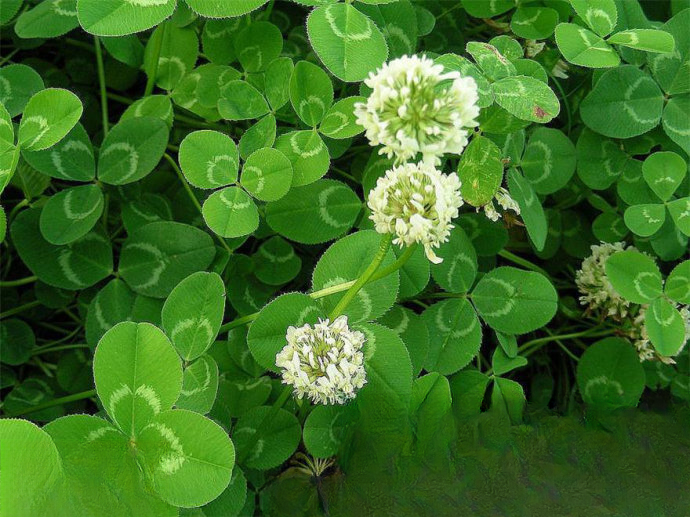 White clover ( Trifolium repens L ) is also known as white clover, white clover, white three grass, clover, Dutch clover, etc. It is a short-term perennial herb, a cultivated plant, with a growth period of 6 years, 10-30 cm high, short taproot, well-developed lateral roots and fibrous roots, creeping stems, slightly rising at the top, roots at the nodes, and the whole plant is hairless. Palmate three compound leaves; stipules ovate-lanceolate, membranous, base clasping the stem into a sheath, and the free part is sharp. It has a wide adaptability, strong heat and cold resistance, can grow vigorously in acidic soil, and can also grow in sandy soil. It has certain ornamental value. It is one of the main cultivated forage grasses in countries around the world. It is mainly used for grassland construction and has good ecological and economic value . It belongs to the genus Trifolium, Trifoliaceae, Leguminosae.
White clover ( Trifolium repens L ) is also known as white clover, white clover, white three grass, clover, Dutch clover, etc. It is a short-term perennial herb, a cultivated plant, with a growth period of 6 years, 10-30 cm high, short taproot, well-developed lateral roots and fibrous roots, creeping stems, slightly rising at the top, roots at the nodes, and the whole plant is hairless. Palmate three compound leaves; stipules ovate-lanceolate, membranous, base clasping the stem into a sheath, and the free part is sharp. It has a wide adaptability, strong heat and cold resistance, can grow vigorously in acidic soil, and can also grow in sandy soil. It has certain ornamental value. It is one of the main cultivated forage grasses in countries around the world. It is mainly used for grassland construction and has good ecological and economic value . It belongs to the genus Trifolium, Trifoliaceae, Leguminosae.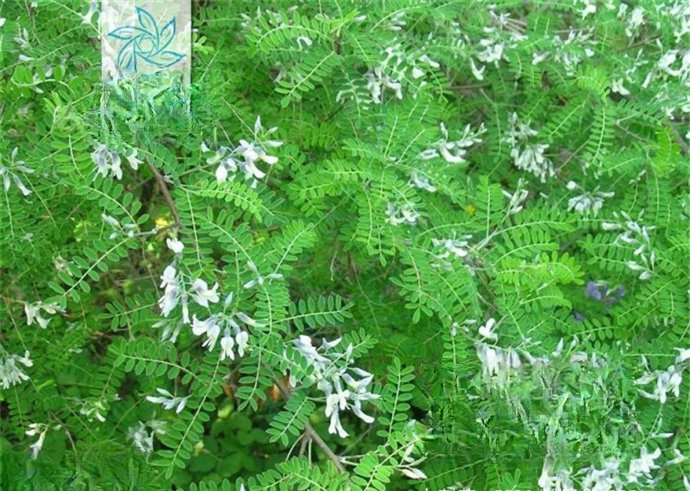 Sophora davidii ( Franch .). The leaves are oval or oblong with obvious veins, brittle and easy to break. The smell is slight, and the taste is slightly astringent and bitter. The flowers are white and bitter. The pods are 3-6cm long, about 5mm thick, beaded, and herbaceous, containing 1-7 seeds. The seeds are oval, with a light yellow-white or yellow-green surface, smooth and shiny. There is a vertical ridge between the hilum and the chalazion. The hilum is slightly concave and biased to one end. It is round, hard and not easy to break. Fabaceae Sophora genus.
Sophora davidii ( Franch .). The leaves are oval or oblong with obvious veins, brittle and easy to break. The smell is slight, and the taste is slightly astringent and bitter. The flowers are white and bitter. The pods are 3-6cm long, about 5mm thick, beaded, and herbaceous, containing 1-7 seeds. The seeds are oval, with a light yellow-white or yellow-green surface, smooth and shiny. There is a vertical ridge between the hilum and the chalazion. The hilum is slightly concave and biased to one end. It is round, hard and not easy to break. Fabaceae Sophora genus.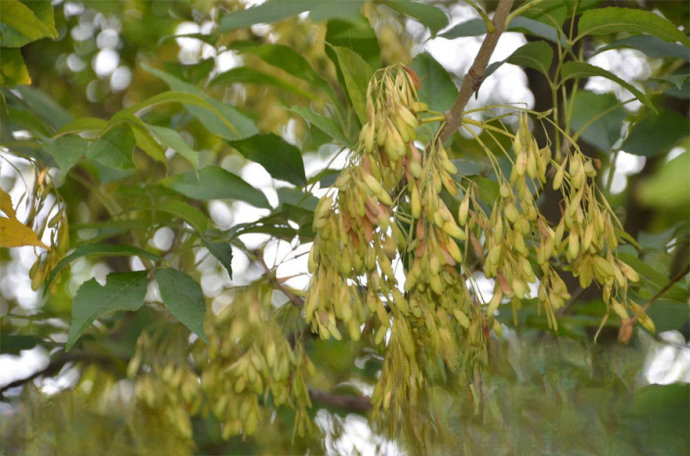 Fraxinus chinensis Roxb. It is named after the waxworms that live on the tree. It is also a sand-fixing tree. It is also called ash. It is a deciduous tree, up to 10-12 meters tall. The bark is gray-brown with shallow and fine cracks. Pinnate compound leaves are opposite, with long petioles, 3-7 leaflets, usually 5, ovate, rarely long ovate or wide ovate, with the largest leaf at the top, 8-11cm long, 3-4.5cm wide. Small light green flowers bloom in late spring, opening at the same time as the leaves, forming terminal and lateral panicles, the flowers are unisexual, dioecious or polygamous, the calyx is small, 4-lobed; there is no corolla; the male flower has 2 stamens; the female flower has an upper ovary, the style is slender, the stigma is 2-lobed, the capsule is narrow and oblanceolate, and the nutlet is located at the base of the wing. The flowering period is May and the fruiting period is August-September. Fraxinus chinensis is an important source of biological wax. Oleaceae, Oleaceae subfamily, Araceae tribe, Arum genus, Arum subgenus.
Fraxinus chinensis Roxb. It is named after the waxworms that live on the tree. It is also a sand-fixing tree. It is also called ash. It is a deciduous tree, up to 10-12 meters tall. The bark is gray-brown with shallow and fine cracks. Pinnate compound leaves are opposite, with long petioles, 3-7 leaflets, usually 5, ovate, rarely long ovate or wide ovate, with the largest leaf at the top, 8-11cm long, 3-4.5cm wide. Small light green flowers bloom in late spring, opening at the same time as the leaves, forming terminal and lateral panicles, the flowers are unisexual, dioecious or polygamous, the calyx is small, 4-lobed; there is no corolla; the male flower has 2 stamens; the female flower has an upper ovary, the style is slender, the stigma is 2-lobed, the capsule is narrow and oblanceolate, and the nutlet is located at the base of the wing. The flowering period is May and the fruiting period is August-September. Fraxinus chinensis is an important source of biological wax. Oleaceae, Oleaceae subfamily, Araceae tribe, Arum genus, Arum subgenus.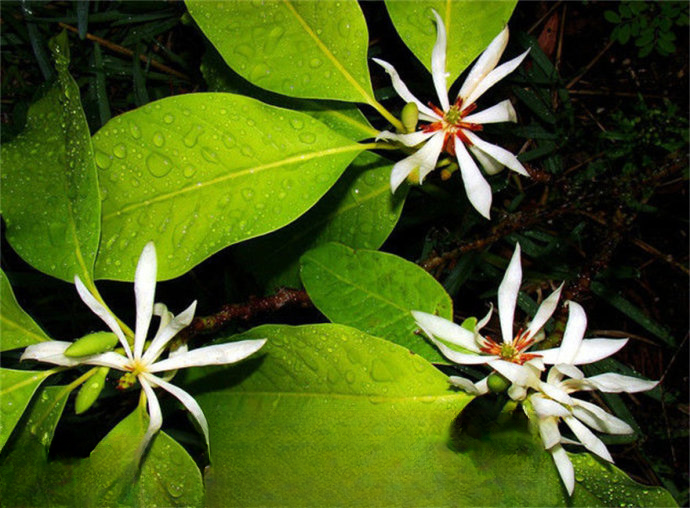 Michelia alba DC.: Other names : white Burmese flower, white orchid, Burmese osmanthus, white orchid, white magnolia. Evergreen tree, up to 17 meters tall , with wide branches and a broad umbrella-shaped crown; 30 cm in diameter ; gray bark; fragrant branches and leaves; young branches and buds densely covered with light yellow-white pubescence, which gradually falls off when old. Leaves are thinly leathery, oblong or lanceolate-elliptical, glabrous above, sparsely pubescent below, with obvious reticulate veins on both sides when dry. Flowers are white and very fragrant; 10 tepals, lanceolate; pistil carpels are numerous, and when mature, they extend with the extension of the receptacle to form a sparsely follicled aggregate fruit; follicles are bright red when mature. Flowering period is from April to September , blooming in summer, usually not fruiting. The flowers are white and fragrant, blooming in summer and autumn, with a long flowering period and dark green leaves. It is a famous garden ornamental tree species, mostly planted as a street tree, and is often propagated by grafting, using Champaca, Michelia, and Phoebe as rootstocks; it can also be propagated by air layering or grafting. Magnoliaceae Magnolia tribe Michelia genus.
Michelia alba DC.: Other names : white Burmese flower, white orchid, Burmese osmanthus, white orchid, white magnolia. Evergreen tree, up to 17 meters tall , with wide branches and a broad umbrella-shaped crown; 30 cm in diameter ; gray bark; fragrant branches and leaves; young branches and buds densely covered with light yellow-white pubescence, which gradually falls off when old. Leaves are thinly leathery, oblong or lanceolate-elliptical, glabrous above, sparsely pubescent below, with obvious reticulate veins on both sides when dry. Flowers are white and very fragrant; 10 tepals, lanceolate; pistil carpels are numerous, and when mature, they extend with the extension of the receptacle to form a sparsely follicled aggregate fruit; follicles are bright red when mature. Flowering period is from April to September , blooming in summer, usually not fruiting. The flowers are white and fragrant, blooming in summer and autumn, with a long flowering period and dark green leaves. It is a famous garden ornamental tree species, mostly planted as a street tree, and is often propagated by grafting, using Champaca, Michelia, and Phoebe as rootstocks; it can also be propagated by air layering or grafting. Magnoliaceae Magnolia tribe Michelia genus.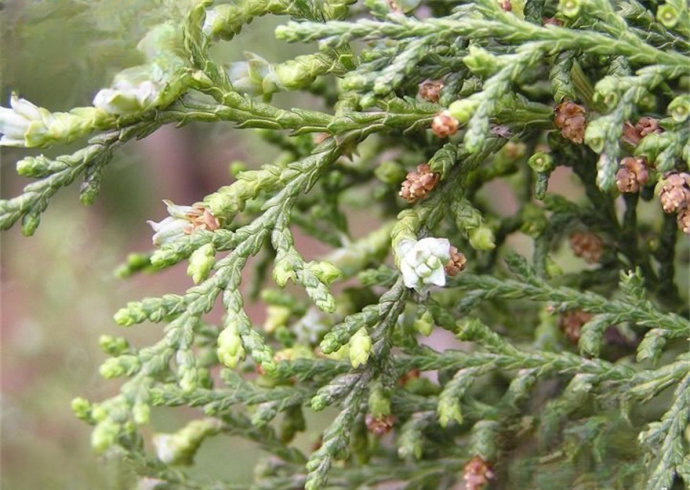 Platycladus orientalis (Linn.)Franco is an evergreen tree, also known as cypress, cedar, and fragrant cedar. It is widely distributed in China, from Inner Mongolia and Jilin in the north to Guangdong and northern Guangxi in the south; it is cultivated throughout the country and is an excellent landscape tree species. The tree height can generally reach 20 meters . The bark is reddish brown and cracked longitudinally. The twigs are flat. The leaves are scaly and small. It is monoecious, and the cones are solitary at the top of the branches. The cones are nearly ovate. The seeds are long ovate and wingless. Platycladus orientalis likes light, but seedlings and young trees have a certain ability to tolerate shade. It is relatively cold-resistant and has poor wind resistance. It is drought-resistant and likes moisture, but it cannot tolerate flooding. It can tolerate barrenness and can grow on slightly acidic to slightly alkaline soils. It grows slowly. It has a very long lifespan. It belongs to the genus Platycladus in the subfamily Cupressoideae of the family Cupressaceae.
Platycladus orientalis (Linn.)Franco is an evergreen tree, also known as cypress, cedar, and fragrant cedar. It is widely distributed in China, from Inner Mongolia and Jilin in the north to Guangdong and northern Guangxi in the south; it is cultivated throughout the country and is an excellent landscape tree species. The tree height can generally reach 20 meters . The bark is reddish brown and cracked longitudinally. The twigs are flat. The leaves are scaly and small. It is monoecious, and the cones are solitary at the top of the branches. The cones are nearly ovate. The seeds are long ovate and wingless. Platycladus orientalis likes light, but seedlings and young trees have a certain ability to tolerate shade. It is relatively cold-resistant and has poor wind resistance. It is drought-resistant and likes moisture, but it cannot tolerate flooding. It can tolerate barrenness and can grow on slightly acidic to slightly alkaline soils. It grows slowly. It has a very long lifespan. It belongs to the genus Platycladus in the subfamily Cupressoideae of the family Cupressaceae.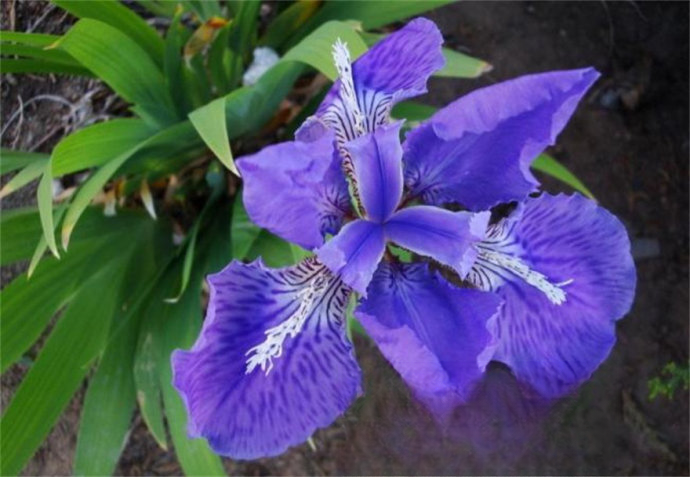 Iris confusa Sealy : Perennial herb. Rhizomes are horizontal, 4-7 mm in diameter , yellowish brown, with obvious nodes and long internodes; fibrous roots are branched, yellowish brown or light yellow. The aboveground stems are erect. There are more than 10 leaves , densely packed at the top of the stem, with sheath-like bases, overlapping each other, arranged in a fan-like shape, and the leaves are broadly sword-shaped and yellowish green. The flower stem is 20-30 cm long and racemose; the bracts are ovate, containing 3-5 flowers; the flowers are light blue or white, 5-5.5 cm in diameter ; the outer perianth lobes are elliptical, slightly concave at the top, with wavy wrinkles on the edges, sparse teeth, and cuneate claws; the inner perianth lobes are oblong lanceolate, slightly concave at the top. The capsule is elliptical, with reticular veins and 6 obvious ribs on the surface; the seeds are dark brown and have no appendages. The flowering period is April , and the fruiting period is May-July . It grows on the edge of the forest, under sparse forests, in valley wetlands or hillside grasslands. The rhizome is used for medicinal purposes to treat acute tonsillitis and acute bronchitis.
Iris confusa Sealy : Perennial herb. Rhizomes are horizontal, 4-7 mm in diameter , yellowish brown, with obvious nodes and long internodes; fibrous roots are branched, yellowish brown or light yellow. The aboveground stems are erect. There are more than 10 leaves , densely packed at the top of the stem, with sheath-like bases, overlapping each other, arranged in a fan-like shape, and the leaves are broadly sword-shaped and yellowish green. The flower stem is 20-30 cm long and racemose; the bracts are ovate, containing 3-5 flowers; the flowers are light blue or white, 5-5.5 cm in diameter ; the outer perianth lobes are elliptical, slightly concave at the top, with wavy wrinkles on the edges, sparse teeth, and cuneate claws; the inner perianth lobes are oblong lanceolate, slightly concave at the top. The capsule is elliptical, with reticular veins and 6 obvious ribs on the surface; the seeds are dark brown and have no appendages. The flowering period is April , and the fruiting period is May-July . It grows on the edge of the forest, under sparse forests, in valley wetlands or hillside grasslands. The rhizome is used for medicinal purposes to treat acute tonsillitis and acute bronchitis.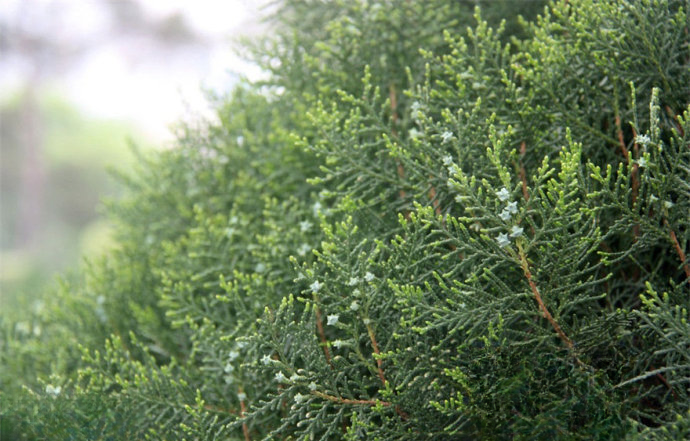 Platycladus orientalis ( L.) Franco is also known as yellow cedar, fragrant cedar, flat cypress, flat cypress, fragrant tree, fragrant tree. It is an evergreen tree. The crown is broadly ovate, and the twigs are flat and arranged in a plane. The leaves are small, scaly, close to the twigs, arranged in a cross-opposite pattern, and have glandular grooves in the middle of the back of the leaves. It is monoecious and the flowers are unisexual. The male cones are yellow and composed of microsporophyll that are alternately opposite. Each microsporophyll has 3 pollen sacs, and the bead scales and bract scales are completely fused. The cones mature in the same year, the seed scales are lignified and cracked, and the seeds are not winged or have ridges. Platycladus orientalis is a specialty and is distributed throughout the country except Qinghai and Xinjiang. It has a long lifespan, and there are often ancient trees that are hundreds of years old or more. It has been selected as the city tree of Beijing. Platycladus orientalis is drought-tolerant and is often used as a afforestation tree on sunny slopes. It is also a common garden greening tree species. Its wood can be used for construction and furniture. Its leaves and branches are used as medicine, which can be astringent and hemostatic, diuretic and stomachic, and detoxify and relieve blood stasis. Its seeds have the effect of calming the nerves and nourishing and strengthening the body.
Platycladus orientalis ( L.) Franco is also known as yellow cedar, fragrant cedar, flat cypress, flat cypress, fragrant tree, fragrant tree. It is an evergreen tree. The crown is broadly ovate, and the twigs are flat and arranged in a plane. The leaves are small, scaly, close to the twigs, arranged in a cross-opposite pattern, and have glandular grooves in the middle of the back of the leaves. It is monoecious and the flowers are unisexual. The male cones are yellow and composed of microsporophyll that are alternately opposite. Each microsporophyll has 3 pollen sacs, and the bead scales and bract scales are completely fused. The cones mature in the same year, the seed scales are lignified and cracked, and the seeds are not winged or have ridges. Platycladus orientalis is a specialty and is distributed throughout the country except Qinghai and Xinjiang. It has a long lifespan, and there are often ancient trees that are hundreds of years old or more. It has been selected as the city tree of Beijing. Platycladus orientalis is drought-tolerant and is often used as a afforestation tree on sunny slopes. It is also a common garden greening tree species. Its wood can be used for construction and furniture. Its leaves and branches are used as medicine, which can be astringent and hemostatic, diuretic and stomachic, and detoxify and relieve blood stasis. Its seeds have the effect of calming the nerves and nourishing and strengthening the body.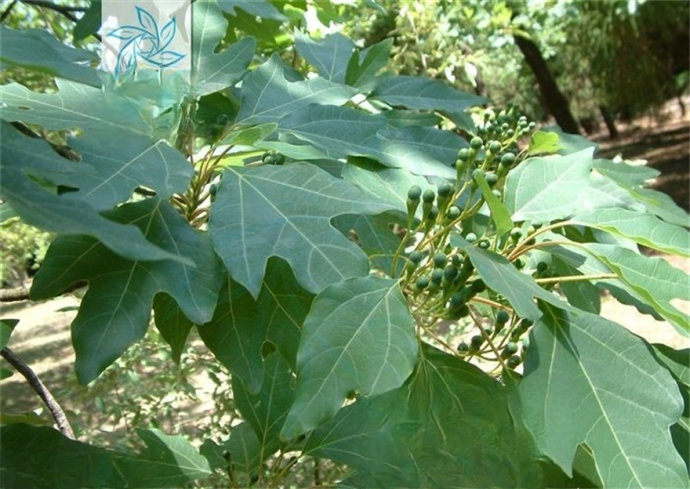 Sassafras tzumu ( Hemsl . ) Hemsl ., also known as Sassafras (Zhejiang, Jiangxi), Nanshu, Shansashi (Zhejiang), Qingsashi (Anhui), Tongzishu, Lihuohong (Fujian), Zimu, Huangshaoshu (Hubei), Brushwood (Guangdong Fengchuan), Huashanshu (Yunnan Zhenxiong, Sichuan), Goosefoot Board (Yunnan Weixin), Half Wind Camphor (Guangxi). Deciduous tree, up to 35 meters high , with a breast diameter of 2.5 meters . It likes warm and humid climate. It likes light and is not shade-tolerant. It is used for shipbuilding, waterwheels and high-quality furniture. It belongs to the genus Sassafras of the Lauraceae subfamily of the Lauraceae family, the Cinnamomum camphora family.
Sassafras tzumu ( Hemsl . ) Hemsl ., also known as Sassafras (Zhejiang, Jiangxi), Nanshu, Shansashi (Zhejiang), Qingsashi (Anhui), Tongzishu, Lihuohong (Fujian), Zimu, Huangshaoshu (Hubei), Brushwood (Guangdong Fengchuan), Huashanshu (Yunnan Zhenxiong, Sichuan), Goosefoot Board (Yunnan Weixin), Half Wind Camphor (Guangxi). Deciduous tree, up to 35 meters high , with a breast diameter of 2.5 meters . It likes warm and humid climate. It likes light and is not shade-tolerant. It is used for shipbuilding, waterwheels and high-quality furniture. It belongs to the genus Sassafras of the Lauraceae subfamily of the Lauraceae family, the Cinnamomum camphora family.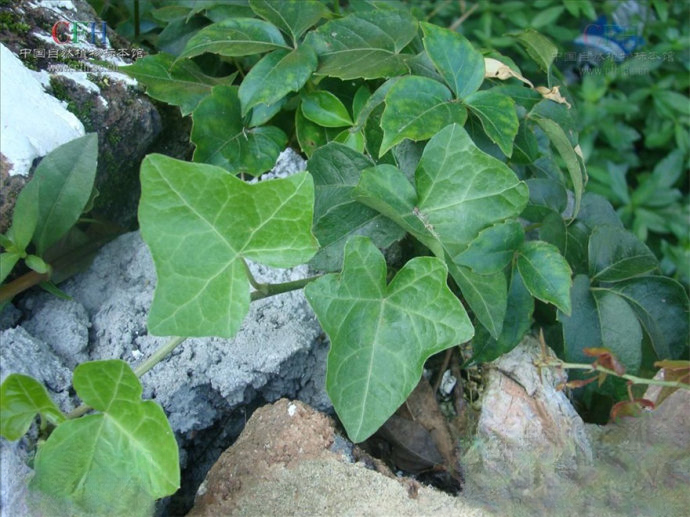 Ivy (Latin name: Hedera nepalensis var. sinensis (Tobl.) Rehd ) is a perennial evergreen climbing shrub with aerial roots, gray-brown or black-brown smooth stems, alternate single leaves; petioles without stipules and scales; leaves on flower branches are elliptical lanceolate, umbels are single and terminal, flowers are pale yellow-white or pale green-white, anthers are purple; the disk is raised and yellow. The fruit is spherical, red or yellow, flowering from September to November , and fruiting from March to May of the following year . Ivy has beautiful leaves and is evergreen all year round. It is often used for vertical greening in various parts of the south. It is often planted beside rockery and at the base of the wall, allowing it to grow vertically or cover naturally, which has the effect of decorating and beautifying the environment. When potted, small and medium-sized pots are mainly used, and various shapes can be made for indoor display. It can also be used to cover the walls of indoor gardens, making the indoor garden landscape more natural and beautiful. The whole ivy plant can be used as medicine, which has the effects of removing rheumatism, promoting blood circulation and reducing swelling, and has therapeutic effects on traumatic injuries, back pain, rheumatoid arthritis, etc. Ivy belongs to the genus Hedera of the family Araliaceae.
Ivy (Latin name: Hedera nepalensis var. sinensis (Tobl.) Rehd ) is a perennial evergreen climbing shrub with aerial roots, gray-brown or black-brown smooth stems, alternate single leaves; petioles without stipules and scales; leaves on flower branches are elliptical lanceolate, umbels are single and terminal, flowers are pale yellow-white or pale green-white, anthers are purple; the disk is raised and yellow. The fruit is spherical, red or yellow, flowering from September to November , and fruiting from March to May of the following year . Ivy has beautiful leaves and is evergreen all year round. It is often used for vertical greening in various parts of the south. It is often planted beside rockery and at the base of the wall, allowing it to grow vertically or cover naturally, which has the effect of decorating and beautifying the environment. When potted, small and medium-sized pots are mainly used, and various shapes can be made for indoor display. It can also be used to cover the walls of indoor gardens, making the indoor garden landscape more natural and beautiful. The whole ivy plant can be used as medicine, which has the effects of removing rheumatism, promoting blood circulation and reducing swelling, and has therapeutic effects on traumatic injuries, back pain, rheumatoid arthritis, etc. Ivy belongs to the genus Hedera of the family Araliaceae.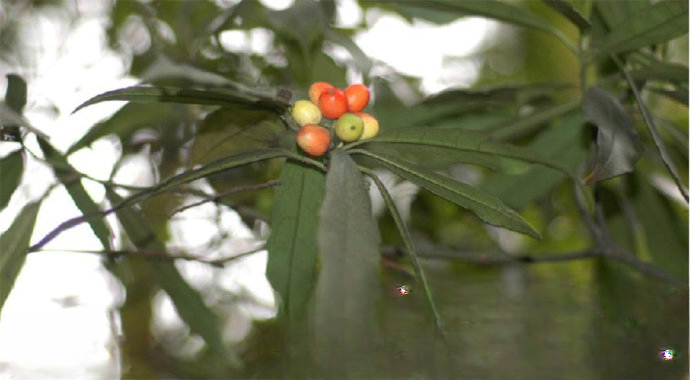 Aucuba himalaica Hook. f. et Thomson var. dolichophylla Fang et Soong . Distributed in Hubei , Hunan, Guangdong, Guangxi, Sichuan, Guizhou and other places. It has the effects of dispelling wind and dampness, unblocking meridians and relieving pain. It is mainly used to treat rheumatic arthralgia, swelling and pain caused by falls. It belongs to the genus Aucuba himalaica of the family Cornaceae.
Aucuba himalaica Hook. f. et Thomson var. dolichophylla Fang et Soong . Distributed in Hubei , Hunan, Guangdong, Guangxi, Sichuan, Guizhou and other places. It has the effects of dispelling wind and dampness, unblocking meridians and relieving pain. It is mainly used to treat rheumatic arthralgia, swelling and pain caused by falls. It belongs to the genus Aucuba himalaica of the family Cornaceae.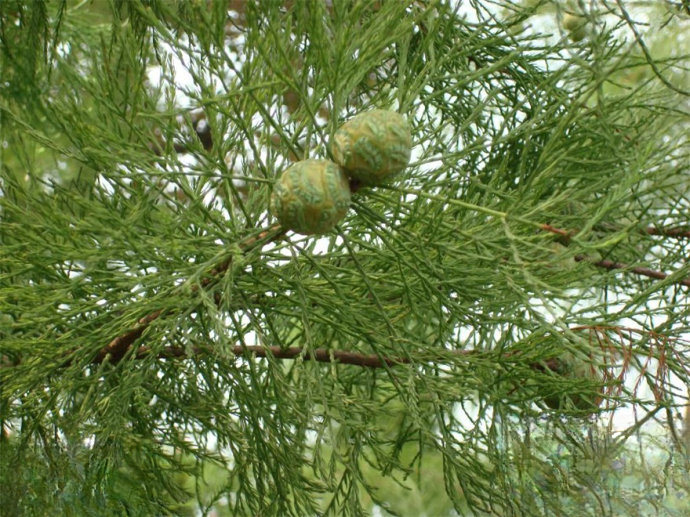 The pond cypress ( Taxodium ascendens Brongn. ) is a species of the genus Taxodium in the family Taxodiaceae. It is also known as the pond cypress and the swamp cypress. It is a deciduous tree up to 25 meters tall . The trunk is straight and the crown is spire-shaped. The base of the trunk is swollen, and the branches form a narrow crown upward, which is spire-shaped and beautiful. The leaves are awl-shaped and spirally extend on the branches; the cones are spherical. The flowering period is March , and the fruits mature in October and November . The cones are spherical or oblong-spherical with short stalks. The seeds are irregularly triangular, slightly flat, reddish, and have sharp ridges on the edges. It is corrosion-resistant and is a good material for shipbuilding and construction. Taxodium genus Taxodium in the family Taxodiaceae.
The pond cypress ( Taxodium ascendens Brongn. ) is a species of the genus Taxodium in the family Taxodiaceae. It is also known as the pond cypress and the swamp cypress. It is a deciduous tree up to 25 meters tall . The trunk is straight and the crown is spire-shaped. The base of the trunk is swollen, and the branches form a narrow crown upward, which is spire-shaped and beautiful. The leaves are awl-shaped and spirally extend on the branches; the cones are spherical. The flowering period is March , and the fruits mature in October and November . The cones are spherical or oblong-spherical with short stalks. The seeds are irregularly triangular, slightly flat, reddish, and have sharp ridges on the edges. It is corrosion-resistant and is a good material for shipbuilding and construction. Taxodium genus Taxodium in the family Taxodiaceae. 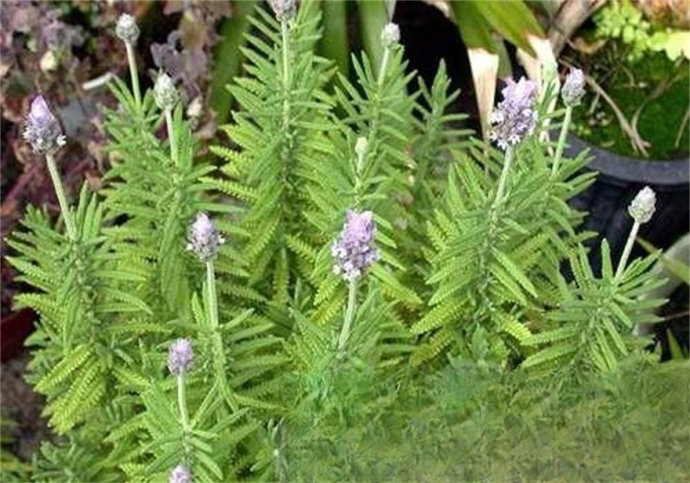 Lavandula dentata ( Lavandula dentata ), also known as sawtooth lavender, is a perennial herb in the genus Lavandula in the family Lamiaceae. It is mainly used as a garden ornamental plant. It is a semi-cold-resistant and heat-resistant variety. It blooms fragrant light purple flowers with fine teeth on the leaf margins, similar to the leaves of ferns. Used in scented pillows and scented bags, it can repel insects and has a long-lasting fragrance; it can extract high-quality essential oils; it can be used for bathing to calm and soothe nerves; and it can also be used to make cakes. In addition to being used for viewing, it is used for environmental greening and is also suitable for making tea. Lamiaceae, Lavandula subfamily, Lavandula genus.
Lavandula dentata ( Lavandula dentata ), also known as sawtooth lavender, is a perennial herb in the genus Lavandula in the family Lamiaceae. It is mainly used as a garden ornamental plant. It is a semi-cold-resistant and heat-resistant variety. It blooms fragrant light purple flowers with fine teeth on the leaf margins, similar to the leaves of ferns. Used in scented pillows and scented bags, it can repel insects and has a long-lasting fragrance; it can extract high-quality essential oils; it can be used for bathing to calm and soothe nerves; and it can also be used to make cakes. In addition to being used for viewing, it is used for environmental greening and is also suitable for making tea. Lamiaceae, Lavandula subfamily, Lavandula genus. 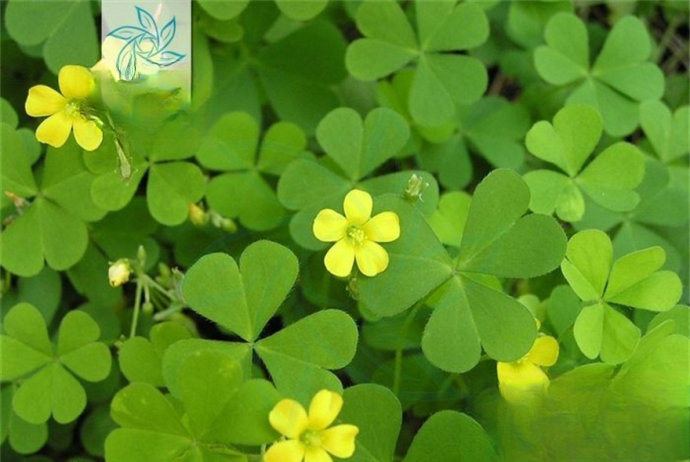 Oxalis corniculata L. . Other names: sour sorrel, sour sour grass, dove acid, trifoliate acid, sour mimi, hook hook grass. Perennial herb, the whole body has sparse soft hairs; the stem is creeping or obliquely ascending, with many branches. The leaves are alternate, the palmate compound leaves have 3 leaflets, inverted heart shape, and the leaflets are sessile. The flowers are yellow, like sunny, warm and humid environment, and semi-shaded areas in hot summer are suitable. It has strong drought resistance and is not cold-resistant. It can grow in general garden soil, but grows vigorously in sandy loam rich in humus, and has a short dormancy in summer. The whole plant is used as medicine, which has the effects of clearing heat and detoxifying, reducing swelling and dispersing diseases. Malus halliana Koehne, Oxalidaceae, Oxalis. Weeping Begonia
Oxalis corniculata L. . Other names: sour sorrel, sour sour grass, dove acid, trifoliate acid, sour mimi, hook hook grass. Perennial herb, the whole body has sparse soft hairs; the stem is creeping or obliquely ascending, with many branches. The leaves are alternate, the palmate compound leaves have 3 leaflets, inverted heart shape, and the leaflets are sessile. The flowers are yellow, like sunny, warm and humid environment, and semi-shaded areas in hot summer are suitable. It has strong drought resistance and is not cold-resistant. It can grow in general garden soil, but grows vigorously in sandy loam rich in humus, and has a short dormancy in summer. The whole plant is used as medicine, which has the effects of clearing heat and detoxifying, reducing swelling and dispersing diseases. Malus halliana Koehne, Oxalidaceae, Oxalis. Weeping Begonia 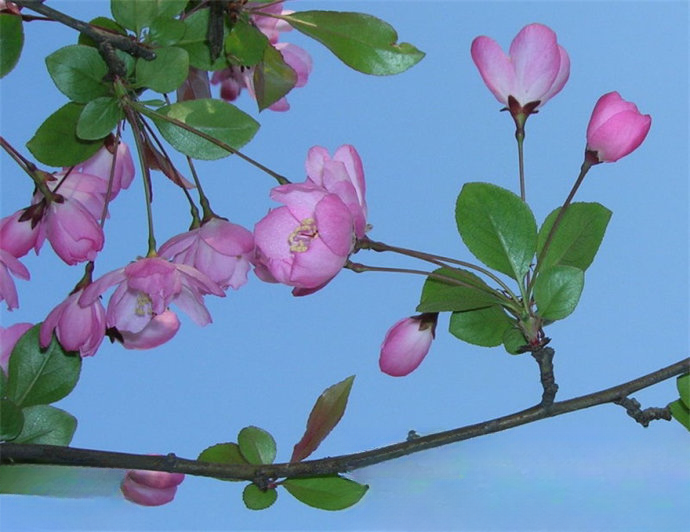 (scientific name: Malus halliana Koehne ), also known as Weeping Begonia. Deciduous small tree, up to 5 meters high , with spreading crown, ovate or elliptic to oblong elliptic leaves, umbel inflorescence, with 4-6 flowers , slender and drooping pedicels, sparse soft hairs, purple; the outside of the calyx tube is hairless; sepals are triangular ovate, petals are obovate, with short claws at the base, pink, often more than 5 ; fruits are pear-shaped or obovate, slightly purple, mature very late, and sepals fall off. Flowering period is March-April , fruiting period is September-October . It can be used as medicine, mainly for treating uterine bleeding. Rosaceae, Malus genus.
(scientific name: Malus halliana Koehne ), also known as Weeping Begonia. Deciduous small tree, up to 5 meters high , with spreading crown, ovate or elliptic to oblong elliptic leaves, umbel inflorescence, with 4-6 flowers , slender and drooping pedicels, sparse soft hairs, purple; the outside of the calyx tube is hairless; sepals are triangular ovate, petals are obovate, with short claws at the base, pink, often more than 5 ; fruits are pear-shaped or obovate, slightly purple, mature very late, and sepals fall off. Flowering period is March-April , fruiting period is September-October . It can be used as medicine, mainly for treating uterine bleeding. Rosaceae, Malus genus. 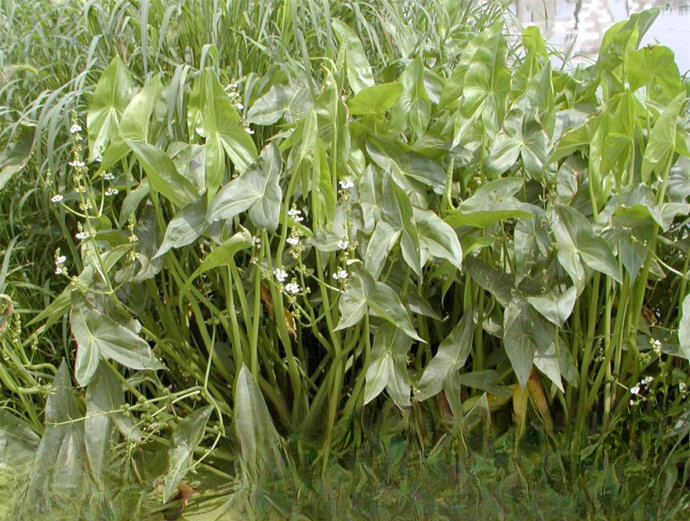 Sagittaria, also known as scissors grass, swallowtail grass, vegetable eggs, explanation name: duckweed, duckweed, water chestnut, black three-angle, peony, ground chestnut. Perennial herb, also known as Chinese arrowhead mushroom and water taro. It is a monocot perennial emergent plant with tall plants, tufted leaves and many roots at the base. Slender creeping branches grow near the roots, and the branch tips swell into bulbs in autumn, with a diameter of up to 3CM . The leaves are arrow-shaped, wide, 20-30cm long , and the lobes on the left and right sides of the leaf base are longer than the central lobe. The petiole is relatively thick and 50-80cm long . The inflorescence is conical. The underground corm is edible. It belongs to the genus Sagittaria of the family Alismataceae.
Sagittaria, also known as scissors grass, swallowtail grass, vegetable eggs, explanation name: duckweed, duckweed, water chestnut, black three-angle, peony, ground chestnut. Perennial herb, also known as Chinese arrowhead mushroom and water taro. It is a monocot perennial emergent plant with tall plants, tufted leaves and many roots at the base. Slender creeping branches grow near the roots, and the branch tips swell into bulbs in autumn, with a diameter of up to 3CM . The leaves are arrow-shaped, wide, 20-30cm long , and the lobes on the left and right sides of the leaf base are longer than the central lobe. The petiole is relatively thick and 50-80cm long . The inflorescence is conical. The underground corm is edible. It belongs to the genus Sagittaria of the family Alismataceae. 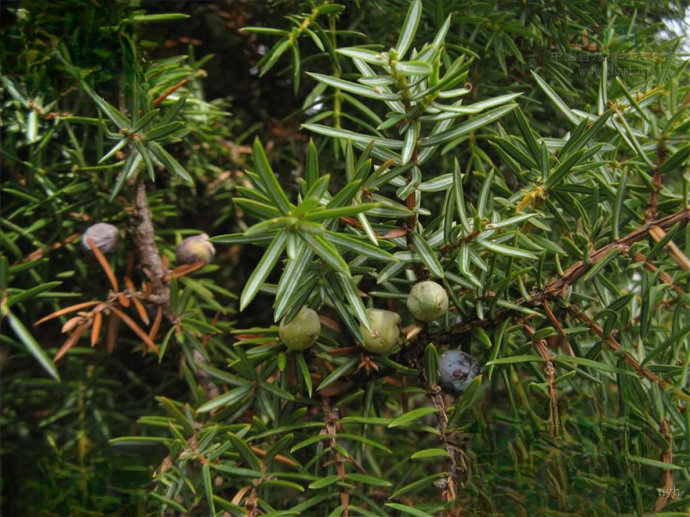 Juniperus formosana Hayata , also known as green cypress, fir cypress, Taiwan juniper, garland cypress, cypress cypress, weeping cypress, juniper, short cypress, mountain fir, Taiwan cypress, and Taiwan pine. It is an evergreen small tree that likes cool climates and is cold-resistant. It is not very demanding on soil and can grow in acidic soil or dry rock cracks and gravel land by the sea. It likes light, is cold-resistant and drought-resistant, and has well-developed main and lateral roots. It can grow in arid sandy land, sunny slopes, and rock cracks. It is the best tree species for stone gardens. It is often used for gardening and is widely used in highway greening. It belongs to the genus Juniperus of the subfamily Juniperus of the family Cupressaceae.
Juniperus formosana Hayata , also known as green cypress, fir cypress, Taiwan juniper, garland cypress, cypress cypress, weeping cypress, juniper, short cypress, mountain fir, Taiwan cypress, and Taiwan pine. It is an evergreen small tree that likes cool climates and is cold-resistant. It is not very demanding on soil and can grow in acidic soil or dry rock cracks and gravel land by the sea. It likes light, is cold-resistant and drought-resistant, and has well-developed main and lateral roots. It can grow in arid sandy land, sunny slopes, and rock cracks. It is the best tree species for stone gardens. It is often used for gardening and is widely used in highway greening. It belongs to the genus Juniperus of the subfamily Juniperus of the family Cupressaceae.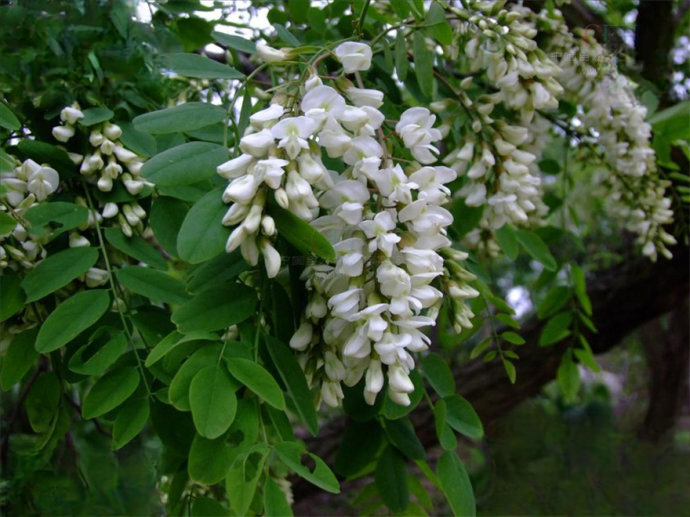
Robinia pseudoacacia L. is a deciduous tree of the genus Robinia in the Fabaceae family. Its bark is gray-brown to dark brown, with shallow to deep longitudinal cracks, and is rarely smooth. It is native to North America and is now widely introduced to Asia, Europe and other places. Robinia bark is thick, dark, and has many cracks; there is a pair of 1-2 mm long thorns at the base of the leaves; the flowers are white, fragrant, and spike-shaped inflorescences; the fruit is a pod, and each pod contains 4-10 seeds. Robinia wood is hard, corrosion-resistant, slow-burning, and has a high calorific value. Robinia flowers are edible, and the honey produced is very sweet and the honey yield is also high. Cultivated varieties include Hongsen Robinia, Red Robinia, Golden Robinia, etc. Among all Robinia trees, Hongsen Robinia grows the fastest and is known as the king of Robinia trees.
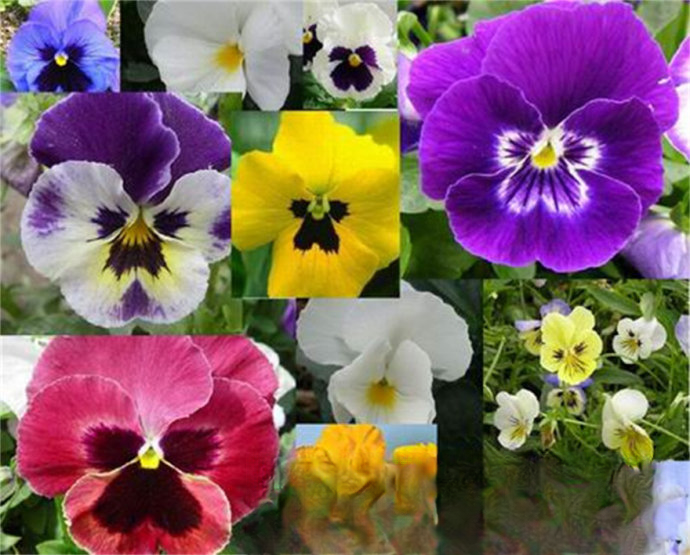 Pansy. Other names: small butterfly flower, cat face, hybrid violet. Perennial herb, plant height about 15cm , stem erect, branched or unbranched. Basal leaves are numerous, oval, stem leaves are long oval, with reticulate veins, and leaf margins with neat blunt serrations. Flower colors are mostly polychromatic. It is cold-resistant and cold-weather-resistant, often used as an ornamental plant, used in potted plants, flower beds, etc. Viola genus, Violaceae.
Pansy. Other names: small butterfly flower, cat face, hybrid violet. Perennial herb, plant height about 15cm , stem erect, branched or unbranched. Basal leaves are numerous, oval, stem leaves are long oval, with reticulate veins, and leaf margins with neat blunt serrations. Flower colors are mostly polychromatic. It is cold-resistant and cold-weather-resistant, often used as an ornamental plant, used in potted plants, flower beds, etc. Viola genus, Violaceae.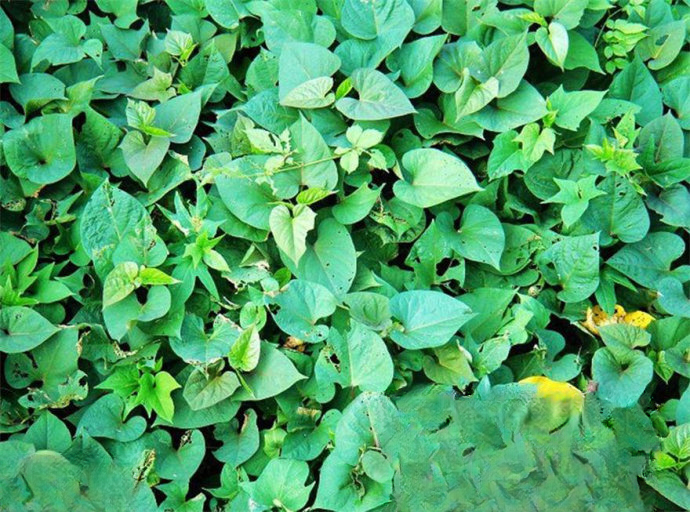
Caulis Fici Tikouae is also known as ground pomegranate, river dragon, earth melon, etc. It is a perennial deciduous vine with latex all over. The aerial roots are like hairs, clinging to trees or rocks. The stem is cylindrical or slightly flat, brown, with many branches and slightly swollen nodes. It can be used as medicine, with the effects of clearing heat, promoting dampness, promoting blood circulation and detoxification. It belongs to the genus Ficus in the family Moraceae.
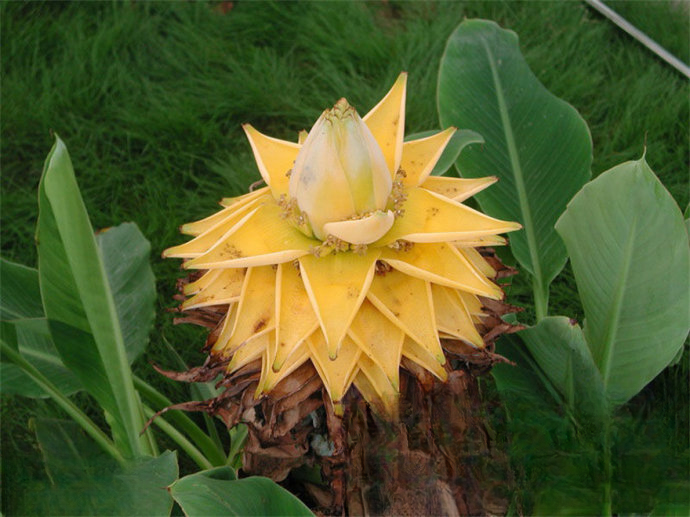
Musella lasiocarpa (Franch.) CY Wu ex HW Li, also known as Thousand-petal Lotus, Ground Golden Lotus, and Unbreakable Golden Steel. It is native to Yunnan and is a specialty flower. The axils of the pseudostems are real small flowers, which are fragrant, delicate, and yellow-green, adding a delicate beauty. The flowering period is as long as half a year. Musella lasiocarpa is designated as one of the "Five Trees and Six Flowers" by Buddhist temples. It is also the embodiment of kindness and the symbol of punishing evil in Dai literature. Yunnan people also use its stem juice to sober up, detoxify, and make hemostatic drugs. Now this beautiful plant has been introduced and cultivated in the tropical greenhouse of Beijing Botanical Garden. Musaceae Musinoideae Musiocarpa genus.
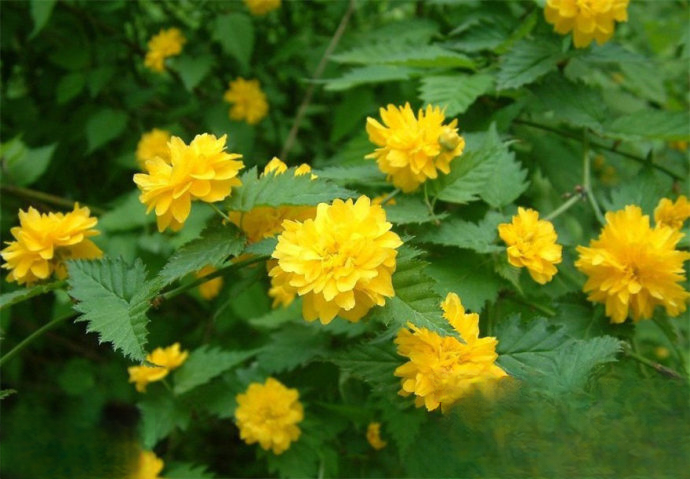 Kerria japonica (L.) DC .: Kerria japonica, ground kerria, bee kerria, yellow plum, golden kerria, yellow elm plum. Shrub, 1-2 meters high ; twigs angular, green, glabrous. Leaves ovate or triangular, acuminate at the apex, truncated or nearly rounded at the base, with double serrations on the margins, glabrous or sparsely pubescent above, slightly pubescent below; petioles glabrous; with stipules. Flowers solitary at the top of lateral branches; glabrous; flowers 3-5 cm straight ; calyx tube flat, lobes 5 , ovate, entire, glabrous; petals yellow, broadly elliptic; stamens numerous, free, about half the length of petals; carpels 5-8 , pubescent, style about as long as stamens. Stalks black, glabrous, calyx lobes persistent. Prefers warm, humid and semi-shady environments, poor cold tolerance. In addition to being used for viewing, the flower of Deutzia can also be used as medicine to reduce swelling, relieve pain, relieve cough, and aid digestion. Deutzia genus, Rosaceae, subfamily Rosoideae.
Kerria japonica (L.) DC .: Kerria japonica, ground kerria, bee kerria, yellow plum, golden kerria, yellow elm plum. Shrub, 1-2 meters high ; twigs angular, green, glabrous. Leaves ovate or triangular, acuminate at the apex, truncated or nearly rounded at the base, with double serrations on the margins, glabrous or sparsely pubescent above, slightly pubescent below; petioles glabrous; with stipules. Flowers solitary at the top of lateral branches; glabrous; flowers 3-5 cm straight ; calyx tube flat, lobes 5 , ovate, entire, glabrous; petals yellow, broadly elliptic; stamens numerous, free, about half the length of petals; carpels 5-8 , pubescent, style about as long as stamens. Stalks black, glabrous, calyx lobes persistent. Prefers warm, humid and semi-shady environments, poor cold tolerance. In addition to being used for viewing, the flower of Deutzia can also be used as medicine to reduce swelling, relieve pain, relieve cough, and aid digestion. Deutzia genus, Rosaceae, subfamily Rosoideae.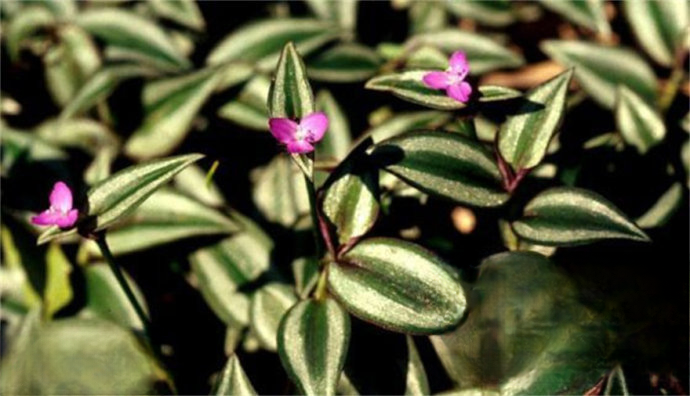 Zebrina pendula Schnizl ( Zebrina pendula Schnizl means "striped leaves", which means zebra ), hanging bamboo orchid, spotted leaf coleus, variegated bamboo clip, red lotus. It is an evergreen herb with weak and brittle stems, creeping on the ground and growing in a creeping manner. Because its leaves are shaped like bamboo and its leaves are beautiful, it is often hung indoors in pots to admire its scattered and drooping stems and leaves, hence the name of hanging bamboo plum. It is very suitable for herbaceous foliage plants that require little investment and have a fast and good ground cover greening effect. It belongs to the genus Tradescantia of the Commelinaceae family.
Zebrina pendula Schnizl ( Zebrina pendula Schnizl means "striped leaves", which means zebra ), hanging bamboo orchid, spotted leaf coleus, variegated bamboo clip, red lotus. It is an evergreen herb with weak and brittle stems, creeping on the ground and growing in a creeping manner. Because its leaves are shaped like bamboo and its leaves are beautiful, it is often hung indoors in pots to admire its scattered and drooping stems and leaves, hence the name of hanging bamboo plum. It is very suitable for herbaceous foliage plants that require little investment and have a fast and good ground cover greening effect. It belongs to the genus Tradescantia of the Commelinaceae family. 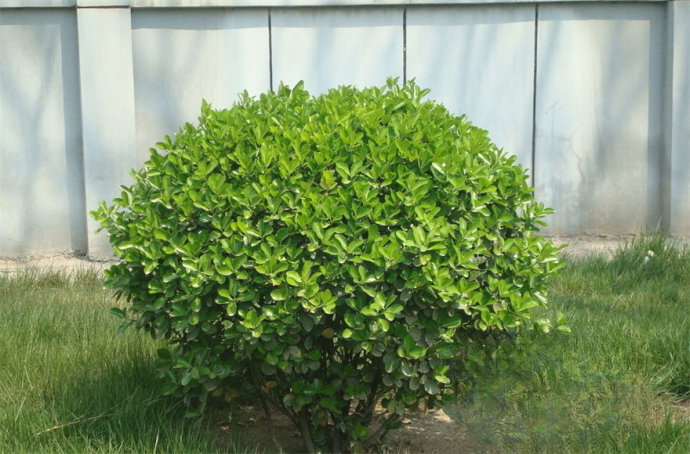 Holly ( Ilex chinensis Sims ): an evergreen tree and shrub, with gray or light gray bark with longitudinal grooves, and light green twigs without hair. The leaves are thin leathery, narrow and oblong or lanceolate, with a gradually pointed apex, a cuneate base, and shallowly rounded serrations on the edges. They are reddish brown and shiny when dry. The petals are purple-red or lavender, curling outwards. The fruit is oval or nearly spherical, and dark red when ripe. The seeds and bark can be used for medicinal purposes, as a tonic; the leaves have the effect of clearing away heat and detoxifying, and can treat tracheitis and burns; tannin can be extracted from the bark; the wood is hard and can be used as fine work material. Ilex genus, ilex subgenus, Aquifoliaceae.
Holly ( Ilex chinensis Sims ): an evergreen tree and shrub, with gray or light gray bark with longitudinal grooves, and light green twigs without hair. The leaves are thin leathery, narrow and oblong or lanceolate, with a gradually pointed apex, a cuneate base, and shallowly rounded serrations on the edges. They are reddish brown and shiny when dry. The petals are purple-red or lavender, curling outwards. The fruit is oval or nearly spherical, and dark red when ripe. The seeds and bark can be used for medicinal purposes, as a tonic; the leaves have the effect of clearing away heat and detoxifying, and can treat tracheitis and burns; tannin can be extracted from the bark; the wood is hard and can be used as fine work material. Ilex genus, ilex subgenus, Aquifoliaceae.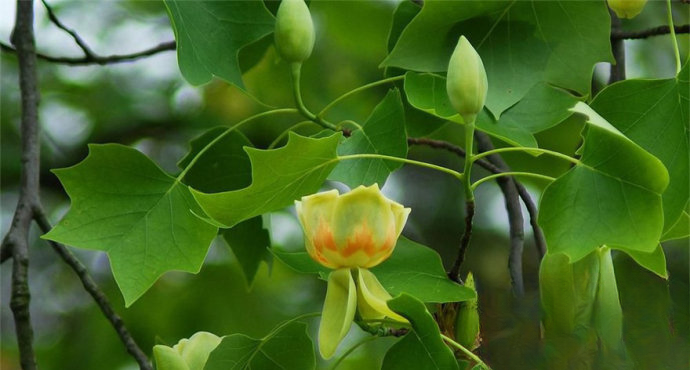 Liriodendron chinense. Other names: Ma Gua Mu, Shuangpiao Shu. Latin scientific name: Liriodendron chinense (Hemsl.) Sarg. (Flora of China). A unique and rare plant, a large deciduous tree, up to 40 meters high, with a breast diameter of more than 1 meter, and gray or gray-brown twigs. The leaf shape is like a Ma Gua - the top of the leaf is flat, like the hem of a Ma Gua; the two sides of the leaf are smooth or slightly curved, like the two waists of a Ma Gua; the two sides of the leaf protrude outward, as if they are the two sleeves of a Ma Gua, so Liriodendron chinense is also called Ma Gua Mu. The flower grows solitarily at the top of the branch, with 9 tepals, 3 calyx-shaped in the outer circle, green, and the two inner circles are yellow-green in petal shape, with yellow stripes at the base, resembling a tulip. Therefore, its English name is "Chinese Tulip Tree", which means "Tulip Tree" in Chinese. It grows fast, is drought-resistant, and has strong resistance to diseases and insect pests. The flowers are large and beautiful, and the leaves are golden in autumn, like yellow jackets. It is a precious street tree and garden ornamental tree species. It can quickly form shade after planting, and is also a good wood for construction and furniture making. It is mainly used to treat rheumatism, cold cough and other diseases. Magnolia family Magnolia tribe Liriodendron genus.
Liriodendron chinense. Other names: Ma Gua Mu, Shuangpiao Shu. Latin scientific name: Liriodendron chinense (Hemsl.) Sarg. (Flora of China). A unique and rare plant, a large deciduous tree, up to 40 meters high, with a breast diameter of more than 1 meter, and gray or gray-brown twigs. The leaf shape is like a Ma Gua - the top of the leaf is flat, like the hem of a Ma Gua; the two sides of the leaf are smooth or slightly curved, like the two waists of a Ma Gua; the two sides of the leaf protrude outward, as if they are the two sleeves of a Ma Gua, so Liriodendron chinense is also called Ma Gua Mu. The flower grows solitarily at the top of the branch, with 9 tepals, 3 calyx-shaped in the outer circle, green, and the two inner circles are yellow-green in petal shape, with yellow stripes at the base, resembling a tulip. Therefore, its English name is "Chinese Tulip Tree", which means "Tulip Tree" in Chinese. It grows fast, is drought-resistant, and has strong resistance to diseases and insect pests. The flowers are large and beautiful, and the leaves are golden in autumn, like yellow jackets. It is a precious street tree and garden ornamental tree species. It can quickly form shade after planting, and is also a good wood for construction and furniture making. It is mainly used to treat rheumatism, cold cough and other diseases. Magnolia family Magnolia tribe Liriodendron genus. 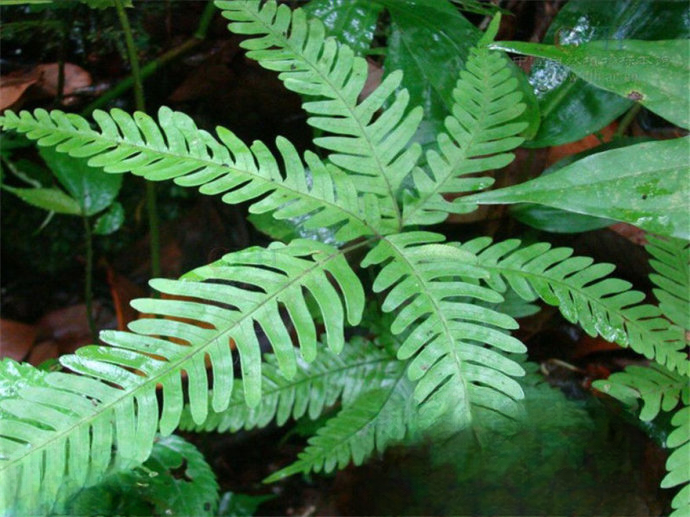 Pteris cretica, also known as: well fence grass, small leaf pteris. (Scientific name: Pteris cretica L. var. nervosa (Thunb.) Ching et SH Wu ), the plant is 50-70 cm tall . The rhizome is short and upright or obliquely ascending, about 1 cm thick , with dark brown scales at the tip. The leaf margins have only short serrations, and the base of the terminal trident pinnae often extends below the rachis, and the next pair also extends to some extent. The leaves become papery, green or gray-green, and hairless after drying; the rachis is straw-colored and has a smooth surface. The young leaves are edible and are called "fern". Potted plants can be used to decorate desks, coffee tables, windowsills and balconies, and are also suitable for hanging or inlaid arrangements in living rooms, studies, and bedrooms. The whole plant can be used for medicinal purposes. It has the effects of clearing away heat and dampness, cooling blood and detoxifying, stopping diarrhea, and strengthening tendons and activating collaterals. It is often used by the people to treat dysentery and stop diarrhea. Pteridaceae, genus Pteris.
Pteris cretica, also known as: well fence grass, small leaf pteris. (Scientific name: Pteris cretica L. var. nervosa (Thunb.) Ching et SH Wu ), the plant is 50-70 cm tall . The rhizome is short and upright or obliquely ascending, about 1 cm thick , with dark brown scales at the tip. The leaf margins have only short serrations, and the base of the terminal trident pinnae often extends below the rachis, and the next pair also extends to some extent. The leaves become papery, green or gray-green, and hairless after drying; the rachis is straw-colored and has a smooth surface. The young leaves are edible and are called "fern". Potted plants can be used to decorate desks, coffee tables, windowsills and balconies, and are also suitable for hanging or inlaid arrangements in living rooms, studies, and bedrooms. The whole plant can be used for medicinal purposes. It has the effects of clearing away heat and dampness, cooling blood and detoxifying, stopping diarrhea, and strengthening tendons and activating collaterals. It is often used by the people to treat dysentery and stop diarrhea. Pteridaceae, genus Pteris.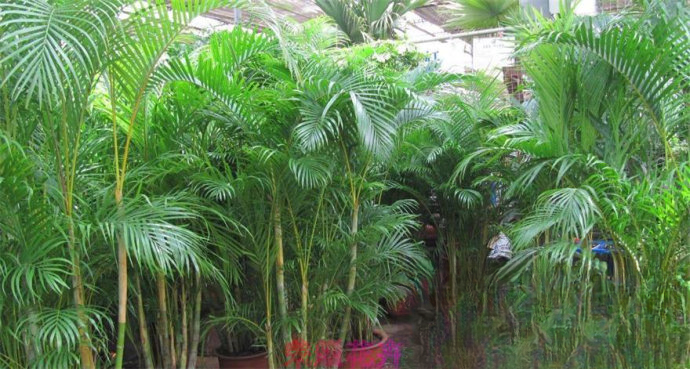
Phoenix tail bamboo. Other names: rice bamboo, tendon bamboo, Penglai bamboo. A variation of filial bamboo. It has a short plant shape, fine and dense green leaves, and a graceful and unrestrained style, like a phoenix tail. The branches are slender, the upper end of the bamboo pole is lush and leafy, and the branches are dense, slender and bent downward. The leaves are small, about 3cm long, and often 20 pieces are arranged on both sides of the branches, like feathers. Bamboo stalks and branches that are solid or nearly solid are called "Guanyin bamboo", and hollow ones are called "Phoenix tail bamboo". This bamboo is named "Guanyin bamboo" because it is rich in spiritual energy. As the saying goes, mountains are spiritual if there is water, and there is a Guanyin bamboo ball next to the temple, which is fairy-like. Phoenix tail bamboo can absorb formaldehyde and purify the air. It is often used for potted ornamental, embellishing small courtyards and living rooms, and is also used to make bonsai or as low hedge materials. It belongs to the Phoenix tail bamboo species of the genus Bambusoideae of the Poaceae subfamily.
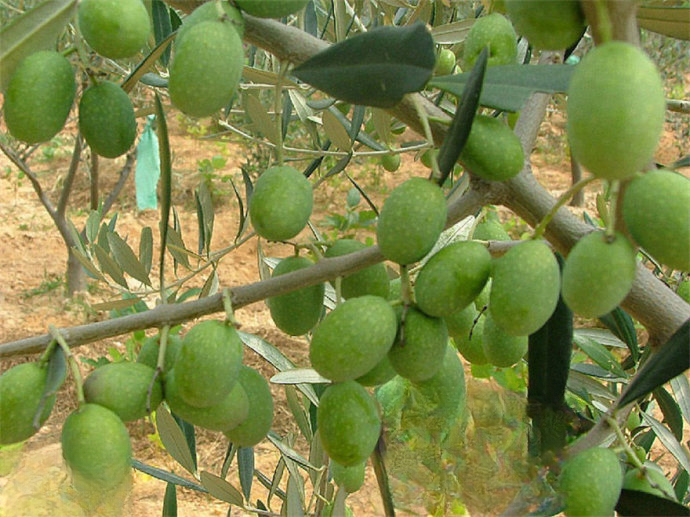 Olive (scientific name: Canarium album (Lour.) Raeusch. ) is a tree plant of the genus Olive in the family Oleaceae. It can grow up to 35 meters tall and 150 cm in diameter at breast height. There are 3-6 pairs of leaflets , which are papery to leathery, with 12-16 pairs of lateral veins and a well-developed midrib. The inflorescence is axillary, and the infructescence is 1.5-15 cm long , with 1-6 fruits. The fruit is ovate to fusiform, yellow-green when mature, with a thick exocarp, a hard stone, pointed at both ends, and a roughened surface. The flowering period is April to May , and the fruit matures in October to December . Olives are native to the south and are a good windbreak and street tree. The wood can be used for shipbuilding, sleepers, furniture, farm tools, and construction materials. The fruit can be eaten raw or pickled, and is used medicinally to treat laryngitis, hemoptysis, thirst, enteritis and diarrhea. The stone is used for carving and medicinal purposes, and is effective in treating fish bones stuck in the throat. The kernel is edible and can also be pressed for oil, which is used to make soap or lubricants. Oleaceae family Oleaceae. Holly (scientific name: Ilex cornuta ), also known as cat's thorn and tiger's thorn, is an evergreen shrub or small tree with peculiar leaves, bright green and evergreen all year round. After autumn, the branches are full of red fruits, which do not wither in winter. They are gorgeous and lovely. They are excellent ornamental leaves and fruit trees. They are often used for Christmas decorations in Europe and the United States, so they are also called "Christmas trees". Holly belongs to the genus Ilex of the family Aquifoliaceae. Sophora japonica, also known as Sophora japonica, Sophora japonica, Sophora japonica, Sophora japonica, Sophora japonica, Golden medicinal material, House-guarding tree, and Sophora japonica. The tree is tall and its pinnate compound leaves are similar to those of Robinia pseudoacacia. The flowers are light yellow and can be cooked and eaten, and can also be used as Chinese medicine or dye. The pods "Sophora japonica rice" are Chinese medicine. The flowering period is in late summer, which is different from the flowering period of other tree species. It is an important nectar plant. The flowers and pods are used as medicine, which has the effects of cooling, astringing, stopping bleeding and lowering blood pressure; the leaves and root bark have the effects of clearing heat and detoxifying, and can treat sores; the wood is used for construction. The kernel contains starch, which can be used for brewing wine or making paste and feed. The bark, branches, leaves, buds, flowers and seeds can all be used as medicine. Fabaceae (Leguminosae) Sophora genus. Michelia. Other names: Michelia beauty, Michelia plum, mountain knot fruit, white orchid, Tang yellow heart tree, banana flower. Latin name: Michelia figo ( Lour. ) Spreng . Evergreen shrub, 2-3 meters high , with gray-brown bark and dense branches; leathery leaves, narrow elliptic or obovate elliptic, flowering period from March to May , fruiting period from July to August . Aromatic flower, with jade-like buds and a faint orchid-like fragrance. Magnoliaceae Michelia genus. Nasturtium. Other names: dry lotus, cold lotus, golden lotus, dry lotus, golden lotus, cold nasturtium, big red cardinal. It is a plant of the Nasturtium family and genus Nasturtium, a perennial semi-climbing or procumbent plant. Plant height 30cm - 70cm . The basal leaves have long petioles, the leaves are pentagonal, three-partite, and the two lobes have a few small lobes and sharp teeth. The flowers are solitary or 2-3 in a cyme, with five petals and 8-19 sepals , yellow , elliptical obovate or obovate, the petals are the same length as the sepals, and narrow strips. Under suitable environmental conditions, it can bloom all year round, and a flower can last for 8-9 days . The whole plant can bloom dozens of flowers at the same time, with fragrant aroma, bright colors, fat leaves and beautiful flowers. The colors are purple, orange, and creamy yellow. The nasturtium has winding stems, and the leaves are shaped like bowl lotus. When the creamy yellow flowers are in full bloom, they are like a group of butterflies flying. It is an important ornamental flower. The flowers of nasturtium can be used as medicine. Its tender shoots, flower buds and fresh seeds can be used as spicy spices. Nasturtium genus, Nasturtium family. Red back osmanthus, also known as red back osmanthus, alias: red purple wood, purple back osmanthus, blue purple osmanthus, oriental osmanthus. An evergreen shrub named for its red back leaves. It is a foliage and flower ornamental plant with high practical value. Euphorbiaceae.
Olive (scientific name: Canarium album (Lour.) Raeusch. ) is a tree plant of the genus Olive in the family Oleaceae. It can grow up to 35 meters tall and 150 cm in diameter at breast height. There are 3-6 pairs of leaflets , which are papery to leathery, with 12-16 pairs of lateral veins and a well-developed midrib. The inflorescence is axillary, and the infructescence is 1.5-15 cm long , with 1-6 fruits. The fruit is ovate to fusiform, yellow-green when mature, with a thick exocarp, a hard stone, pointed at both ends, and a roughened surface. The flowering period is April to May , and the fruit matures in October to December . Olives are native to the south and are a good windbreak and street tree. The wood can be used for shipbuilding, sleepers, furniture, farm tools, and construction materials. The fruit can be eaten raw or pickled, and is used medicinally to treat laryngitis, hemoptysis, thirst, enteritis and diarrhea. The stone is used for carving and medicinal purposes, and is effective in treating fish bones stuck in the throat. The kernel is edible and can also be pressed for oil, which is used to make soap or lubricants. Oleaceae family Oleaceae. Holly (scientific name: Ilex cornuta ), also known as cat's thorn and tiger's thorn, is an evergreen shrub or small tree with peculiar leaves, bright green and evergreen all year round. After autumn, the branches are full of red fruits, which do not wither in winter. They are gorgeous and lovely. They are excellent ornamental leaves and fruit trees. They are often used for Christmas decorations in Europe and the United States, so they are also called "Christmas trees". Holly belongs to the genus Ilex of the family Aquifoliaceae. Sophora japonica, also known as Sophora japonica, Sophora japonica, Sophora japonica, Sophora japonica, Sophora japonica, Golden medicinal material, House-guarding tree, and Sophora japonica. The tree is tall and its pinnate compound leaves are similar to those of Robinia pseudoacacia. The flowers are light yellow and can be cooked and eaten, and can also be used as Chinese medicine or dye. The pods "Sophora japonica rice" are Chinese medicine. The flowering period is in late summer, which is different from the flowering period of other tree species. It is an important nectar plant. The flowers and pods are used as medicine, which has the effects of cooling, astringing, stopping bleeding and lowering blood pressure; the leaves and root bark have the effects of clearing heat and detoxifying, and can treat sores; the wood is used for construction. The kernel contains starch, which can be used for brewing wine or making paste and feed. The bark, branches, leaves, buds, flowers and seeds can all be used as medicine. Fabaceae (Leguminosae) Sophora genus. Michelia. Other names: Michelia beauty, Michelia plum, mountain knot fruit, white orchid, Tang yellow heart tree, banana flower. Latin name: Michelia figo ( Lour. ) Spreng . Evergreen shrub, 2-3 meters high , with gray-brown bark and dense branches; leathery leaves, narrow elliptic or obovate elliptic, flowering period from March to May , fruiting period from July to August . Aromatic flower, with jade-like buds and a faint orchid-like fragrance. Magnoliaceae Michelia genus. Nasturtium. Other names: dry lotus, cold lotus, golden lotus, dry lotus, golden lotus, cold nasturtium, big red cardinal. It is a plant of the Nasturtium family and genus Nasturtium, a perennial semi-climbing or procumbent plant. Plant height 30cm - 70cm . The basal leaves have long petioles, the leaves are pentagonal, three-partite, and the two lobes have a few small lobes and sharp teeth. The flowers are solitary or 2-3 in a cyme, with five petals and 8-19 sepals , yellow , elliptical obovate or obovate, the petals are the same length as the sepals, and narrow strips. Under suitable environmental conditions, it can bloom all year round, and a flower can last for 8-9 days . The whole plant can bloom dozens of flowers at the same time, with fragrant aroma, bright colors, fat leaves and beautiful flowers. The colors are purple, orange, and creamy yellow. The nasturtium has winding stems, and the leaves are shaped like bowl lotus. When the creamy yellow flowers are in full bloom, they are like a group of butterflies flying. It is an important ornamental flower. The flowers of nasturtium can be used as medicine. Its tender shoots, flower buds and fresh seeds can be used as spicy spices. Nasturtium genus, Nasturtium family. Red back osmanthus, also known as red back osmanthus, alias: red purple wood, purple back osmanthus, blue purple osmanthus, oriental osmanthus. An evergreen shrub named for its red back leaves. It is a foliage and flower ornamental plant with high practical value. Euphorbiaceae.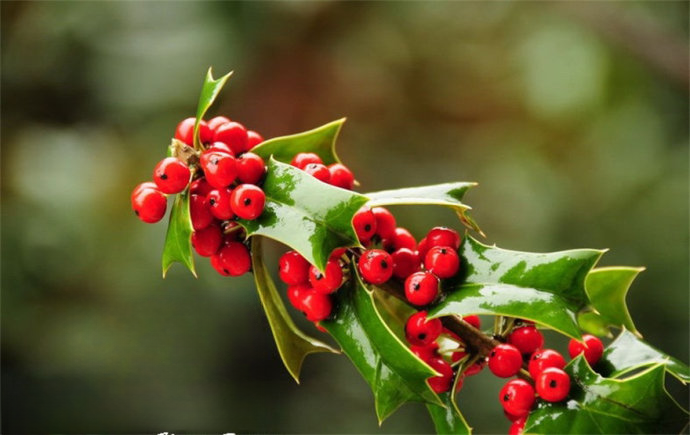
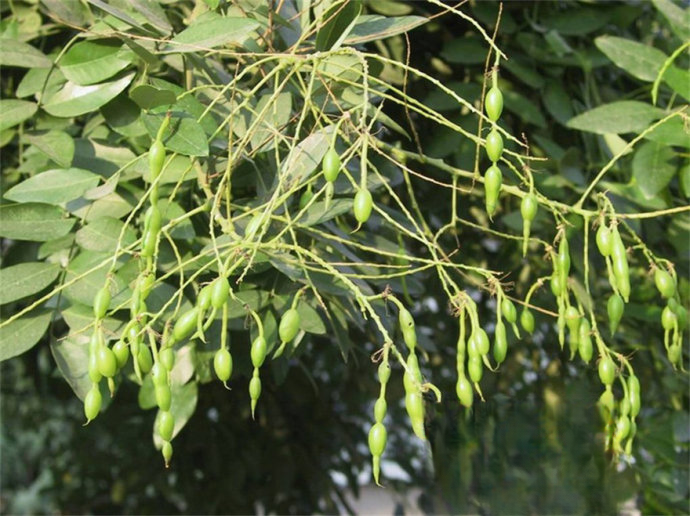
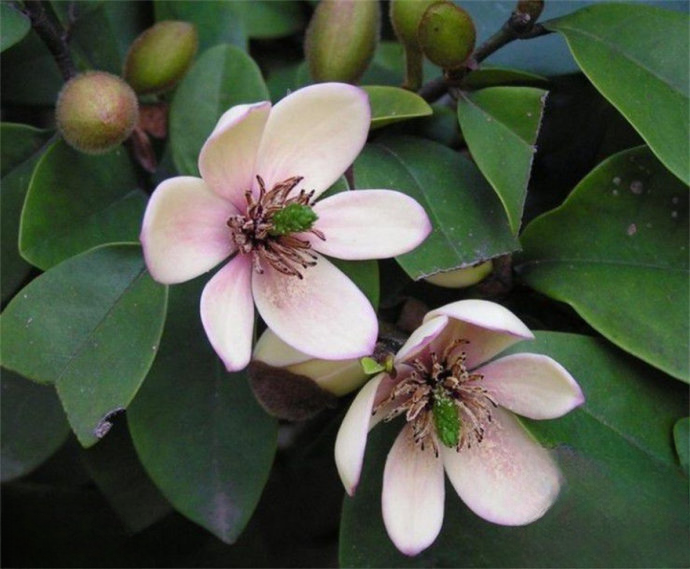
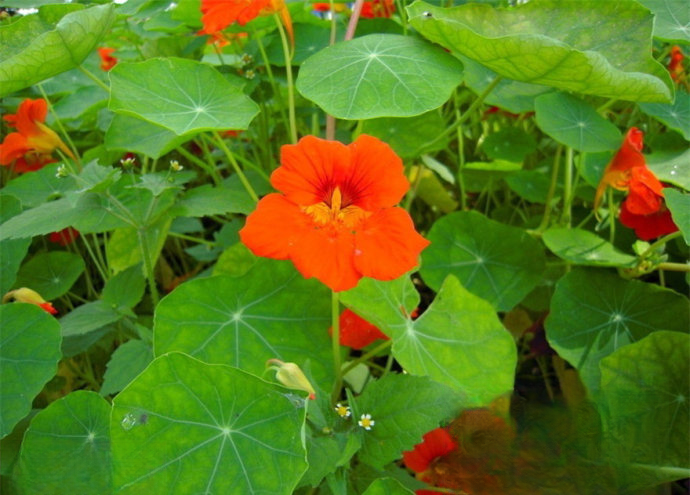
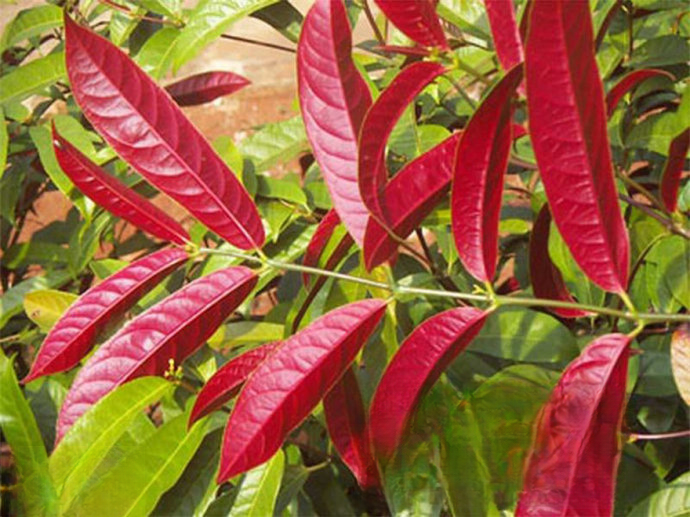
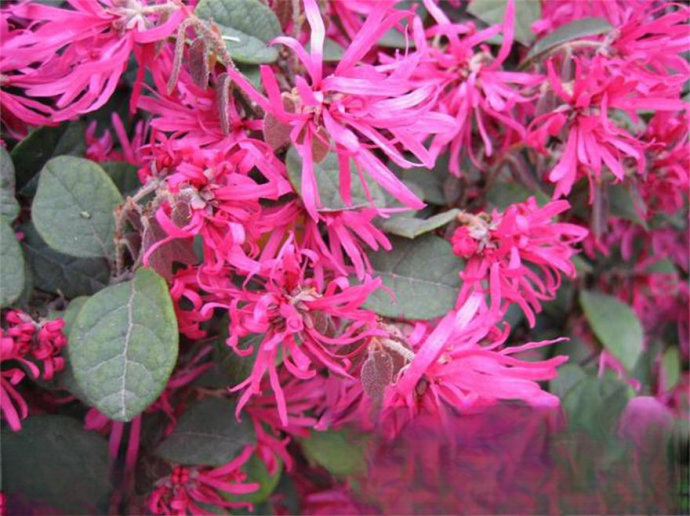 Loropetalum chinense var.rubrum (Latin name: Loropetalum chinense var.rubrum), also known as: red successor wood, red cypress wood, red cypress wood, red cypress flower, red cypress flower, red successor wood, is a variant of Loropetalum chinense of the Hamamelidaceae family, an evergreen shrub or small tree. The bark is dark gray or light gray-brown, with many branches. The young branches are reddish brown and densely covered with star-shaped hairs. The leaves are leathery and alternate, oval or elliptical, 2 to 5 cm long, with short tips, rounded and oblique bases, asymmetrical, with star-shaped hairs on both sides, entire, dark red. There are 4 petals, purple-red linear, 1 to 2 cm long, and 3 to 8 flowers clustered at the end of the twigs. The capsule is brown and nearly oval. The flowering period is from April to May, with a long flowering period of about 30 to 40 days, and it can bloom again on National Day. Flowers are clustered in terminal capitula on the common stalk in 3 to 8 clusters, purple-red in color. Fruiting season is August. Flowers, roots and leaves can be used as medicine.
Loropetalum chinense var.rubrum (Latin name: Loropetalum chinense var.rubrum), also known as: red successor wood, red cypress wood, red cypress wood, red cypress flower, red cypress flower, red successor wood, is a variant of Loropetalum chinense of the Hamamelidaceae family, an evergreen shrub or small tree. The bark is dark gray or light gray-brown, with many branches. The young branches are reddish brown and densely covered with star-shaped hairs. The leaves are leathery and alternate, oval or elliptical, 2 to 5 cm long, with short tips, rounded and oblique bases, asymmetrical, with star-shaped hairs on both sides, entire, dark red. There are 4 petals, purple-red linear, 1 to 2 cm long, and 3 to 8 flowers clustered at the end of the twigs. The capsule is brown and nearly oval. The flowering period is from April to May, with a long flowering period of about 30 to 40 days, and it can bloom again on National Day. Flowers are clustered in terminal capitula on the common stalk in 3 to 8 clusters, purple-red in color. Fruiting season is August. Flowers, roots and leaves can be used as medicine. 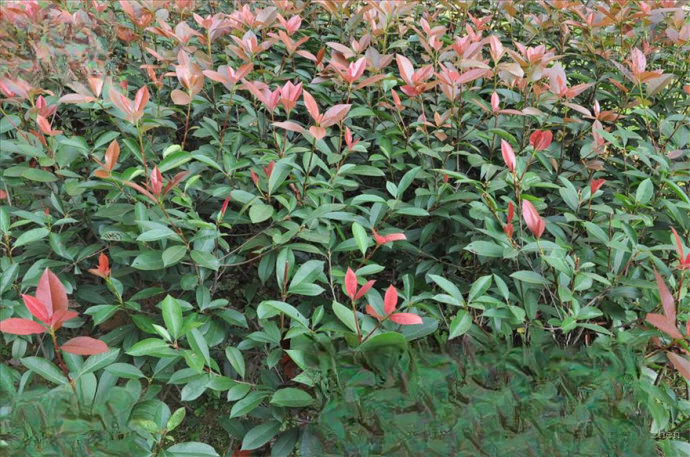 Red-leaf Photinia. Other names: Flame Red, Millennium Red, Red Robin, Red Lips, Sour-leaf Photinia. (Scientific name: Photiniaxfraseri ) is a general term for hybrids of the genus Photinia in the Rosaceae family, named for its bright red new shoots and young leaves. It is an evergreen small tree, 4-6 meters tall , with leathery leaves, oblong to obovate-lanceolate, bright red new leaves in spring, green in summer, red in autumn, winter and spring, and darker in frost, and better in low temperature. As a street tree, its pole stands like a torch; as a hedge, it lies like a fire dragon; when pruned for landscaping, it can have a variety of shapes and beautiful landscape effects. The most common varieties are Red Robin and Red Lips, of which Red Robin has bright and eye-catching leaves and is more ornamental. In spring and autumn, the new shoots and young leaves of Red-leaf Photinia are bright red, with bright and lasting colors and great vitality. In the hot summer season, the leaves turn bright green, giving people a fresh and cool feeling. Photinia genus, Rosaceae subfamily Apple family.
Red-leaf Photinia. Other names: Flame Red, Millennium Red, Red Robin, Red Lips, Sour-leaf Photinia. (Scientific name: Photiniaxfraseri ) is a general term for hybrids of the genus Photinia in the Rosaceae family, named for its bright red new shoots and young leaves. It is an evergreen small tree, 4-6 meters tall , with leathery leaves, oblong to obovate-lanceolate, bright red new leaves in spring, green in summer, red in autumn, winter and spring, and darker in frost, and better in low temperature. As a street tree, its pole stands like a torch; as a hedge, it lies like a fire dragon; when pruned for landscaping, it can have a variety of shapes and beautiful landscape effects. The most common varieties are Red Robin and Red Lips, of which Red Robin has bright and eye-catching leaves and is more ornamental. In spring and autumn, the new shoots and young leaves of Red-leaf Photinia are bright red, with bright and lasting colors and great vitality. In the hot summer season, the leaves turn bright green, giving people a fresh and cool feeling. Photinia genus, Rosaceae subfamily Apple family. 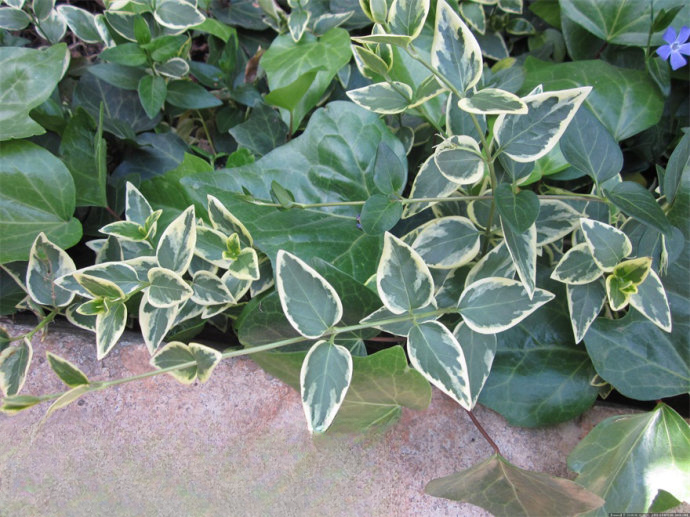 Variegated Vinca, also known as variegated ivy. (Scientific name: Vinca major var. variegata ) is a variant of Vinca major in the Apocynaceae family. It is a dwarf plant with creeping branches and creeping growth, up to 2 meters long . The leaves are elliptical, opposite, with petioles, bright green, shiny, and creamy yellow on the edges. The edges of the leaves are white with yellow-white spots. Apocynaceae family Vinca major. Glechoma longituba (Nakai)
Variegated Vinca, also known as variegated ivy. (Scientific name: Vinca major var. variegata ) is a variant of Vinca major in the Apocynaceae family. It is a dwarf plant with creeping branches and creeping growth, up to 2 meters long . The leaves are elliptical, opposite, with petioles, bright green, shiny, and creamy yellow on the edges. The edges of the leaves are white with yellow-white spots. Apocynaceae family Vinca major. Glechoma longituba (Nakai) 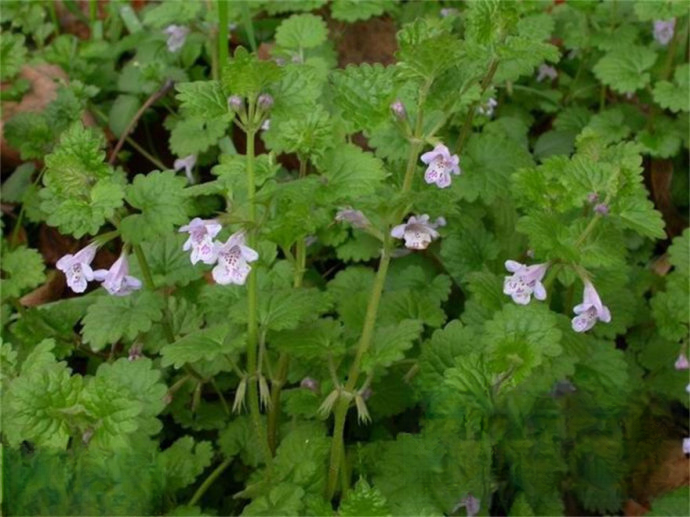 Kupr, also known as ground incense, ground money, cymbals, money grass, copper coin grass, white ear mo, frankincense vine. (Scientific name: Glechoma longituba (Nakai) Kupr ) is a perennial herb with creeping stems that ascend and root at each node. The stem is 10-20 ( 30 ) cm tall, quadrangular, the base is usually light purple-red, almost hairless, and the young parts are covered with sparse long soft hairs. It is pungent and cool in nature. It can be taken orally or applied externally. It has the effects of removing dampness and relieving stranguria, clearing away heat and detoxifying, dispersing blood stasis and reducing swelling. It belongs to the genus Huoxuedan of the family
Kupr, also known as ground incense, ground money, cymbals, money grass, copper coin grass, white ear mo, frankincense vine. (Scientific name: Glechoma longituba (Nakai) Kupr ) is a perennial herb with creeping stems that ascend and root at each node. The stem is 10-20 ( 30 ) cm tall, quadrangular, the base is usually light purple-red, almost hairless, and the young parts are covered with sparse long soft hairs. It is pungent and cool in nature. It can be taken orally or applied externally. It has the effects of removing dampness and relieving stranguria, clearing away heat and detoxifying, dispersing blood stasis and reducing swelling. It belongs to the genus Huoxuedan of the family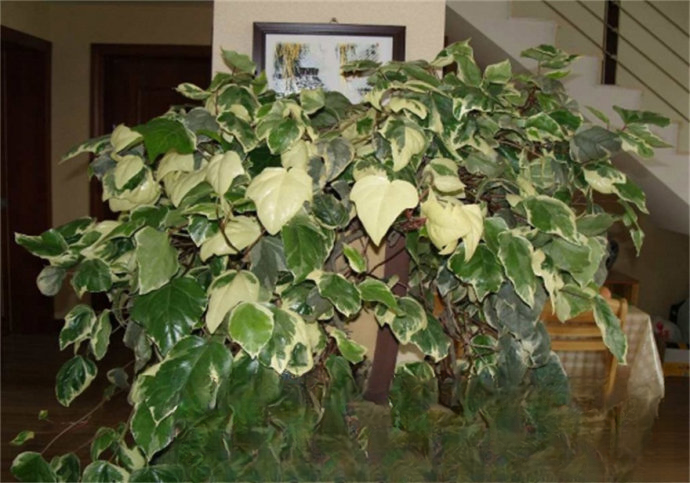 Lamiaceae. Canary ivy is a species of the genus Ivy. It is an evergreen vine with stellate hairs on the stems; the twigs and petioles are brown-red. The juvenile leaves are relatively large, ovate, 6-15cm long , heart-shaped at the base, entire, and leathery; the mature leaves are ovate-lanceolate. The inflorescence is a racemose panicle. The fruit is black. It is native to the Canary Islands in northwest Africa. It is often cultivated and appreciated outdoors in subtropical areas. It is also a good material for indoor greening. It belongs to the genus Ivy of the family Araliaceae.
Lamiaceae. Canary ivy is a species of the genus Ivy. It is an evergreen vine with stellate hairs on the stems; the twigs and petioles are brown-red. The juvenile leaves are relatively large, ovate, 6-15cm long , heart-shaped at the base, entire, and leathery; the mature leaves are ovate-lanceolate. The inflorescence is a racemose panicle. The fruit is black. It is native to the Canary Islands in northwest Africa. It is often cultivated and appreciated outdoors in subtropical areas. It is also a good material for indoor greening. It belongs to the genus Ivy of the family Araliaceae. 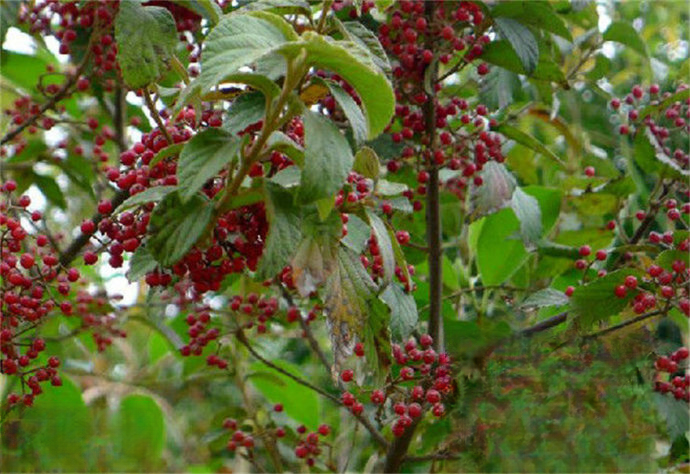 Viburnum dilatatum Thunb. is also known as: 檕迷, 檕蒾. It is a deciduous shrub that can reach 3 meters in height . The leaves are papery, obovate, and the inflorescence is dense in the form of a compound cyme. The flowers are borne on the third to fourth level radiating branches. The corolla is white and radial, and the anthers are small and milky white. The fruit is red, elliptical and oval, with a flat and oval core . It blooms in May and June and bears fruit in September and November . It is a native species that can be planted in the ground or potted, and requires extensive management. The bast fiber of Viburnum can be used to make ropes and artificial cotton. The seeds contain 10.03-12.91% oil , which can be used to make soap and lubricants. The fruit is edible and can also be used to make wine. The branches and leaves clear away heat and detoxify, dispel wind and relieve the symptoms, and are used for furunculosis, fever, wind-heat colds; external use is used to treat allergic dermatitis. Roots: pungent, astringent, and cool. It removes blood stasis and reduces swelling. It is used for scrofula, traumatic injuries, and removes blood stasis and reduces swelling. Viburnum genus, Caprifoliaceae. Elaeocarpus apiculatus Masters is the common name of Elaeocarpus apiculatus Masters. It is now mostly called Elaeocarpus apiculatus Masters. It is a tree with gray bark; the twigs are sturdy and covered with gray-brown soft hairs, with many round petioles with scars, and wrinkled with straight stripes after drying. The leaves are clustered at the top of the branches, leathery, obovate-lanceolate. The drupe is oval, 3-3.5 cm long , with brown hairs. The flowering period is from August to September , and the fruit matures in winter. The buttress roots at the base of the trunk of an adult tree are very spectacular. The flowers are white like shells and fragrant. After midsummer, there are abundant fruits. It is an excellent woody flower, landscape tree and street tree. Elaeocarpus apiculatus Masters is a species of Elaeocarpus apiculatus Masters in the Elaeocarpus family. Elaeocarpus apiculatus Masters, also known as Rusty Scales Masters. It is an evergreen shrub or small tree; the young branches have longitudinal grooves and are densely covered with rusty scales. Simple leaves are opposite, with petioles 3-5mm long and covered with rusty scales; leaves are leathery, narrowly lanceolate to oblong-elliptic, 3-10cm long , 1-2cm wide , acuminate at the apex, with long convex tips, gradually narrow at the base, slightly recurved leaf margins, glabrous on both sides or with fine hairs on the midrib above, densely covered with rusty scales below. Panicles are axillary, with ridged peduncles and slightly covered with rusty scales; bracts are linear or scaly, about 1mm long ; pedicels are 0-1mm long ; flowers are white, bisexual; calyx is small, cup-shaped, and tooth-lobed; corolla is 2.5-3.5mm long , the corolla tube is nearly as long as the calyx, and the lobes are elliptic; filaments are very short, anthers are oblong, enclosed, and slightly shorter than the corolla lobes; ovary is nearly round, style is short, nearly as long as the corolla tube, and stigma is capitate. The fruit is broadly oval or nearly spherical, 7-9mm long , 4-6mm in diameter , and dark brown when mature. The flowering period is from April to August , and the fruiting period is from August to November . Edgeworthia chrysantha. , also known as: knotted flower, knotted tree, yellow daphne, home fragrance, happy flower, dream winter flower. Shrub, about 0.7-1.5 meters high , with sturdy, brown twigs, often trifurcated, young branches often covered with short soft hairs, extremely tough bast, large leaf scars, about 5 mm in diameter . The leaves fall before flowering, oblong, lanceolate to oblanceolate, with short pointed tips and cuneate or gradually narrowed bases. The stem bark fiber can be used as raw material for high-grade paper and artificial cotton. The whole plant can be used as medicine to relax muscles and activate collaterals, reduce inflammation and relieve pain, and can treat injuries and rheumatism; it can also be used as veterinary medicine to treat cattle injuries. It can be cultivated for viewing. Thymelaeaceae, genus Ligustrum. Golden Ligustrum is a variant of Ligustrum microphyllum. It is named for its beautiful lemon yellow leaves in autumn, winter and early spring. It is evergreen in the south and leaves fall in winter in the north. It can overwinter in the open field. Golden Ligustrum species, Ligustrum genus, Ligustrum genus , Oleaceae ... The bark can be used to extract tannin, which is used as medicine (commonly known as Tujinpi) to help treat stubborn ringworm and food accumulation. The root bark can also be used as medicine and papermaking glue. The seeds can be used to extract oil. Pinaceae Abies subfamily Golden Pinus genus. Hypericum (Latin name: Hypericum monogynum L. ), also known as dog beard flower (Huoshan, Anhui), golden butterfly (Nanchuan, Sichuan, Yueqing, Zhejiang), cross-road yellow (Fengjie, Sichuan), golden begonia (Laoshan, Shandong), golden lotus (Shiquan, Shaanxi), and Tulianqiao, is a semi-evergreen small tree or shrub: withered at the end of each growing season above ground, perennial underground. The twigs are slender and branched, the leaves are papery, sessile, opposite, and oblong, and the flowering period is June-July . The inflorescences are gathered into cymes at the top of the branches, the flowers are golden yellow, and the bundled and slender stamen filaments are also as bright as golden threads. Hypericum can be used as bonsai material, with beautiful flowers for viewing; the fruit and root are used for medicinal purposes, the fruit is used as a substitute for forsythia, the root can dispel wind, relieve cough, promote lactation, regulate menstruation and replenish blood, and can treat injuries from falls. It belongs to the genus Hypericum, the subfamily Hypericaceae, the tribe Hypericaceae. Chlorophytum comosum, Latin name: Chlorophytum comosum , is a perennial evergreen herb, a common flower, and is now widely planted. It is an evergreen perennial herb with rhizomes in the underground part, slender leaves, linear lanceolate, with yellow-white vertical stripes in the center, and bright green at the base. Creeping branches grow from the leaf axils, extending out of the plant cluster, bending outward, and small plants with aerial roots grow at the top. The flowers are white, with 6 perianths, and the flowering period is spring and summer. Flower language: " helpless but gives people hope " . It is a common bonsai green plant for office and home. Chlorophytum genus, Liliaceae. Mahonia bealei (Fort.) Carr ., also known as yellow cedar, yellow lian, octagonal thorn, thorny yellow cedar, yellow bamboo. It is an evergreen shrub or small tree, up to 2 meters high . The leaves are oblong, dark green on the upper side, with prominent veins, light yellow-green on the back, and raised reticular veins. The leaflets are sessile, with a pair of obovate oblong leaflets at the base. The racemes are clustered, 5-6 cm long ; the bud scales are ovate-lanceolate, the bracts are broadly lanceolate, and the flowers are bright yellow to sulfur yellow; the outer sepals are ovate, the petals are oblong, the style is very short, and there are 2 ovules . The berries are obovate, blue-black, slightly covered with white powder, blooming from March to May , and fruiting from May to August . It is distributed in western Hubei, northeastern Guizhou, Sichuan, Yunnan, and Tibet. It is also distributed in Myanmar and India (Assam). The flowers of Mahonia bealei are cool in nature and sweet in taste. The roots and stems are cold in nature and bitter in taste. Contains berberine, jatrorrhizine, magnolamine, etc. It has the effects of clearing away heat and detoxifying, relieving cough and reducing phlegm. It has an inhibitory effect on Staphylococcus aureus, Shigella dysenteriae, and Escherichia coli. It is mainly used to treat bacterial dysentery, gastroenteritis, infectious hepatitis, bronchitis, sore throat, conjunctivitis, burns, scalds, etc. It is a broad-leaved species of the genus Eucalyptus in the Berberidaceae family. Eucalyptus globulus Labill. (scientific name: Eucalyptus globulus Labill. ) is a large tree; the bark is gray-blue and peels off in sheets; the young branches are slightly ridged. Juvenile leaves are opposite, sessile, with white powder; flowers are large, 4 mm wide , solitary or 2-3 flowers are clustered in the axils of leaves; peduncles are absent or very short; calyx tube is obconical, with 4 protruding edges and small tubercles on the surface, covered with white powder; cap-shaped body is slightly flat, caducous early; stamens are multi-row, filaments are slender, anthers are elliptical; style is 7-8 mm long and thick. Capsule is hemispherical, with 4 edges, flat and wide fruit margins, and fruit petals are not prominent. It is cultivated in Guangxi, Yunnan, Sichuan and other places. The northernmost can be reached in Chengdu and Hanzhong. Leaves and fruits are used as medicine. Myrtaceae Eucalyptus . Ulmus parvifolia Jacq is also known as small-leaved elm. The tree has a beautiful shape, a chic posture, mottled bark, and dense branches and leaves. It is suitable for solitary planting or cluster planting in the courtyard, or for configuration with pavilions and rocks. It can also be selected as a tree species for greening residential buildings in mining areas. The wood of the elm tree is hard and can be used as industrial material; the stem bark fiber is strong and can be used as ropes and artificial fibers; the roots, bark, and young leaves are used as medicine to reduce swelling and relieve pain, detoxify and treat fever, and can be applied externally to treat burns caused by water or fire; the leaves are used to make local pesticides and can kill red spiders. Ulmus genus, Ulmus family. Pilea notata CH Wright , also known as transparent grass, transparent white grass, aluminum leaf grass, white snow grass, and long-handled cold water hemp. Perennial herb with creeping stems. The stem is fleshy, slender, slightly swollen in the middle, with slender petioles, often glabrous, rarely with short soft hairs; stipules are large and green. The flowers are dioecious, with green-yellow tepals, white or pink anthers, and red filaments and intercourse. Achenes are small, round and oval, and green-brown when ripe. The flowering period is from June to September , and the fruiting period is from September to November . It is distributed in Guangxi and Guangdong, through the middle and lower reaches of the Yangtze River Basin, north to southern Shaanxi and southern Henan; it is also distributed in Vietnam and Japan. It grows in valleys, streams or shaded wet places under forests, at an altitude of 300-1500 meters . Pilea is a popular small foliage plant. The whole herb is used for medicinal purposes, and has the effects of clearing away heat and dampness, promoting fluid and quenching thirst, and relieving jaundice and protecting the liver. Pilea genus, Urticaceae family, staircase family.
Viburnum dilatatum Thunb. is also known as: 檕迷, 檕蒾. It is a deciduous shrub that can reach 3 meters in height . The leaves are papery, obovate, and the inflorescence is dense in the form of a compound cyme. The flowers are borne on the third to fourth level radiating branches. The corolla is white and radial, and the anthers are small and milky white. The fruit is red, elliptical and oval, with a flat and oval core . It blooms in May and June and bears fruit in September and November . It is a native species that can be planted in the ground or potted, and requires extensive management. The bast fiber of Viburnum can be used to make ropes and artificial cotton. The seeds contain 10.03-12.91% oil , which can be used to make soap and lubricants. The fruit is edible and can also be used to make wine. The branches and leaves clear away heat and detoxify, dispel wind and relieve the symptoms, and are used for furunculosis, fever, wind-heat colds; external use is used to treat allergic dermatitis. Roots: pungent, astringent, and cool. It removes blood stasis and reduces swelling. It is used for scrofula, traumatic injuries, and removes blood stasis and reduces swelling. Viburnum genus, Caprifoliaceae. Elaeocarpus apiculatus Masters is the common name of Elaeocarpus apiculatus Masters. It is now mostly called Elaeocarpus apiculatus Masters. It is a tree with gray bark; the twigs are sturdy and covered with gray-brown soft hairs, with many round petioles with scars, and wrinkled with straight stripes after drying. The leaves are clustered at the top of the branches, leathery, obovate-lanceolate. The drupe is oval, 3-3.5 cm long , with brown hairs. The flowering period is from August to September , and the fruit matures in winter. The buttress roots at the base of the trunk of an adult tree are very spectacular. The flowers are white like shells and fragrant. After midsummer, there are abundant fruits. It is an excellent woody flower, landscape tree and street tree. Elaeocarpus apiculatus Masters is a species of Elaeocarpus apiculatus Masters in the Elaeocarpus family. Elaeocarpus apiculatus Masters, also known as Rusty Scales Masters. It is an evergreen shrub or small tree; the young branches have longitudinal grooves and are densely covered with rusty scales. Simple leaves are opposite, with petioles 3-5mm long and covered with rusty scales; leaves are leathery, narrowly lanceolate to oblong-elliptic, 3-10cm long , 1-2cm wide , acuminate at the apex, with long convex tips, gradually narrow at the base, slightly recurved leaf margins, glabrous on both sides or with fine hairs on the midrib above, densely covered with rusty scales below. Panicles are axillary, with ridged peduncles and slightly covered with rusty scales; bracts are linear or scaly, about 1mm long ; pedicels are 0-1mm long ; flowers are white, bisexual; calyx is small, cup-shaped, and tooth-lobed; corolla is 2.5-3.5mm long , the corolla tube is nearly as long as the calyx, and the lobes are elliptic; filaments are very short, anthers are oblong, enclosed, and slightly shorter than the corolla lobes; ovary is nearly round, style is short, nearly as long as the corolla tube, and stigma is capitate. The fruit is broadly oval or nearly spherical, 7-9mm long , 4-6mm in diameter , and dark brown when mature. The flowering period is from April to August , and the fruiting period is from August to November . Edgeworthia chrysantha. , also known as: knotted flower, knotted tree, yellow daphne, home fragrance, happy flower, dream winter flower. Shrub, about 0.7-1.5 meters high , with sturdy, brown twigs, often trifurcated, young branches often covered with short soft hairs, extremely tough bast, large leaf scars, about 5 mm in diameter . The leaves fall before flowering, oblong, lanceolate to oblanceolate, with short pointed tips and cuneate or gradually narrowed bases. The stem bark fiber can be used as raw material for high-grade paper and artificial cotton. The whole plant can be used as medicine to relax muscles and activate collaterals, reduce inflammation and relieve pain, and can treat injuries and rheumatism; it can also be used as veterinary medicine to treat cattle injuries. It can be cultivated for viewing. Thymelaeaceae, genus Ligustrum. Golden Ligustrum is a variant of Ligustrum microphyllum. It is named for its beautiful lemon yellow leaves in autumn, winter and early spring. It is evergreen in the south and leaves fall in winter in the north. It can overwinter in the open field. Golden Ligustrum species, Ligustrum genus, Ligustrum genus , Oleaceae ... The bark can be used to extract tannin, which is used as medicine (commonly known as Tujinpi) to help treat stubborn ringworm and food accumulation. The root bark can also be used as medicine and papermaking glue. The seeds can be used to extract oil. Pinaceae Abies subfamily Golden Pinus genus. Hypericum (Latin name: Hypericum monogynum L. ), also known as dog beard flower (Huoshan, Anhui), golden butterfly (Nanchuan, Sichuan, Yueqing, Zhejiang), cross-road yellow (Fengjie, Sichuan), golden begonia (Laoshan, Shandong), golden lotus (Shiquan, Shaanxi), and Tulianqiao, is a semi-evergreen small tree or shrub: withered at the end of each growing season above ground, perennial underground. The twigs are slender and branched, the leaves are papery, sessile, opposite, and oblong, and the flowering period is June-July . The inflorescences are gathered into cymes at the top of the branches, the flowers are golden yellow, and the bundled and slender stamen filaments are also as bright as golden threads. Hypericum can be used as bonsai material, with beautiful flowers for viewing; the fruit and root are used for medicinal purposes, the fruit is used as a substitute for forsythia, the root can dispel wind, relieve cough, promote lactation, regulate menstruation and replenish blood, and can treat injuries from falls. It belongs to the genus Hypericum, the subfamily Hypericaceae, the tribe Hypericaceae. Chlorophytum comosum, Latin name: Chlorophytum comosum , is a perennial evergreen herb, a common flower, and is now widely planted. It is an evergreen perennial herb with rhizomes in the underground part, slender leaves, linear lanceolate, with yellow-white vertical stripes in the center, and bright green at the base. Creeping branches grow from the leaf axils, extending out of the plant cluster, bending outward, and small plants with aerial roots grow at the top. The flowers are white, with 6 perianths, and the flowering period is spring and summer. Flower language: " helpless but gives people hope " . It is a common bonsai green plant for office and home. Chlorophytum genus, Liliaceae. Mahonia bealei (Fort.) Carr ., also known as yellow cedar, yellow lian, octagonal thorn, thorny yellow cedar, yellow bamboo. It is an evergreen shrub or small tree, up to 2 meters high . The leaves are oblong, dark green on the upper side, with prominent veins, light yellow-green on the back, and raised reticular veins. The leaflets are sessile, with a pair of obovate oblong leaflets at the base. The racemes are clustered, 5-6 cm long ; the bud scales are ovate-lanceolate, the bracts are broadly lanceolate, and the flowers are bright yellow to sulfur yellow; the outer sepals are ovate, the petals are oblong, the style is very short, and there are 2 ovules . The berries are obovate, blue-black, slightly covered with white powder, blooming from March to May , and fruiting from May to August . It is distributed in western Hubei, northeastern Guizhou, Sichuan, Yunnan, and Tibet. It is also distributed in Myanmar and India (Assam). The flowers of Mahonia bealei are cool in nature and sweet in taste. The roots and stems are cold in nature and bitter in taste. Contains berberine, jatrorrhizine, magnolamine, etc. It has the effects of clearing away heat and detoxifying, relieving cough and reducing phlegm. It has an inhibitory effect on Staphylococcus aureus, Shigella dysenteriae, and Escherichia coli. It is mainly used to treat bacterial dysentery, gastroenteritis, infectious hepatitis, bronchitis, sore throat, conjunctivitis, burns, scalds, etc. It is a broad-leaved species of the genus Eucalyptus in the Berberidaceae family. Eucalyptus globulus Labill. (scientific name: Eucalyptus globulus Labill. ) is a large tree; the bark is gray-blue and peels off in sheets; the young branches are slightly ridged. Juvenile leaves are opposite, sessile, with white powder; flowers are large, 4 mm wide , solitary or 2-3 flowers are clustered in the axils of leaves; peduncles are absent or very short; calyx tube is obconical, with 4 protruding edges and small tubercles on the surface, covered with white powder; cap-shaped body is slightly flat, caducous early; stamens are multi-row, filaments are slender, anthers are elliptical; style is 7-8 mm long and thick. Capsule is hemispherical, with 4 edges, flat and wide fruit margins, and fruit petals are not prominent. It is cultivated in Guangxi, Yunnan, Sichuan and other places. The northernmost can be reached in Chengdu and Hanzhong. Leaves and fruits are used as medicine. Myrtaceae Eucalyptus . Ulmus parvifolia Jacq is also known as small-leaved elm. The tree has a beautiful shape, a chic posture, mottled bark, and dense branches and leaves. It is suitable for solitary planting or cluster planting in the courtyard, or for configuration with pavilions and rocks. It can also be selected as a tree species for greening residential buildings in mining areas. The wood of the elm tree is hard and can be used as industrial material; the stem bark fiber is strong and can be used as ropes and artificial fibers; the roots, bark, and young leaves are used as medicine to reduce swelling and relieve pain, detoxify and treat fever, and can be applied externally to treat burns caused by water or fire; the leaves are used to make local pesticides and can kill red spiders. Ulmus genus, Ulmus family. Pilea notata CH Wright , also known as transparent grass, transparent white grass, aluminum leaf grass, white snow grass, and long-handled cold water hemp. Perennial herb with creeping stems. The stem is fleshy, slender, slightly swollen in the middle, with slender petioles, often glabrous, rarely with short soft hairs; stipules are large and green. The flowers are dioecious, with green-yellow tepals, white or pink anthers, and red filaments and intercourse. Achenes are small, round and oval, and green-brown when ripe. The flowering period is from June to September , and the fruiting period is from September to November . It is distributed in Guangxi and Guangdong, through the middle and lower reaches of the Yangtze River Basin, north to southern Shaanxi and southern Henan; it is also distributed in Vietnam and Japan. It grows in valleys, streams or shaded wet places under forests, at an altitude of 300-1500 meters . Pilea is a popular small foliage plant. The whole herb is used for medicinal purposes, and has the effects of clearing away heat and dampness, promoting fluid and quenching thirst, and relieving jaundice and protecting the liver. Pilea genus, Urticaceae family, staircase family.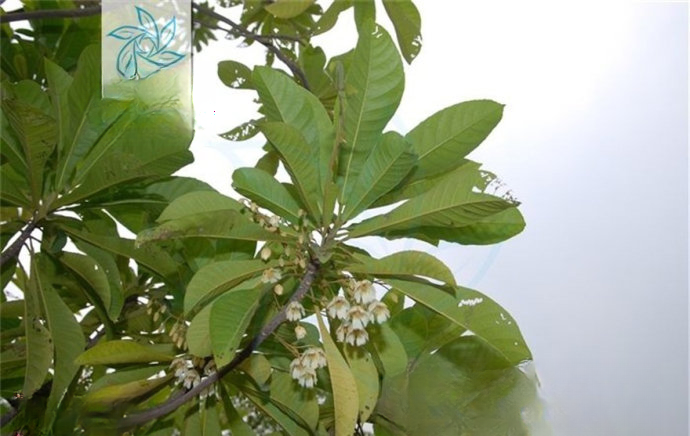
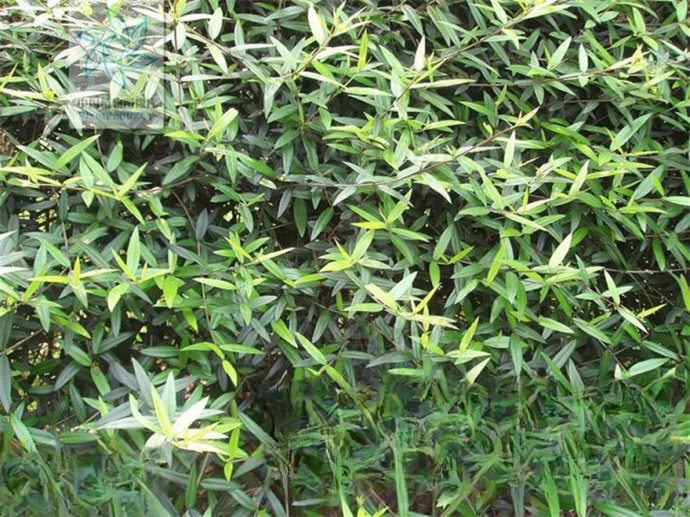
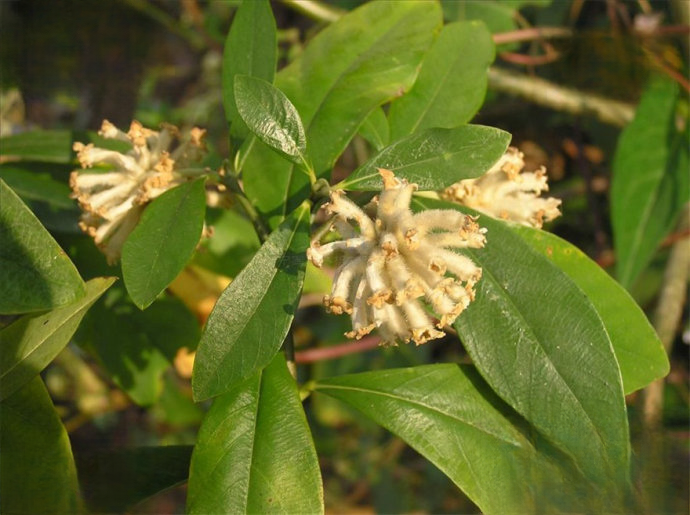

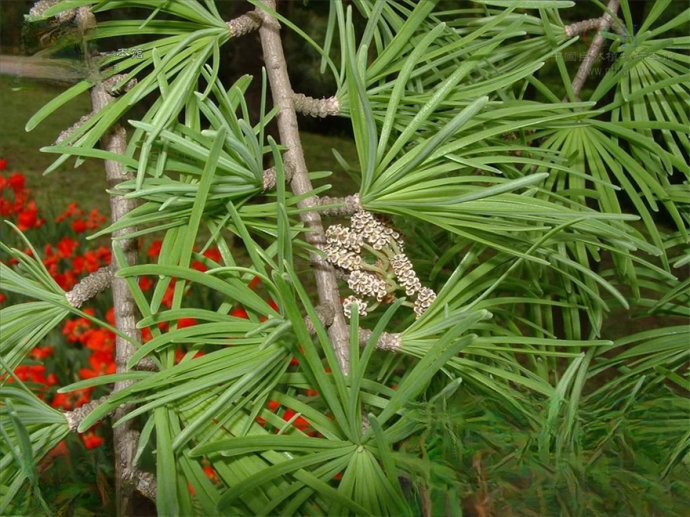
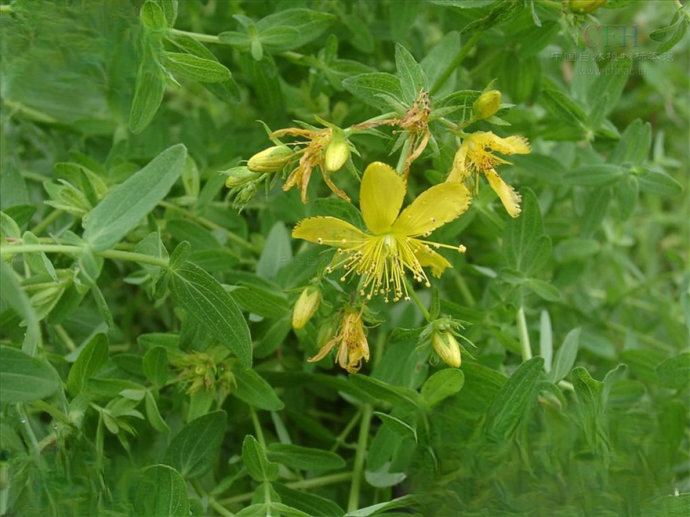
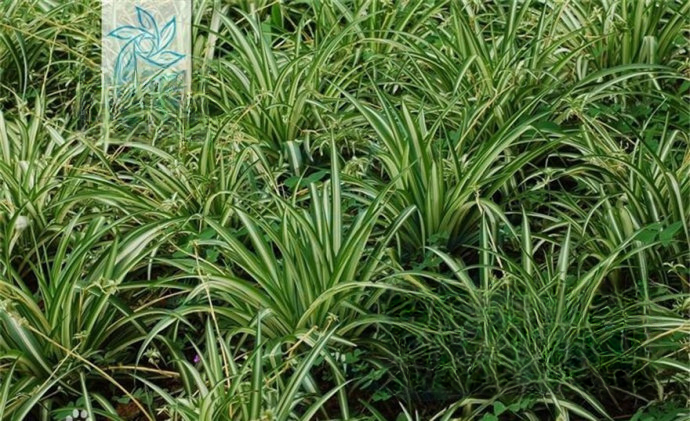
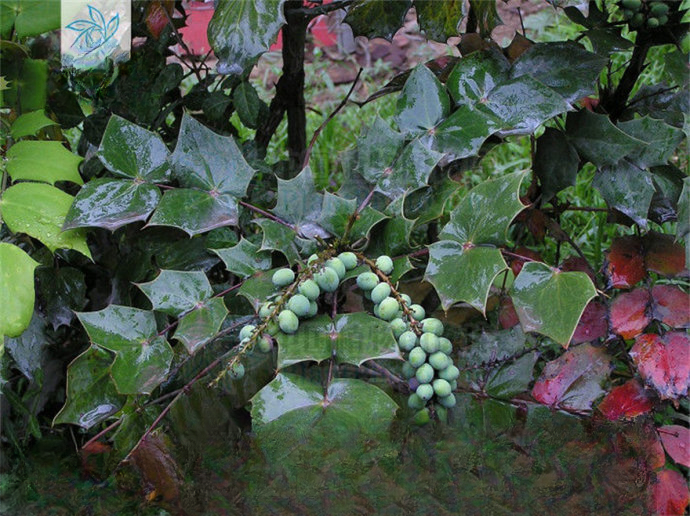
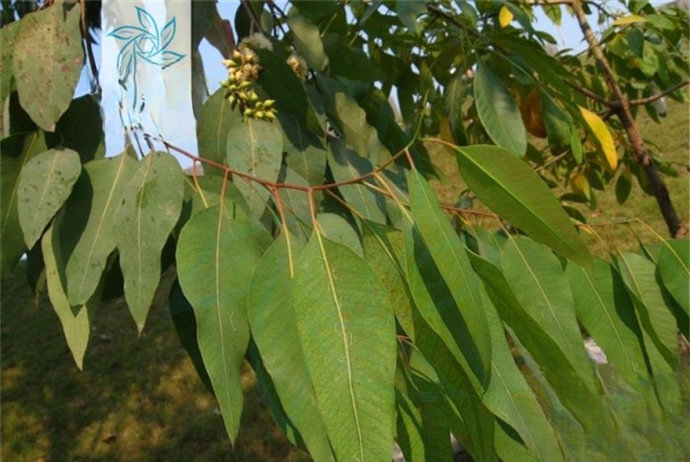
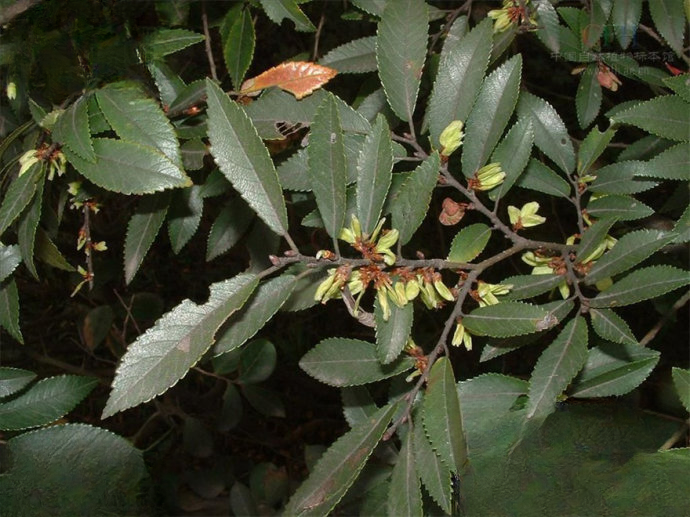
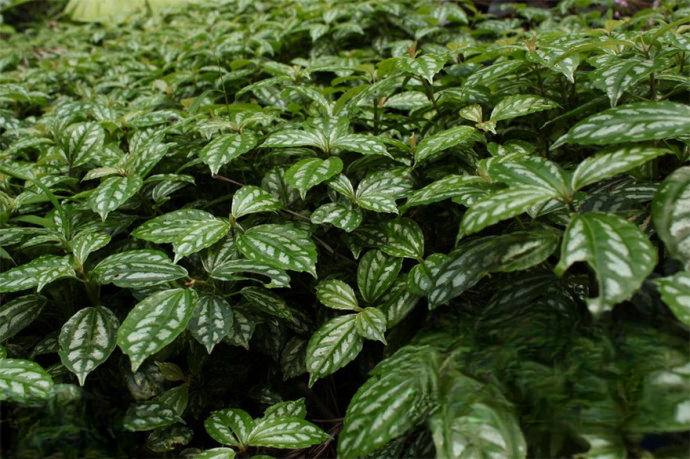
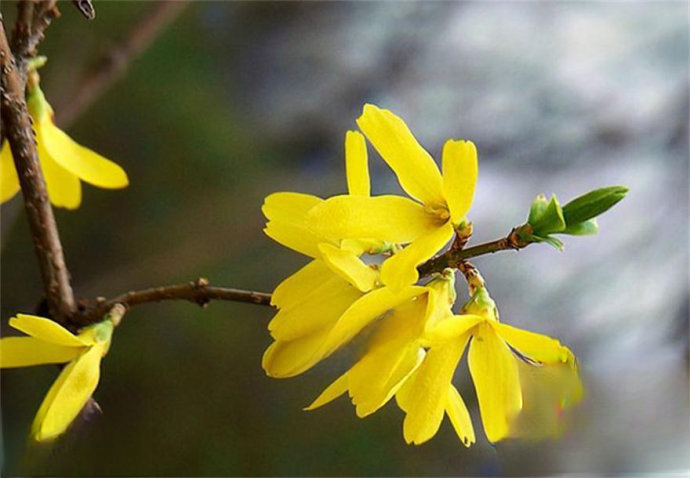
Forsythia suspensa. Scientific name (Forsythia suspensa), alias: yellow flower strip, shell, green forsythia, fallen forsythia, yellow forsythia. Deciduous shrub, commonly known as a string of gold in Hong Kong. Forsythia suspensa blooms before leaves in early spring. The flowers are fragrant and bright, and the branches are full of golden yellow, which is gorgeous and lovely. It is an excellent flowering shrub in early spring. The plant is about 3 meters tall, with clustered branches and yellow twigs, arched and drooping, hollow. The leaves are opposite, simple or trifoliate, ovate or ovate-elliptic, with toothed margins. The corolla is yellow, 1-3 flowers grow in the axils of leaves; the fruit is ovoid, ovate-elliptic or oblong, with a beak-like acuminate tip and sparse lenticels on the surface; the fruit pedicel is 0.7-1.5 cm long. The flowering period is March-April, and the fruiting period is July-September. Forsythia genus, Oleaceae, Oleaceae, subfamily Oleaceae, tribe Syringae.
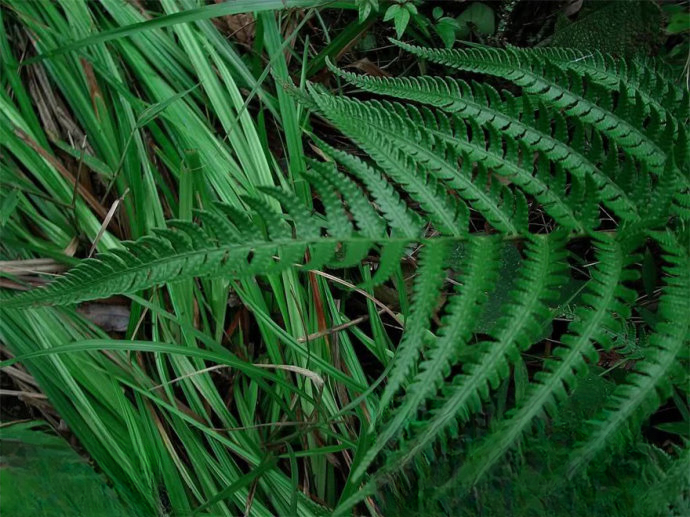 Dryopteris. The rhizome is short and thick, erect, with leaves clustered at the top in a radial pattern, usually covered with brown to black scales of different sizes and shapes. The leaves are pinnate-lobed. The spore sacs are clustered on the back of the small veins, with a round kidney-shaped spore operculum. There are about 400 species in the genus, and nearly 200 species are the distribution center of the genus. It is widely distributed in Northeast China and northeastern Hebei; it is also found in North Korea and Japan, and is mostly found in Xiaoyi Mountain, Huangdao District, Qingdao, Shandong. Its rhizome contains milanocyanin, which is an agent for expelling digestive tract parasites. Dryopteris genus, Dryopteris family.
Dryopteris. The rhizome is short and thick, erect, with leaves clustered at the top in a radial pattern, usually covered with brown to black scales of different sizes and shapes. The leaves are pinnate-lobed. The spore sacs are clustered on the back of the small veins, with a round kidney-shaped spore operculum. There are about 400 species in the genus, and nearly 200 species are the distribution center of the genus. It is widely distributed in Northeast China and northeastern Hebei; it is also found in North Korea and Japan, and is mostly found in Xiaoyi Mountain, Huangdao District, Qingdao, Shandong. Its rhizome contains milanocyanin, which is an agent for expelling digestive tract parasites. Dryopteris genus, Dryopteris family. 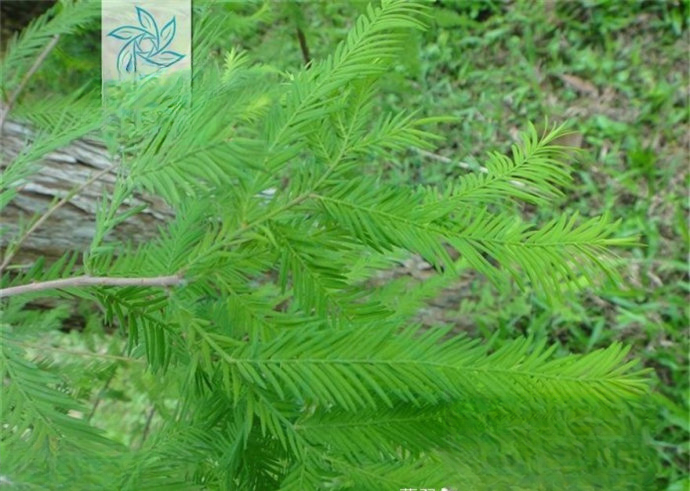 Taxodium distichum (L.) Rich. ): Also known as bald cypress, it is a large deciduous tree with a height of 25 to 50 meters. In the young to middle-aged stage ( less than 50 years old), the trunk is round and straight, with a conical or umbrella-shaped ovate crown. Some plants over 50 years old will gradually form an irregular and wide crown. The crown of the pond cypress is relatively narrow, and it is basically in the shape of a spire when it is less than 50 years old. It is an ancient "relic plant" that is resistant to low temperatures, salt and alkali, and flooding. Taxaceae Taxodium
Taxodium distichum (L.) Rich. ): Also known as bald cypress, it is a large deciduous tree with a height of 25 to 50 meters. In the young to middle-aged stage ( less than 50 years old), the trunk is round and straight, with a conical or umbrella-shaped ovate crown. Some plants over 50 years old will gradually form an irregular and wide crown. The crown of the pond cypress is relatively narrow, and it is basically in the shape of a spire when it is less than 50 years old. It is an ancient "relic plant" that is resistant to low temperatures, salt and alkali, and flooding. Taxaceae Taxodium 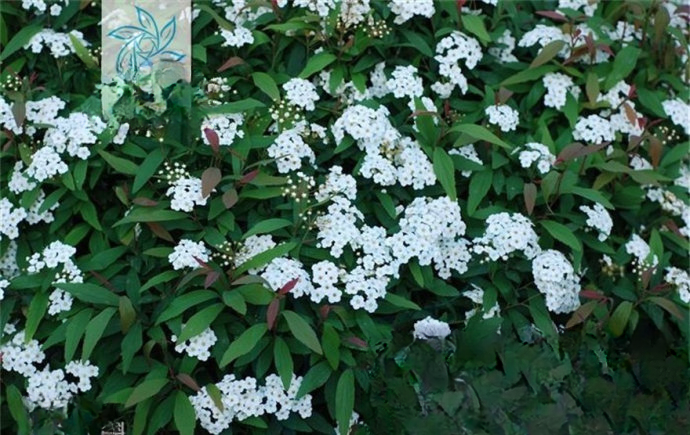 genus . Spiraea cantoniensis Lour .: Shrub, up to 1.5 meters high ; twigs are thin, winter buds are small, ovate, leaves are rhombic lanceolate to rhombic oblong, dark green above, gray-blue below, glabrous on both sides, and petioles are glabrous. Umbel with many flowers; bracts are linear, calyx tube is bell-shaped, sepals are triangular or ovate-triangular, petals are nearly round or obovate, white; the disk is composed of nearly round lobes of varying sizes, the ovary is nearly glabrous, the follicles are upright and open, the style is terminal, flowering in April-May , and fruiting in July-September . Garden cultivation for viewing. The inflorescence is dense, the flowers are white, and the early spring blooms like snow, which is very beautiful. Branches and leaves can treat scabies. Spiraea genus, subfamily Spiraeideae, Rosaceae. Dichondra repens Forst. , also known as small money grass, lotus grass, meat wonton grass, golden key, copper coin grass, small horse hoof gold, jaundice grass, is a plant of Convolvulaceae and horse hoof metal. Note that Dichondra repens should not be confused with genuine money grass (passerby). It is distributed in areas south of the Yangtze River (including Taiwan), and is widely distributed in Guizhou, Guangxi, Fujian, Sichuan, Zhejiang, Hunan and other places. It grows in areas with an altitude of 1,300 to 1,980 meters . It mostly grows on roadsides, hillside grasslands or ditches. It has been introduced and cultivated artificially. It is a herbal medicine commonly used by the Miao people to treat hepatitis. The Miao medicine name is "Wobi Sheliu". It is a perennial creeping herb and is harvested from April to June . It tastes bitter and pungent, is slightly cold in nature, and is used to treat the lung and stomach meridians. It has the effects of clearing away heat and detoxifying, promoting diuresis, and promoting blood circulation. It is a rich resource of Miao folk medicine, and has great development and utilization value. Ophiopogon japonicus (scientific name: Ophiopogon japonicus (Linn. f.) Ker-Gawl. ) is a perennial evergreen herb with thick roots that often swell into oval or spindle-shaped tubers in the middle or near the end. The stem is very short, and the leaf base forms a cluster, which is like a grass leaf. The bracts are lanceolate, the tip is gradually pointed, and the seeds are spherical. The flowering period is from May to August , and the fruiting period is from August to September . Ophiopogon japonicus is native to Japan, Vietnam, and India. It is cultivated in southern China and other places. It grows in the shade and wet places on the slopes below 2,000 meters above sea level, under the forest or beside the stream. Ophiopogon japonicus belongs to the genus Ophiopogon in the tribe Ophiopogon in the family Liliaceae. Datura (scientific name: Datura stramonium Linn. ) is also called Mandala, Manda, Manza, Manda, intoxicating flower, dog walnut, Datura, maple eggplant flower, Wantao flower, Yangyang flower, big trumpet flower, mountain eggplant. It is a herb or semi-shrub, 0.5~1.5 meters high , almost smooth or with short soft hairs in the young and tender parts. The stem is thick, cylindrical, light green or purple, and woody at the bottom. The leaves are broadly ovate. The flowers are solitary between the branches or axils, upright, with short stalks; the calyx is tubular. The capsule is upright, with hard thorns on the ovate surface or sometimes without thorns and nearly smooth, light yellow when mature, and regular 4- valve cracks. The seeds are oval, slightly flat and black. The flowering period is from June to October , and the fruiting period is from July to November . It often grows in wasteland, dry land, beside houses, sunny slopes, forest edges, and grasslands. It likes warm, sunny and well-drained sandy loam. It is cultivated for medicinal or ornamental purposes. Solanaceae, Datura genus. Canna (scientific name: Canna indica L. ): perennial herb, up to 1.5 meters high , green and hairless, covered with waxy white powder. With tuberous rhizomes. Branches grow in clusters above the ground. Single leaves are alternate; with sheath-like petioles; leaves are ovate and oblong. Racemes, flowers are solitary or opposite; sepals are 3 , greenish-white, with red tips; corolla is mostly red, with 2-3 outer degenerate stamens , bright red; lip is lanceolate, curved; capsule, long ovate, green, flowering and fruiting period is March-December . It likes warmth and plenty of sunshine, and is not cold-resistant. It is not strict with soil requirements, and grows best in loose, fertile, well-drained sandy soil, and is also adapted to grow in fertile clay soil. Canna genus, Canna family. Peony (Latin name: Paeonia suffruticosa Andr. ) is a perennial deciduous shrub. The flowers are bright in color, fragrant, elegant, and magnificent, and are known as the "king of flowers". In the cultivation type, it can be divided into hundreds of varieties mainly based on the color of the flowers. There are many varieties of peonies, and there are many colors. Yellow, green, flesh red, deep red, and silver red are the best, especially yellow and green. Peonies are large and fragrant, so they are also known as "national beauty and heavenly fragrance". Liu Yuxi of the Tang Dynasty wrote in a poem: "The peony in front of the courtyard is a monster without any style, and the lotus on the pond is pure and has little emotion. Only the peony is the true national color, and the capital is moved when the flowers bloom." In the late Qing Dynasty, the peony was regarded as the national flower. In May 1985 , the peony was rated as the second of the top ten famous flowers. It is a unique woody precious flower with thousands of years of natural growth and more than 1,500 years of artificial cultivation history. It is widely cultivated in China and has been introduced to all parts of the world. Peony is hailed as the king of flowers, and there are many cultural and painting works related to it. Peony family, subfamily Paeoniaceae, genus Paeonia. Ligustrum lucidum , also known as white ash tree, holly, wax tree, female zelkova, zelkova, general tree. Evergreen shrub or tree, up to 25 meters high ; bark gray-brown. Branches yellow-brown, gray or purple-red, cylindrical, sparsely round or oblong lenticels. Ligustrum lucidum is a subtropical tree species with dense branches and leaves and neat tree shape. It is a commonly used ornamental tree species. It can be planted alone or in clusters in the courtyard, as a street tree, hedge, etc. Ligustrum lucidum is native to China and is widely distributed in the Yangtze River Basin and the areas to the south. It is also cultivated in North China and Northwest China. It can withstand low temperatures of about -10 ℃ and is a native tree species used more in landscaping. It is mainly distributed in Jiangsu and Zhejiang, Jiangxi, Anhui, Shandong, Sichuan and Guizhou, the two lakes, Guangdong and Guangxi, Fujian and other places. Propagation by sowing, cutting and layering. The leaves can be distilled to extract wintergreen oil, which is used as an additive for sweets and toothpaste. The mature fruit is dried in the sun as the Chinese medicine Ligustrum lucidum, which is cool in nature, sweet and bitter in taste, can improve eyesight, blacken hair, and nourish the liver and kidneys. Oleaceae Oleaceae Oleaceae Oleaceae Olea genus Ligustrum. Paulownia (Latin name: Paulownia. ), also known as white-flowered Paulownia, large-fruited Paulownia, and empty Paulownia wood. The bark is gray, gray-brown or gray-black, smooth when young, and longitudinally cracked when old. Pseudo-two-branched branches. Single leaves, opposite, large, ovate, entire or shallowly cracked, with long petioles and villi on the petioles. It likes light and is relatively shade-tolerant. It likes warm climates and is not very cold-resistant. All species of Paulownia are native to China and were introduced to Vietnam, Japan, and various parts of Asia a long time ago. It is now distributed all over the world. Scrophulariaceae Paulownia genus. Flat maple, also known as Yuanbao maple, color tree, Yuanbao tree, liquidambar tree, Latin name: Acer truncatum Bunge , is a deciduous tree of Sapindaceae, Aceraceae, Acer genus, with yellow-brown or dark gray bark and longitudinal cracks; it is distributed in most areas. Flat-branched cotoneaster (scientific name: Cotoneaster horizontalis Decne. ), also known as ground centipede, small-leaved cotoneaster, dwarf red cotoneaster. It is a semi-evergreen creeping shrub, less than 0.5 meters high . The twigs are arranged in two rows and are covered with rough hairs when young. The leaves are nearly round or broadly elliptical, rarely obovate, with an acute tip, a cuneate base, an entire margin, glabrous on the upper side, and sparsely appressed soft hairs on the lower side; the petiole is covered with soft hairs; the stipules are awl-shaped and fall off early. 1-2 flowers are terminal or axillary, nearly sessile, the petals are pink, obovate, and the tip is rounded and obtuse; there are about 12 stamens ; the ovary has soft hairs at the top and is free. The fruit is nearly spherical and bright red. The flowering period is from May to June , and the fruiting period is from September to October . The branches are dense and the leaves are small. The red fruit is gorgeous. It is suitable for garden ground cover and bonsai making. Rosaceae Apple subfamily Cotoneaster genus. Melaleuca bracteata , scientific name: Melaleuca bracteata , alias: golden leaf red melaleuca, golden fragrant willow, golden leaf string money willow. It is a deep-rooted tree species with an upright trunk, slender and soft branches, red young branches, and good toughness. It has strong wind resistance and grows very well at the seaside. In Guangzhou, it is golden yellow in autumn, winter and spring, and light yellow in summer due to the high temperature. The leaves of Melaleuca bracteata are fragrant and pleasant, and the aromatic oil it contains is one of the world's precious cosmetic fragrances. Myrtaceae Melaleuca genus. Thousand-headed Cryptomeria, an evergreen tree; the leaves are cone-pointed, spirally arranged, and the base extends down to the branches. The cones are monoecious; the male cones are short spike-shaped inflorescences at the end; the stamens are numerous and spirally arranged. Cryptomeria genus, Taxaceae. Pistacia weinmannifolia (scientific name: Pistacia weinmannifolia J. Poisson ex Franch. ), also known as the fragrant tree, fine-leaved kauri, fragrant leaves, purple oil wood, tiger-striped sandalwood. Evergreen shrubs or small trees, 2-8 meters high , rarely 10-15 meters . It is named because when the leaves are picked or rubbed, there is a fragrance similar to the mixture of pepper and citrus. The leaves of the fragrant wood are dense and green, the young leaves are red, the branches are weak, quite cute, and coupled with its fragrant smell, it has been loved by more and more people as a small foliage potted plant in recent years. In addition to being ornamental, the material of the fragrant wood is also very good. The wood is hard and rot-resistant, it can sink in water, purple-red with fine black annual rings, and the surface is shiny after polishing. It is very suitable for making bracelets, carvings, musical instrument handles and other handicrafts, and can replace mahogany. Anacardiaceae Anacardiaceae Anacardiaceae Rhus family Rhus genus. Sajinbai, also known as Huangtoubai, is a variant of Juniperus sempervirens, and is also one of the main tree species for park greening. Sajinbai is a colorful tree species with excellent ornamental value and strong resistance to polluted air. Therefore, it is often used for urban greening and planted in the center of urban streets and roadsides. Sajinbai is a short-lived dense bush with a round to ovate crown. The leaves are light yellow-green and turn slightly brown in winter. Sajinbai is a subspecies of Juniperus sempervirens, Juniperus sempervirens, Juniperus sempervirens, Juniperus sempervirens. Sajin coral. Also known as Sajin peach leaf coral, peach leaf Sajin coral, and slightly different in different places, it is a common plant in garden greening. There are golden spots on its leaves, which are naturally scattered on the leaves and are very beautiful. Sajin coral is very good at shade tolerance, and grows poorly or even burns under full light. The main production areas are Anhui, Jiangsu, Henan, etc. The main difference between this variant and the original species of Qingmu is that there are yellow spots of varying sizes on the leaves. Morphological characteristics : evergreen shrub, up to 3m high . Growing in clusters, with a spherical crown. The bark is initially green and smooth, then turns gray-green. The leaves are opposite, fleshy and leathery, rectangular, with sparsely coarse teeth on the margins, glossy green on both sides, and with numerous yellow spots on the leaf surface, resembling sprinkled gold. The flowers are unisexual, dioecious, and terminal panicles, with purple-brown flowers. The drupes are oblong. The genus Ophiopogon of the Cornaceae family. The genus Fatong. Generally refers to the three-ball plane tree. The three-ball plane tree ( Platanus orientalis Linn. ), also known as the split-leaf plane tree and the Kumarajiva tree, is a deciduous large tree of the genus Platanus. It is the parent of the two-ball plane tree and can reach a height of 30 meters . It is a world-famous excellent garden shade tree and street tree, known as the "king of street trees". The crown is broad and bell-shaped; the bark is gray-brown to gray-white, and peels off in thin sheets. The young branches and leaves are densely covered with brown star-shaped hairs. Leaves are palmately lobed with 5-7 lobes, deeply lobed to the middle, with lobes longer than wide, base of leaves broadly cuneate or truncate, margins serrated, palmate veins; stipules round collar-shaped. Inflorescences are capitate, yellow-green. Nuts are clustered in a spherical shape, 3-6 in a cluster, persistent style long, prickly, fruit stalks long and drooping. It likes light, moist and warm climates, and is relatively cold-resistant. It is cultivated in many parts of Eurasia. It belongs to the genus Platanus in the family Platanaceae. Three-leaf creeper ( Parthenocissus semicordata (Wall.) Planch. ): also known as three-leaf ground ivy, woody vine. Branchlets are cylindrical, sparsely pubescent when young, and then fall off and become almost hairless. Tendrils are racemose with 4-6 branches, opposite to leaves at intervals of 2 nodes, with the tops pointed and curled when young, and then expanded into suckers when they encounter attachments. Leaves are 3 -foliolate, borne on short branches, central leaflet obovate or obovate, 6-13 cm long, 3-6.5 cm wide, apex cuspidate, base cuneate, widest at the top, 6-11 serrations on each side above the middle of the margin, lateral leaflets ovate or oblong, 5-10 cm long , (2) 3-5 cm wide , apex cuspidate, asymmetrical base, nearly rounded, 7-15 serrations on the outer margin, 4-6 serrations on the upper half of the inner margin , green above, light green below, short pubescent on the midrib and lateral veins below; 4-7 pairs of lateral veins, reticulate veins not obvious or slightly prominent on both sides; petiole 3.5-15 cm long , sparsely pubescent, leaflets almost sessile. Parthenocissus genus, Vitaceae. Mulberry. Deciduous tree or shrub, up to 15 meters tall . The tree is rich in semen, and the bark is yellow-brown. The leaves are ovate to broadly ovate, with pointed tips, rounded or shallowly heart-shaped bases, coarse serrations on the edges, and sometimes irregularly divided. The leaves are glabrous and shiny, with sparse hairs on the dorsal veins. Dioecious, flowering in May , catkins. Fruit ripening period is June-July , the aggregate fruits are ovate or cylindrical, black-purple or white. It likes light, slightly shade-tolerant when young. It likes warm and humid climates and is cold-resistant. It is drought-resistant and has strong resistance to water and humidity. The leaves are used as feed for silkworms. The wood can be used to make utensils, the branches can be used to weave baskets, the mulberry bark can be used as raw material for papermaking, the mulberry can be used for food and winemaking, and the leaves, fruits and root bark can be used as medicine. It belongs to the genus Morus, the tribe Morus, the subfamily Moraceae, the family Moraceae. Sand needle, shrub or small tree, 2-5 meters high ; the branches are slender and triangular when young. The leaves are thin leathery, gray-green, elliptic-lanceolate or elliptic-obovate, 2.5-6 cm long , 0.6-2 cm wide , pointed at the top, with a short tip, gradually narrowed at the base, and extended downward to form a short stalk. The flowers are small; male flowers: 2-4 flowers are integrated into a small cyme; the pedicel is 4-8 mm long ; the perianth is about 4 mm in diameter , with 3 lobes ; the disk is fleshy and emarginate; there are 3 stamens, the filaments are very short, and the sterile ovary is a tiny protrusion located in the center of the disk; female flowers: solitary, occasionally 4 or 3 flowers are clustered; there are 2 bracts ; the top of the pedicel is swollen; the disk and stamens are like male flowers, but the stamens are sterile; bisexual flowers: similar in appearance to female flowers, but with developed stamens; there are usually 3 ovules and the stigma is 3- lobed. The drupe is nearly spherical, with a round disk scar at the top, orange-yellow to red when mature, light black after drying, and 8-10 mm in diameter . The flowering period is April to June , and the fruiting period is October . The genus of the genus of the genus of the Santalaceae family. The mountain red is a deciduous small tree, 6-8 meters high . It is a fruit tree and also an ornamental plant. The leaves are alternate, broadly ovate or triangular ovate, with 5-9 pinnate lobes and serrations on the edges, and short soft hairs on the veins. The umbel has 10-12 small flowers, white or light red, and blooms in May. The fruits are produced from August to October. The pear fruit is nearly spherical, about 2 cm in diameter, with a dark red skin and light brown spots . The genus of the ... The petals of peony are obovate, and the flower disk is shallow cup-shaped. The flowering period is from May to June . The flowers are generally born at the top of the stem or near the top of the leaf axils. The original species has white flowers and 5 to 13 petals . The horticultural varieties have rich colors, including white, pink, red, purple, yellow, green, black and complex colors. The flower diameter is 10 to 30 cm, and the petals can reach hundreds. The fruit is spindle-shaped, and the seeds are round, oblong or pointed. Peony is praised as "Flower Fairy" and "Flower Phase", and is listed as one of the "Top Ten Famous Flowers". It is also called "May Flower God". Because it has been used as a flower of love since ancient times, it is now revered as the representative flower of the Qixi Festival. In addition, "Silly Xiangyun Drunk Sleeping on Peony Quilt" is known as one of the classic scenes in Dream of Red Mansions. Paeoniaceae, Paeoniaceae, genus Paeonia. Nephrolepis, also known as round fern, comb grass, phoenix egg, centipede grass, stone yellow skin. Epiphytic or soil. The rhizome is erect, covered with fluffy light brown long awl-shaped scales, with thick wire-like runners at the bottom that spread horizontally in all directions. The runners are brown, unbranched, sparsely covered with scales, and have slender brown-brown whiskers. The leaves are clustered, dark brown, slightly shiny, with linear-lanceolate or narrowly lanceolate leaves, pinnate, pinnates in many forms, alternate, often densely and imbricately arranged, lanceolate, with sparse shallow blunt serrations on the leaf margins. The leaf veins are obvious, the lateral veins are slender, and they are obliquely upward from the main veins and forked at the bottom. The leaves are hard and herbaceous, brown-green or brown-brown after drying, and smooth. The spore sori are in a row on both sides of the main vein, reniform, and grow at the top of the upper lateral veins of each group of lateral veins, located 1/3 from the leaf edge to the main vein ; the sori cap is reniform, brown-brown, with lighter edges and no hairs. It often grows on the ground and epiphytes in the cracks of rocks and on tree trunks under the forest by the stream. It likes warm, moist and semi-shady environment, and avoids direct sunlight. Nephrolepis is an ornamental fern widely used both inside and outside. In addition to garden applications, it is also a traditional Chinese medicinal material. There are a large number of spore sacs on the back of the nephrolepis, which are used to reproduce offspring. Nephrolepis genus. Dianthus, also known as Luoyang flower, dianthus, marsh bamboo, dianthus flower, Latin name: Dianthus chinensis L. perennial herb, 30-50 cm high , the whole plant is hairless, with pink green. The stem grows from the root neck, sparsely clustered, upright, and branched at the top. The leaves are linear-lanceolate, gradually pointed at the top, slightly narrow at the base, entire or with fine teeth, and the midrib is more obvious. The flowers are solitary at the end of the branches or several flowers are gathered in cymes; purple-red, pink, bright red or white, with irregular tooth cracks on the top edge, stripes on the throat, and sparsely bearded; the stamens are exposed outside the throat, and the anthers are blue; the ovary is oblong and the style is linear. The capsule is cylindrical and enclosed in the persistent calyx. The seeds are black and oblate. The flowering period is May-June , and the fruiting period is July-September . It belongs to the genus Dianthus, the family Caryophyllaceae, the subfamily Caryophyllaceae, the tribe Caryophyllaceae. Quercus variabilis Bl . is also known as: cork oak, rough-skinned cycad, and white oak. It is a deciduous tree with a broad ovate crown, many trunks, gray-brown, deep longitudinal cracks, and a particularly thick cork layer. The twigs are light brown, and the male inflorescence grows at the bottom of the current year's branches. The female flowers are solitary or twin in the axils of the current year's branches and leaves. The flowering period is May ; the fruit matures in September-October of the same year . It is an important timber species. It belongs to the genus Quercus, the family Fagaceae, the order Fagaceae. Water hemp (Debregeasia orientalis CJ Chen) is also known as: water hemp willow, water hemp, ditchside wood, false bud, broken bone vine, water fine hemp, and water black hemp. The source of the medicinal material is the whole herb of the plant Ramie rubrum of the Urticaceae family, and the stem bark and leaves are mainly used as medicine. Urticaceae Water Hemp genus. Yucca. Other names: soft-leaf yucca, hairy-edge yucca, foreign pineapple, Liliaceae Yucca plant. The national flower of Seychelles, with short stems, leaves clustered in a rosette shape, nearly white flowers, and blooming in autumn. Native to North America, it is now widely cultivated in warm areas for open-air cultivation. The flowers of yucca bloom at night, and when they bloom, they emit a strange fragrance to welcome the visit of the yucca moth. The moth has a slender and bendable proboscis in its mouth to collect pollen. Yucca is widely used in road greening, courtyards, landscaping, and protection and isolation. It has strong resistance, wide adaptability, evergreen all year round, and high ornamental value. It is an important tree species for landscaping. The leaf fiber can be used to make ropes. Liliaceae Yucca genus. Iron whip. Perennial herb. The whole plant is densely covered with long soft hairs, the stem is flat, slender, 60-80 (100) cm long, with few branches, creeping on the ground. The stipules are subulate, about 3 mm long, with acuminate tips; the petioles are 6-15 mm long; the pinnate compound leaves have 3 leaflets; the leaflets are broadly obovate or obovate, 1.5-2 cm long, 1-1.5 cm wide, with rounded, nearly truncated or slightly concave tips, with small thorn tips, rounded or nearly truncated bases, densely covered with long hairs on both sides, and the terminal leaflets are larger. The racemes are axillary and shorter than the leaves; the bracts are subulate, 5-8 mm long, with ciliate edges on the upper part; the peduncle is very short and densely covered with long hairs; the bracteoles are 2, lanceolate-subulate, 1.5 mm long, with long hairs on the midrib on the back and ciliate edges; the calyx is densely covered with long hairs, 5-parted, the 2 lobes above are fused at the base, separated at the upper part, the lobes are narrowly lanceolate, about 3 mm long, with a long acuminate tip and long ciliate edges; the corolla is yellow-white or white, the standard petal is elliptical, 7-8 mm long, 2.5-3 mm wide, slightly concave at the tip, with a petal stalk, and the wing petals are shorter than the standard petal and keel petal; the closed flowers are often 1-3 clustered in the leaf axils of the upper part of the stem, sessile or nearly sessile, and solid. The pods are broadly ovate, 3-4 mm long, convex mirror-shaped, densely covered with long hairs on both sides, and with a sharp beak at the tip. The flowering period is from July to September, and the fruiting period is from September to October. The genus Lespedeza in the Fabaceae family. Sapium sebiferum (L.) Roxb. ), also known as wax tree, tung tree, wood tree, black tung, tung tree, wax tree, wood oil tree, wood catalpa tree, rainbow tree, candle tree, oil seed (child) tree, and foreign spicy tree. A deciduous tree of the Euphorbiaceae family and the genus Sapium, Sapium sebiferum is a colorful leaf tree species with bright red leaves in spring and autumn, not inferior to red maple. It is a unique economic tree species with a cultivation history of more than 1,400 years. It has a certain wind resistance and is more resistant to drought and early barrenness. In addition, Sapium sebiferum has a strong resistance to toxic hydrogen fluoride gas. The Chinese tallow tree has economic and horticultural value. The wax on the outer coat of the seed is called "tau wax", which can be extracted into "skin oil" for making high-grade soap, wax paper, candles, etc. The oil extracted from the seed kernel is called "tau oil" or "green oil", which is used for paint, ink, etc. The aril is the raw material for making candles and soaps, and has extremely high economic value. Its wood is also excellent wood. The Chinese tallow tree has extremely high ornamental value. Euphorbiaceae Euphorbiaceae Subfamily Taurea Tribe Taurea Genus. The "Phoenix Tree" is a plant of the genus Paulownia in the family Sterculiaceae. Its English name is Phoenix Tree , also known as Qingtong and Tongma . It is also a deciduous large tree, up to 15 meters high ; the trunk is straight, and the bark is green and smooth. It is native to the north and south provinces and is cultivated. It is also a common street tree and garden greening ornamental tree. The phoenix tree grows fast, its wood is suitable for making musical instruments, its bark can be used for making paper and ropes, its seeds can be eaten or pressed for oil, and it is a famous ornamental tree species because of its smooth trunk and large and beautiful leaves. According to ancient legend, the phoenix "will not roost unless it is the phoenix tree". Many legendary guqins are made of phoenix wood, and phoenix trees play an important role in culture. The writer Feng Zikai's article of the same name, "Phoenix Tree", is a masterpiece. The phoenix tree has been introduced to many countries in Europe, America and other countries as an ornamental tree species. Malvaceae, Malvaceae, Sterculiaceae, Sterculia genus. Podocarpus macrophyllus var . angustitolius, scientific name: Podocarpus macrophyllus var . angustitolius , is an evergreen shrub or small tree. The leaves are strip-shaped and slender, usually 5-9 cm long and 3-6 mm wide , with the tip gradually narrowing to a long pointed head and the base cuneate. The seeds of Podocarpus macrophyllus are the size of soybeans, the fruit skin is emerald green, smooth and uniform, and the shape is slender and oval. Podocarpus genus, Podocarpus family. Mahonia fortunei (Lindl.) Fedde , also known as yellow bamboo, yellow cypress, and thorny scutellaria. It is an evergreen shrub that can reach 2m in height , the shortest in this genus. Its branches resemble Nandina domestica, and its stems have amplexicaul leaf sheaths. Its leaves are odd-pinnate compound leaves with 5-9 leaflets , narrow lanceolate, hard leathery, bright green on the surface, light green on the back, smooth and hairless on both sides, with 6-13 pairs of needle-like serrations on the leaf margins. Its leaves turn red in autumn. It has an upright raceme at the end, bisexual flowers, yellow flowers, and fragrance. Its berries are ovate, blue-black, and slightly covered with white powder. It blooms from August to October and ripens in December . Its main chemical components are berberine ( Ⅰ ) , jatrorrhizine ( Ⅱ ) , 5' - methoxy-dendron D ( Ⅲ ) , luteolin ( Ⅳ ) and β - sitosterol ( Ⅴ ) . Sinocalycanthus chinensis , also known as peony wood, yellow loquat, etc., belongs to the "authentic" wintersweet family. The flowers are large and beautiful, with great ornamental value. It usually blooms in early summer . It is a unique rare wild flower , listed as a national second-level protected plant, and is a relict species of the Tertiary period. Wintersweet genus of the wintersweet family. Curculigo, also known as ground palm, single grass, mountain codonopsis, curculigo ginseng, Hainan ginseng. The rhizome is nearly cylindrical, thick, straight, about 1 cm in diameter and up to 10 cm in length . The leaves are linear, linear-lanceolate or lanceolate, with great variation in size, 10~45 ( ~90 ) cm long, 5~25 mm wide , with a long and gradually pointed apex, gradually narrowing to a short stalk or nearly sessile at the base, and sparse soft hairs or no hairs on both sides. The flower stem is very short, 6-7 cm long , mostly hidden in the base of the sheath-like petiole, and also covered with hairs; the bracts are lanceolate, 2.5-5 cm long , with ciliate margins; the racemes are more or less corymbose, usually with 4-6 flowers; the flowers are yellow; the pedicels are about 2 mm long ; the perianth lobes are oblong-lanceolate, 8-12 mm long, 2.5-3 mm wide , and the back of the outer whorl is sometimes scattered with soft hairs; the stamens are about 1/2 of the perianth lobes, the filaments are 1.5-2.5 mm long , and the anthers are 2-4 mm long ; the stigma is 3- lobed, and the split part is longer than the style; the ovary is narrow and long, with a long beak at the top, up to 7.5 mm long (the beak accounts for about 1/3 ), and covered with sparse hairs. The berries are nearly spindle-shaped, 1.2-1.5 cm long , about 6 mm wide , with a long beak at the top. The surface of the seeds has longitudinal convex lines. Flowering and fruiting period is from April to September . Curculigo genus, Curculigo family, Asparagaceae. Populus raphis. Other names: wind-sounding tree, round-leaf poplar, white poplar. Tree, up to 15-30m tall . Bark is grayish white and smooth; dark gray and cracked when old. Branchlets are dark reddish brown and covered with soft hairs; old branches are grayish brown and hairless. Ecological classification: woody plants > deciduous trees for viewing, classification: shade trees, height range: 30 M , growth habits: light-loving, warm and humid, fast-growing, landscape use: afforestation species, common street tree. Salicaceae Populus genus. Berberis. Clusters of yellow flowers in spring, red fruits on branches in autumn. Suitable for planting in clumps on lawns, poolsides, rocks, walls, and under trees, for viewing fruits, flowers, and leaves, and can also be planted as thorn hedges. Berberis can be potted for viewing, and is a good material for planting flower hedges and embellishing rocks. Berberis has dense branches and a rounded posture. It blooms yellow flowers in spring, bears red fruits in autumn, and has purple-red leaves in late autumn. The fruits do not fall off in winter. It is an ornamental flower with excellent flowers, fruits and leaves. It is suitable for solitary planting, cluster planting or hedge planting in gardens. The fruit branches can be placed in vases, and the roots and stems are used as medicine. It can clear away heat and dampness, purge fire and detoxify, and has antibacterial and anti-inflammatory effects. It is native to Japan and is also distributed in the Qinling Mountains. Berberidaceae Berberis genus. Clown Pyracantha. Evergreen shrub. Single leaves, obovate or obovate-oblong, with patterns on the leaves, like a clown's face, and the leaves turn red in winter. The flowers are white, with corymbs, and the flowering period is March-May ; the fruiting period is August-November . Rosaceae Apple subfamily Pyracantha genus. Small-leaved boxwood. Also known as melon seed boxwood. Evergreen shrub or small tree. The trunk is gray and smooth, with dense branches and four-angle branches. Leaves are opposite, leathery, entire, elliptical or obovate, with rounded or slightly concave apex, bright green on the surface and yellow-green on the back. Flowers are clustered in leaf axils or branch ends, blooming from April to May , and the flowers are yellow-green. Buxus family. Olea ferruginea Royle, scientific name Olea ferruginea Royle, also known as Olea ferruginea Royle and pointed-leaf Oleaceae. Oleaceae Oleaceae plants have beautiful morphology and are often used for garden planting. Shrubs or small trees, twigs are brown or gray, nearly quadrangular, glabrous, densely covered with small scales. Leaves are leathery, narrowly lanceolate to oblong, with pointed apex, densely covered with rust-colored scales at the base, entire, dorsally rolled, midrib concave above, raised on the back, and inconspicuous lateral veins. Flowers are axillary panicles. Drupes are nearly spherical, dark brown or black when ripe. Flowering period is April to August, and fruiting period is August to November. Oleaceae, ...
genus . Spiraea cantoniensis Lour .: Shrub, up to 1.5 meters high ; twigs are thin, winter buds are small, ovate, leaves are rhombic lanceolate to rhombic oblong, dark green above, gray-blue below, glabrous on both sides, and petioles are glabrous. Umbel with many flowers; bracts are linear, calyx tube is bell-shaped, sepals are triangular or ovate-triangular, petals are nearly round or obovate, white; the disk is composed of nearly round lobes of varying sizes, the ovary is nearly glabrous, the follicles are upright and open, the style is terminal, flowering in April-May , and fruiting in July-September . Garden cultivation for viewing. The inflorescence is dense, the flowers are white, and the early spring blooms like snow, which is very beautiful. Branches and leaves can treat scabies. Spiraea genus, subfamily Spiraeideae, Rosaceae. Dichondra repens Forst. , also known as small money grass, lotus grass, meat wonton grass, golden key, copper coin grass, small horse hoof gold, jaundice grass, is a plant of Convolvulaceae and horse hoof metal. Note that Dichondra repens should not be confused with genuine money grass (passerby). It is distributed in areas south of the Yangtze River (including Taiwan), and is widely distributed in Guizhou, Guangxi, Fujian, Sichuan, Zhejiang, Hunan and other places. It grows in areas with an altitude of 1,300 to 1,980 meters . It mostly grows on roadsides, hillside grasslands or ditches. It has been introduced and cultivated artificially. It is a herbal medicine commonly used by the Miao people to treat hepatitis. The Miao medicine name is "Wobi Sheliu". It is a perennial creeping herb and is harvested from April to June . It tastes bitter and pungent, is slightly cold in nature, and is used to treat the lung and stomach meridians. It has the effects of clearing away heat and detoxifying, promoting diuresis, and promoting blood circulation. It is a rich resource of Miao folk medicine, and has great development and utilization value. Ophiopogon japonicus (scientific name: Ophiopogon japonicus (Linn. f.) Ker-Gawl. ) is a perennial evergreen herb with thick roots that often swell into oval or spindle-shaped tubers in the middle or near the end. The stem is very short, and the leaf base forms a cluster, which is like a grass leaf. The bracts are lanceolate, the tip is gradually pointed, and the seeds are spherical. The flowering period is from May to August , and the fruiting period is from August to September . Ophiopogon japonicus is native to Japan, Vietnam, and India. It is cultivated in southern China and other places. It grows in the shade and wet places on the slopes below 2,000 meters above sea level, under the forest or beside the stream. Ophiopogon japonicus belongs to the genus Ophiopogon in the tribe Ophiopogon in the family Liliaceae. Datura (scientific name: Datura stramonium Linn. ) is also called Mandala, Manda, Manza, Manda, intoxicating flower, dog walnut, Datura, maple eggplant flower, Wantao flower, Yangyang flower, big trumpet flower, mountain eggplant. It is a herb or semi-shrub, 0.5~1.5 meters high , almost smooth or with short soft hairs in the young and tender parts. The stem is thick, cylindrical, light green or purple, and woody at the bottom. The leaves are broadly ovate. The flowers are solitary between the branches or axils, upright, with short stalks; the calyx is tubular. The capsule is upright, with hard thorns on the ovate surface or sometimes without thorns and nearly smooth, light yellow when mature, and regular 4- valve cracks. The seeds are oval, slightly flat and black. The flowering period is from June to October , and the fruiting period is from July to November . It often grows in wasteland, dry land, beside houses, sunny slopes, forest edges, and grasslands. It likes warm, sunny and well-drained sandy loam. It is cultivated for medicinal or ornamental purposes. Solanaceae, Datura genus. Canna (scientific name: Canna indica L. ): perennial herb, up to 1.5 meters high , green and hairless, covered with waxy white powder. With tuberous rhizomes. Branches grow in clusters above the ground. Single leaves are alternate; with sheath-like petioles; leaves are ovate and oblong. Racemes, flowers are solitary or opposite; sepals are 3 , greenish-white, with red tips; corolla is mostly red, with 2-3 outer degenerate stamens , bright red; lip is lanceolate, curved; capsule, long ovate, green, flowering and fruiting period is March-December . It likes warmth and plenty of sunshine, and is not cold-resistant. It is not strict with soil requirements, and grows best in loose, fertile, well-drained sandy soil, and is also adapted to grow in fertile clay soil. Canna genus, Canna family. Peony (Latin name: Paeonia suffruticosa Andr. ) is a perennial deciduous shrub. The flowers are bright in color, fragrant, elegant, and magnificent, and are known as the "king of flowers". In the cultivation type, it can be divided into hundreds of varieties mainly based on the color of the flowers. There are many varieties of peonies, and there are many colors. Yellow, green, flesh red, deep red, and silver red are the best, especially yellow and green. Peonies are large and fragrant, so they are also known as "national beauty and heavenly fragrance". Liu Yuxi of the Tang Dynasty wrote in a poem: "The peony in front of the courtyard is a monster without any style, and the lotus on the pond is pure and has little emotion. Only the peony is the true national color, and the capital is moved when the flowers bloom." In the late Qing Dynasty, the peony was regarded as the national flower. In May 1985 , the peony was rated as the second of the top ten famous flowers. It is a unique woody precious flower with thousands of years of natural growth and more than 1,500 years of artificial cultivation history. It is widely cultivated in China and has been introduced to all parts of the world. Peony is hailed as the king of flowers, and there are many cultural and painting works related to it. Peony family, subfamily Paeoniaceae, genus Paeonia. Ligustrum lucidum , also known as white ash tree, holly, wax tree, female zelkova, zelkova, general tree. Evergreen shrub or tree, up to 25 meters high ; bark gray-brown. Branches yellow-brown, gray or purple-red, cylindrical, sparsely round or oblong lenticels. Ligustrum lucidum is a subtropical tree species with dense branches and leaves and neat tree shape. It is a commonly used ornamental tree species. It can be planted alone or in clusters in the courtyard, as a street tree, hedge, etc. Ligustrum lucidum is native to China and is widely distributed in the Yangtze River Basin and the areas to the south. It is also cultivated in North China and Northwest China. It can withstand low temperatures of about -10 ℃ and is a native tree species used more in landscaping. It is mainly distributed in Jiangsu and Zhejiang, Jiangxi, Anhui, Shandong, Sichuan and Guizhou, the two lakes, Guangdong and Guangxi, Fujian and other places. Propagation by sowing, cutting and layering. The leaves can be distilled to extract wintergreen oil, which is used as an additive for sweets and toothpaste. The mature fruit is dried in the sun as the Chinese medicine Ligustrum lucidum, which is cool in nature, sweet and bitter in taste, can improve eyesight, blacken hair, and nourish the liver and kidneys. Oleaceae Oleaceae Oleaceae Oleaceae Olea genus Ligustrum. Paulownia (Latin name: Paulownia. ), also known as white-flowered Paulownia, large-fruited Paulownia, and empty Paulownia wood. The bark is gray, gray-brown or gray-black, smooth when young, and longitudinally cracked when old. Pseudo-two-branched branches. Single leaves, opposite, large, ovate, entire or shallowly cracked, with long petioles and villi on the petioles. It likes light and is relatively shade-tolerant. It likes warm climates and is not very cold-resistant. All species of Paulownia are native to China and were introduced to Vietnam, Japan, and various parts of Asia a long time ago. It is now distributed all over the world. Scrophulariaceae Paulownia genus. Flat maple, also known as Yuanbao maple, color tree, Yuanbao tree, liquidambar tree, Latin name: Acer truncatum Bunge , is a deciduous tree of Sapindaceae, Aceraceae, Acer genus, with yellow-brown or dark gray bark and longitudinal cracks; it is distributed in most areas. Flat-branched cotoneaster (scientific name: Cotoneaster horizontalis Decne. ), also known as ground centipede, small-leaved cotoneaster, dwarf red cotoneaster. It is a semi-evergreen creeping shrub, less than 0.5 meters high . The twigs are arranged in two rows and are covered with rough hairs when young. The leaves are nearly round or broadly elliptical, rarely obovate, with an acute tip, a cuneate base, an entire margin, glabrous on the upper side, and sparsely appressed soft hairs on the lower side; the petiole is covered with soft hairs; the stipules are awl-shaped and fall off early. 1-2 flowers are terminal or axillary, nearly sessile, the petals are pink, obovate, and the tip is rounded and obtuse; there are about 12 stamens ; the ovary has soft hairs at the top and is free. The fruit is nearly spherical and bright red. The flowering period is from May to June , and the fruiting period is from September to October . The branches are dense and the leaves are small. The red fruit is gorgeous. It is suitable for garden ground cover and bonsai making. Rosaceae Apple subfamily Cotoneaster genus. Melaleuca bracteata , scientific name: Melaleuca bracteata , alias: golden leaf red melaleuca, golden fragrant willow, golden leaf string money willow. It is a deep-rooted tree species with an upright trunk, slender and soft branches, red young branches, and good toughness. It has strong wind resistance and grows very well at the seaside. In Guangzhou, it is golden yellow in autumn, winter and spring, and light yellow in summer due to the high temperature. The leaves of Melaleuca bracteata are fragrant and pleasant, and the aromatic oil it contains is one of the world's precious cosmetic fragrances. Myrtaceae Melaleuca genus. Thousand-headed Cryptomeria, an evergreen tree; the leaves are cone-pointed, spirally arranged, and the base extends down to the branches. The cones are monoecious; the male cones are short spike-shaped inflorescences at the end; the stamens are numerous and spirally arranged. Cryptomeria genus, Taxaceae. Pistacia weinmannifolia (scientific name: Pistacia weinmannifolia J. Poisson ex Franch. ), also known as the fragrant tree, fine-leaved kauri, fragrant leaves, purple oil wood, tiger-striped sandalwood. Evergreen shrubs or small trees, 2-8 meters high , rarely 10-15 meters . It is named because when the leaves are picked or rubbed, there is a fragrance similar to the mixture of pepper and citrus. The leaves of the fragrant wood are dense and green, the young leaves are red, the branches are weak, quite cute, and coupled with its fragrant smell, it has been loved by more and more people as a small foliage potted plant in recent years. In addition to being ornamental, the material of the fragrant wood is also very good. The wood is hard and rot-resistant, it can sink in water, purple-red with fine black annual rings, and the surface is shiny after polishing. It is very suitable for making bracelets, carvings, musical instrument handles and other handicrafts, and can replace mahogany. Anacardiaceae Anacardiaceae Anacardiaceae Rhus family Rhus genus. Sajinbai, also known as Huangtoubai, is a variant of Juniperus sempervirens, and is also one of the main tree species for park greening. Sajinbai is a colorful tree species with excellent ornamental value and strong resistance to polluted air. Therefore, it is often used for urban greening and planted in the center of urban streets and roadsides. Sajinbai is a short-lived dense bush with a round to ovate crown. The leaves are light yellow-green and turn slightly brown in winter. Sajinbai is a subspecies of Juniperus sempervirens, Juniperus sempervirens, Juniperus sempervirens, Juniperus sempervirens. Sajin coral. Also known as Sajin peach leaf coral, peach leaf Sajin coral, and slightly different in different places, it is a common plant in garden greening. There are golden spots on its leaves, which are naturally scattered on the leaves and are very beautiful. Sajin coral is very good at shade tolerance, and grows poorly or even burns under full light. The main production areas are Anhui, Jiangsu, Henan, etc. The main difference between this variant and the original species of Qingmu is that there are yellow spots of varying sizes on the leaves. Morphological characteristics : evergreen shrub, up to 3m high . Growing in clusters, with a spherical crown. The bark is initially green and smooth, then turns gray-green. The leaves are opposite, fleshy and leathery, rectangular, with sparsely coarse teeth on the margins, glossy green on both sides, and with numerous yellow spots on the leaf surface, resembling sprinkled gold. The flowers are unisexual, dioecious, and terminal panicles, with purple-brown flowers. The drupes are oblong. The genus Ophiopogon of the Cornaceae family. The genus Fatong. Generally refers to the three-ball plane tree. The three-ball plane tree ( Platanus orientalis Linn. ), also known as the split-leaf plane tree and the Kumarajiva tree, is a deciduous large tree of the genus Platanus. It is the parent of the two-ball plane tree and can reach a height of 30 meters . It is a world-famous excellent garden shade tree and street tree, known as the "king of street trees". The crown is broad and bell-shaped; the bark is gray-brown to gray-white, and peels off in thin sheets. The young branches and leaves are densely covered with brown star-shaped hairs. Leaves are palmately lobed with 5-7 lobes, deeply lobed to the middle, with lobes longer than wide, base of leaves broadly cuneate or truncate, margins serrated, palmate veins; stipules round collar-shaped. Inflorescences are capitate, yellow-green. Nuts are clustered in a spherical shape, 3-6 in a cluster, persistent style long, prickly, fruit stalks long and drooping. It likes light, moist and warm climates, and is relatively cold-resistant. It is cultivated in many parts of Eurasia. It belongs to the genus Platanus in the family Platanaceae. Three-leaf creeper ( Parthenocissus semicordata (Wall.) Planch. ): also known as three-leaf ground ivy, woody vine. Branchlets are cylindrical, sparsely pubescent when young, and then fall off and become almost hairless. Tendrils are racemose with 4-6 branches, opposite to leaves at intervals of 2 nodes, with the tops pointed and curled when young, and then expanded into suckers when they encounter attachments. Leaves are 3 -foliolate, borne on short branches, central leaflet obovate or obovate, 6-13 cm long, 3-6.5 cm wide, apex cuspidate, base cuneate, widest at the top, 6-11 serrations on each side above the middle of the margin, lateral leaflets ovate or oblong, 5-10 cm long , (2) 3-5 cm wide , apex cuspidate, asymmetrical base, nearly rounded, 7-15 serrations on the outer margin, 4-6 serrations on the upper half of the inner margin , green above, light green below, short pubescent on the midrib and lateral veins below; 4-7 pairs of lateral veins, reticulate veins not obvious or slightly prominent on both sides; petiole 3.5-15 cm long , sparsely pubescent, leaflets almost sessile. Parthenocissus genus, Vitaceae. Mulberry. Deciduous tree or shrub, up to 15 meters tall . The tree is rich in semen, and the bark is yellow-brown. The leaves are ovate to broadly ovate, with pointed tips, rounded or shallowly heart-shaped bases, coarse serrations on the edges, and sometimes irregularly divided. The leaves are glabrous and shiny, with sparse hairs on the dorsal veins. Dioecious, flowering in May , catkins. Fruit ripening period is June-July , the aggregate fruits are ovate or cylindrical, black-purple or white. It likes light, slightly shade-tolerant when young. It likes warm and humid climates and is cold-resistant. It is drought-resistant and has strong resistance to water and humidity. The leaves are used as feed for silkworms. The wood can be used to make utensils, the branches can be used to weave baskets, the mulberry bark can be used as raw material for papermaking, the mulberry can be used for food and winemaking, and the leaves, fruits and root bark can be used as medicine. It belongs to the genus Morus, the tribe Morus, the subfamily Moraceae, the family Moraceae. Sand needle, shrub or small tree, 2-5 meters high ; the branches are slender and triangular when young. The leaves are thin leathery, gray-green, elliptic-lanceolate or elliptic-obovate, 2.5-6 cm long , 0.6-2 cm wide , pointed at the top, with a short tip, gradually narrowed at the base, and extended downward to form a short stalk. The flowers are small; male flowers: 2-4 flowers are integrated into a small cyme; the pedicel is 4-8 mm long ; the perianth is about 4 mm in diameter , with 3 lobes ; the disk is fleshy and emarginate; there are 3 stamens, the filaments are very short, and the sterile ovary is a tiny protrusion located in the center of the disk; female flowers: solitary, occasionally 4 or 3 flowers are clustered; there are 2 bracts ; the top of the pedicel is swollen; the disk and stamens are like male flowers, but the stamens are sterile; bisexual flowers: similar in appearance to female flowers, but with developed stamens; there are usually 3 ovules and the stigma is 3- lobed. The drupe is nearly spherical, with a round disk scar at the top, orange-yellow to red when mature, light black after drying, and 8-10 mm in diameter . The flowering period is April to June , and the fruiting period is October . The genus of the genus of the genus of the Santalaceae family. The mountain red is a deciduous small tree, 6-8 meters high . It is a fruit tree and also an ornamental plant. The leaves are alternate, broadly ovate or triangular ovate, with 5-9 pinnate lobes and serrations on the edges, and short soft hairs on the veins. The umbel has 10-12 small flowers, white or light red, and blooms in May. The fruits are produced from August to October. The pear fruit is nearly spherical, about 2 cm in diameter, with a dark red skin and light brown spots . The genus of the ... The petals of peony are obovate, and the flower disk is shallow cup-shaped. The flowering period is from May to June . The flowers are generally born at the top of the stem or near the top of the leaf axils. The original species has white flowers and 5 to 13 petals . The horticultural varieties have rich colors, including white, pink, red, purple, yellow, green, black and complex colors. The flower diameter is 10 to 30 cm, and the petals can reach hundreds. The fruit is spindle-shaped, and the seeds are round, oblong or pointed. Peony is praised as "Flower Fairy" and "Flower Phase", and is listed as one of the "Top Ten Famous Flowers". It is also called "May Flower God". Because it has been used as a flower of love since ancient times, it is now revered as the representative flower of the Qixi Festival. In addition, "Silly Xiangyun Drunk Sleeping on Peony Quilt" is known as one of the classic scenes in Dream of Red Mansions. Paeoniaceae, Paeoniaceae, genus Paeonia. Nephrolepis, also known as round fern, comb grass, phoenix egg, centipede grass, stone yellow skin. Epiphytic or soil. The rhizome is erect, covered with fluffy light brown long awl-shaped scales, with thick wire-like runners at the bottom that spread horizontally in all directions. The runners are brown, unbranched, sparsely covered with scales, and have slender brown-brown whiskers. The leaves are clustered, dark brown, slightly shiny, with linear-lanceolate or narrowly lanceolate leaves, pinnate, pinnates in many forms, alternate, often densely and imbricately arranged, lanceolate, with sparse shallow blunt serrations on the leaf margins. The leaf veins are obvious, the lateral veins are slender, and they are obliquely upward from the main veins and forked at the bottom. The leaves are hard and herbaceous, brown-green or brown-brown after drying, and smooth. The spore sori are in a row on both sides of the main vein, reniform, and grow at the top of the upper lateral veins of each group of lateral veins, located 1/3 from the leaf edge to the main vein ; the sori cap is reniform, brown-brown, with lighter edges and no hairs. It often grows on the ground and epiphytes in the cracks of rocks and on tree trunks under the forest by the stream. It likes warm, moist and semi-shady environment, and avoids direct sunlight. Nephrolepis is an ornamental fern widely used both inside and outside. In addition to garden applications, it is also a traditional Chinese medicinal material. There are a large number of spore sacs on the back of the nephrolepis, which are used to reproduce offspring. Nephrolepis genus. Dianthus, also known as Luoyang flower, dianthus, marsh bamboo, dianthus flower, Latin name: Dianthus chinensis L. perennial herb, 30-50 cm high , the whole plant is hairless, with pink green. The stem grows from the root neck, sparsely clustered, upright, and branched at the top. The leaves are linear-lanceolate, gradually pointed at the top, slightly narrow at the base, entire or with fine teeth, and the midrib is more obvious. The flowers are solitary at the end of the branches or several flowers are gathered in cymes; purple-red, pink, bright red or white, with irregular tooth cracks on the top edge, stripes on the throat, and sparsely bearded; the stamens are exposed outside the throat, and the anthers are blue; the ovary is oblong and the style is linear. The capsule is cylindrical and enclosed in the persistent calyx. The seeds are black and oblate. The flowering period is May-June , and the fruiting period is July-September . It belongs to the genus Dianthus, the family Caryophyllaceae, the subfamily Caryophyllaceae, the tribe Caryophyllaceae. Quercus variabilis Bl . is also known as: cork oak, rough-skinned cycad, and white oak. It is a deciduous tree with a broad ovate crown, many trunks, gray-brown, deep longitudinal cracks, and a particularly thick cork layer. The twigs are light brown, and the male inflorescence grows at the bottom of the current year's branches. The female flowers are solitary or twin in the axils of the current year's branches and leaves. The flowering period is May ; the fruit matures in September-October of the same year . It is an important timber species. It belongs to the genus Quercus, the family Fagaceae, the order Fagaceae. Water hemp (Debregeasia orientalis CJ Chen) is also known as: water hemp willow, water hemp, ditchside wood, false bud, broken bone vine, water fine hemp, and water black hemp. The source of the medicinal material is the whole herb of the plant Ramie rubrum of the Urticaceae family, and the stem bark and leaves are mainly used as medicine. Urticaceae Water Hemp genus. Yucca. Other names: soft-leaf yucca, hairy-edge yucca, foreign pineapple, Liliaceae Yucca plant. The national flower of Seychelles, with short stems, leaves clustered in a rosette shape, nearly white flowers, and blooming in autumn. Native to North America, it is now widely cultivated in warm areas for open-air cultivation. The flowers of yucca bloom at night, and when they bloom, they emit a strange fragrance to welcome the visit of the yucca moth. The moth has a slender and bendable proboscis in its mouth to collect pollen. Yucca is widely used in road greening, courtyards, landscaping, and protection and isolation. It has strong resistance, wide adaptability, evergreen all year round, and high ornamental value. It is an important tree species for landscaping. The leaf fiber can be used to make ropes. Liliaceae Yucca genus. Iron whip. Perennial herb. The whole plant is densely covered with long soft hairs, the stem is flat, slender, 60-80 (100) cm long, with few branches, creeping on the ground. The stipules are subulate, about 3 mm long, with acuminate tips; the petioles are 6-15 mm long; the pinnate compound leaves have 3 leaflets; the leaflets are broadly obovate or obovate, 1.5-2 cm long, 1-1.5 cm wide, with rounded, nearly truncated or slightly concave tips, with small thorn tips, rounded or nearly truncated bases, densely covered with long hairs on both sides, and the terminal leaflets are larger. The racemes are axillary and shorter than the leaves; the bracts are subulate, 5-8 mm long, with ciliate edges on the upper part; the peduncle is very short and densely covered with long hairs; the bracteoles are 2, lanceolate-subulate, 1.5 mm long, with long hairs on the midrib on the back and ciliate edges; the calyx is densely covered with long hairs, 5-parted, the 2 lobes above are fused at the base, separated at the upper part, the lobes are narrowly lanceolate, about 3 mm long, with a long acuminate tip and long ciliate edges; the corolla is yellow-white or white, the standard petal is elliptical, 7-8 mm long, 2.5-3 mm wide, slightly concave at the tip, with a petal stalk, and the wing petals are shorter than the standard petal and keel petal; the closed flowers are often 1-3 clustered in the leaf axils of the upper part of the stem, sessile or nearly sessile, and solid. The pods are broadly ovate, 3-4 mm long, convex mirror-shaped, densely covered with long hairs on both sides, and with a sharp beak at the tip. The flowering period is from July to September, and the fruiting period is from September to October. The genus Lespedeza in the Fabaceae family. Sapium sebiferum (L.) Roxb. ), also known as wax tree, tung tree, wood tree, black tung, tung tree, wax tree, wood oil tree, wood catalpa tree, rainbow tree, candle tree, oil seed (child) tree, and foreign spicy tree. A deciduous tree of the Euphorbiaceae family and the genus Sapium, Sapium sebiferum is a colorful leaf tree species with bright red leaves in spring and autumn, not inferior to red maple. It is a unique economic tree species with a cultivation history of more than 1,400 years. It has a certain wind resistance and is more resistant to drought and early barrenness. In addition, Sapium sebiferum has a strong resistance to toxic hydrogen fluoride gas. The Chinese tallow tree has economic and horticultural value. The wax on the outer coat of the seed is called "tau wax", which can be extracted into "skin oil" for making high-grade soap, wax paper, candles, etc. The oil extracted from the seed kernel is called "tau oil" or "green oil", which is used for paint, ink, etc. The aril is the raw material for making candles and soaps, and has extremely high economic value. Its wood is also excellent wood. The Chinese tallow tree has extremely high ornamental value. Euphorbiaceae Euphorbiaceae Subfamily Taurea Tribe Taurea Genus. The "Phoenix Tree" is a plant of the genus Paulownia in the family Sterculiaceae. Its English name is Phoenix Tree , also known as Qingtong and Tongma . It is also a deciduous large tree, up to 15 meters high ; the trunk is straight, and the bark is green and smooth. It is native to the north and south provinces and is cultivated. It is also a common street tree and garden greening ornamental tree. The phoenix tree grows fast, its wood is suitable for making musical instruments, its bark can be used for making paper and ropes, its seeds can be eaten or pressed for oil, and it is a famous ornamental tree species because of its smooth trunk and large and beautiful leaves. According to ancient legend, the phoenix "will not roost unless it is the phoenix tree". Many legendary guqins are made of phoenix wood, and phoenix trees play an important role in culture. The writer Feng Zikai's article of the same name, "Phoenix Tree", is a masterpiece. The phoenix tree has been introduced to many countries in Europe, America and other countries as an ornamental tree species. Malvaceae, Malvaceae, Sterculiaceae, Sterculia genus. Podocarpus macrophyllus var . angustitolius, scientific name: Podocarpus macrophyllus var . angustitolius , is an evergreen shrub or small tree. The leaves are strip-shaped and slender, usually 5-9 cm long and 3-6 mm wide , with the tip gradually narrowing to a long pointed head and the base cuneate. The seeds of Podocarpus macrophyllus are the size of soybeans, the fruit skin is emerald green, smooth and uniform, and the shape is slender and oval. Podocarpus genus, Podocarpus family. Mahonia fortunei (Lindl.) Fedde , also known as yellow bamboo, yellow cypress, and thorny scutellaria. It is an evergreen shrub that can reach 2m in height , the shortest in this genus. Its branches resemble Nandina domestica, and its stems have amplexicaul leaf sheaths. Its leaves are odd-pinnate compound leaves with 5-9 leaflets , narrow lanceolate, hard leathery, bright green on the surface, light green on the back, smooth and hairless on both sides, with 6-13 pairs of needle-like serrations on the leaf margins. Its leaves turn red in autumn. It has an upright raceme at the end, bisexual flowers, yellow flowers, and fragrance. Its berries are ovate, blue-black, and slightly covered with white powder. It blooms from August to October and ripens in December . Its main chemical components are berberine ( Ⅰ ) , jatrorrhizine ( Ⅱ ) , 5' - methoxy-dendron D ( Ⅲ ) , luteolin ( Ⅳ ) and β - sitosterol ( Ⅴ ) . Sinocalycanthus chinensis , also known as peony wood, yellow loquat, etc., belongs to the "authentic" wintersweet family. The flowers are large and beautiful, with great ornamental value. It usually blooms in early summer . It is a unique rare wild flower , listed as a national second-level protected plant, and is a relict species of the Tertiary period. Wintersweet genus of the wintersweet family. Curculigo, also known as ground palm, single grass, mountain codonopsis, curculigo ginseng, Hainan ginseng. The rhizome is nearly cylindrical, thick, straight, about 1 cm in diameter and up to 10 cm in length . The leaves are linear, linear-lanceolate or lanceolate, with great variation in size, 10~45 ( ~90 ) cm long, 5~25 mm wide , with a long and gradually pointed apex, gradually narrowing to a short stalk or nearly sessile at the base, and sparse soft hairs or no hairs on both sides. The flower stem is very short, 6-7 cm long , mostly hidden in the base of the sheath-like petiole, and also covered with hairs; the bracts are lanceolate, 2.5-5 cm long , with ciliate margins; the racemes are more or less corymbose, usually with 4-6 flowers; the flowers are yellow; the pedicels are about 2 mm long ; the perianth lobes are oblong-lanceolate, 8-12 mm long, 2.5-3 mm wide , and the back of the outer whorl is sometimes scattered with soft hairs; the stamens are about 1/2 of the perianth lobes, the filaments are 1.5-2.5 mm long , and the anthers are 2-4 mm long ; the stigma is 3- lobed, and the split part is longer than the style; the ovary is narrow and long, with a long beak at the top, up to 7.5 mm long (the beak accounts for about 1/3 ), and covered with sparse hairs. The berries are nearly spindle-shaped, 1.2-1.5 cm long , about 6 mm wide , with a long beak at the top. The surface of the seeds has longitudinal convex lines. Flowering and fruiting period is from April to September . Curculigo genus, Curculigo family, Asparagaceae. Populus raphis. Other names: wind-sounding tree, round-leaf poplar, white poplar. Tree, up to 15-30m tall . Bark is grayish white and smooth; dark gray and cracked when old. Branchlets are dark reddish brown and covered with soft hairs; old branches are grayish brown and hairless. Ecological classification: woody plants > deciduous trees for viewing, classification: shade trees, height range: 30 M , growth habits: light-loving, warm and humid, fast-growing, landscape use: afforestation species, common street tree. Salicaceae Populus genus. Berberis. Clusters of yellow flowers in spring, red fruits on branches in autumn. Suitable for planting in clumps on lawns, poolsides, rocks, walls, and under trees, for viewing fruits, flowers, and leaves, and can also be planted as thorn hedges. Berberis can be potted for viewing, and is a good material for planting flower hedges and embellishing rocks. Berberis has dense branches and a rounded posture. It blooms yellow flowers in spring, bears red fruits in autumn, and has purple-red leaves in late autumn. The fruits do not fall off in winter. It is an ornamental flower with excellent flowers, fruits and leaves. It is suitable for solitary planting, cluster planting or hedge planting in gardens. The fruit branches can be placed in vases, and the roots and stems are used as medicine. It can clear away heat and dampness, purge fire and detoxify, and has antibacterial and anti-inflammatory effects. It is native to Japan and is also distributed in the Qinling Mountains. Berberidaceae Berberis genus. Clown Pyracantha. Evergreen shrub. Single leaves, obovate or obovate-oblong, with patterns on the leaves, like a clown's face, and the leaves turn red in winter. The flowers are white, with corymbs, and the flowering period is March-May ; the fruiting period is August-November . Rosaceae Apple subfamily Pyracantha genus. Small-leaved boxwood. Also known as melon seed boxwood. Evergreen shrub or small tree. The trunk is gray and smooth, with dense branches and four-angle branches. Leaves are opposite, leathery, entire, elliptical or obovate, with rounded or slightly concave apex, bright green on the surface and yellow-green on the back. Flowers are clustered in leaf axils or branch ends, blooming from April to May , and the flowers are yellow-green. Buxus family. Olea ferruginea Royle, scientific name Olea ferruginea Royle, also known as Olea ferruginea Royle and pointed-leaf Oleaceae. Oleaceae Oleaceae plants have beautiful morphology and are often used for garden planting. Shrubs or small trees, twigs are brown or gray, nearly quadrangular, glabrous, densely covered with small scales. Leaves are leathery, narrowly lanceolate to oblong, with pointed apex, densely covered with rust-colored scales at the base, entire, dorsally rolled, midrib concave above, raised on the back, and inconspicuous lateral veins. Flowers are axillary panicles. Drupes are nearly spherical, dark brown or black when ripe. Flowering period is April to August, and fruiting period is August to November. Oleaceae, ...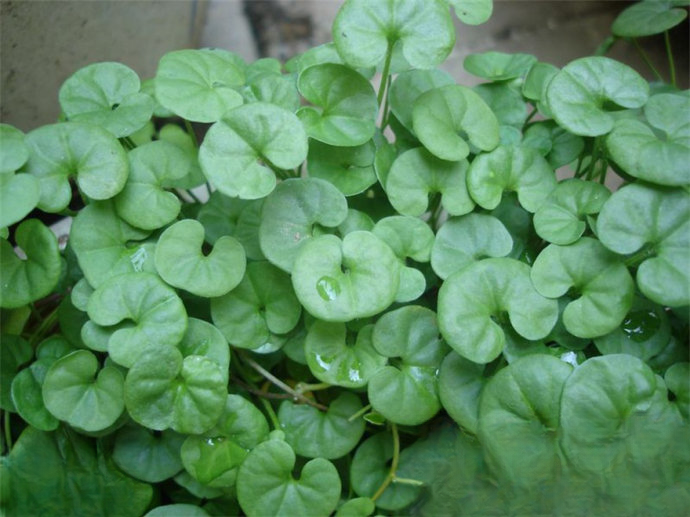
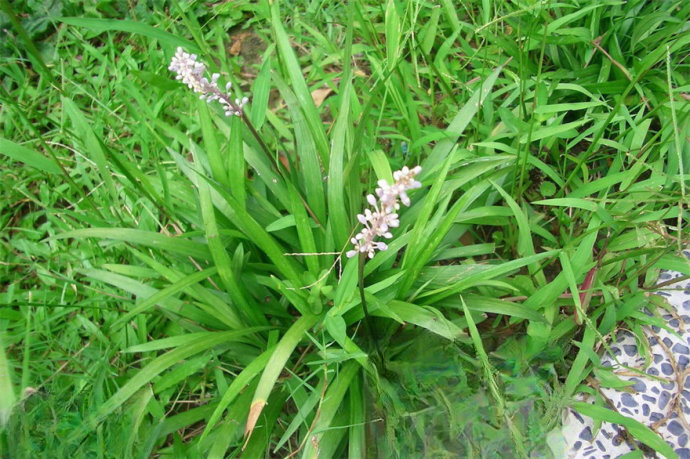
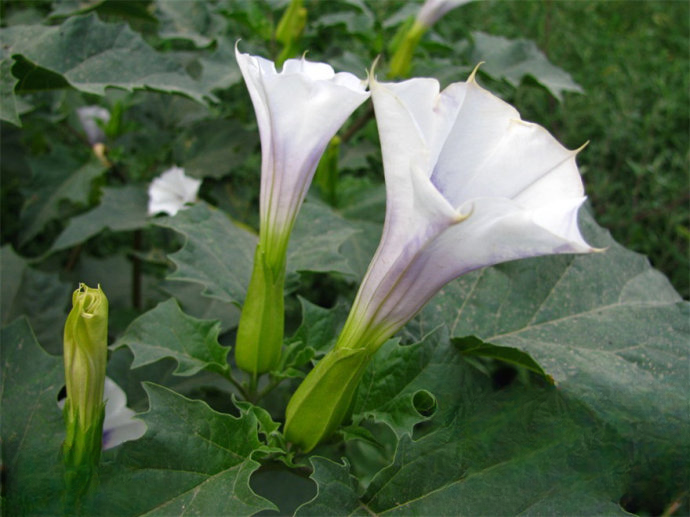
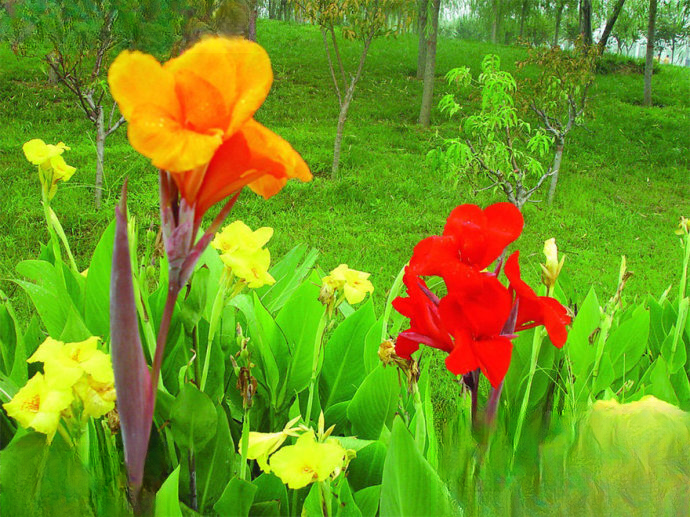
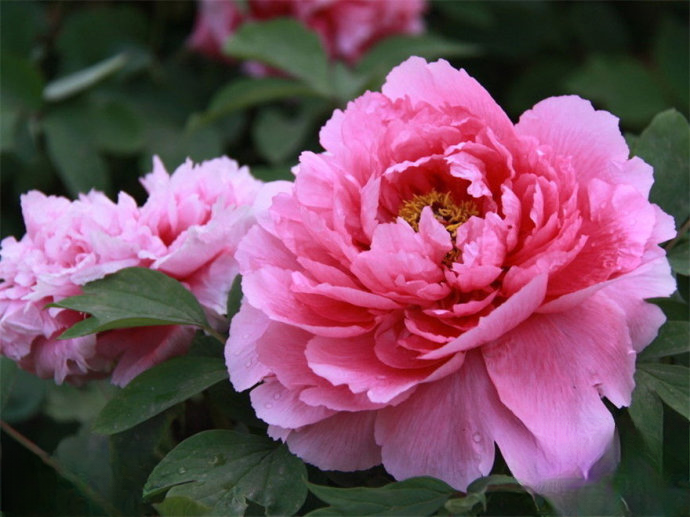
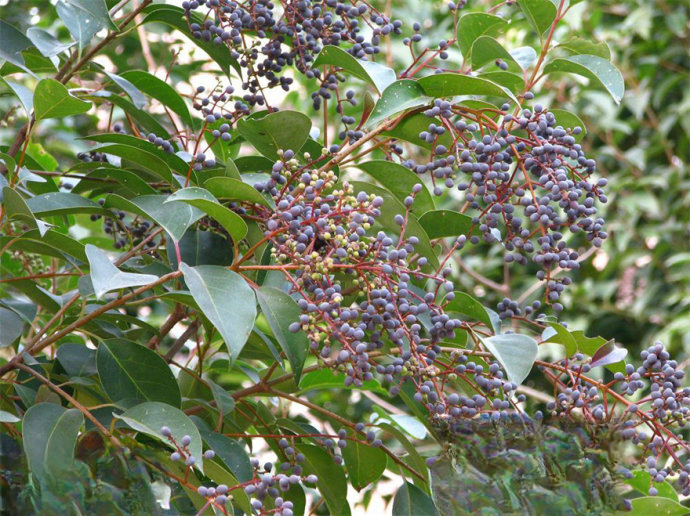
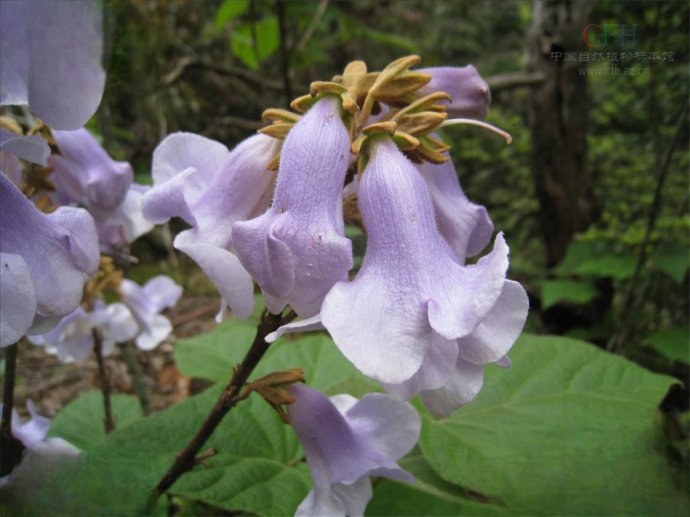
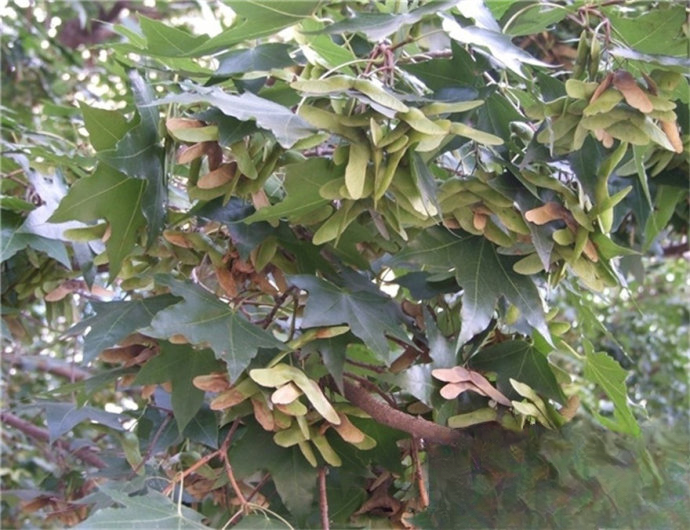
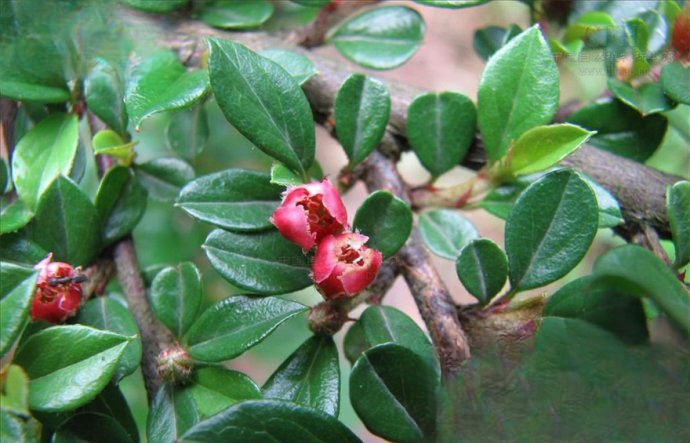
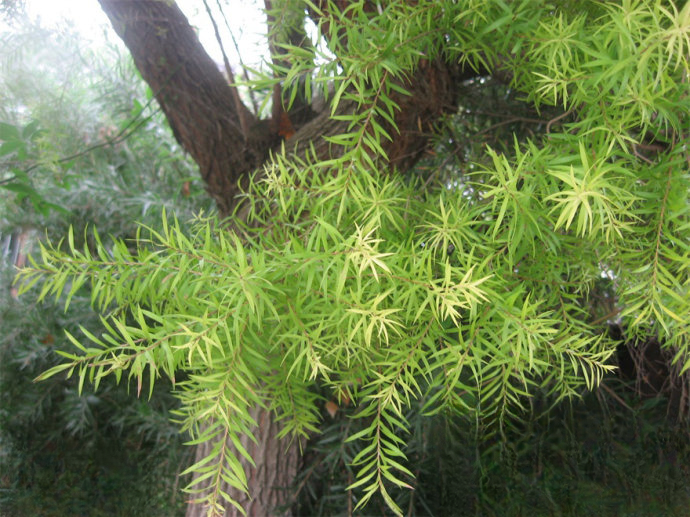
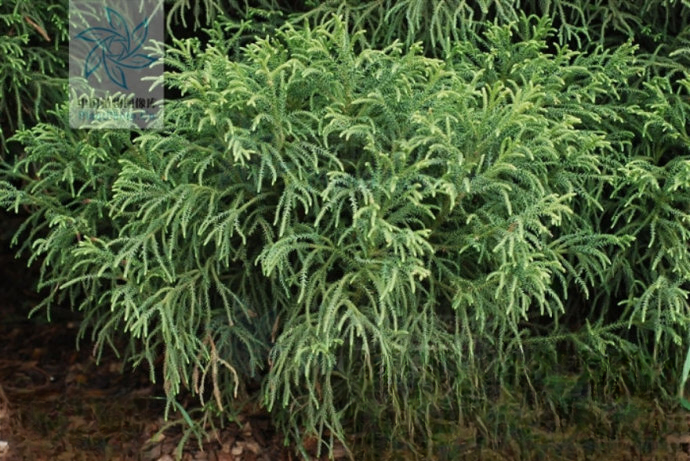
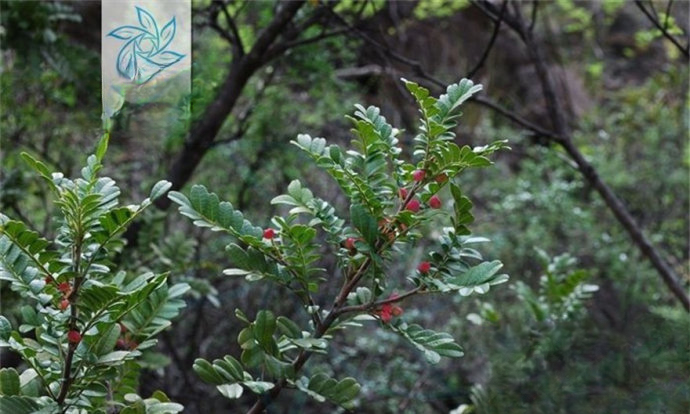
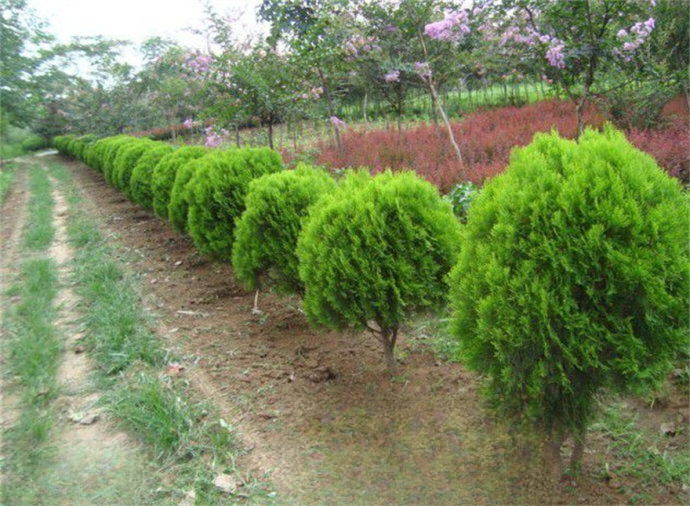
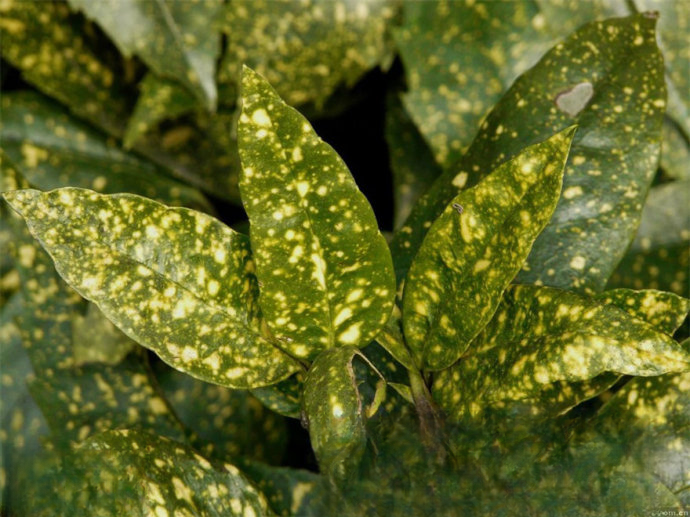
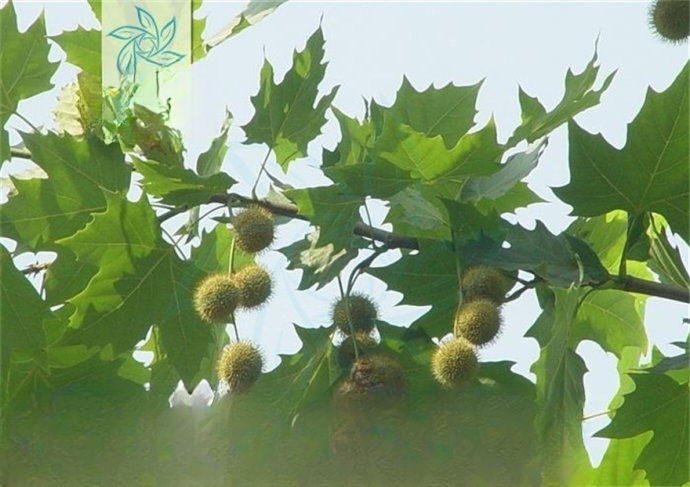
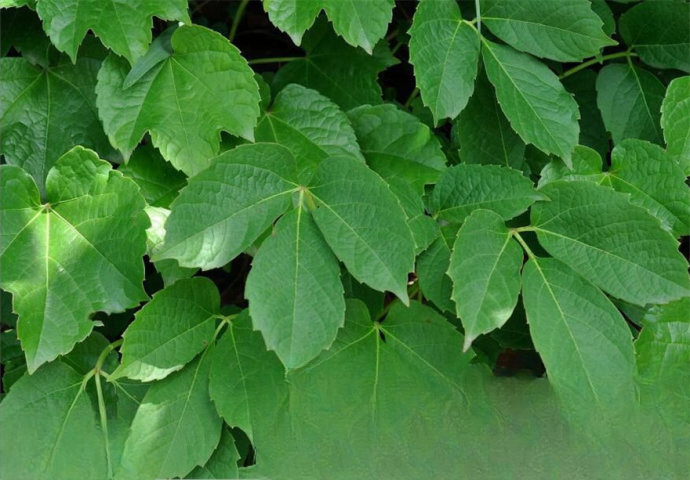
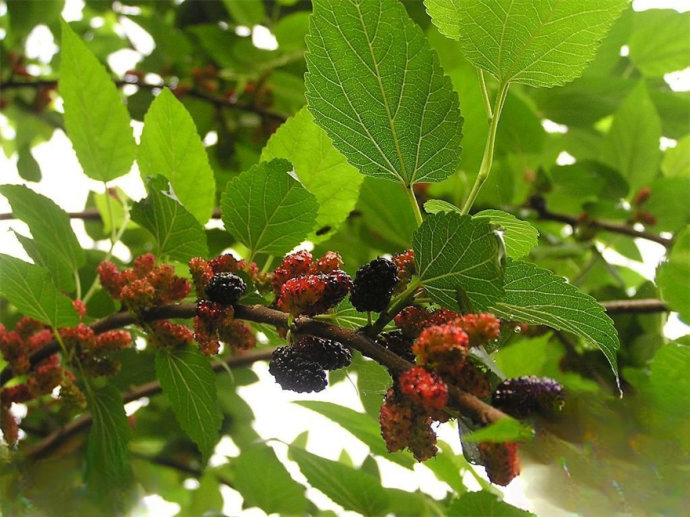
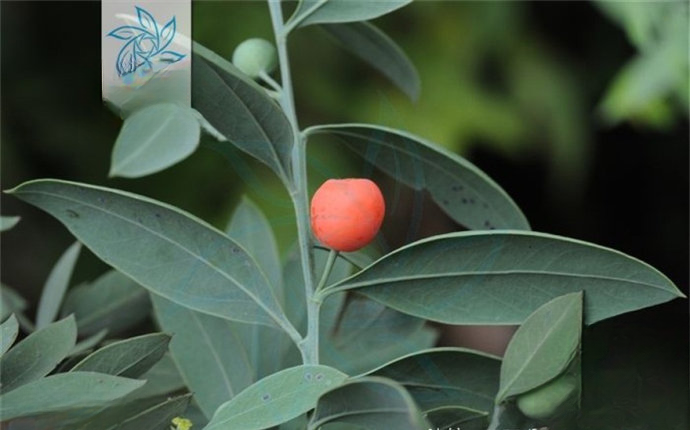
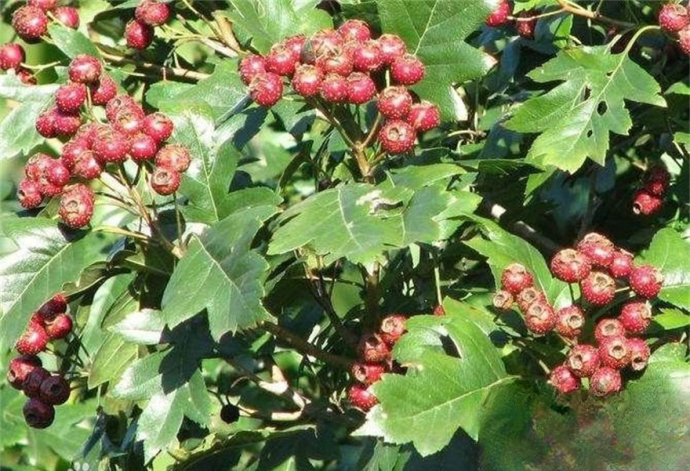

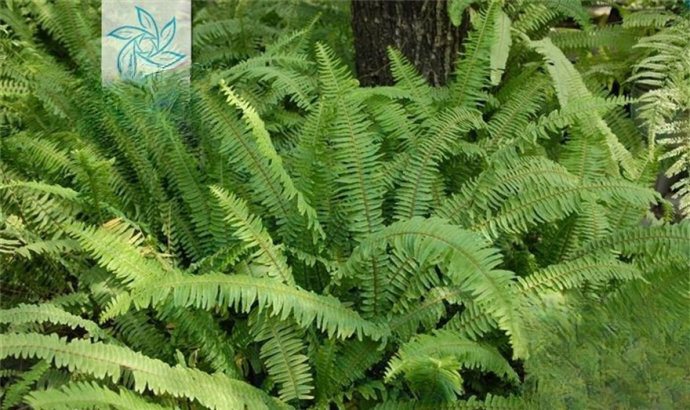
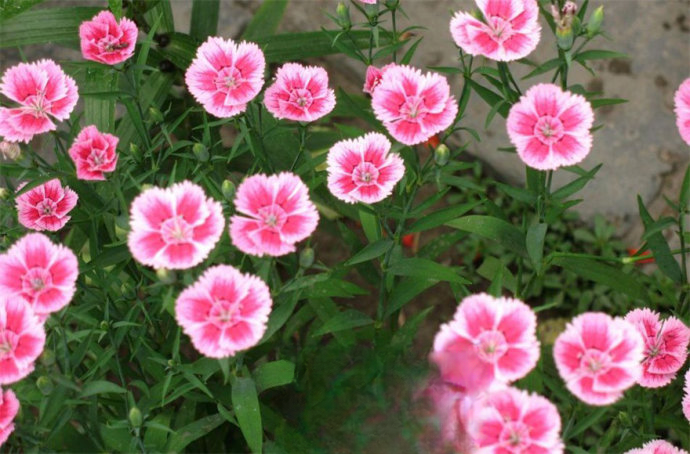
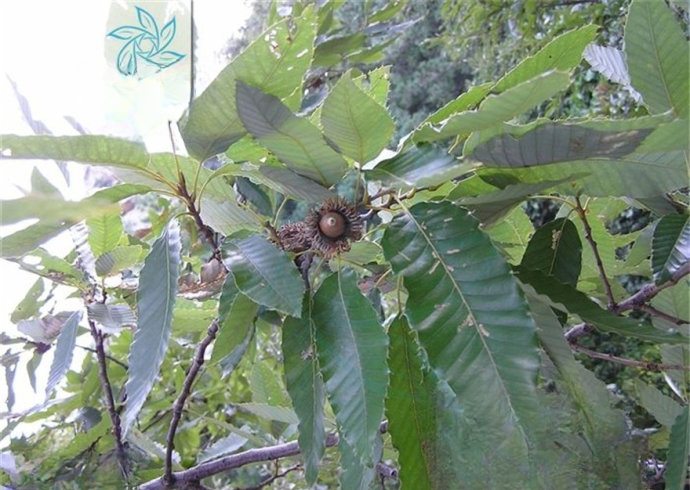
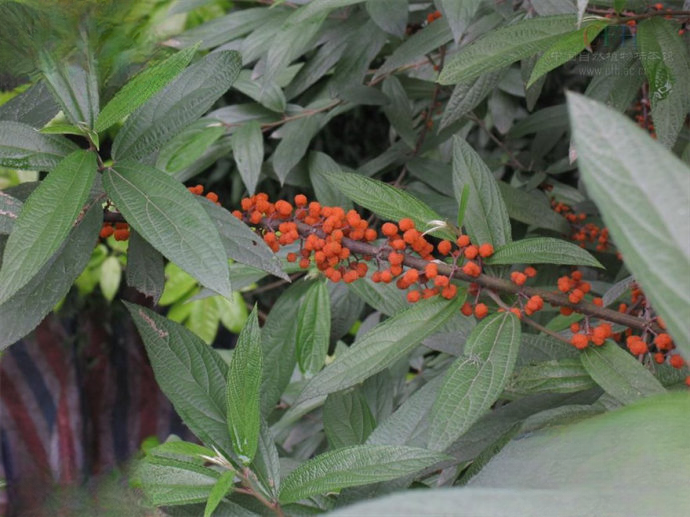
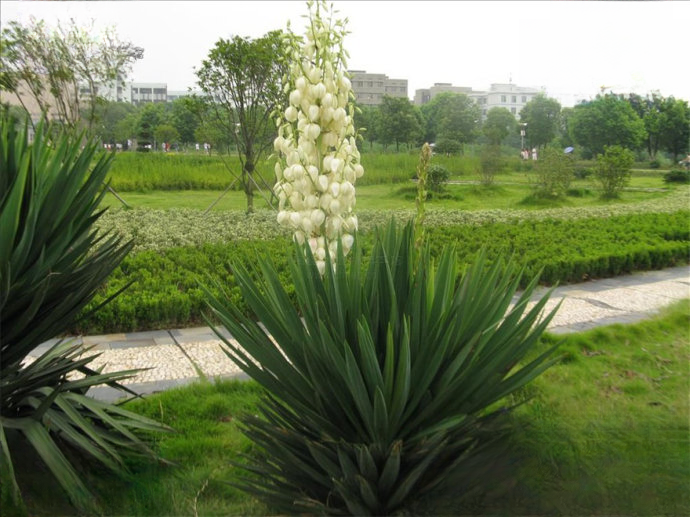
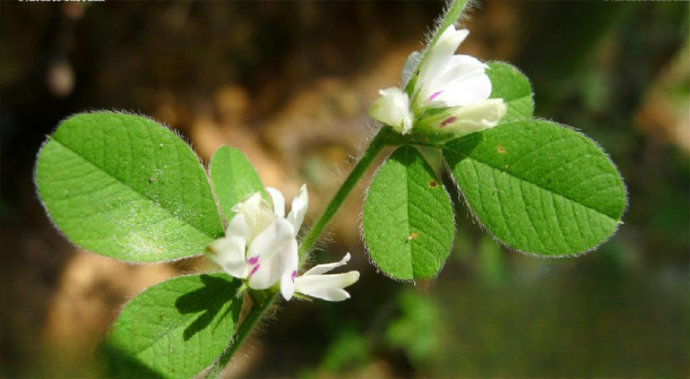
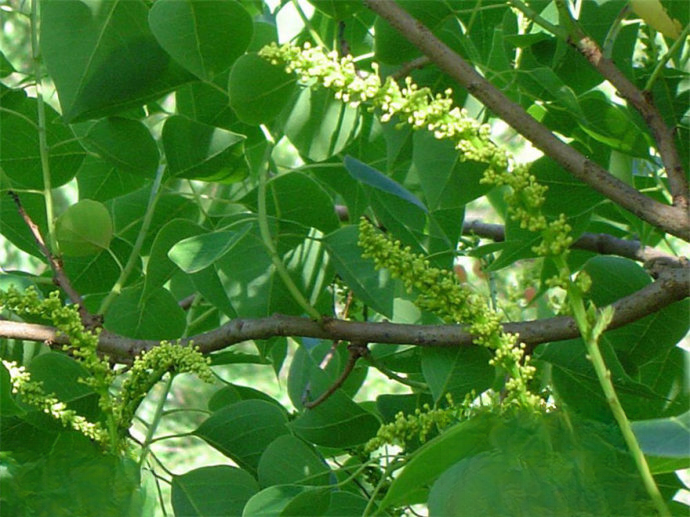
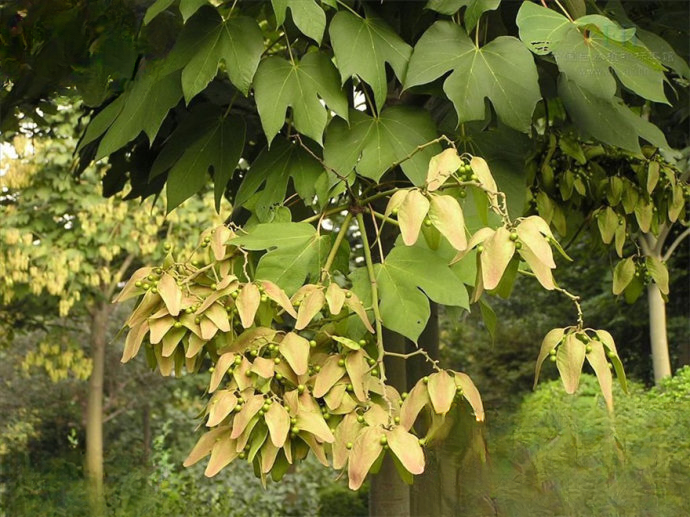
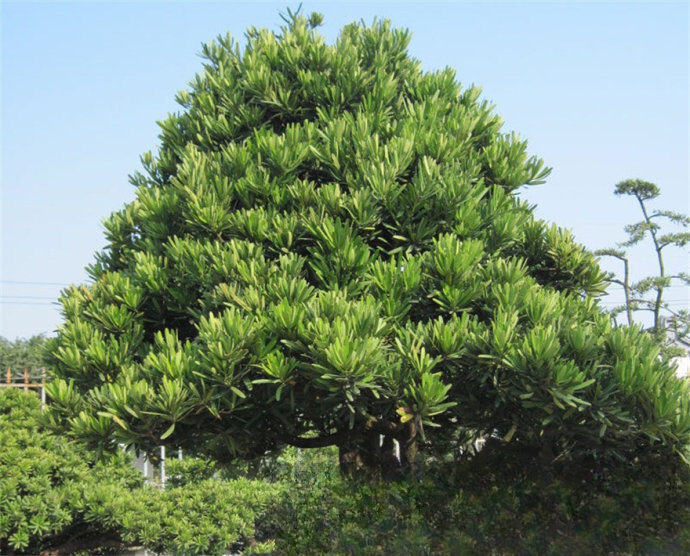
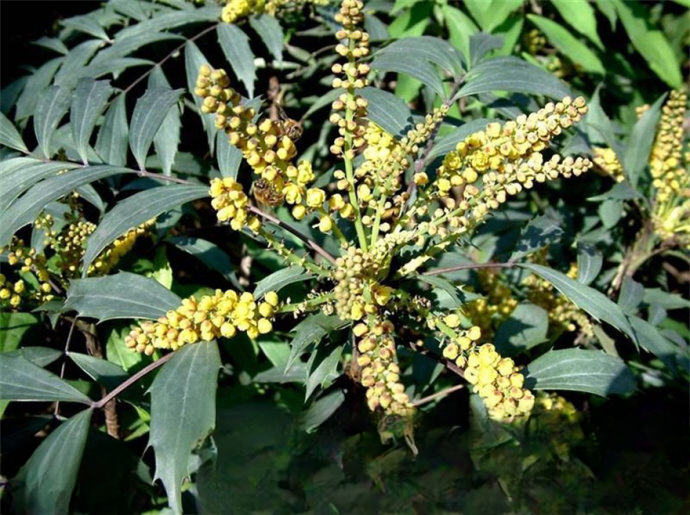

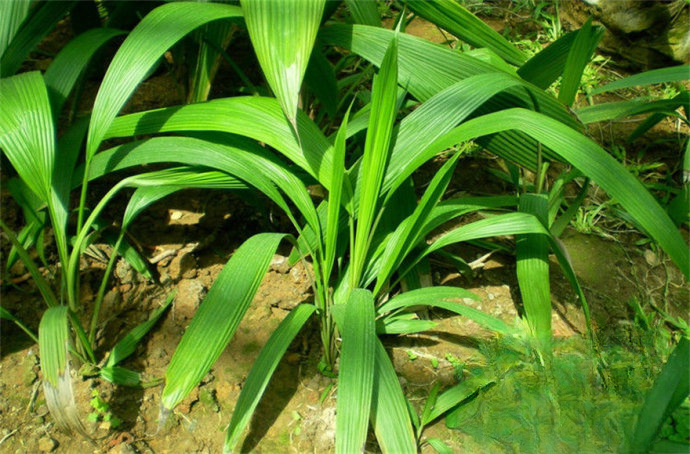
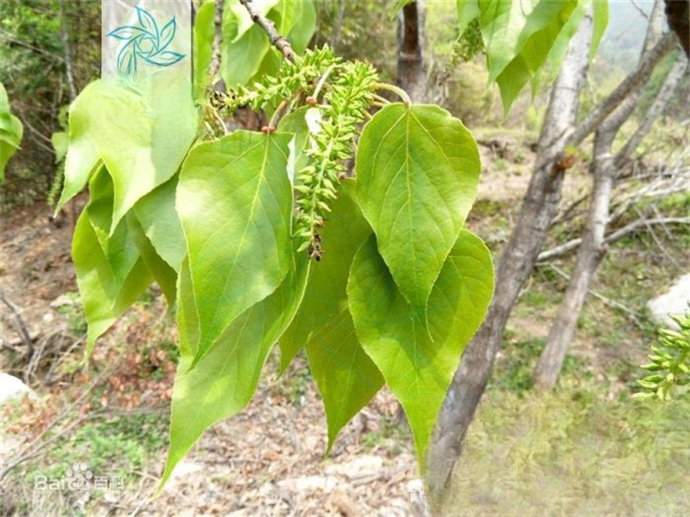
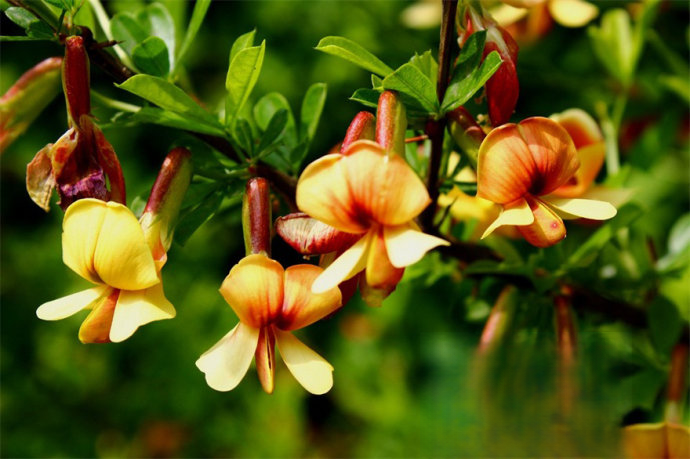
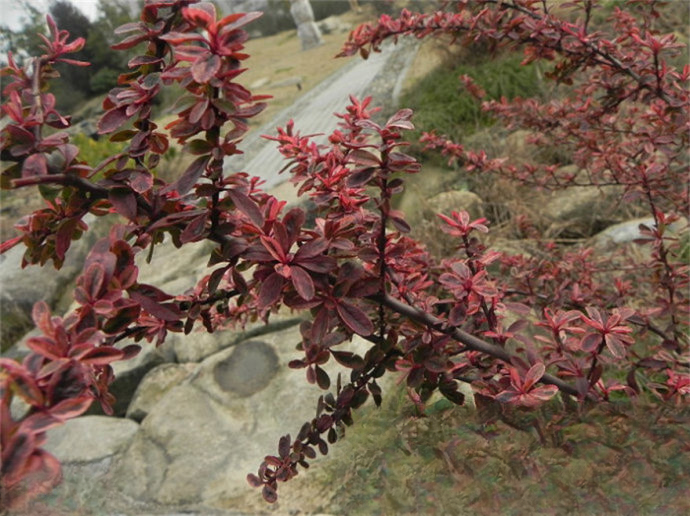
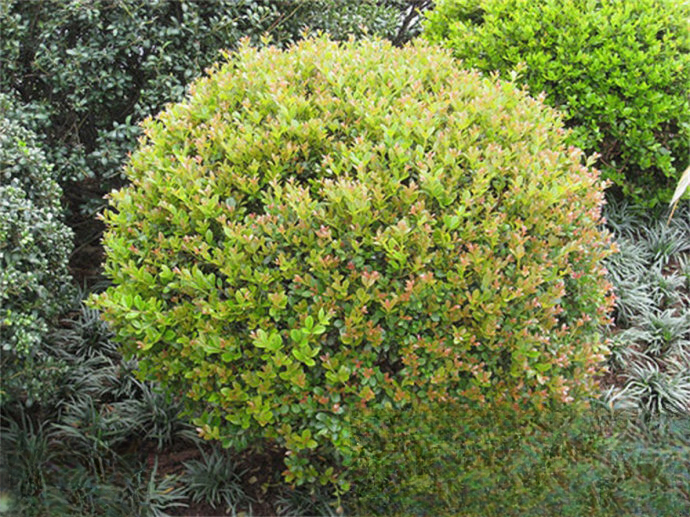
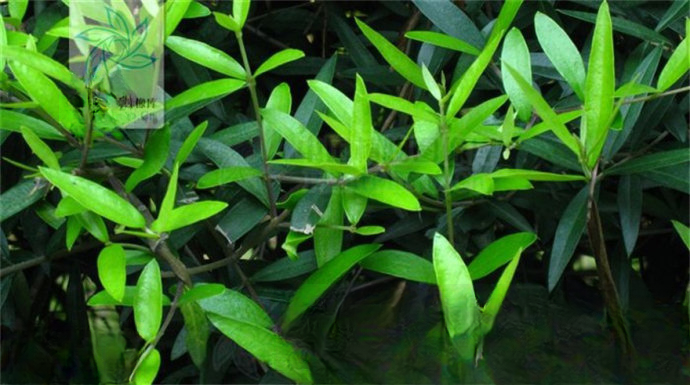
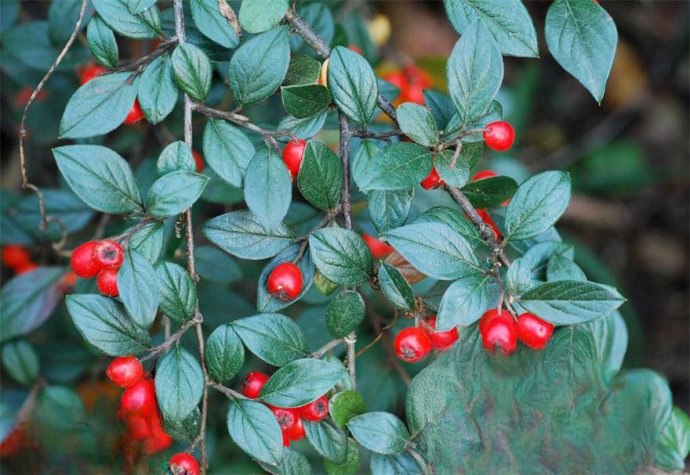 Cotoneaster, also known as ground centipede, may be named because its branches are somewhat like centipedes and the plants are not high and even creep on the ground or rocks. Deciduous, evergreen or semi-evergreen shrubs, sometimes small trees; winter buds are small, with several imbricate scales. Leaves are alternate, sometimes in two rows, with short petioles and entire margins; stipules are small and fall off very early. Flowers are solitary, 2-3 or more in cymes, axillary or borne at the top of short branches; calyx tube is bell-shaped, tubular or gyroid, with 5 short sepals ; petals are 5 , white, pink or red, erect or open, arranged in a shingle-like manner in the flower buds; stamens are usually 20 , rarely 5-25 ; styles are 2-5 , free, carpels are fused to the calyx tube on the back and separated on the ventral side, each carpel has 2 ovules; ovary is inferior or semi-inferior. The fruit is small pear-shaped, red, brown-red to purple-black, with persistent sepals at the tip, containing 1-5 small cores; the small core is bony, often with 1 seed; the seeds are flat, and the cotyledons are flat-convex. There are about 50 species of them, belonging to the Rosaceae family, native to temperate regions of Europe and Asia. There are many varieties, most of which grow in the southwest. The ground centipede has good ornamental value, so it is widely planted and is a very important greening garden plant. Cotoneaster is closely related to hawthorn, and its deciduous species are easily confused with hawthorn plants. The difference is that the leaves of cotoneaster are entire and unbroken, and the stems are thornless. Most cotoneaster fruits are red, but the color varies greatly depending on the species, ranging from yellow to black, with a variety of colors. Rosaceae, apple subfamily, Cotoneaster genus.
Cotoneaster, also known as ground centipede, may be named because its branches are somewhat like centipedes and the plants are not high and even creep on the ground or rocks. Deciduous, evergreen or semi-evergreen shrubs, sometimes small trees; winter buds are small, with several imbricate scales. Leaves are alternate, sometimes in two rows, with short petioles and entire margins; stipules are small and fall off very early. Flowers are solitary, 2-3 or more in cymes, axillary or borne at the top of short branches; calyx tube is bell-shaped, tubular or gyroid, with 5 short sepals ; petals are 5 , white, pink or red, erect or open, arranged in a shingle-like manner in the flower buds; stamens are usually 20 , rarely 5-25 ; styles are 2-5 , free, carpels are fused to the calyx tube on the back and separated on the ventral side, each carpel has 2 ovules; ovary is inferior or semi-inferior. The fruit is small pear-shaped, red, brown-red to purple-black, with persistent sepals at the tip, containing 1-5 small cores; the small core is bony, often with 1 seed; the seeds are flat, and the cotyledons are flat-convex. There are about 50 species of them, belonging to the Rosaceae family, native to temperate regions of Europe and Asia. There are many varieties, most of which grow in the southwest. The ground centipede has good ornamental value, so it is widely planted and is a very important greening garden plant. Cotoneaster is closely related to hawthorn, and its deciduous species are easily confused with hawthorn plants. The difference is that the leaves of cotoneaster are entire and unbroken, and the stems are thornless. Most cotoneaster fruits are red, but the color varies greatly depending on the species, ranging from yellow to black, with a variety of colors. Rosaceae, apple subfamily, Cotoneaster genus.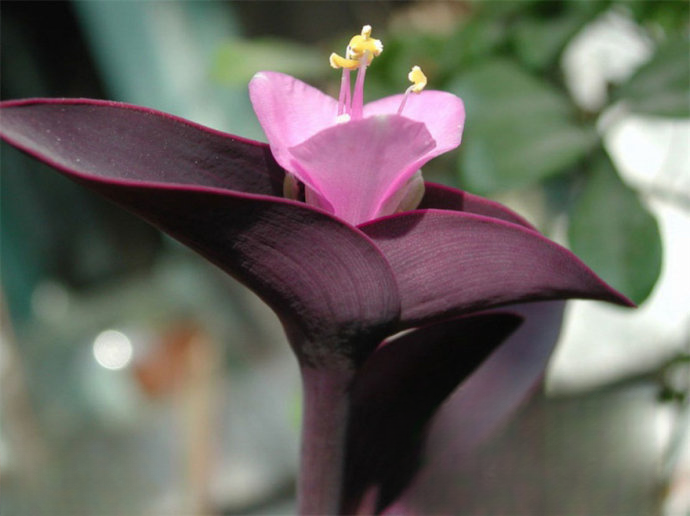 Commelina communis, Latin name: ( Commelina communis ), also known as green bamboo, green butterfly, light bamboo leaf, etc. It belongs to the order Powdery Endospermaceae, Commelinaceae, Commelinaceae, and is an annual loose herb. Commelinaceae has lanceolate to ovate-lanceolate leaves, alternate phyllotaxus, creeping stems, and polyphyllous flowers, which are terminal or axillary, monoecious, with two blue petals on the upper side and one white petal on the lower side. The buds are spathe-shaped, green, and have 6 stamens. Commelinaceae Commelinaceae, Commelinaceae, Commelinaceae, Commelinaceae.
Commelina communis, Latin name: ( Commelina communis ), also known as green bamboo, green butterfly, light bamboo leaf, etc. It belongs to the order Powdery Endospermaceae, Commelinaceae, Commelinaceae, and is an annual loose herb. Commelinaceae has lanceolate to ovate-lanceolate leaves, alternate phyllotaxus, creeping stems, and polyphyllous flowers, which are terminal or axillary, monoecious, with two blue petals on the upper side and one white petal on the lower side. The buds are spathe-shaped, green, and have 6 stamens. Commelinaceae Commelinaceae, Commelinaceae, Commelinaceae, Commelinaceae. 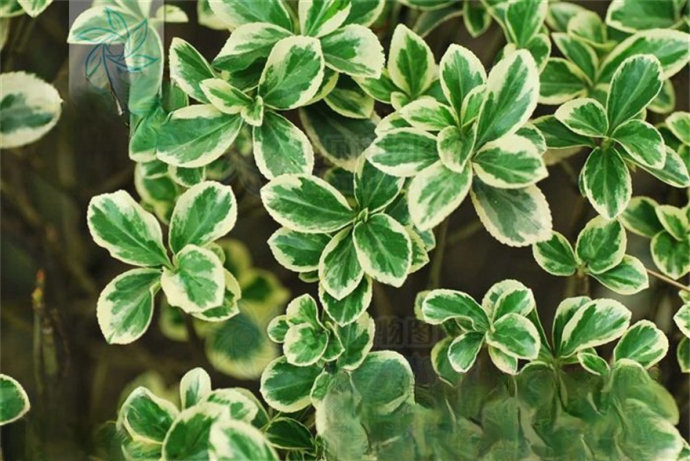 Silver-margined boxwood (scientific name: Euonymus japonicus Thunb. var. albo-marginatus Hort. ), also known as silver-margined euonymus, large-leaf boxwood, and holly euonymus. Shrub, twigs four-angled; leaves opposite; flowers white-green bisexual, white-green in axillary, stalked cymes; stamens anthers oblong, filaments very short, born on the disk; disk flat, thick; ovary 2 ovules per locule, hidden in the disk; ovules per locule ; fruit is a capsule, nearly spherical; seeds have red aril. Flowering period June-July , fruit ripening period September-October . Cultivated in provinces and regions of the north and south, used for ornamental or hedge; can be used as medicine, has the effect of promoting blood circulation and removing blood stasis. Sapindaceae, Celastraceae, Celastraceae, genus Celastraceae.
Silver-margined boxwood (scientific name: Euonymus japonicus Thunb. var. albo-marginatus Hort. ), also known as silver-margined euonymus, large-leaf boxwood, and holly euonymus. Shrub, twigs four-angled; leaves opposite; flowers white-green bisexual, white-green in axillary, stalked cymes; stamens anthers oblong, filaments very short, born on the disk; disk flat, thick; ovary 2 ovules per locule, hidden in the disk; ovules per locule ; fruit is a capsule, nearly spherical; seeds have red aril. Flowering period June-July , fruit ripening period September-October . Cultivated in provinces and regions of the north and south, used for ornamental or hedge; can be used as medicine, has the effect of promoting blood circulation and removing blood stasis. Sapindaceae, Celastraceae, Celastraceae, genus Celastraceae. 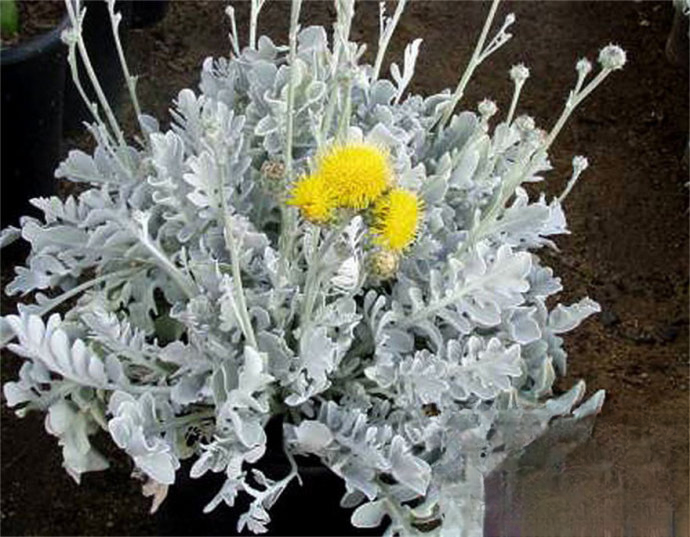 Silver leaf chrysanthemum. Alias: Snow leaf chrysanthemum; a perennial herb of the genus Senecio of the genus Asteraceae. The plant is multi-branched, generally 50 to 80 cm in height, with one to two pinnate-shaped leaves, both front and back covered with silvery white soft hairs. Its silvery white leaves look like a white cloud from a distance, and when planted with other pure-color flowers, the effect is excellent. It is an important foliage plant in flower beds.
Silver leaf chrysanthemum. Alias: Snow leaf chrysanthemum; a perennial herb of the genus Senecio of the genus Asteraceae. The plant is multi-branched, generally 50 to 80 cm in height, with one to two pinnate-shaped leaves, both front and back covered with silvery white soft hairs. Its silvery white leaves look like a white cloud from a distance, and when planted with other pure-color flowers, the effect is excellent. It is an important foliage plant in flower beds.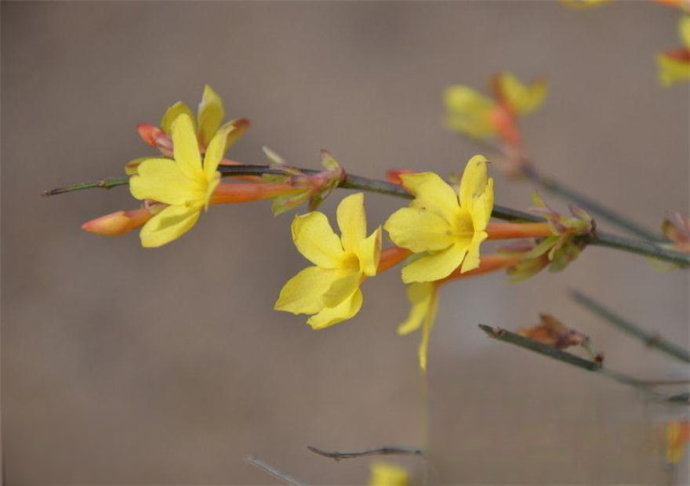
Winter jasmine. Scientific name (Jasminum nudiflorum), also known as winter jasmine, yellow jasmine, golden belt, deciduous shrubs. Plant height 30-100 cm. The twigs are slender and upright or arched and drooping, presenting a scattered shape. The 3-leaf compound leaves are alternately opposite, and the leaves are ovate to rectangular. The flowers are solitary on the branches of the previous year, blooming before the leaves, with a fresh fragrance, golden yellow, and reddish outside, and the flowering period is from February to April. It is named because it blooms the earliest among all flowers, and after blooming, spring comes when all flowers bloom. Winter jasmine, plum blossom, daffodil and camellia are collectively called "Four Friends in the Snow". It is one of the common flowers. Not only are the flowers dignified and beautiful, but also have extraordinary temperament. They are not afraid of the cold, are not picky about water and soil, and have strong adaptability. They have always been loved by people and are now the city flower of Hebi City, Henan Province. Jasmine genus, Jasminoides subfamily, Oleaceae.
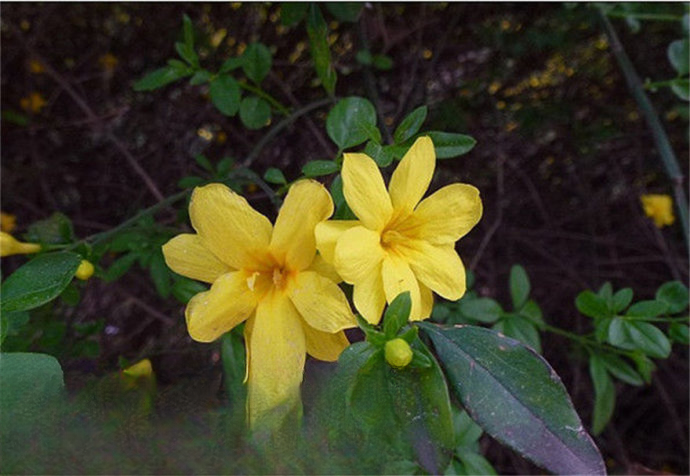 Yunnan Jasmine. Also known as Wild Jasmine and Golden Belt. Evergreen vine-like shrub. Branchlets are hairless, square, with shallow branches. Trifoliate compound leaves are opposite, oblong-lanceolate, with one leaf slightly larger at the top, gradually narrowing to a short stalk at the base, and two small sessile branches on the side. Both branches and leaves are dark green. Flowers are usually 1 to 2 , growing in leaf axils or branch tops, light yellow, 2 to 4.5 cm in diameter . It can be used as a garden ornamental, flower hedge, or ground cover plant. Yunnan Jasmine has long and weak branches, drooping or climbing, with green leaves and yellow flowers. It can be planted on embankments, terraces, and the edges of steps. It is especially suitable for hotel and building ceiling arrangements, and can also be potted for viewing. In addition to being used as an ornamental plant, the whole plant of Yunnan Jasmine can also be used as medicine. Oleaceae, ...
Yunnan Jasmine. Also known as Wild Jasmine and Golden Belt. Evergreen vine-like shrub. Branchlets are hairless, square, with shallow branches. Trifoliate compound leaves are opposite, oblong-lanceolate, with one leaf slightly larger at the top, gradually narrowing to a short stalk at the base, and two small sessile branches on the side. Both branches and leaves are dark green. Flowers are usually 1 to 2 , growing in leaf axils or branch tops, light yellow, 2 to 4.5 cm in diameter . It can be used as a garden ornamental, flower hedge, or ground cover plant. Yunnan Jasmine has long and weak branches, drooping or climbing, with green leaves and yellow flowers. It can be planted on embankments, terraces, and the edges of steps. It is especially suitable for hotel and building ceiling arrangements, and can also be potted for viewing. In addition to being used as an ornamental plant, the whole plant of Yunnan Jasmine can also be used as medicine. Oleaceae, ...  Spruce (Latin name: Picea asperata Mast. ) is also known as Maoxian spruce, Maoxian fir, rough-branched spruce, large-fruited spruce, rough-barked spruce, different-scaled spruce, big spruce, white pine, etc. It is a tree. It is up to 45 meters tall and has a breast diameter of 1 meter . The bark is light gray-brown or light brown-gray, cracked into irregular scales or slightly thick pieces that fall off. Spruce is a unique tree species, produced in southwestern Shaanxi (Fengxian), eastern Gansu (Liangdang) and the Bailong River Basin. It is slightly shade-tolerant and can withstand dry and cold environmental conditions. It grows at an altitude of 2400-3600 meters . The trunk of spruce is tall and straight, with few knots, the material is slightly soft, the texture is straight and uniform, the structure is delicate, easy to process , and has good resonance performance. It can be used for construction, aircraft, musical instruments (piano, violin), boats and vehicles, furniture, utensils, boxes, planed plywood and veneer, and wood fiber industrial raw materials. In February 2014 , Swedish scientists discovered a 9,500 -year-old spruce on a mountain range, which can be called the "oldest" tree in the world, and it is still growing. Pinaceae, Picea subfamily, spruce genus.
Spruce (Latin name: Picea asperata Mast. ) is also known as Maoxian spruce, Maoxian fir, rough-branched spruce, large-fruited spruce, rough-barked spruce, different-scaled spruce, big spruce, white pine, etc. It is a tree. It is up to 45 meters tall and has a breast diameter of 1 meter . The bark is light gray-brown or light brown-gray, cracked into irregular scales or slightly thick pieces that fall off. Spruce is a unique tree species, produced in southwestern Shaanxi (Fengxian), eastern Gansu (Liangdang) and the Bailong River Basin. It is slightly shade-tolerant and can withstand dry and cold environmental conditions. It grows at an altitude of 2400-3600 meters . The trunk of spruce is tall and straight, with few knots, the material is slightly soft, the texture is straight and uniform, the structure is delicate, easy to process , and has good resonance performance. It can be used for construction, aircraft, musical instruments (piano, violin), boats and vehicles, furniture, utensils, boxes, planed plywood and veneer, and wood fiber industrial raw materials. In February 2014 , Swedish scientists discovered a 9,500 -year-old spruce on a mountain range, which can be called the "oldest" tree in the world, and it is still growing. Pinaceae, Picea subfamily, spruce genus. 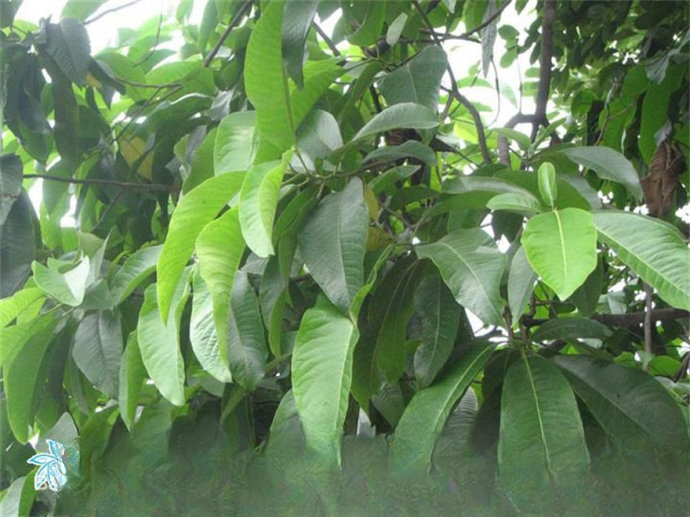 Yitong, generally refers to gardenia bark. Other names: Yitong, wild magnolia, mountain loquat, salt vegetable, long leaves, old heavy, peach fruit, rice, ox-eye fruit, white heart tree, Mo Dangming, Nongqi, Latin name: Itoa orientalis Hemsl. It is a deciduous tree of the family Hemsl., with gray or light gray and smooth bark; young branches are light gray with obvious lenticels, branches of the year have sparse hairs, and old branches are hairless. The leaves are large, thin and leathery, elliptical or ovate-oblong or oblong-obovate, the capsule is large, elliptical, densely covered with orange-yellow hairs, which later become hairless, the outer skin is leathery, the inner skin is woody, united in the middle, with many seeds, and grown in broad-leaved forests between 500-1400 meters above sea level . It is mainly used to clear away heat and detoxify . Gardenia genus, Acer truncatum, Acer truncatum , Aceraceae .
Yitong, generally refers to gardenia bark. Other names: Yitong, wild magnolia, mountain loquat, salt vegetable, long leaves, old heavy, peach fruit, rice, ox-eye fruit, white heart tree, Mo Dangming, Nongqi, Latin name: Itoa orientalis Hemsl. It is a deciduous tree of the family Hemsl., with gray or light gray and smooth bark; young branches are light gray with obvious lenticels, branches of the year have sparse hairs, and old branches are hairless. The leaves are large, thin and leathery, elliptical or ovate-oblong or oblong-obovate, the capsule is large, elliptical, densely covered with orange-yellow hairs, which later become hairless, the outer skin is leathery, the inner skin is woody, united in the middle, with many seeds, and grown in broad-leaved forests between 500-1400 meters above sea level . It is mainly used to clear away heat and detoxify . Gardenia genus, Acer truncatum, Acer truncatum , Aceraceae .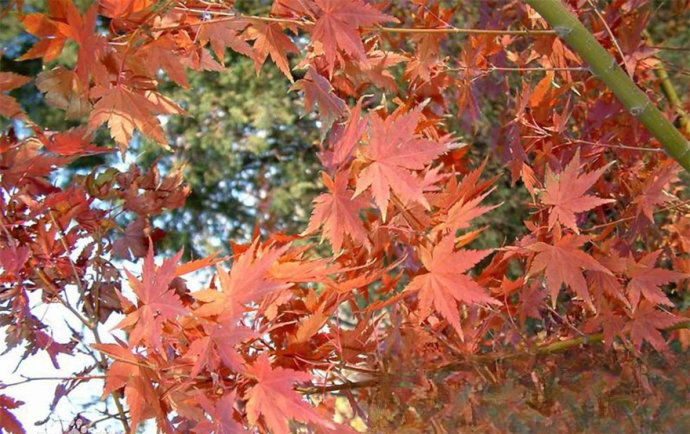 Purple-leaf Acer palmatum. A horticultural variety of Acer palmatum, Acer truncatum, Aceraceae. The plant height is generally no more than 4m , the crown is spreading, the branches are slightly drooping, the new branches are purple-red, and the mature branches are dark red ; the young leaves are bright red, densely covered with white soft hairs, and the leaves gradually fall off after stretching, and the leaf color also changes from bright to light purple or even dark green ; the leaves are deeply palmately lobed to the base, the lobes are narrow, long and feathery, with wrinkles, and gradually turn red in autumn. The purple-leaf Acer palmatum has red leaves like flowers, which are as bright as clouds. It has become a common foliage tree species for garden beautification in recent years. Aceraceae, Sapindaceae.
Purple-leaf Acer palmatum. A horticultural variety of Acer palmatum, Acer truncatum, Aceraceae. The plant height is generally no more than 4m , the crown is spreading, the branches are slightly drooping, the new branches are purple-red, and the mature branches are dark red ; the young leaves are bright red, densely covered with white soft hairs, and the leaves gradually fall off after stretching, and the leaf color also changes from bright to light purple or even dark green ; the leaves are deeply palmately lobed to the base, the lobes are narrow, long and feathery, with wrinkles, and gradually turn red in autumn. The purple-leaf Acer palmatum has red leaves like flowers, which are as bright as clouds. It has become a common foliage tree species for garden beautification in recent years. Aceraceae, Sapindaceae. 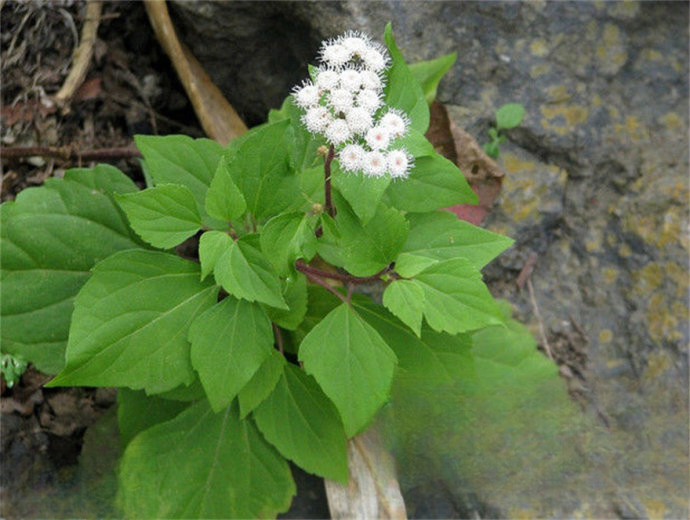 Eupatorium adenophora Spreng. , also known as liberation grass, red deer grass, destruction grass, black-headed grass, and big zelan. It is a perennial herb or semi-shrub. The rhizome is strong and developed, erect, 30-200 cm tall , with opposite and oblique branches, purple stems, and white or rusty short hairs. The leaves are opposite, thin, ovate, triangular or rhombus-ovate, green on the ventral side, light on the back, with sparse, thick and irregular serrations on the edges, and wavy shallow serrations or nearly entire below the inflorescence. The head inflorescence is small, up to 6 mm in diameter , arranged in umbels or compound umbels at the end of the branches, containing about 40-50 small flowers, tubular flowers bisexual, white. The fruit is achene, dark brown. Each plant can produce about 10,000 achenes per year , which are spread by the pappus. Flowering period is from November to April of the following year , and fruiting period is from March to April . Campanulaceae, Asteraceae, Cercis genus. Cercis chinensis , Leguminosae, deciduous tree or shrub. Native to. It likes sunlight and has a certain degree of cold resistance. It likes fertile and well-drained soil and cannot tolerate flooding. It has strong sprouting ability and is tolerant to pruning. The flowers of the fruit tree can be used as medicine, and its seeds are poisonous. It is a symbol of family harmony and deep affection. Leguminosae, Caesalpiniaceae, Cercis genus. Wisteria sinensis, also known as vine, red vine, and yellow ring. It is a deciduous climbing and twining large vine. The bark is dark gray and does not crack; it blooms in spring, with a blue-purple butterfly-shaped corolla, and the flowers are purple or dark purple, which is very beautiful. Wisteria is a warm and temperate plant with strong adaptability to the growing environment. It is native to the Yellow River and Yangtze River basins south of Hebei, as well as Shaanxi, Henan, Guangxi, Guizhou, and Yunnan. The purple flowers are boiled in water and served cold, or wrapped in flour and fried to make flavored pasta such as "purple radish cake" and "purple radish cake". Fabaceae Wisteria genus.
Eupatorium adenophora Spreng. , also known as liberation grass, red deer grass, destruction grass, black-headed grass, and big zelan. It is a perennial herb or semi-shrub. The rhizome is strong and developed, erect, 30-200 cm tall , with opposite and oblique branches, purple stems, and white or rusty short hairs. The leaves are opposite, thin, ovate, triangular or rhombus-ovate, green on the ventral side, light on the back, with sparse, thick and irregular serrations on the edges, and wavy shallow serrations or nearly entire below the inflorescence. The head inflorescence is small, up to 6 mm in diameter , arranged in umbels or compound umbels at the end of the branches, containing about 40-50 small flowers, tubular flowers bisexual, white. The fruit is achene, dark brown. Each plant can produce about 10,000 achenes per year , which are spread by the pappus. Flowering period is from November to April of the following year , and fruiting period is from March to April . Campanulaceae, Asteraceae, Cercis genus. Cercis chinensis , Leguminosae, deciduous tree or shrub. Native to. It likes sunlight and has a certain degree of cold resistance. It likes fertile and well-drained soil and cannot tolerate flooding. It has strong sprouting ability and is tolerant to pruning. The flowers of the fruit tree can be used as medicine, and its seeds are poisonous. It is a symbol of family harmony and deep affection. Leguminosae, Caesalpiniaceae, Cercis genus. Wisteria sinensis, also known as vine, red vine, and yellow ring. It is a deciduous climbing and twining large vine. The bark is dark gray and does not crack; it blooms in spring, with a blue-purple butterfly-shaped corolla, and the flowers are purple or dark purple, which is very beautiful. Wisteria is a warm and temperate plant with strong adaptability to the growing environment. It is native to the Yellow River and Yangtze River basins south of Hebei, as well as Shaanxi, Henan, Guangxi, Guizhou, and Yunnan. The purple flowers are boiled in water and served cold, or wrapped in flour and fried to make flavored pasta such as "purple radish cake" and "purple radish cake". Fabaceae Wisteria genus.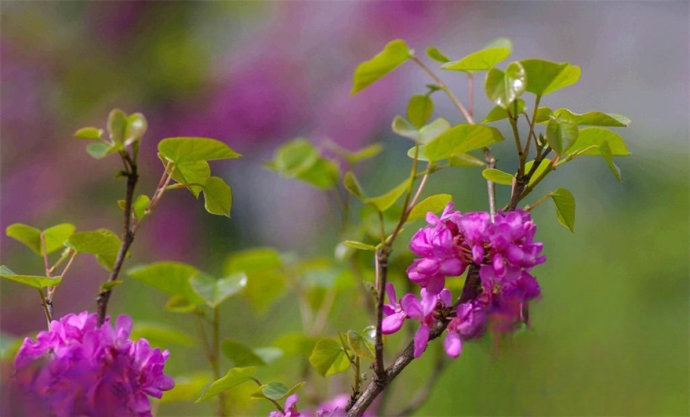

 White clover ( Trifolium repens L ) is also known as white clover, white clover, white three grass, clover, Dutch clover, etc. It is a short-term perennial herb, a cultivated plant, with a growth period of 6 years, 10-30 cm high, short taproot, well-developed lateral roots and fibrous roots, creeping stems, slightly rising at the top, roots at the nodes, and the whole plant is hairless. Palmate three compound leaves; stipules ovate-lanceolate, membranous, base clasping the stem into a sheath, and the free part is sharp. It has a wide adaptability, strong heat and cold resistance, can grow vigorously in acidic soil, and can also grow in sandy soil. It has certain ornamental value. It is one of the main cultivated forage grasses in countries around the world. It is mainly used for grassland construction and has good ecological and economic value . It belongs to the genus Trifolium, Trifoliaceae, Leguminosae.
White clover ( Trifolium repens L ) is also known as white clover, white clover, white three grass, clover, Dutch clover, etc. It is a short-term perennial herb, a cultivated plant, with a growth period of 6 years, 10-30 cm high, short taproot, well-developed lateral roots and fibrous roots, creeping stems, slightly rising at the top, roots at the nodes, and the whole plant is hairless. Palmate three compound leaves; stipules ovate-lanceolate, membranous, base clasping the stem into a sheath, and the free part is sharp. It has a wide adaptability, strong heat and cold resistance, can grow vigorously in acidic soil, and can also grow in sandy soil. It has certain ornamental value. It is one of the main cultivated forage grasses in countries around the world. It is mainly used for grassland construction and has good ecological and economic value . It belongs to the genus Trifolium, Trifoliaceae, Leguminosae. Sophora davidii ( Franch .). The leaves are oval or oblong with obvious veins, brittle and easy to break. The smell is slight, and the taste is slightly astringent and bitter. The flowers are white and bitter. The pods are 3-6cm long, about 5mm thick, beaded, and herbaceous, containing 1-7 seeds. The seeds are oval, with a light yellow-white or yellow-green surface, smooth and shiny. There is a vertical ridge between the hilum and the chalazion. The hilum is slightly concave and biased to one end. It is round, hard and not easy to break. Fabaceae Sophora genus.
Sophora davidii ( Franch .). The leaves are oval or oblong with obvious veins, brittle and easy to break. The smell is slight, and the taste is slightly astringent and bitter. The flowers are white and bitter. The pods are 3-6cm long, about 5mm thick, beaded, and herbaceous, containing 1-7 seeds. The seeds are oval, with a light yellow-white or yellow-green surface, smooth and shiny. There is a vertical ridge between the hilum and the chalazion. The hilum is slightly concave and biased to one end. It is round, hard and not easy to break. Fabaceae Sophora genus. Fraxinus chinensis Roxb. It is named after the waxworms that live on the tree. It is also a sand-fixing tree. It is also called ash. It is a deciduous tree, up to 10-12 meters tall. The bark is gray-brown with shallow and fine cracks. Pinnate compound leaves are opposite, with long petioles, 3-7 leaflets, usually 5, ovate, rarely long ovate or wide ovate, with the largest leaf at the top, 8-11cm long, 3-4.5cm wide. Small light green flowers bloom in late spring, opening at the same time as the leaves, forming terminal and lateral panicles, the flowers are unisexual, dioecious or polygamous, the calyx is small, 4-lobed; there is no corolla; the male flower has 2 stamens; the female flower has an upper ovary, the style is slender, the stigma is 2-lobed, the capsule is narrow and oblanceolate, and the nutlet is located at the base of the wing. The flowering period is May and the fruiting period is August-September. Fraxinus chinensis is an important source of biological wax. Oleaceae, Oleaceae subfamily, Araceae tribe, Arum genus, Arum subgenus.
Fraxinus chinensis Roxb. It is named after the waxworms that live on the tree. It is also a sand-fixing tree. It is also called ash. It is a deciduous tree, up to 10-12 meters tall. The bark is gray-brown with shallow and fine cracks. Pinnate compound leaves are opposite, with long petioles, 3-7 leaflets, usually 5, ovate, rarely long ovate or wide ovate, with the largest leaf at the top, 8-11cm long, 3-4.5cm wide. Small light green flowers bloom in late spring, opening at the same time as the leaves, forming terminal and lateral panicles, the flowers are unisexual, dioecious or polygamous, the calyx is small, 4-lobed; there is no corolla; the male flower has 2 stamens; the female flower has an upper ovary, the style is slender, the stigma is 2-lobed, the capsule is narrow and oblanceolate, and the nutlet is located at the base of the wing. The flowering period is May and the fruiting period is August-September. Fraxinus chinensis is an important source of biological wax. Oleaceae, Oleaceae subfamily, Araceae tribe, Arum genus, Arum subgenus. Michelia alba DC.: Other names : white Burmese flower, white orchid, Burmese osmanthus, white orchid, white magnolia. Evergreen tree, up to 17 meters tall , with wide branches and a broad umbrella-shaped crown; 30 cm in diameter ; gray bark; fragrant branches and leaves; young branches and buds densely covered with light yellow-white pubescence, which gradually falls off when old. Leaves are thinly leathery, oblong or lanceolate-elliptical, glabrous above, sparsely pubescent below, with obvious reticulate veins on both sides when dry. Flowers are white and very fragrant; 10 tepals, lanceolate; pistil carpels are numerous, and when mature, they extend with the extension of the receptacle to form a sparsely follicled aggregate fruit; follicles are bright red when mature. Flowering period is from April to September , blooming in summer, usually not fruiting. The flowers are white and fragrant, blooming in summer and autumn, with a long flowering period and dark green leaves. It is a famous garden ornamental tree species, mostly planted as a street tree, and is often propagated by grafting, using Champaca, Michelia, and Phoebe as rootstocks; it can also be propagated by air layering or grafting. Magnoliaceae Magnolia tribe Michelia genus.
Michelia alba DC.: Other names : white Burmese flower, white orchid, Burmese osmanthus, white orchid, white magnolia. Evergreen tree, up to 17 meters tall , with wide branches and a broad umbrella-shaped crown; 30 cm in diameter ; gray bark; fragrant branches and leaves; young branches and buds densely covered with light yellow-white pubescence, which gradually falls off when old. Leaves are thinly leathery, oblong or lanceolate-elliptical, glabrous above, sparsely pubescent below, with obvious reticulate veins on both sides when dry. Flowers are white and very fragrant; 10 tepals, lanceolate; pistil carpels are numerous, and when mature, they extend with the extension of the receptacle to form a sparsely follicled aggregate fruit; follicles are bright red when mature. Flowering period is from April to September , blooming in summer, usually not fruiting. The flowers are white and fragrant, blooming in summer and autumn, with a long flowering period and dark green leaves. It is a famous garden ornamental tree species, mostly planted as a street tree, and is often propagated by grafting, using Champaca, Michelia, and Phoebe as rootstocks; it can also be propagated by air layering or grafting. Magnoliaceae Magnolia tribe Michelia genus. Platycladus orientalis (Linn.)Franco is an evergreen tree, also known as cypress, cedar, and fragrant cedar. It is widely distributed in China, from Inner Mongolia and Jilin in the north to Guangdong and northern Guangxi in the south; it is cultivated throughout the country and is an excellent landscape tree species. The tree height can generally reach 20 meters . The bark is reddish brown and cracked longitudinally. The twigs are flat. The leaves are scaly and small. It is monoecious, and the cones are solitary at the top of the branches. The cones are nearly ovate. The seeds are long ovate and wingless. Platycladus orientalis likes light, but seedlings and young trees have a certain ability to tolerate shade. It is relatively cold-resistant and has poor wind resistance. It is drought-resistant and likes moisture, but it cannot tolerate flooding. It can tolerate barrenness and can grow on slightly acidic to slightly alkaline soils. It grows slowly. It has a very long lifespan. It belongs to the genus Platycladus in the subfamily Cupressoideae of the family Cupressaceae.
Platycladus orientalis (Linn.)Franco is an evergreen tree, also known as cypress, cedar, and fragrant cedar. It is widely distributed in China, from Inner Mongolia and Jilin in the north to Guangdong and northern Guangxi in the south; it is cultivated throughout the country and is an excellent landscape tree species. The tree height can generally reach 20 meters . The bark is reddish brown and cracked longitudinally. The twigs are flat. The leaves are scaly and small. It is monoecious, and the cones are solitary at the top of the branches. The cones are nearly ovate. The seeds are long ovate and wingless. Platycladus orientalis likes light, but seedlings and young trees have a certain ability to tolerate shade. It is relatively cold-resistant and has poor wind resistance. It is drought-resistant and likes moisture, but it cannot tolerate flooding. It can tolerate barrenness and can grow on slightly acidic to slightly alkaline soils. It grows slowly. It has a very long lifespan. It belongs to the genus Platycladus in the subfamily Cupressoideae of the family Cupressaceae. Iris confusa Sealy : Perennial herb. Rhizomes are horizontal, 4-7 mm in diameter , yellowish brown, with obvious nodes and long internodes; fibrous roots are branched, yellowish brown or light yellow. The aboveground stems are erect. There are more than 10 leaves , densely packed at the top of the stem, with sheath-like bases, overlapping each other, arranged in a fan-like shape, and the leaves are broadly sword-shaped and yellowish green. The flower stem is 20-30 cm long and racemose; the bracts are ovate, containing 3-5 flowers; the flowers are light blue or white, 5-5.5 cm in diameter ; the outer perianth lobes are elliptical, slightly concave at the top, with wavy wrinkles on the edges, sparse teeth, and cuneate claws; the inner perianth lobes are oblong lanceolate, slightly concave at the top. The capsule is elliptical, with reticular veins and 6 obvious ribs on the surface; the seeds are dark brown and have no appendages. The flowering period is April , and the fruiting period is May-July . It grows on the edge of the forest, under sparse forests, in valley wetlands or hillside grasslands. The rhizome is used for medicinal purposes to treat acute tonsillitis and acute bronchitis.
Iris confusa Sealy : Perennial herb. Rhizomes are horizontal, 4-7 mm in diameter , yellowish brown, with obvious nodes and long internodes; fibrous roots are branched, yellowish brown or light yellow. The aboveground stems are erect. There are more than 10 leaves , densely packed at the top of the stem, with sheath-like bases, overlapping each other, arranged in a fan-like shape, and the leaves are broadly sword-shaped and yellowish green. The flower stem is 20-30 cm long and racemose; the bracts are ovate, containing 3-5 flowers; the flowers are light blue or white, 5-5.5 cm in diameter ; the outer perianth lobes are elliptical, slightly concave at the top, with wavy wrinkles on the edges, sparse teeth, and cuneate claws; the inner perianth lobes are oblong lanceolate, slightly concave at the top. The capsule is elliptical, with reticular veins and 6 obvious ribs on the surface; the seeds are dark brown and have no appendages. The flowering period is April , and the fruiting period is May-July . It grows on the edge of the forest, under sparse forests, in valley wetlands or hillside grasslands. The rhizome is used for medicinal purposes to treat acute tonsillitis and acute bronchitis. Platycladus orientalis ( L.) Franco is also known as yellow cedar, fragrant cedar, flat cypress, flat cypress, fragrant tree, fragrant tree. It is an evergreen tree. The crown is broadly ovate, and the twigs are flat and arranged in a plane. The leaves are small, scaly, close to the twigs, arranged in a cross-opposite pattern, and have glandular grooves in the middle of the back of the leaves. It is monoecious and the flowers are unisexual. The male cones are yellow and composed of microsporophyll that are alternately opposite. Each microsporophyll has 3 pollen sacs, and the bead scales and bract scales are completely fused. The cones mature in the same year, the seed scales are lignified and cracked, and the seeds are not winged or have ridges. Platycladus orientalis is a specialty and is distributed throughout the country except Qinghai and Xinjiang. It has a long lifespan, and there are often ancient trees that are hundreds of years old or more. It has been selected as the city tree of Beijing. Platycladus orientalis is drought-tolerant and is often used as a afforestation tree on sunny slopes. It is also a common garden greening tree species. Its wood can be used for construction and furniture. Its leaves and branches are used as medicine, which can be astringent and hemostatic, diuretic and stomachic, and detoxify and relieve blood stasis. Its seeds have the effect of calming the nerves and nourishing and strengthening the body.
Platycladus orientalis ( L.) Franco is also known as yellow cedar, fragrant cedar, flat cypress, flat cypress, fragrant tree, fragrant tree. It is an evergreen tree. The crown is broadly ovate, and the twigs are flat and arranged in a plane. The leaves are small, scaly, close to the twigs, arranged in a cross-opposite pattern, and have glandular grooves in the middle of the back of the leaves. It is monoecious and the flowers are unisexual. The male cones are yellow and composed of microsporophyll that are alternately opposite. Each microsporophyll has 3 pollen sacs, and the bead scales and bract scales are completely fused. The cones mature in the same year, the seed scales are lignified and cracked, and the seeds are not winged or have ridges. Platycladus orientalis is a specialty and is distributed throughout the country except Qinghai and Xinjiang. It has a long lifespan, and there are often ancient trees that are hundreds of years old or more. It has been selected as the city tree of Beijing. Platycladus orientalis is drought-tolerant and is often used as a afforestation tree on sunny slopes. It is also a common garden greening tree species. Its wood can be used for construction and furniture. Its leaves and branches are used as medicine, which can be astringent and hemostatic, diuretic and stomachic, and detoxify and relieve blood stasis. Its seeds have the effect of calming the nerves and nourishing and strengthening the body. Sassafras tzumu ( Hemsl . ) Hemsl ., also known as Sassafras (Zhejiang, Jiangxi), Nanshu, Shansashi (Zhejiang), Qingsashi (Anhui), Tongzishu, Lihuohong (Fujian), Zimu, Huangshaoshu (Hubei), Brushwood (Guangdong Fengchuan), Huashanshu (Yunnan Zhenxiong, Sichuan), Goosefoot Board (Yunnan Weixin), Half Wind Camphor (Guangxi). Deciduous tree, up to 35 meters high , with a breast diameter of 2.5 meters . It likes warm and humid climate. It likes light and is not shade-tolerant. It is used for shipbuilding, waterwheels and high-quality furniture. It belongs to the genus Sassafras of the Lauraceae subfamily of the Lauraceae family, the Cinnamomum camphora family.
Sassafras tzumu ( Hemsl . ) Hemsl ., also known as Sassafras (Zhejiang, Jiangxi), Nanshu, Shansashi (Zhejiang), Qingsashi (Anhui), Tongzishu, Lihuohong (Fujian), Zimu, Huangshaoshu (Hubei), Brushwood (Guangdong Fengchuan), Huashanshu (Yunnan Zhenxiong, Sichuan), Goosefoot Board (Yunnan Weixin), Half Wind Camphor (Guangxi). Deciduous tree, up to 35 meters high , with a breast diameter of 2.5 meters . It likes warm and humid climate. It likes light and is not shade-tolerant. It is used for shipbuilding, waterwheels and high-quality furniture. It belongs to the genus Sassafras of the Lauraceae subfamily of the Lauraceae family, the Cinnamomum camphora family. Ivy (Latin name: Hedera nepalensis var. sinensis (Tobl.) Rehd ) is a perennial evergreen climbing shrub with aerial roots, gray-brown or black-brown smooth stems, alternate single leaves; petioles without stipules and scales; leaves on flower branches are elliptical lanceolate, umbels are single and terminal, flowers are pale yellow-white or pale green-white, anthers are purple; the disk is raised and yellow. The fruit is spherical, red or yellow, flowering from September to November , and fruiting from March to May of the following year . Ivy has beautiful leaves and is evergreen all year round. It is often used for vertical greening in various parts of the south. It is often planted beside rockery and at the base of the wall, allowing it to grow vertically or cover naturally, which has the effect of decorating and beautifying the environment. When potted, small and medium-sized pots are mainly used, and various shapes can be made for indoor display. It can also be used to cover the walls of indoor gardens, making the indoor garden landscape more natural and beautiful. The whole ivy plant can be used as medicine, which has the effects of removing rheumatism, promoting blood circulation and reducing swelling, and has therapeutic effects on traumatic injuries, back pain, rheumatoid arthritis, etc. Ivy belongs to the genus Hedera of the family Araliaceae.
Ivy (Latin name: Hedera nepalensis var. sinensis (Tobl.) Rehd ) is a perennial evergreen climbing shrub with aerial roots, gray-brown or black-brown smooth stems, alternate single leaves; petioles without stipules and scales; leaves on flower branches are elliptical lanceolate, umbels are single and terminal, flowers are pale yellow-white or pale green-white, anthers are purple; the disk is raised and yellow. The fruit is spherical, red or yellow, flowering from September to November , and fruiting from March to May of the following year . Ivy has beautiful leaves and is evergreen all year round. It is often used for vertical greening in various parts of the south. It is often planted beside rockery and at the base of the wall, allowing it to grow vertically or cover naturally, which has the effect of decorating and beautifying the environment. When potted, small and medium-sized pots are mainly used, and various shapes can be made for indoor display. It can also be used to cover the walls of indoor gardens, making the indoor garden landscape more natural and beautiful. The whole ivy plant can be used as medicine, which has the effects of removing rheumatism, promoting blood circulation and reducing swelling, and has therapeutic effects on traumatic injuries, back pain, rheumatoid arthritis, etc. Ivy belongs to the genus Hedera of the family Araliaceae. Aucuba himalaica Hook. f. et Thomson var. dolichophylla Fang et Soong . Distributed in Hubei , Hunan, Guangdong, Guangxi, Sichuan, Guizhou and other places. It has the effects of dispelling wind and dampness, unblocking meridians and relieving pain. It is mainly used to treat rheumatic arthralgia, swelling and pain caused by falls. It belongs to the genus Aucuba himalaica of the family Cornaceae.
Aucuba himalaica Hook. f. et Thomson var. dolichophylla Fang et Soong . Distributed in Hubei , Hunan, Guangdong, Guangxi, Sichuan, Guizhou and other places. It has the effects of dispelling wind and dampness, unblocking meridians and relieving pain. It is mainly used to treat rheumatic arthralgia, swelling and pain caused by falls. It belongs to the genus Aucuba himalaica of the family Cornaceae. The pond cypress ( Taxodium ascendens Brongn. ) is a species of the genus Taxodium in the family Taxodiaceae. It is also known as the pond cypress and the swamp cypress. It is a deciduous tree up to 25 meters tall . The trunk is straight and the crown is spire-shaped. The base of the trunk is swollen, and the branches form a narrow crown upward, which is spire-shaped and beautiful. The leaves are awl-shaped and spirally extend on the branches; the cones are spherical. The flowering period is March , and the fruits mature in October and November . The cones are spherical or oblong-spherical with short stalks. The seeds are irregularly triangular, slightly flat, reddish, and have sharp ridges on the edges. It is corrosion-resistant and is a good material for shipbuilding and construction. Taxodium genus Taxodium in the family Taxodiaceae.
The pond cypress ( Taxodium ascendens Brongn. ) is a species of the genus Taxodium in the family Taxodiaceae. It is also known as the pond cypress and the swamp cypress. It is a deciduous tree up to 25 meters tall . The trunk is straight and the crown is spire-shaped. The base of the trunk is swollen, and the branches form a narrow crown upward, which is spire-shaped and beautiful. The leaves are awl-shaped and spirally extend on the branches; the cones are spherical. The flowering period is March , and the fruits mature in October and November . The cones are spherical or oblong-spherical with short stalks. The seeds are irregularly triangular, slightly flat, reddish, and have sharp ridges on the edges. It is corrosion-resistant and is a good material for shipbuilding and construction. Taxodium genus Taxodium in the family Taxodiaceae.  Lavandula dentata ( Lavandula dentata ), also known as sawtooth lavender, is a perennial herb in the genus Lavandula in the family Lamiaceae. It is mainly used as a garden ornamental plant. It is a semi-cold-resistant and heat-resistant variety. It blooms fragrant light purple flowers with fine teeth on the leaf margins, similar to the leaves of ferns. Used in scented pillows and scented bags, it can repel insects and has a long-lasting fragrance; it can extract high-quality essential oils; it can be used for bathing to calm and soothe nerves; and it can also be used to make cakes. In addition to being used for viewing, it is used for environmental greening and is also suitable for making tea. Lamiaceae, Lavandula subfamily, Lavandula genus.
Lavandula dentata ( Lavandula dentata ), also known as sawtooth lavender, is a perennial herb in the genus Lavandula in the family Lamiaceae. It is mainly used as a garden ornamental plant. It is a semi-cold-resistant and heat-resistant variety. It blooms fragrant light purple flowers with fine teeth on the leaf margins, similar to the leaves of ferns. Used in scented pillows and scented bags, it can repel insects and has a long-lasting fragrance; it can extract high-quality essential oils; it can be used for bathing to calm and soothe nerves; and it can also be used to make cakes. In addition to being used for viewing, it is used for environmental greening and is also suitable for making tea. Lamiaceae, Lavandula subfamily, Lavandula genus.  Oxalis corniculata L. . Other names: sour sorrel, sour sour grass, dove acid, trifoliate acid, sour mimi, hook hook grass. Perennial herb, the whole body has sparse soft hairs; the stem is creeping or obliquely ascending, with many branches. The leaves are alternate, the palmate compound leaves have 3 leaflets, inverted heart shape, and the leaflets are sessile. The flowers are yellow, like sunny, warm and humid environment, and semi-shaded areas in hot summer are suitable. It has strong drought resistance and is not cold-resistant. It can grow in general garden soil, but grows vigorously in sandy loam rich in humus, and has a short dormancy in summer. The whole plant is used as medicine, which has the effects of clearing heat and detoxifying, reducing swelling and dispersing diseases. Malus halliana Koehne, Oxalidaceae, Oxalis. Weeping Begonia
Oxalis corniculata L. . Other names: sour sorrel, sour sour grass, dove acid, trifoliate acid, sour mimi, hook hook grass. Perennial herb, the whole body has sparse soft hairs; the stem is creeping or obliquely ascending, with many branches. The leaves are alternate, the palmate compound leaves have 3 leaflets, inverted heart shape, and the leaflets are sessile. The flowers are yellow, like sunny, warm and humid environment, and semi-shaded areas in hot summer are suitable. It has strong drought resistance and is not cold-resistant. It can grow in general garden soil, but grows vigorously in sandy loam rich in humus, and has a short dormancy in summer. The whole plant is used as medicine, which has the effects of clearing heat and detoxifying, reducing swelling and dispersing diseases. Malus halliana Koehne, Oxalidaceae, Oxalis. Weeping Begonia  (scientific name: Malus halliana Koehne ), also known as Weeping Begonia. Deciduous small tree, up to 5 meters high , with spreading crown, ovate or elliptic to oblong elliptic leaves, umbel inflorescence, with 4-6 flowers , slender and drooping pedicels, sparse soft hairs, purple; the outside of the calyx tube is hairless; sepals are triangular ovate, petals are obovate, with short claws at the base, pink, often more than 5 ; fruits are pear-shaped or obovate, slightly purple, mature very late, and sepals fall off. Flowering period is March-April , fruiting period is September-October . It can be used as medicine, mainly for treating uterine bleeding. Rosaceae, Malus genus.
(scientific name: Malus halliana Koehne ), also known as Weeping Begonia. Deciduous small tree, up to 5 meters high , with spreading crown, ovate or elliptic to oblong elliptic leaves, umbel inflorescence, with 4-6 flowers , slender and drooping pedicels, sparse soft hairs, purple; the outside of the calyx tube is hairless; sepals are triangular ovate, petals are obovate, with short claws at the base, pink, often more than 5 ; fruits are pear-shaped or obovate, slightly purple, mature very late, and sepals fall off. Flowering period is March-April , fruiting period is September-October . It can be used as medicine, mainly for treating uterine bleeding. Rosaceae, Malus genus.  Sagittaria, also known as scissors grass, swallowtail grass, vegetable eggs, explanation name: duckweed, duckweed, water chestnut, black three-angle, peony, ground chestnut. Perennial herb, also known as Chinese arrowhead mushroom and water taro. It is a monocot perennial emergent plant with tall plants, tufted leaves and many roots at the base. Slender creeping branches grow near the roots, and the branch tips swell into bulbs in autumn, with a diameter of up to 3CM . The leaves are arrow-shaped, wide, 20-30cm long , and the lobes on the left and right sides of the leaf base are longer than the central lobe. The petiole is relatively thick and 50-80cm long . The inflorescence is conical. The underground corm is edible. It belongs to the genus Sagittaria of the family Alismataceae.
Sagittaria, also known as scissors grass, swallowtail grass, vegetable eggs, explanation name: duckweed, duckweed, water chestnut, black three-angle, peony, ground chestnut. Perennial herb, also known as Chinese arrowhead mushroom and water taro. It is a monocot perennial emergent plant with tall plants, tufted leaves and many roots at the base. Slender creeping branches grow near the roots, and the branch tips swell into bulbs in autumn, with a diameter of up to 3CM . The leaves are arrow-shaped, wide, 20-30cm long , and the lobes on the left and right sides of the leaf base are longer than the central lobe. The petiole is relatively thick and 50-80cm long . The inflorescence is conical. The underground corm is edible. It belongs to the genus Sagittaria of the family Alismataceae.  Juniperus formosana Hayata , also known as green cypress, fir cypress, Taiwan juniper, garland cypress, cypress cypress, weeping cypress, juniper, short cypress, mountain fir, Taiwan cypress, and Taiwan pine. It is an evergreen small tree that likes cool climates and is cold-resistant. It is not very demanding on soil and can grow in acidic soil or dry rock cracks and gravel land by the sea. It likes light, is cold-resistant and drought-resistant, and has well-developed main and lateral roots. It can grow in arid sandy land, sunny slopes, and rock cracks. It is the best tree species for stone gardens. It is often used for gardening and is widely used in highway greening. It belongs to the genus Juniperus of the subfamily Juniperus of the family Cupressaceae.
Juniperus formosana Hayata , also known as green cypress, fir cypress, Taiwan juniper, garland cypress, cypress cypress, weeping cypress, juniper, short cypress, mountain fir, Taiwan cypress, and Taiwan pine. It is an evergreen small tree that likes cool climates and is cold-resistant. It is not very demanding on soil and can grow in acidic soil or dry rock cracks and gravel land by the sea. It likes light, is cold-resistant and drought-resistant, and has well-developed main and lateral roots. It can grow in arid sandy land, sunny slopes, and rock cracks. It is the best tree species for stone gardens. It is often used for gardening and is widely used in highway greening. It belongs to the genus Juniperus of the subfamily Juniperus of the family Cupressaceae.
Robinia pseudoacacia L. is a deciduous tree of the genus Robinia in the Fabaceae family. Its bark is gray-brown to dark brown, with shallow to deep longitudinal cracks, and is rarely smooth. It is native to North America and is now widely introduced to Asia, Europe and other places. Robinia bark is thick, dark, and has many cracks; there is a pair of 1-2 mm long thorns at the base of the leaves; the flowers are white, fragrant, and spike-shaped inflorescences; the fruit is a pod, and each pod contains 4-10 seeds. Robinia wood is hard, corrosion-resistant, slow-burning, and has a high calorific value. Robinia flowers are edible, and the honey produced is very sweet and the honey yield is also high. Cultivated varieties include Hongsen Robinia, Red Robinia, Golden Robinia, etc. Among all Robinia trees, Hongsen Robinia grows the fastest and is known as the king of Robinia trees.
 Pansy. Other names: small butterfly flower, cat face, hybrid violet. Perennial herb, plant height about 15cm , stem erect, branched or unbranched. Basal leaves are numerous, oval, stem leaves are long oval, with reticulate veins, and leaf margins with neat blunt serrations. Flower colors are mostly polychromatic. It is cold-resistant and cold-weather-resistant, often used as an ornamental plant, used in potted plants, flower beds, etc. Viola genus, Violaceae.
Pansy. Other names: small butterfly flower, cat face, hybrid violet. Perennial herb, plant height about 15cm , stem erect, branched or unbranched. Basal leaves are numerous, oval, stem leaves are long oval, with reticulate veins, and leaf margins with neat blunt serrations. Flower colors are mostly polychromatic. It is cold-resistant and cold-weather-resistant, often used as an ornamental plant, used in potted plants, flower beds, etc. Viola genus, Violaceae.
Caulis Fici Tikouae is also known as ground pomegranate, river dragon, earth melon, etc. It is a perennial deciduous vine with latex all over. The aerial roots are like hairs, clinging to trees or rocks. The stem is cylindrical or slightly flat, brown, with many branches and slightly swollen nodes. It can be used as medicine, with the effects of clearing heat, promoting dampness, promoting blood circulation and detoxification. It belongs to the genus Ficus in the family Moraceae.

Musella lasiocarpa (Franch.) CY Wu ex HW Li, also known as Thousand-petal Lotus, Ground Golden Lotus, and Unbreakable Golden Steel. It is native to Yunnan and is a specialty flower. The axils of the pseudostems are real small flowers, which are fragrant, delicate, and yellow-green, adding a delicate beauty. The flowering period is as long as half a year. Musella lasiocarpa is designated as one of the "Five Trees and Six Flowers" by Buddhist temples. It is also the embodiment of kindness and the symbol of punishing evil in Dai literature. Yunnan people also use its stem juice to sober up, detoxify, and make hemostatic drugs. Now this beautiful plant has been introduced and cultivated in the tropical greenhouse of Beijing Botanical Garden. Musaceae Musinoideae Musiocarpa genus.
 Kerria japonica (L.) DC .: Kerria japonica, ground kerria, bee kerria, yellow plum, golden kerria, yellow elm plum. Shrub, 1-2 meters high ; twigs angular, green, glabrous. Leaves ovate or triangular, acuminate at the apex, truncated or nearly rounded at the base, with double serrations on the margins, glabrous or sparsely pubescent above, slightly pubescent below; petioles glabrous; with stipules. Flowers solitary at the top of lateral branches; glabrous; flowers 3-5 cm straight ; calyx tube flat, lobes 5 , ovate, entire, glabrous; petals yellow, broadly elliptic; stamens numerous, free, about half the length of petals; carpels 5-8 , pubescent, style about as long as stamens. Stalks black, glabrous, calyx lobes persistent. Prefers warm, humid and semi-shady environments, poor cold tolerance. In addition to being used for viewing, the flower of Deutzia can also be used as medicine to reduce swelling, relieve pain, relieve cough, and aid digestion. Deutzia genus, Rosaceae, subfamily Rosoideae.
Kerria japonica (L.) DC .: Kerria japonica, ground kerria, bee kerria, yellow plum, golden kerria, yellow elm plum. Shrub, 1-2 meters high ; twigs angular, green, glabrous. Leaves ovate or triangular, acuminate at the apex, truncated or nearly rounded at the base, with double serrations on the margins, glabrous or sparsely pubescent above, slightly pubescent below; petioles glabrous; with stipules. Flowers solitary at the top of lateral branches; glabrous; flowers 3-5 cm straight ; calyx tube flat, lobes 5 , ovate, entire, glabrous; petals yellow, broadly elliptic; stamens numerous, free, about half the length of petals; carpels 5-8 , pubescent, style about as long as stamens. Stalks black, glabrous, calyx lobes persistent. Prefers warm, humid and semi-shady environments, poor cold tolerance. In addition to being used for viewing, the flower of Deutzia can also be used as medicine to reduce swelling, relieve pain, relieve cough, and aid digestion. Deutzia genus, Rosaceae, subfamily Rosoideae. Zebrina pendula Schnizl ( Zebrina pendula Schnizl means "striped leaves", which means zebra ), hanging bamboo orchid, spotted leaf coleus, variegated bamboo clip, red lotus. It is an evergreen herb with weak and brittle stems, creeping on the ground and growing in a creeping manner. Because its leaves are shaped like bamboo and its leaves are beautiful, it is often hung indoors in pots to admire its scattered and drooping stems and leaves, hence the name of hanging bamboo plum. It is very suitable for herbaceous foliage plants that require little investment and have a fast and good ground cover greening effect. It belongs to the genus Tradescantia of the Commelinaceae family.
Zebrina pendula Schnizl ( Zebrina pendula Schnizl means "striped leaves", which means zebra ), hanging bamboo orchid, spotted leaf coleus, variegated bamboo clip, red lotus. It is an evergreen herb with weak and brittle stems, creeping on the ground and growing in a creeping manner. Because its leaves are shaped like bamboo and its leaves are beautiful, it is often hung indoors in pots to admire its scattered and drooping stems and leaves, hence the name of hanging bamboo plum. It is very suitable for herbaceous foliage plants that require little investment and have a fast and good ground cover greening effect. It belongs to the genus Tradescantia of the Commelinaceae family.  Holly ( Ilex chinensis Sims ): an evergreen tree and shrub, with gray or light gray bark with longitudinal grooves, and light green twigs without hair. The leaves are thin leathery, narrow and oblong or lanceolate, with a gradually pointed apex, a cuneate base, and shallowly rounded serrations on the edges. They are reddish brown and shiny when dry. The petals are purple-red or lavender, curling outwards. The fruit is oval or nearly spherical, and dark red when ripe. The seeds and bark can be used for medicinal purposes, as a tonic; the leaves have the effect of clearing away heat and detoxifying, and can treat tracheitis and burns; tannin can be extracted from the bark; the wood is hard and can be used as fine work material. Ilex genus, ilex subgenus, Aquifoliaceae.
Holly ( Ilex chinensis Sims ): an evergreen tree and shrub, with gray or light gray bark with longitudinal grooves, and light green twigs without hair. The leaves are thin leathery, narrow and oblong or lanceolate, with a gradually pointed apex, a cuneate base, and shallowly rounded serrations on the edges. They are reddish brown and shiny when dry. The petals are purple-red or lavender, curling outwards. The fruit is oval or nearly spherical, and dark red when ripe. The seeds and bark can be used for medicinal purposes, as a tonic; the leaves have the effect of clearing away heat and detoxifying, and can treat tracheitis and burns; tannin can be extracted from the bark; the wood is hard and can be used as fine work material. Ilex genus, ilex subgenus, Aquifoliaceae. Liriodendron chinense. Other names: Ma Gua Mu, Shuangpiao Shu. Latin scientific name: Liriodendron chinense (Hemsl.) Sarg. (Flora of China). A unique and rare plant, a large deciduous tree, up to 40 meters high, with a breast diameter of more than 1 meter, and gray or gray-brown twigs. The leaf shape is like a Ma Gua - the top of the leaf is flat, like the hem of a Ma Gua; the two sides of the leaf are smooth or slightly curved, like the two waists of a Ma Gua; the two sides of the leaf protrude outward, as if they are the two sleeves of a Ma Gua, so Liriodendron chinense is also called Ma Gua Mu. The flower grows solitarily at the top of the branch, with 9 tepals, 3 calyx-shaped in the outer circle, green, and the two inner circles are yellow-green in petal shape, with yellow stripes at the base, resembling a tulip. Therefore, its English name is "Chinese Tulip Tree", which means "Tulip Tree" in Chinese. It grows fast, is drought-resistant, and has strong resistance to diseases and insect pests. The flowers are large and beautiful, and the leaves are golden in autumn, like yellow jackets. It is a precious street tree and garden ornamental tree species. It can quickly form shade after planting, and is also a good wood for construction and furniture making. It is mainly used to treat rheumatism, cold cough and other diseases. Magnolia family Magnolia tribe Liriodendron genus.
Liriodendron chinense. Other names: Ma Gua Mu, Shuangpiao Shu. Latin scientific name: Liriodendron chinense (Hemsl.) Sarg. (Flora of China). A unique and rare plant, a large deciduous tree, up to 40 meters high, with a breast diameter of more than 1 meter, and gray or gray-brown twigs. The leaf shape is like a Ma Gua - the top of the leaf is flat, like the hem of a Ma Gua; the two sides of the leaf are smooth or slightly curved, like the two waists of a Ma Gua; the two sides of the leaf protrude outward, as if they are the two sleeves of a Ma Gua, so Liriodendron chinense is also called Ma Gua Mu. The flower grows solitarily at the top of the branch, with 9 tepals, 3 calyx-shaped in the outer circle, green, and the two inner circles are yellow-green in petal shape, with yellow stripes at the base, resembling a tulip. Therefore, its English name is "Chinese Tulip Tree", which means "Tulip Tree" in Chinese. It grows fast, is drought-resistant, and has strong resistance to diseases and insect pests. The flowers are large and beautiful, and the leaves are golden in autumn, like yellow jackets. It is a precious street tree and garden ornamental tree species. It can quickly form shade after planting, and is also a good wood for construction and furniture making. It is mainly used to treat rheumatism, cold cough and other diseases. Magnolia family Magnolia tribe Liriodendron genus.  Pteris cretica, also known as: well fence grass, small leaf pteris. (Scientific name: Pteris cretica L. var. nervosa (Thunb.) Ching et SH Wu ), the plant is 50-70 cm tall . The rhizome is short and upright or obliquely ascending, about 1 cm thick , with dark brown scales at the tip. The leaf margins have only short serrations, and the base of the terminal trident pinnae often extends below the rachis, and the next pair also extends to some extent. The leaves become papery, green or gray-green, and hairless after drying; the rachis is straw-colored and has a smooth surface. The young leaves are edible and are called "fern". Potted plants can be used to decorate desks, coffee tables, windowsills and balconies, and are also suitable for hanging or inlaid arrangements in living rooms, studies, and bedrooms. The whole plant can be used for medicinal purposes. It has the effects of clearing away heat and dampness, cooling blood and detoxifying, stopping diarrhea, and strengthening tendons and activating collaterals. It is often used by the people to treat dysentery and stop diarrhea. Pteridaceae, genus Pteris.
Pteris cretica, also known as: well fence grass, small leaf pteris. (Scientific name: Pteris cretica L. var. nervosa (Thunb.) Ching et SH Wu ), the plant is 50-70 cm tall . The rhizome is short and upright or obliquely ascending, about 1 cm thick , with dark brown scales at the tip. The leaf margins have only short serrations, and the base of the terminal trident pinnae often extends below the rachis, and the next pair also extends to some extent. The leaves become papery, green or gray-green, and hairless after drying; the rachis is straw-colored and has a smooth surface. The young leaves are edible and are called "fern". Potted plants can be used to decorate desks, coffee tables, windowsills and balconies, and are also suitable for hanging or inlaid arrangements in living rooms, studies, and bedrooms. The whole plant can be used for medicinal purposes. It has the effects of clearing away heat and dampness, cooling blood and detoxifying, stopping diarrhea, and strengthening tendons and activating collaterals. It is often used by the people to treat dysentery and stop diarrhea. Pteridaceae, genus Pteris.
Phoenix tail bamboo. Other names: rice bamboo, tendon bamboo, Penglai bamboo. A variation of filial bamboo. It has a short plant shape, fine and dense green leaves, and a graceful and unrestrained style, like a phoenix tail. The branches are slender, the upper end of the bamboo pole is lush and leafy, and the branches are dense, slender and bent downward. The leaves are small, about 3cm long, and often 20 pieces are arranged on both sides of the branches, like feathers. Bamboo stalks and branches that are solid or nearly solid are called "Guanyin bamboo", and hollow ones are called "Phoenix tail bamboo". This bamboo is named "Guanyin bamboo" because it is rich in spiritual energy. As the saying goes, mountains are spiritual if there is water, and there is a Guanyin bamboo ball next to the temple, which is fairy-like. Phoenix tail bamboo can absorb formaldehyde and purify the air. It is often used for potted ornamental, embellishing small courtyards and living rooms, and is also used to make bonsai or as low hedge materials. It belongs to the Phoenix tail bamboo species of the genus Bambusoideae of the Poaceae subfamily.
 Olive (scientific name: Canarium album (Lour.) Raeusch. ) is a tree plant of the genus Olive in the family Oleaceae. It can grow up to 35 meters tall and 150 cm in diameter at breast height. There are 3-6 pairs of leaflets , which are papery to leathery, with 12-16 pairs of lateral veins and a well-developed midrib. The inflorescence is axillary, and the infructescence is 1.5-15 cm long , with 1-6 fruits. The fruit is ovate to fusiform, yellow-green when mature, with a thick exocarp, a hard stone, pointed at both ends, and a roughened surface. The flowering period is April to May , and the fruit matures in October to December . Olives are native to the south and are a good windbreak and street tree. The wood can be used for shipbuilding, sleepers, furniture, farm tools, and construction materials. The fruit can be eaten raw or pickled, and is used medicinally to treat laryngitis, hemoptysis, thirst, enteritis and diarrhea. The stone is used for carving and medicinal purposes, and is effective in treating fish bones stuck in the throat. The kernel is edible and can also be pressed for oil, which is used to make soap or lubricants. Oleaceae family Oleaceae. Holly (scientific name: Ilex cornuta ), also known as cat's thorn and tiger's thorn, is an evergreen shrub or small tree with peculiar leaves, bright green and evergreen all year round. After autumn, the branches are full of red fruits, which do not wither in winter. They are gorgeous and lovely. They are excellent ornamental leaves and fruit trees. They are often used for Christmas decorations in Europe and the United States, so they are also called "Christmas trees". Holly belongs to the genus Ilex of the family Aquifoliaceae. Sophora japonica, also known as Sophora japonica, Sophora japonica, Sophora japonica, Sophora japonica, Sophora japonica, Golden medicinal material, House-guarding tree, and Sophora japonica. The tree is tall and its pinnate compound leaves are similar to those of Robinia pseudoacacia. The flowers are light yellow and can be cooked and eaten, and can also be used as Chinese medicine or dye. The pods "Sophora japonica rice" are Chinese medicine. The flowering period is in late summer, which is different from the flowering period of other tree species. It is an important nectar plant. The flowers and pods are used as medicine, which has the effects of cooling, astringing, stopping bleeding and lowering blood pressure; the leaves and root bark have the effects of clearing heat and detoxifying, and can treat sores; the wood is used for construction. The kernel contains starch, which can be used for brewing wine or making paste and feed. The bark, branches, leaves, buds, flowers and seeds can all be used as medicine. Fabaceae (Leguminosae) Sophora genus. Michelia. Other names: Michelia beauty, Michelia plum, mountain knot fruit, white orchid, Tang yellow heart tree, banana flower. Latin name: Michelia figo ( Lour. ) Spreng . Evergreen shrub, 2-3 meters high , with gray-brown bark and dense branches; leathery leaves, narrow elliptic or obovate elliptic, flowering period from March to May , fruiting period from July to August . Aromatic flower, with jade-like buds and a faint orchid-like fragrance. Magnoliaceae Michelia genus. Nasturtium. Other names: dry lotus, cold lotus, golden lotus, dry lotus, golden lotus, cold nasturtium, big red cardinal. It is a plant of the Nasturtium family and genus Nasturtium, a perennial semi-climbing or procumbent plant. Plant height 30cm - 70cm . The basal leaves have long petioles, the leaves are pentagonal, three-partite, and the two lobes have a few small lobes and sharp teeth. The flowers are solitary or 2-3 in a cyme, with five petals and 8-19 sepals , yellow , elliptical obovate or obovate, the petals are the same length as the sepals, and narrow strips. Under suitable environmental conditions, it can bloom all year round, and a flower can last for 8-9 days . The whole plant can bloom dozens of flowers at the same time, with fragrant aroma, bright colors, fat leaves and beautiful flowers. The colors are purple, orange, and creamy yellow. The nasturtium has winding stems, and the leaves are shaped like bowl lotus. When the creamy yellow flowers are in full bloom, they are like a group of butterflies flying. It is an important ornamental flower. The flowers of nasturtium can be used as medicine. Its tender shoots, flower buds and fresh seeds can be used as spicy spices. Nasturtium genus, Nasturtium family. Red back osmanthus, also known as red back osmanthus, alias: red purple wood, purple back osmanthus, blue purple osmanthus, oriental osmanthus. An evergreen shrub named for its red back leaves. It is a foliage and flower ornamental plant with high practical value. Euphorbiaceae.
Olive (scientific name: Canarium album (Lour.) Raeusch. ) is a tree plant of the genus Olive in the family Oleaceae. It can grow up to 35 meters tall and 150 cm in diameter at breast height. There are 3-6 pairs of leaflets , which are papery to leathery, with 12-16 pairs of lateral veins and a well-developed midrib. The inflorescence is axillary, and the infructescence is 1.5-15 cm long , with 1-6 fruits. The fruit is ovate to fusiform, yellow-green when mature, with a thick exocarp, a hard stone, pointed at both ends, and a roughened surface. The flowering period is April to May , and the fruit matures in October to December . Olives are native to the south and are a good windbreak and street tree. The wood can be used for shipbuilding, sleepers, furniture, farm tools, and construction materials. The fruit can be eaten raw or pickled, and is used medicinally to treat laryngitis, hemoptysis, thirst, enteritis and diarrhea. The stone is used for carving and medicinal purposes, and is effective in treating fish bones stuck in the throat. The kernel is edible and can also be pressed for oil, which is used to make soap or lubricants. Oleaceae family Oleaceae. Holly (scientific name: Ilex cornuta ), also known as cat's thorn and tiger's thorn, is an evergreen shrub or small tree with peculiar leaves, bright green and evergreen all year round. After autumn, the branches are full of red fruits, which do not wither in winter. They are gorgeous and lovely. They are excellent ornamental leaves and fruit trees. They are often used for Christmas decorations in Europe and the United States, so they are also called "Christmas trees". Holly belongs to the genus Ilex of the family Aquifoliaceae. Sophora japonica, also known as Sophora japonica, Sophora japonica, Sophora japonica, Sophora japonica, Sophora japonica, Golden medicinal material, House-guarding tree, and Sophora japonica. The tree is tall and its pinnate compound leaves are similar to those of Robinia pseudoacacia. The flowers are light yellow and can be cooked and eaten, and can also be used as Chinese medicine or dye. The pods "Sophora japonica rice" are Chinese medicine. The flowering period is in late summer, which is different from the flowering period of other tree species. It is an important nectar plant. The flowers and pods are used as medicine, which has the effects of cooling, astringing, stopping bleeding and lowering blood pressure; the leaves and root bark have the effects of clearing heat and detoxifying, and can treat sores; the wood is used for construction. The kernel contains starch, which can be used for brewing wine or making paste and feed. The bark, branches, leaves, buds, flowers and seeds can all be used as medicine. Fabaceae (Leguminosae) Sophora genus. Michelia. Other names: Michelia beauty, Michelia plum, mountain knot fruit, white orchid, Tang yellow heart tree, banana flower. Latin name: Michelia figo ( Lour. ) Spreng . Evergreen shrub, 2-3 meters high , with gray-brown bark and dense branches; leathery leaves, narrow elliptic or obovate elliptic, flowering period from March to May , fruiting period from July to August . Aromatic flower, with jade-like buds and a faint orchid-like fragrance. Magnoliaceae Michelia genus. Nasturtium. Other names: dry lotus, cold lotus, golden lotus, dry lotus, golden lotus, cold nasturtium, big red cardinal. It is a plant of the Nasturtium family and genus Nasturtium, a perennial semi-climbing or procumbent plant. Plant height 30cm - 70cm . The basal leaves have long petioles, the leaves are pentagonal, three-partite, and the two lobes have a few small lobes and sharp teeth. The flowers are solitary or 2-3 in a cyme, with five petals and 8-19 sepals , yellow , elliptical obovate or obovate, the petals are the same length as the sepals, and narrow strips. Under suitable environmental conditions, it can bloom all year round, and a flower can last for 8-9 days . The whole plant can bloom dozens of flowers at the same time, with fragrant aroma, bright colors, fat leaves and beautiful flowers. The colors are purple, orange, and creamy yellow. The nasturtium has winding stems, and the leaves are shaped like bowl lotus. When the creamy yellow flowers are in full bloom, they are like a group of butterflies flying. It is an important ornamental flower. The flowers of nasturtium can be used as medicine. Its tender shoots, flower buds and fresh seeds can be used as spicy spices. Nasturtium genus, Nasturtium family. Red back osmanthus, also known as red back osmanthus, alias: red purple wood, purple back osmanthus, blue purple osmanthus, oriental osmanthus. An evergreen shrub named for its red back leaves. It is a foliage and flower ornamental plant with high practical value. Euphorbiaceae.




 Loropetalum chinense var.rubrum (Latin name: Loropetalum chinense var.rubrum), also known as: red successor wood, red cypress wood, red cypress wood, red cypress flower, red cypress flower, red successor wood, is a variant of Loropetalum chinense of the Hamamelidaceae family, an evergreen shrub or small tree. The bark is dark gray or light gray-brown, with many branches. The young branches are reddish brown and densely covered with star-shaped hairs. The leaves are leathery and alternate, oval or elliptical, 2 to 5 cm long, with short tips, rounded and oblique bases, asymmetrical, with star-shaped hairs on both sides, entire, dark red. There are 4 petals, purple-red linear, 1 to 2 cm long, and 3 to 8 flowers clustered at the end of the twigs. The capsule is brown and nearly oval. The flowering period is from April to May, with a long flowering period of about 30 to 40 days, and it can bloom again on National Day. Flowers are clustered in terminal capitula on the common stalk in 3 to 8 clusters, purple-red in color. Fruiting season is August. Flowers, roots and leaves can be used as medicine.
Loropetalum chinense var.rubrum (Latin name: Loropetalum chinense var.rubrum), also known as: red successor wood, red cypress wood, red cypress wood, red cypress flower, red cypress flower, red successor wood, is a variant of Loropetalum chinense of the Hamamelidaceae family, an evergreen shrub or small tree. The bark is dark gray or light gray-brown, with many branches. The young branches are reddish brown and densely covered with star-shaped hairs. The leaves are leathery and alternate, oval or elliptical, 2 to 5 cm long, with short tips, rounded and oblique bases, asymmetrical, with star-shaped hairs on both sides, entire, dark red. There are 4 petals, purple-red linear, 1 to 2 cm long, and 3 to 8 flowers clustered at the end of the twigs. The capsule is brown and nearly oval. The flowering period is from April to May, with a long flowering period of about 30 to 40 days, and it can bloom again on National Day. Flowers are clustered in terminal capitula on the common stalk in 3 to 8 clusters, purple-red in color. Fruiting season is August. Flowers, roots and leaves can be used as medicine.  Red-leaf Photinia. Other names: Flame Red, Millennium Red, Red Robin, Red Lips, Sour-leaf Photinia. (Scientific name: Photiniaxfraseri ) is a general term for hybrids of the genus Photinia in the Rosaceae family, named for its bright red new shoots and young leaves. It is an evergreen small tree, 4-6 meters tall , with leathery leaves, oblong to obovate-lanceolate, bright red new leaves in spring, green in summer, red in autumn, winter and spring, and darker in frost, and better in low temperature. As a street tree, its pole stands like a torch; as a hedge, it lies like a fire dragon; when pruned for landscaping, it can have a variety of shapes and beautiful landscape effects. The most common varieties are Red Robin and Red Lips, of which Red Robin has bright and eye-catching leaves and is more ornamental. In spring and autumn, the new shoots and young leaves of Red-leaf Photinia are bright red, with bright and lasting colors and great vitality. In the hot summer season, the leaves turn bright green, giving people a fresh and cool feeling. Photinia genus, Rosaceae subfamily Apple family.
Red-leaf Photinia. Other names: Flame Red, Millennium Red, Red Robin, Red Lips, Sour-leaf Photinia. (Scientific name: Photiniaxfraseri ) is a general term for hybrids of the genus Photinia in the Rosaceae family, named for its bright red new shoots and young leaves. It is an evergreen small tree, 4-6 meters tall , with leathery leaves, oblong to obovate-lanceolate, bright red new leaves in spring, green in summer, red in autumn, winter and spring, and darker in frost, and better in low temperature. As a street tree, its pole stands like a torch; as a hedge, it lies like a fire dragon; when pruned for landscaping, it can have a variety of shapes and beautiful landscape effects. The most common varieties are Red Robin and Red Lips, of which Red Robin has bright and eye-catching leaves and is more ornamental. In spring and autumn, the new shoots and young leaves of Red-leaf Photinia are bright red, with bright and lasting colors and great vitality. In the hot summer season, the leaves turn bright green, giving people a fresh and cool feeling. Photinia genus, Rosaceae subfamily Apple family.  Variegated Vinca, also known as variegated ivy. (Scientific name: Vinca major var. variegata ) is a variant of Vinca major in the Apocynaceae family. It is a dwarf plant with creeping branches and creeping growth, up to 2 meters long . The leaves are elliptical, opposite, with petioles, bright green, shiny, and creamy yellow on the edges. The edges of the leaves are white with yellow-white spots. Apocynaceae family Vinca major. Glechoma longituba (Nakai)
Variegated Vinca, also known as variegated ivy. (Scientific name: Vinca major var. variegata ) is a variant of Vinca major in the Apocynaceae family. It is a dwarf plant with creeping branches and creeping growth, up to 2 meters long . The leaves are elliptical, opposite, with petioles, bright green, shiny, and creamy yellow on the edges. The edges of the leaves are white with yellow-white spots. Apocynaceae family Vinca major. Glechoma longituba (Nakai)  Kupr, also known as ground incense, ground money, cymbals, money grass, copper coin grass, white ear mo, frankincense vine. (Scientific name: Glechoma longituba (Nakai) Kupr ) is a perennial herb with creeping stems that ascend and root at each node. The stem is 10-20 ( 30 ) cm tall, quadrangular, the base is usually light purple-red, almost hairless, and the young parts are covered with sparse long soft hairs. It is pungent and cool in nature. It can be taken orally or applied externally. It has the effects of removing dampness and relieving stranguria, clearing away heat and detoxifying, dispersing blood stasis and reducing swelling. It belongs to the genus Huoxuedan of the family
Kupr, also known as ground incense, ground money, cymbals, money grass, copper coin grass, white ear mo, frankincense vine. (Scientific name: Glechoma longituba (Nakai) Kupr ) is a perennial herb with creeping stems that ascend and root at each node. The stem is 10-20 ( 30 ) cm tall, quadrangular, the base is usually light purple-red, almost hairless, and the young parts are covered with sparse long soft hairs. It is pungent and cool in nature. It can be taken orally or applied externally. It has the effects of removing dampness and relieving stranguria, clearing away heat and detoxifying, dispersing blood stasis and reducing swelling. It belongs to the genus Huoxuedan of the family Lamiaceae. Canary ivy is a species of the genus Ivy. It is an evergreen vine with stellate hairs on the stems; the twigs and petioles are brown-red. The juvenile leaves are relatively large, ovate, 6-15cm long , heart-shaped at the base, entire, and leathery; the mature leaves are ovate-lanceolate. The inflorescence is a racemose panicle. The fruit is black. It is native to the Canary Islands in northwest Africa. It is often cultivated and appreciated outdoors in subtropical areas. It is also a good material for indoor greening. It belongs to the genus Ivy of the family Araliaceae.
Lamiaceae. Canary ivy is a species of the genus Ivy. It is an evergreen vine with stellate hairs on the stems; the twigs and petioles are brown-red. The juvenile leaves are relatively large, ovate, 6-15cm long , heart-shaped at the base, entire, and leathery; the mature leaves are ovate-lanceolate. The inflorescence is a racemose panicle. The fruit is black. It is native to the Canary Islands in northwest Africa. It is often cultivated and appreciated outdoors in subtropical areas. It is also a good material for indoor greening. It belongs to the genus Ivy of the family Araliaceae.  Viburnum dilatatum Thunb. is also known as: 檕迷, 檕蒾. It is a deciduous shrub that can reach 3 meters in height . The leaves are papery, obovate, and the inflorescence is dense in the form of a compound cyme. The flowers are borne on the third to fourth level radiating branches. The corolla is white and radial, and the anthers are small and milky white. The fruit is red, elliptical and oval, with a flat and oval core . It blooms in May and June and bears fruit in September and November . It is a native species that can be planted in the ground or potted, and requires extensive management. The bast fiber of Viburnum can be used to make ropes and artificial cotton. The seeds contain 10.03-12.91% oil , which can be used to make soap and lubricants. The fruit is edible and can also be used to make wine. The branches and leaves clear away heat and detoxify, dispel wind and relieve the symptoms, and are used for furunculosis, fever, wind-heat colds; external use is used to treat allergic dermatitis. Roots: pungent, astringent, and cool. It removes blood stasis and reduces swelling. It is used for scrofula, traumatic injuries, and removes blood stasis and reduces swelling. Viburnum genus, Caprifoliaceae. Elaeocarpus apiculatus Masters is the common name of Elaeocarpus apiculatus Masters. It is now mostly called Elaeocarpus apiculatus Masters. It is a tree with gray bark; the twigs are sturdy and covered with gray-brown soft hairs, with many round petioles with scars, and wrinkled with straight stripes after drying. The leaves are clustered at the top of the branches, leathery, obovate-lanceolate. The drupe is oval, 3-3.5 cm long , with brown hairs. The flowering period is from August to September , and the fruit matures in winter. The buttress roots at the base of the trunk of an adult tree are very spectacular. The flowers are white like shells and fragrant. After midsummer, there are abundant fruits. It is an excellent woody flower, landscape tree and street tree. Elaeocarpus apiculatus Masters is a species of Elaeocarpus apiculatus Masters in the Elaeocarpus family. Elaeocarpus apiculatus Masters, also known as Rusty Scales Masters. It is an evergreen shrub or small tree; the young branches have longitudinal grooves and are densely covered with rusty scales. Simple leaves are opposite, with petioles 3-5mm long and covered with rusty scales; leaves are leathery, narrowly lanceolate to oblong-elliptic, 3-10cm long , 1-2cm wide , acuminate at the apex, with long convex tips, gradually narrow at the base, slightly recurved leaf margins, glabrous on both sides or with fine hairs on the midrib above, densely covered with rusty scales below. Panicles are axillary, with ridged peduncles and slightly covered with rusty scales; bracts are linear or scaly, about 1mm long ; pedicels are 0-1mm long ; flowers are white, bisexual; calyx is small, cup-shaped, and tooth-lobed; corolla is 2.5-3.5mm long , the corolla tube is nearly as long as the calyx, and the lobes are elliptic; filaments are very short, anthers are oblong, enclosed, and slightly shorter than the corolla lobes; ovary is nearly round, style is short, nearly as long as the corolla tube, and stigma is capitate. The fruit is broadly oval or nearly spherical, 7-9mm long , 4-6mm in diameter , and dark brown when mature. The flowering period is from April to August , and the fruiting period is from August to November . Edgeworthia chrysantha. , also known as: knotted flower, knotted tree, yellow daphne, home fragrance, happy flower, dream winter flower. Shrub, about 0.7-1.5 meters high , with sturdy, brown twigs, often trifurcated, young branches often covered with short soft hairs, extremely tough bast, large leaf scars, about 5 mm in diameter . The leaves fall before flowering, oblong, lanceolate to oblanceolate, with short pointed tips and cuneate or gradually narrowed bases. The stem bark fiber can be used as raw material for high-grade paper and artificial cotton. The whole plant can be used as medicine to relax muscles and activate collaterals, reduce inflammation and relieve pain, and can treat injuries and rheumatism; it can also be used as veterinary medicine to treat cattle injuries. It can be cultivated for viewing. Thymelaeaceae, genus Ligustrum. Golden Ligustrum is a variant of Ligustrum microphyllum. It is named for its beautiful lemon yellow leaves in autumn, winter and early spring. It is evergreen in the south and leaves fall in winter in the north. It can overwinter in the open field. Golden Ligustrum species, Ligustrum genus, Ligustrum genus , Oleaceae ... The bark can be used to extract tannin, which is used as medicine (commonly known as Tujinpi) to help treat stubborn ringworm and food accumulation. The root bark can also be used as medicine and papermaking glue. The seeds can be used to extract oil. Pinaceae Abies subfamily Golden Pinus genus. Hypericum (Latin name: Hypericum monogynum L. ), also known as dog beard flower (Huoshan, Anhui), golden butterfly (Nanchuan, Sichuan, Yueqing, Zhejiang), cross-road yellow (Fengjie, Sichuan), golden begonia (Laoshan, Shandong), golden lotus (Shiquan, Shaanxi), and Tulianqiao, is a semi-evergreen small tree or shrub: withered at the end of each growing season above ground, perennial underground. The twigs are slender and branched, the leaves are papery, sessile, opposite, and oblong, and the flowering period is June-July . The inflorescences are gathered into cymes at the top of the branches, the flowers are golden yellow, and the bundled and slender stamen filaments are also as bright as golden threads. Hypericum can be used as bonsai material, with beautiful flowers for viewing; the fruit and root are used for medicinal purposes, the fruit is used as a substitute for forsythia, the root can dispel wind, relieve cough, promote lactation, regulate menstruation and replenish blood, and can treat injuries from falls. It belongs to the genus Hypericum, the subfamily Hypericaceae, the tribe Hypericaceae. Chlorophytum comosum, Latin name: Chlorophytum comosum , is a perennial evergreen herb, a common flower, and is now widely planted. It is an evergreen perennial herb with rhizomes in the underground part, slender leaves, linear lanceolate, with yellow-white vertical stripes in the center, and bright green at the base. Creeping branches grow from the leaf axils, extending out of the plant cluster, bending outward, and small plants with aerial roots grow at the top. The flowers are white, with 6 perianths, and the flowering period is spring and summer. Flower language: " helpless but gives people hope " . It is a common bonsai green plant for office and home. Chlorophytum genus, Liliaceae. Mahonia bealei (Fort.) Carr ., also known as yellow cedar, yellow lian, octagonal thorn, thorny yellow cedar, yellow bamboo. It is an evergreen shrub or small tree, up to 2 meters high . The leaves are oblong, dark green on the upper side, with prominent veins, light yellow-green on the back, and raised reticular veins. The leaflets are sessile, with a pair of obovate oblong leaflets at the base. The racemes are clustered, 5-6 cm long ; the bud scales are ovate-lanceolate, the bracts are broadly lanceolate, and the flowers are bright yellow to sulfur yellow; the outer sepals are ovate, the petals are oblong, the style is very short, and there are 2 ovules . The berries are obovate, blue-black, slightly covered with white powder, blooming from March to May , and fruiting from May to August . It is distributed in western Hubei, northeastern Guizhou, Sichuan, Yunnan, and Tibet. It is also distributed in Myanmar and India (Assam). The flowers of Mahonia bealei are cool in nature and sweet in taste. The roots and stems are cold in nature and bitter in taste. Contains berberine, jatrorrhizine, magnolamine, etc. It has the effects of clearing away heat and detoxifying, relieving cough and reducing phlegm. It has an inhibitory effect on Staphylococcus aureus, Shigella dysenteriae, and Escherichia coli. It is mainly used to treat bacterial dysentery, gastroenteritis, infectious hepatitis, bronchitis, sore throat, conjunctivitis, burns, scalds, etc. It is a broad-leaved species of the genus Eucalyptus in the Berberidaceae family. Eucalyptus globulus Labill. (scientific name: Eucalyptus globulus Labill. ) is a large tree; the bark is gray-blue and peels off in sheets; the young branches are slightly ridged. Juvenile leaves are opposite, sessile, with white powder; flowers are large, 4 mm wide , solitary or 2-3 flowers are clustered in the axils of leaves; peduncles are absent or very short; calyx tube is obconical, with 4 protruding edges and small tubercles on the surface, covered with white powder; cap-shaped body is slightly flat, caducous early; stamens are multi-row, filaments are slender, anthers are elliptical; style is 7-8 mm long and thick. Capsule is hemispherical, with 4 edges, flat and wide fruit margins, and fruit petals are not prominent. It is cultivated in Guangxi, Yunnan, Sichuan and other places. The northernmost can be reached in Chengdu and Hanzhong. Leaves and fruits are used as medicine. Myrtaceae Eucalyptus . Ulmus parvifolia Jacq is also known as small-leaved elm. The tree has a beautiful shape, a chic posture, mottled bark, and dense branches and leaves. It is suitable for solitary planting or cluster planting in the courtyard, or for configuration with pavilions and rocks. It can also be selected as a tree species for greening residential buildings in mining areas. The wood of the elm tree is hard and can be used as industrial material; the stem bark fiber is strong and can be used as ropes and artificial fibers; the roots, bark, and young leaves are used as medicine to reduce swelling and relieve pain, detoxify and treat fever, and can be applied externally to treat burns caused by water or fire; the leaves are used to make local pesticides and can kill red spiders. Ulmus genus, Ulmus family. Pilea notata CH Wright , also known as transparent grass, transparent white grass, aluminum leaf grass, white snow grass, and long-handled cold water hemp. Perennial herb with creeping stems. The stem is fleshy, slender, slightly swollen in the middle, with slender petioles, often glabrous, rarely with short soft hairs; stipules are large and green. The flowers are dioecious, with green-yellow tepals, white or pink anthers, and red filaments and intercourse. Achenes are small, round and oval, and green-brown when ripe. The flowering period is from June to September , and the fruiting period is from September to November . It is distributed in Guangxi and Guangdong, through the middle and lower reaches of the Yangtze River Basin, north to southern Shaanxi and southern Henan; it is also distributed in Vietnam and Japan. It grows in valleys, streams or shaded wet places under forests, at an altitude of 300-1500 meters . Pilea is a popular small foliage plant. The whole herb is used for medicinal purposes, and has the effects of clearing away heat and dampness, promoting fluid and quenching thirst, and relieving jaundice and protecting the liver. Pilea genus, Urticaceae family, staircase family.
Viburnum dilatatum Thunb. is also known as: 檕迷, 檕蒾. It is a deciduous shrub that can reach 3 meters in height . The leaves are papery, obovate, and the inflorescence is dense in the form of a compound cyme. The flowers are borne on the third to fourth level radiating branches. The corolla is white and radial, and the anthers are small and milky white. The fruit is red, elliptical and oval, with a flat and oval core . It blooms in May and June and bears fruit in September and November . It is a native species that can be planted in the ground or potted, and requires extensive management. The bast fiber of Viburnum can be used to make ropes and artificial cotton. The seeds contain 10.03-12.91% oil , which can be used to make soap and lubricants. The fruit is edible and can also be used to make wine. The branches and leaves clear away heat and detoxify, dispel wind and relieve the symptoms, and are used for furunculosis, fever, wind-heat colds; external use is used to treat allergic dermatitis. Roots: pungent, astringent, and cool. It removes blood stasis and reduces swelling. It is used for scrofula, traumatic injuries, and removes blood stasis and reduces swelling. Viburnum genus, Caprifoliaceae. Elaeocarpus apiculatus Masters is the common name of Elaeocarpus apiculatus Masters. It is now mostly called Elaeocarpus apiculatus Masters. It is a tree with gray bark; the twigs are sturdy and covered with gray-brown soft hairs, with many round petioles with scars, and wrinkled with straight stripes after drying. The leaves are clustered at the top of the branches, leathery, obovate-lanceolate. The drupe is oval, 3-3.5 cm long , with brown hairs. The flowering period is from August to September , and the fruit matures in winter. The buttress roots at the base of the trunk of an adult tree are very spectacular. The flowers are white like shells and fragrant. After midsummer, there are abundant fruits. It is an excellent woody flower, landscape tree and street tree. Elaeocarpus apiculatus Masters is a species of Elaeocarpus apiculatus Masters in the Elaeocarpus family. Elaeocarpus apiculatus Masters, also known as Rusty Scales Masters. It is an evergreen shrub or small tree; the young branches have longitudinal grooves and are densely covered with rusty scales. Simple leaves are opposite, with petioles 3-5mm long and covered with rusty scales; leaves are leathery, narrowly lanceolate to oblong-elliptic, 3-10cm long , 1-2cm wide , acuminate at the apex, with long convex tips, gradually narrow at the base, slightly recurved leaf margins, glabrous on both sides or with fine hairs on the midrib above, densely covered with rusty scales below. Panicles are axillary, with ridged peduncles and slightly covered with rusty scales; bracts are linear or scaly, about 1mm long ; pedicels are 0-1mm long ; flowers are white, bisexual; calyx is small, cup-shaped, and tooth-lobed; corolla is 2.5-3.5mm long , the corolla tube is nearly as long as the calyx, and the lobes are elliptic; filaments are very short, anthers are oblong, enclosed, and slightly shorter than the corolla lobes; ovary is nearly round, style is short, nearly as long as the corolla tube, and stigma is capitate. The fruit is broadly oval or nearly spherical, 7-9mm long , 4-6mm in diameter , and dark brown when mature. The flowering period is from April to August , and the fruiting period is from August to November . Edgeworthia chrysantha. , also known as: knotted flower, knotted tree, yellow daphne, home fragrance, happy flower, dream winter flower. Shrub, about 0.7-1.5 meters high , with sturdy, brown twigs, often trifurcated, young branches often covered with short soft hairs, extremely tough bast, large leaf scars, about 5 mm in diameter . The leaves fall before flowering, oblong, lanceolate to oblanceolate, with short pointed tips and cuneate or gradually narrowed bases. The stem bark fiber can be used as raw material for high-grade paper and artificial cotton. The whole plant can be used as medicine to relax muscles and activate collaterals, reduce inflammation and relieve pain, and can treat injuries and rheumatism; it can also be used as veterinary medicine to treat cattle injuries. It can be cultivated for viewing. Thymelaeaceae, genus Ligustrum. Golden Ligustrum is a variant of Ligustrum microphyllum. It is named for its beautiful lemon yellow leaves in autumn, winter and early spring. It is evergreen in the south and leaves fall in winter in the north. It can overwinter in the open field. Golden Ligustrum species, Ligustrum genus, Ligustrum genus , Oleaceae ... The bark can be used to extract tannin, which is used as medicine (commonly known as Tujinpi) to help treat stubborn ringworm and food accumulation. The root bark can also be used as medicine and papermaking glue. The seeds can be used to extract oil. Pinaceae Abies subfamily Golden Pinus genus. Hypericum (Latin name: Hypericum monogynum L. ), also known as dog beard flower (Huoshan, Anhui), golden butterfly (Nanchuan, Sichuan, Yueqing, Zhejiang), cross-road yellow (Fengjie, Sichuan), golden begonia (Laoshan, Shandong), golden lotus (Shiquan, Shaanxi), and Tulianqiao, is a semi-evergreen small tree or shrub: withered at the end of each growing season above ground, perennial underground. The twigs are slender and branched, the leaves are papery, sessile, opposite, and oblong, and the flowering period is June-July . The inflorescences are gathered into cymes at the top of the branches, the flowers are golden yellow, and the bundled and slender stamen filaments are also as bright as golden threads. Hypericum can be used as bonsai material, with beautiful flowers for viewing; the fruit and root are used for medicinal purposes, the fruit is used as a substitute for forsythia, the root can dispel wind, relieve cough, promote lactation, regulate menstruation and replenish blood, and can treat injuries from falls. It belongs to the genus Hypericum, the subfamily Hypericaceae, the tribe Hypericaceae. Chlorophytum comosum, Latin name: Chlorophytum comosum , is a perennial evergreen herb, a common flower, and is now widely planted. It is an evergreen perennial herb with rhizomes in the underground part, slender leaves, linear lanceolate, with yellow-white vertical stripes in the center, and bright green at the base. Creeping branches grow from the leaf axils, extending out of the plant cluster, bending outward, and small plants with aerial roots grow at the top. The flowers are white, with 6 perianths, and the flowering period is spring and summer. Flower language: " helpless but gives people hope " . It is a common bonsai green plant for office and home. Chlorophytum genus, Liliaceae. Mahonia bealei (Fort.) Carr ., also known as yellow cedar, yellow lian, octagonal thorn, thorny yellow cedar, yellow bamboo. It is an evergreen shrub or small tree, up to 2 meters high . The leaves are oblong, dark green on the upper side, with prominent veins, light yellow-green on the back, and raised reticular veins. The leaflets are sessile, with a pair of obovate oblong leaflets at the base. The racemes are clustered, 5-6 cm long ; the bud scales are ovate-lanceolate, the bracts are broadly lanceolate, and the flowers are bright yellow to sulfur yellow; the outer sepals are ovate, the petals are oblong, the style is very short, and there are 2 ovules . The berries are obovate, blue-black, slightly covered with white powder, blooming from March to May , and fruiting from May to August . It is distributed in western Hubei, northeastern Guizhou, Sichuan, Yunnan, and Tibet. It is also distributed in Myanmar and India (Assam). The flowers of Mahonia bealei are cool in nature and sweet in taste. The roots and stems are cold in nature and bitter in taste. Contains berberine, jatrorrhizine, magnolamine, etc. It has the effects of clearing away heat and detoxifying, relieving cough and reducing phlegm. It has an inhibitory effect on Staphylococcus aureus, Shigella dysenteriae, and Escherichia coli. It is mainly used to treat bacterial dysentery, gastroenteritis, infectious hepatitis, bronchitis, sore throat, conjunctivitis, burns, scalds, etc. It is a broad-leaved species of the genus Eucalyptus in the Berberidaceae family. Eucalyptus globulus Labill. (scientific name: Eucalyptus globulus Labill. ) is a large tree; the bark is gray-blue and peels off in sheets; the young branches are slightly ridged. Juvenile leaves are opposite, sessile, with white powder; flowers are large, 4 mm wide , solitary or 2-3 flowers are clustered in the axils of leaves; peduncles are absent or very short; calyx tube is obconical, with 4 protruding edges and small tubercles on the surface, covered with white powder; cap-shaped body is slightly flat, caducous early; stamens are multi-row, filaments are slender, anthers are elliptical; style is 7-8 mm long and thick. Capsule is hemispherical, with 4 edges, flat and wide fruit margins, and fruit petals are not prominent. It is cultivated in Guangxi, Yunnan, Sichuan and other places. The northernmost can be reached in Chengdu and Hanzhong. Leaves and fruits are used as medicine. Myrtaceae Eucalyptus . Ulmus parvifolia Jacq is also known as small-leaved elm. The tree has a beautiful shape, a chic posture, mottled bark, and dense branches and leaves. It is suitable for solitary planting or cluster planting in the courtyard, or for configuration with pavilions and rocks. It can also be selected as a tree species for greening residential buildings in mining areas. The wood of the elm tree is hard and can be used as industrial material; the stem bark fiber is strong and can be used as ropes and artificial fibers; the roots, bark, and young leaves are used as medicine to reduce swelling and relieve pain, detoxify and treat fever, and can be applied externally to treat burns caused by water or fire; the leaves are used to make local pesticides and can kill red spiders. Ulmus genus, Ulmus family. Pilea notata CH Wright , also known as transparent grass, transparent white grass, aluminum leaf grass, white snow grass, and long-handled cold water hemp. Perennial herb with creeping stems. The stem is fleshy, slender, slightly swollen in the middle, with slender petioles, often glabrous, rarely with short soft hairs; stipules are large and green. The flowers are dioecious, with green-yellow tepals, white or pink anthers, and red filaments and intercourse. Achenes are small, round and oval, and green-brown when ripe. The flowering period is from June to September , and the fruiting period is from September to November . It is distributed in Guangxi and Guangdong, through the middle and lower reaches of the Yangtze River Basin, north to southern Shaanxi and southern Henan; it is also distributed in Vietnam and Japan. It grows in valleys, streams or shaded wet places under forests, at an altitude of 300-1500 meters . Pilea is a popular small foliage plant. The whole herb is used for medicinal purposes, and has the effects of clearing away heat and dampness, promoting fluid and quenching thirst, and relieving jaundice and protecting the liver. Pilea genus, Urticaceae family, staircase family.











Forsythia suspensa. Scientific name (Forsythia suspensa), alias: yellow flower strip, shell, green forsythia, fallen forsythia, yellow forsythia. Deciduous shrub, commonly known as a string of gold in Hong Kong. Forsythia suspensa blooms before leaves in early spring. The flowers are fragrant and bright, and the branches are full of golden yellow, which is gorgeous and lovely. It is an excellent flowering shrub in early spring. The plant is about 3 meters tall, with clustered branches and yellow twigs, arched and drooping, hollow. The leaves are opposite, simple or trifoliate, ovate or ovate-elliptic, with toothed margins. The corolla is yellow, 1-3 flowers grow in the axils of leaves; the fruit is ovoid, ovate-elliptic or oblong, with a beak-like acuminate tip and sparse lenticels on the surface; the fruit pedicel is 0.7-1.5 cm long. The flowering period is March-April, and the fruiting period is July-September. Forsythia genus, Oleaceae, Oleaceae, subfamily Oleaceae, tribe Syringae.
 Dryopteris. The rhizome is short and thick, erect, with leaves clustered at the top in a radial pattern, usually covered with brown to black scales of different sizes and shapes. The leaves are pinnate-lobed. The spore sacs are clustered on the back of the small veins, with a round kidney-shaped spore operculum. There are about 400 species in the genus, and nearly 200 species are the distribution center of the genus. It is widely distributed in Northeast China and northeastern Hebei; it is also found in North Korea and Japan, and is mostly found in Xiaoyi Mountain, Huangdao District, Qingdao, Shandong. Its rhizome contains milanocyanin, which is an agent for expelling digestive tract parasites. Dryopteris genus, Dryopteris family.
Dryopteris. The rhizome is short and thick, erect, with leaves clustered at the top in a radial pattern, usually covered with brown to black scales of different sizes and shapes. The leaves are pinnate-lobed. The spore sacs are clustered on the back of the small veins, with a round kidney-shaped spore operculum. There are about 400 species in the genus, and nearly 200 species are the distribution center of the genus. It is widely distributed in Northeast China and northeastern Hebei; it is also found in North Korea and Japan, and is mostly found in Xiaoyi Mountain, Huangdao District, Qingdao, Shandong. Its rhizome contains milanocyanin, which is an agent for expelling digestive tract parasites. Dryopteris genus, Dryopteris family.  Taxodium distichum (L.) Rich. ): Also known as bald cypress, it is a large deciduous tree with a height of 25 to 50 meters. In the young to middle-aged stage ( less than 50 years old), the trunk is round and straight, with a conical or umbrella-shaped ovate crown. Some plants over 50 years old will gradually form an irregular and wide crown. The crown of the pond cypress is relatively narrow, and it is basically in the shape of a spire when it is less than 50 years old. It is an ancient "relic plant" that is resistant to low temperatures, salt and alkali, and flooding. Taxaceae Taxodium
Taxodium distichum (L.) Rich. ): Also known as bald cypress, it is a large deciduous tree with a height of 25 to 50 meters. In the young to middle-aged stage ( less than 50 years old), the trunk is round and straight, with a conical or umbrella-shaped ovate crown. Some plants over 50 years old will gradually form an irregular and wide crown. The crown of the pond cypress is relatively narrow, and it is basically in the shape of a spire when it is less than 50 years old. It is an ancient "relic plant" that is resistant to low temperatures, salt and alkali, and flooding. Taxaceae Taxodium  genus . Spiraea cantoniensis Lour .: Shrub, up to 1.5 meters high ; twigs are thin, winter buds are small, ovate, leaves are rhombic lanceolate to rhombic oblong, dark green above, gray-blue below, glabrous on both sides, and petioles are glabrous. Umbel with many flowers; bracts are linear, calyx tube is bell-shaped, sepals are triangular or ovate-triangular, petals are nearly round or obovate, white; the disk is composed of nearly round lobes of varying sizes, the ovary is nearly glabrous, the follicles are upright and open, the style is terminal, flowering in April-May , and fruiting in July-September . Garden cultivation for viewing. The inflorescence is dense, the flowers are white, and the early spring blooms like snow, which is very beautiful. Branches and leaves can treat scabies. Spiraea genus, subfamily Spiraeideae, Rosaceae. Dichondra repens Forst. , also known as small money grass, lotus grass, meat wonton grass, golden key, copper coin grass, small horse hoof gold, jaundice grass, is a plant of Convolvulaceae and horse hoof metal. Note that Dichondra repens should not be confused with genuine money grass (passerby). It is distributed in areas south of the Yangtze River (including Taiwan), and is widely distributed in Guizhou, Guangxi, Fujian, Sichuan, Zhejiang, Hunan and other places. It grows in areas with an altitude of 1,300 to 1,980 meters . It mostly grows on roadsides, hillside grasslands or ditches. It has been introduced and cultivated artificially. It is a herbal medicine commonly used by the Miao people to treat hepatitis. The Miao medicine name is "Wobi Sheliu". It is a perennial creeping herb and is harvested from April to June . It tastes bitter and pungent, is slightly cold in nature, and is used to treat the lung and stomach meridians. It has the effects of clearing away heat and detoxifying, promoting diuresis, and promoting blood circulation. It is a rich resource of Miao folk medicine, and has great development and utilization value. Ophiopogon japonicus (scientific name: Ophiopogon japonicus (Linn. f.) Ker-Gawl. ) is a perennial evergreen herb with thick roots that often swell into oval or spindle-shaped tubers in the middle or near the end. The stem is very short, and the leaf base forms a cluster, which is like a grass leaf. The bracts are lanceolate, the tip is gradually pointed, and the seeds are spherical. The flowering period is from May to August , and the fruiting period is from August to September . Ophiopogon japonicus is native to Japan, Vietnam, and India. It is cultivated in southern China and other places. It grows in the shade and wet places on the slopes below 2,000 meters above sea level, under the forest or beside the stream. Ophiopogon japonicus belongs to the genus Ophiopogon in the tribe Ophiopogon in the family Liliaceae. Datura (scientific name: Datura stramonium Linn. ) is also called Mandala, Manda, Manza, Manda, intoxicating flower, dog walnut, Datura, maple eggplant flower, Wantao flower, Yangyang flower, big trumpet flower, mountain eggplant. It is a herb or semi-shrub, 0.5~1.5 meters high , almost smooth or with short soft hairs in the young and tender parts. The stem is thick, cylindrical, light green or purple, and woody at the bottom. The leaves are broadly ovate. The flowers are solitary between the branches or axils, upright, with short stalks; the calyx is tubular. The capsule is upright, with hard thorns on the ovate surface or sometimes without thorns and nearly smooth, light yellow when mature, and regular 4- valve cracks. The seeds are oval, slightly flat and black. The flowering period is from June to October , and the fruiting period is from July to November . It often grows in wasteland, dry land, beside houses, sunny slopes, forest edges, and grasslands. It likes warm, sunny and well-drained sandy loam. It is cultivated for medicinal or ornamental purposes. Solanaceae, Datura genus. Canna (scientific name: Canna indica L. ): perennial herb, up to 1.5 meters high , green and hairless, covered with waxy white powder. With tuberous rhizomes. Branches grow in clusters above the ground. Single leaves are alternate; with sheath-like petioles; leaves are ovate and oblong. Racemes, flowers are solitary or opposite; sepals are 3 , greenish-white, with red tips; corolla is mostly red, with 2-3 outer degenerate stamens , bright red; lip is lanceolate, curved; capsule, long ovate, green, flowering and fruiting period is March-December . It likes warmth and plenty of sunshine, and is not cold-resistant. It is not strict with soil requirements, and grows best in loose, fertile, well-drained sandy soil, and is also adapted to grow in fertile clay soil. Canna genus, Canna family. Peony (Latin name: Paeonia suffruticosa Andr. ) is a perennial deciduous shrub. The flowers are bright in color, fragrant, elegant, and magnificent, and are known as the "king of flowers". In the cultivation type, it can be divided into hundreds of varieties mainly based on the color of the flowers. There are many varieties of peonies, and there are many colors. Yellow, green, flesh red, deep red, and silver red are the best, especially yellow and green. Peonies are large and fragrant, so they are also known as "national beauty and heavenly fragrance". Liu Yuxi of the Tang Dynasty wrote in a poem: "The peony in front of the courtyard is a monster without any style, and the lotus on the pond is pure and has little emotion. Only the peony is the true national color, and the capital is moved when the flowers bloom." In the late Qing Dynasty, the peony was regarded as the national flower. In May 1985 , the peony was rated as the second of the top ten famous flowers. It is a unique woody precious flower with thousands of years of natural growth and more than 1,500 years of artificial cultivation history. It is widely cultivated in China and has been introduced to all parts of the world. Peony is hailed as the king of flowers, and there are many cultural and painting works related to it. Peony family, subfamily Paeoniaceae, genus Paeonia. Ligustrum lucidum , also known as white ash tree, holly, wax tree, female zelkova, zelkova, general tree. Evergreen shrub or tree, up to 25 meters high ; bark gray-brown. Branches yellow-brown, gray or purple-red, cylindrical, sparsely round or oblong lenticels. Ligustrum lucidum is a subtropical tree species with dense branches and leaves and neat tree shape. It is a commonly used ornamental tree species. It can be planted alone or in clusters in the courtyard, as a street tree, hedge, etc. Ligustrum lucidum is native to China and is widely distributed in the Yangtze River Basin and the areas to the south. It is also cultivated in North China and Northwest China. It can withstand low temperatures of about -10 ℃ and is a native tree species used more in landscaping. It is mainly distributed in Jiangsu and Zhejiang, Jiangxi, Anhui, Shandong, Sichuan and Guizhou, the two lakes, Guangdong and Guangxi, Fujian and other places. Propagation by sowing, cutting and layering. The leaves can be distilled to extract wintergreen oil, which is used as an additive for sweets and toothpaste. The mature fruit is dried in the sun as the Chinese medicine Ligustrum lucidum, which is cool in nature, sweet and bitter in taste, can improve eyesight, blacken hair, and nourish the liver and kidneys. Oleaceae Oleaceae Oleaceae Oleaceae Olea genus Ligustrum. Paulownia (Latin name: Paulownia. ), also known as white-flowered Paulownia, large-fruited Paulownia, and empty Paulownia wood. The bark is gray, gray-brown or gray-black, smooth when young, and longitudinally cracked when old. Pseudo-two-branched branches. Single leaves, opposite, large, ovate, entire or shallowly cracked, with long petioles and villi on the petioles. It likes light and is relatively shade-tolerant. It likes warm climates and is not very cold-resistant. All species of Paulownia are native to China and were introduced to Vietnam, Japan, and various parts of Asia a long time ago. It is now distributed all over the world. Scrophulariaceae Paulownia genus. Flat maple, also known as Yuanbao maple, color tree, Yuanbao tree, liquidambar tree, Latin name: Acer truncatum Bunge , is a deciduous tree of Sapindaceae, Aceraceae, Acer genus, with yellow-brown or dark gray bark and longitudinal cracks; it is distributed in most areas. Flat-branched cotoneaster (scientific name: Cotoneaster horizontalis Decne. ), also known as ground centipede, small-leaved cotoneaster, dwarf red cotoneaster. It is a semi-evergreen creeping shrub, less than 0.5 meters high . The twigs are arranged in two rows and are covered with rough hairs when young. The leaves are nearly round or broadly elliptical, rarely obovate, with an acute tip, a cuneate base, an entire margin, glabrous on the upper side, and sparsely appressed soft hairs on the lower side; the petiole is covered with soft hairs; the stipules are awl-shaped and fall off early. 1-2 flowers are terminal or axillary, nearly sessile, the petals are pink, obovate, and the tip is rounded and obtuse; there are about 12 stamens ; the ovary has soft hairs at the top and is free. The fruit is nearly spherical and bright red. The flowering period is from May to June , and the fruiting period is from September to October . The branches are dense and the leaves are small. The red fruit is gorgeous. It is suitable for garden ground cover and bonsai making. Rosaceae Apple subfamily Cotoneaster genus. Melaleuca bracteata , scientific name: Melaleuca bracteata , alias: golden leaf red melaleuca, golden fragrant willow, golden leaf string money willow. It is a deep-rooted tree species with an upright trunk, slender and soft branches, red young branches, and good toughness. It has strong wind resistance and grows very well at the seaside. In Guangzhou, it is golden yellow in autumn, winter and spring, and light yellow in summer due to the high temperature. The leaves of Melaleuca bracteata are fragrant and pleasant, and the aromatic oil it contains is one of the world's precious cosmetic fragrances. Myrtaceae Melaleuca genus. Thousand-headed Cryptomeria, an evergreen tree; the leaves are cone-pointed, spirally arranged, and the base extends down to the branches. The cones are monoecious; the male cones are short spike-shaped inflorescences at the end; the stamens are numerous and spirally arranged. Cryptomeria genus, Taxaceae. Pistacia weinmannifolia (scientific name: Pistacia weinmannifolia J. Poisson ex Franch. ), also known as the fragrant tree, fine-leaved kauri, fragrant leaves, purple oil wood, tiger-striped sandalwood. Evergreen shrubs or small trees, 2-8 meters high , rarely 10-15 meters . It is named because when the leaves are picked or rubbed, there is a fragrance similar to the mixture of pepper and citrus. The leaves of the fragrant wood are dense and green, the young leaves are red, the branches are weak, quite cute, and coupled with its fragrant smell, it has been loved by more and more people as a small foliage potted plant in recent years. In addition to being ornamental, the material of the fragrant wood is also very good. The wood is hard and rot-resistant, it can sink in water, purple-red with fine black annual rings, and the surface is shiny after polishing. It is very suitable for making bracelets, carvings, musical instrument handles and other handicrafts, and can replace mahogany. Anacardiaceae Anacardiaceae Anacardiaceae Rhus family Rhus genus. Sajinbai, also known as Huangtoubai, is a variant of Juniperus sempervirens, and is also one of the main tree species for park greening. Sajinbai is a colorful tree species with excellent ornamental value and strong resistance to polluted air. Therefore, it is often used for urban greening and planted in the center of urban streets and roadsides. Sajinbai is a short-lived dense bush with a round to ovate crown. The leaves are light yellow-green and turn slightly brown in winter. Sajinbai is a subspecies of Juniperus sempervirens, Juniperus sempervirens, Juniperus sempervirens, Juniperus sempervirens. Sajin coral. Also known as Sajin peach leaf coral, peach leaf Sajin coral, and slightly different in different places, it is a common plant in garden greening. There are golden spots on its leaves, which are naturally scattered on the leaves and are very beautiful. Sajin coral is very good at shade tolerance, and grows poorly or even burns under full light. The main production areas are Anhui, Jiangsu, Henan, etc. The main difference between this variant and the original species of Qingmu is that there are yellow spots of varying sizes on the leaves. Morphological characteristics : evergreen shrub, up to 3m high . Growing in clusters, with a spherical crown. The bark is initially green and smooth, then turns gray-green. The leaves are opposite, fleshy and leathery, rectangular, with sparsely coarse teeth on the margins, glossy green on both sides, and with numerous yellow spots on the leaf surface, resembling sprinkled gold. The flowers are unisexual, dioecious, and terminal panicles, with purple-brown flowers. The drupes are oblong. The genus Ophiopogon of the Cornaceae family. The genus Fatong. Generally refers to the three-ball plane tree. The three-ball plane tree ( Platanus orientalis Linn. ), also known as the split-leaf plane tree and the Kumarajiva tree, is a deciduous large tree of the genus Platanus. It is the parent of the two-ball plane tree and can reach a height of 30 meters . It is a world-famous excellent garden shade tree and street tree, known as the "king of street trees". The crown is broad and bell-shaped; the bark is gray-brown to gray-white, and peels off in thin sheets. The young branches and leaves are densely covered with brown star-shaped hairs. Leaves are palmately lobed with 5-7 lobes, deeply lobed to the middle, with lobes longer than wide, base of leaves broadly cuneate or truncate, margins serrated, palmate veins; stipules round collar-shaped. Inflorescences are capitate, yellow-green. Nuts are clustered in a spherical shape, 3-6 in a cluster, persistent style long, prickly, fruit stalks long and drooping. It likes light, moist and warm climates, and is relatively cold-resistant. It is cultivated in many parts of Eurasia. It belongs to the genus Platanus in the family Platanaceae. Three-leaf creeper ( Parthenocissus semicordata (Wall.) Planch. ): also known as three-leaf ground ivy, woody vine. Branchlets are cylindrical, sparsely pubescent when young, and then fall off and become almost hairless. Tendrils are racemose with 4-6 branches, opposite to leaves at intervals of 2 nodes, with the tops pointed and curled when young, and then expanded into suckers when they encounter attachments. Leaves are 3 -foliolate, borne on short branches, central leaflet obovate or obovate, 6-13 cm long, 3-6.5 cm wide, apex cuspidate, base cuneate, widest at the top, 6-11 serrations on each side above the middle of the margin, lateral leaflets ovate or oblong, 5-10 cm long , (2) 3-5 cm wide , apex cuspidate, asymmetrical base, nearly rounded, 7-15 serrations on the outer margin, 4-6 serrations on the upper half of the inner margin , green above, light green below, short pubescent on the midrib and lateral veins below; 4-7 pairs of lateral veins, reticulate veins not obvious or slightly prominent on both sides; petiole 3.5-15 cm long , sparsely pubescent, leaflets almost sessile. Parthenocissus genus, Vitaceae. Mulberry. Deciduous tree or shrub, up to 15 meters tall . The tree is rich in semen, and the bark is yellow-brown. The leaves are ovate to broadly ovate, with pointed tips, rounded or shallowly heart-shaped bases, coarse serrations on the edges, and sometimes irregularly divided. The leaves are glabrous and shiny, with sparse hairs on the dorsal veins. Dioecious, flowering in May , catkins. Fruit ripening period is June-July , the aggregate fruits are ovate or cylindrical, black-purple or white. It likes light, slightly shade-tolerant when young. It likes warm and humid climates and is cold-resistant. It is drought-resistant and has strong resistance to water and humidity. The leaves are used as feed for silkworms. The wood can be used to make utensils, the branches can be used to weave baskets, the mulberry bark can be used as raw material for papermaking, the mulberry can be used for food and winemaking, and the leaves, fruits and root bark can be used as medicine. It belongs to the genus Morus, the tribe Morus, the subfamily Moraceae, the family Moraceae. Sand needle, shrub or small tree, 2-5 meters high ; the branches are slender and triangular when young. The leaves are thin leathery, gray-green, elliptic-lanceolate or elliptic-obovate, 2.5-6 cm long , 0.6-2 cm wide , pointed at the top, with a short tip, gradually narrowed at the base, and extended downward to form a short stalk. The flowers are small; male flowers: 2-4 flowers are integrated into a small cyme; the pedicel is 4-8 mm long ; the perianth is about 4 mm in diameter , with 3 lobes ; the disk is fleshy and emarginate; there are 3 stamens, the filaments are very short, and the sterile ovary is a tiny protrusion located in the center of the disk; female flowers: solitary, occasionally 4 or 3 flowers are clustered; there are 2 bracts ; the top of the pedicel is swollen; the disk and stamens are like male flowers, but the stamens are sterile; bisexual flowers: similar in appearance to female flowers, but with developed stamens; there are usually 3 ovules and the stigma is 3- lobed. The drupe is nearly spherical, with a round disk scar at the top, orange-yellow to red when mature, light black after drying, and 8-10 mm in diameter . The flowering period is April to June , and the fruiting period is October . The genus of the genus of the genus of the Santalaceae family. The mountain red is a deciduous small tree, 6-8 meters high . It is a fruit tree and also an ornamental plant. The leaves are alternate, broadly ovate or triangular ovate, with 5-9 pinnate lobes and serrations on the edges, and short soft hairs on the veins. The umbel has 10-12 small flowers, white or light red, and blooms in May. The fruits are produced from August to October. The pear fruit is nearly spherical, about 2 cm in diameter, with a dark red skin and light brown spots . The genus of the ... The petals of peony are obovate, and the flower disk is shallow cup-shaped. The flowering period is from May to June . The flowers are generally born at the top of the stem or near the top of the leaf axils. The original species has white flowers and 5 to 13 petals . The horticultural varieties have rich colors, including white, pink, red, purple, yellow, green, black and complex colors. The flower diameter is 10 to 30 cm, and the petals can reach hundreds. The fruit is spindle-shaped, and the seeds are round, oblong or pointed. Peony is praised as "Flower Fairy" and "Flower Phase", and is listed as one of the "Top Ten Famous Flowers". It is also called "May Flower God". Because it has been used as a flower of love since ancient times, it is now revered as the representative flower of the Qixi Festival. In addition, "Silly Xiangyun Drunk Sleeping on Peony Quilt" is known as one of the classic scenes in Dream of Red Mansions. Paeoniaceae, Paeoniaceae, genus Paeonia. Nephrolepis, also known as round fern, comb grass, phoenix egg, centipede grass, stone yellow skin. Epiphytic or soil. The rhizome is erect, covered with fluffy light brown long awl-shaped scales, with thick wire-like runners at the bottom that spread horizontally in all directions. The runners are brown, unbranched, sparsely covered with scales, and have slender brown-brown whiskers. The leaves are clustered, dark brown, slightly shiny, with linear-lanceolate or narrowly lanceolate leaves, pinnate, pinnates in many forms, alternate, often densely and imbricately arranged, lanceolate, with sparse shallow blunt serrations on the leaf margins. The leaf veins are obvious, the lateral veins are slender, and they are obliquely upward from the main veins and forked at the bottom. The leaves are hard and herbaceous, brown-green or brown-brown after drying, and smooth. The spore sori are in a row on both sides of the main vein, reniform, and grow at the top of the upper lateral veins of each group of lateral veins, located 1/3 from the leaf edge to the main vein ; the sori cap is reniform, brown-brown, with lighter edges and no hairs. It often grows on the ground and epiphytes in the cracks of rocks and on tree trunks under the forest by the stream. It likes warm, moist and semi-shady environment, and avoids direct sunlight. Nephrolepis is an ornamental fern widely used both inside and outside. In addition to garden applications, it is also a traditional Chinese medicinal material. There are a large number of spore sacs on the back of the nephrolepis, which are used to reproduce offspring. Nephrolepis genus. Dianthus, also known as Luoyang flower, dianthus, marsh bamboo, dianthus flower, Latin name: Dianthus chinensis L. perennial herb, 30-50 cm high , the whole plant is hairless, with pink green. The stem grows from the root neck, sparsely clustered, upright, and branched at the top. The leaves are linear-lanceolate, gradually pointed at the top, slightly narrow at the base, entire or with fine teeth, and the midrib is more obvious. The flowers are solitary at the end of the branches or several flowers are gathered in cymes; purple-red, pink, bright red or white, with irregular tooth cracks on the top edge, stripes on the throat, and sparsely bearded; the stamens are exposed outside the throat, and the anthers are blue; the ovary is oblong and the style is linear. The capsule is cylindrical and enclosed in the persistent calyx. The seeds are black and oblate. The flowering period is May-June , and the fruiting period is July-September . It belongs to the genus Dianthus, the family Caryophyllaceae, the subfamily Caryophyllaceae, the tribe Caryophyllaceae. Quercus variabilis Bl . is also known as: cork oak, rough-skinned cycad, and white oak. It is a deciduous tree with a broad ovate crown, many trunks, gray-brown, deep longitudinal cracks, and a particularly thick cork layer. The twigs are light brown, and the male inflorescence grows at the bottom of the current year's branches. The female flowers are solitary or twin in the axils of the current year's branches and leaves. The flowering period is May ; the fruit matures in September-October of the same year . It is an important timber species. It belongs to the genus Quercus, the family Fagaceae, the order Fagaceae. Water hemp (Debregeasia orientalis CJ Chen) is also known as: water hemp willow, water hemp, ditchside wood, false bud, broken bone vine, water fine hemp, and water black hemp. The source of the medicinal material is the whole herb of the plant Ramie rubrum of the Urticaceae family, and the stem bark and leaves are mainly used as medicine. Urticaceae Water Hemp genus. Yucca. Other names: soft-leaf yucca, hairy-edge yucca, foreign pineapple, Liliaceae Yucca plant. The national flower of Seychelles, with short stems, leaves clustered in a rosette shape, nearly white flowers, and blooming in autumn. Native to North America, it is now widely cultivated in warm areas for open-air cultivation. The flowers of yucca bloom at night, and when they bloom, they emit a strange fragrance to welcome the visit of the yucca moth. The moth has a slender and bendable proboscis in its mouth to collect pollen. Yucca is widely used in road greening, courtyards, landscaping, and protection and isolation. It has strong resistance, wide adaptability, evergreen all year round, and high ornamental value. It is an important tree species for landscaping. The leaf fiber can be used to make ropes. Liliaceae Yucca genus. Iron whip. Perennial herb. The whole plant is densely covered with long soft hairs, the stem is flat, slender, 60-80 (100) cm long, with few branches, creeping on the ground. The stipules are subulate, about 3 mm long, with acuminate tips; the petioles are 6-15 mm long; the pinnate compound leaves have 3 leaflets; the leaflets are broadly obovate or obovate, 1.5-2 cm long, 1-1.5 cm wide, with rounded, nearly truncated or slightly concave tips, with small thorn tips, rounded or nearly truncated bases, densely covered with long hairs on both sides, and the terminal leaflets are larger. The racemes are axillary and shorter than the leaves; the bracts are subulate, 5-8 mm long, with ciliate edges on the upper part; the peduncle is very short and densely covered with long hairs; the bracteoles are 2, lanceolate-subulate, 1.5 mm long, with long hairs on the midrib on the back and ciliate edges; the calyx is densely covered with long hairs, 5-parted, the 2 lobes above are fused at the base, separated at the upper part, the lobes are narrowly lanceolate, about 3 mm long, with a long acuminate tip and long ciliate edges; the corolla is yellow-white or white, the standard petal is elliptical, 7-8 mm long, 2.5-3 mm wide, slightly concave at the tip, with a petal stalk, and the wing petals are shorter than the standard petal and keel petal; the closed flowers are often 1-3 clustered in the leaf axils of the upper part of the stem, sessile or nearly sessile, and solid. The pods are broadly ovate, 3-4 mm long, convex mirror-shaped, densely covered with long hairs on both sides, and with a sharp beak at the tip. The flowering period is from July to September, and the fruiting period is from September to October. The genus Lespedeza in the Fabaceae family. Sapium sebiferum (L.) Roxb. ), also known as wax tree, tung tree, wood tree, black tung, tung tree, wax tree, wood oil tree, wood catalpa tree, rainbow tree, candle tree, oil seed (child) tree, and foreign spicy tree. A deciduous tree of the Euphorbiaceae family and the genus Sapium, Sapium sebiferum is a colorful leaf tree species with bright red leaves in spring and autumn, not inferior to red maple. It is a unique economic tree species with a cultivation history of more than 1,400 years. It has a certain wind resistance and is more resistant to drought and early barrenness. In addition, Sapium sebiferum has a strong resistance to toxic hydrogen fluoride gas. The Chinese tallow tree has economic and horticultural value. The wax on the outer coat of the seed is called "tau wax", which can be extracted into "skin oil" for making high-grade soap, wax paper, candles, etc. The oil extracted from the seed kernel is called "tau oil" or "green oil", which is used for paint, ink, etc. The aril is the raw material for making candles and soaps, and has extremely high economic value. Its wood is also excellent wood. The Chinese tallow tree has extremely high ornamental value. Euphorbiaceae Euphorbiaceae Subfamily Taurea Tribe Taurea Genus. The "Phoenix Tree" is a plant of the genus Paulownia in the family Sterculiaceae. Its English name is Phoenix Tree , also known as Qingtong and Tongma . It is also a deciduous large tree, up to 15 meters high ; the trunk is straight, and the bark is green and smooth. It is native to the north and south provinces and is cultivated. It is also a common street tree and garden greening ornamental tree. The phoenix tree grows fast, its wood is suitable for making musical instruments, its bark can be used for making paper and ropes, its seeds can be eaten or pressed for oil, and it is a famous ornamental tree species because of its smooth trunk and large and beautiful leaves. According to ancient legend, the phoenix "will not roost unless it is the phoenix tree". Many legendary guqins are made of phoenix wood, and phoenix trees play an important role in culture. The writer Feng Zikai's article of the same name, "Phoenix Tree", is a masterpiece. The phoenix tree has been introduced to many countries in Europe, America and other countries as an ornamental tree species. Malvaceae, Malvaceae, Sterculiaceae, Sterculia genus. Podocarpus macrophyllus var . angustitolius, scientific name: Podocarpus macrophyllus var . angustitolius , is an evergreen shrub or small tree. The leaves are strip-shaped and slender, usually 5-9 cm long and 3-6 mm wide , with the tip gradually narrowing to a long pointed head and the base cuneate. The seeds of Podocarpus macrophyllus are the size of soybeans, the fruit skin is emerald green, smooth and uniform, and the shape is slender and oval. Podocarpus genus, Podocarpus family. Mahonia fortunei (Lindl.) Fedde , also known as yellow bamboo, yellow cypress, and thorny scutellaria. It is an evergreen shrub that can reach 2m in height , the shortest in this genus. Its branches resemble Nandina domestica, and its stems have amplexicaul leaf sheaths. Its leaves are odd-pinnate compound leaves with 5-9 leaflets , narrow lanceolate, hard leathery, bright green on the surface, light green on the back, smooth and hairless on both sides, with 6-13 pairs of needle-like serrations on the leaf margins. Its leaves turn red in autumn. It has an upright raceme at the end, bisexual flowers, yellow flowers, and fragrance. Its berries are ovate, blue-black, and slightly covered with white powder. It blooms from August to October and ripens in December . Its main chemical components are berberine ( Ⅰ ) , jatrorrhizine ( Ⅱ ) , 5' - methoxy-dendron D ( Ⅲ ) , luteolin ( Ⅳ ) and β - sitosterol ( Ⅴ ) . Sinocalycanthus chinensis , also known as peony wood, yellow loquat, etc., belongs to the "authentic" wintersweet family. The flowers are large and beautiful, with great ornamental value. It usually blooms in early summer . It is a unique rare wild flower , listed as a national second-level protected plant, and is a relict species of the Tertiary period. Wintersweet genus of the wintersweet family. Curculigo, also known as ground palm, single grass, mountain codonopsis, curculigo ginseng, Hainan ginseng. The rhizome is nearly cylindrical, thick, straight, about 1 cm in diameter and up to 10 cm in length . The leaves are linear, linear-lanceolate or lanceolate, with great variation in size, 10~45 ( ~90 ) cm long, 5~25 mm wide , with a long and gradually pointed apex, gradually narrowing to a short stalk or nearly sessile at the base, and sparse soft hairs or no hairs on both sides. The flower stem is very short, 6-7 cm long , mostly hidden in the base of the sheath-like petiole, and also covered with hairs; the bracts are lanceolate, 2.5-5 cm long , with ciliate margins; the racemes are more or less corymbose, usually with 4-6 flowers; the flowers are yellow; the pedicels are about 2 mm long ; the perianth lobes are oblong-lanceolate, 8-12 mm long, 2.5-3 mm wide , and the back of the outer whorl is sometimes scattered with soft hairs; the stamens are about 1/2 of the perianth lobes, the filaments are 1.5-2.5 mm long , and the anthers are 2-4 mm long ; the stigma is 3- lobed, and the split part is longer than the style; the ovary is narrow and long, with a long beak at the top, up to 7.5 mm long (the beak accounts for about 1/3 ), and covered with sparse hairs. The berries are nearly spindle-shaped, 1.2-1.5 cm long , about 6 mm wide , with a long beak at the top. The surface of the seeds has longitudinal convex lines. Flowering and fruiting period is from April to September . Curculigo genus, Curculigo family, Asparagaceae. Populus raphis. Other names: wind-sounding tree, round-leaf poplar, white poplar. Tree, up to 15-30m tall . Bark is grayish white and smooth; dark gray and cracked when old. Branchlets are dark reddish brown and covered with soft hairs; old branches are grayish brown and hairless. Ecological classification: woody plants > deciduous trees for viewing, classification: shade trees, height range: 30 M , growth habits: light-loving, warm and humid, fast-growing, landscape use: afforestation species, common street tree. Salicaceae Populus genus. Berberis. Clusters of yellow flowers in spring, red fruits on branches in autumn. Suitable for planting in clumps on lawns, poolsides, rocks, walls, and under trees, for viewing fruits, flowers, and leaves, and can also be planted as thorn hedges. Berberis can be potted for viewing, and is a good material for planting flower hedges and embellishing rocks. Berberis has dense branches and a rounded posture. It blooms yellow flowers in spring, bears red fruits in autumn, and has purple-red leaves in late autumn. The fruits do not fall off in winter. It is an ornamental flower with excellent flowers, fruits and leaves. It is suitable for solitary planting, cluster planting or hedge planting in gardens. The fruit branches can be placed in vases, and the roots and stems are used as medicine. It can clear away heat and dampness, purge fire and detoxify, and has antibacterial and anti-inflammatory effects. It is native to Japan and is also distributed in the Qinling Mountains. Berberidaceae Berberis genus. Clown Pyracantha. Evergreen shrub. Single leaves, obovate or obovate-oblong, with patterns on the leaves, like a clown's face, and the leaves turn red in winter. The flowers are white, with corymbs, and the flowering period is March-May ; the fruiting period is August-November . Rosaceae Apple subfamily Pyracantha genus. Small-leaved boxwood. Also known as melon seed boxwood. Evergreen shrub or small tree. The trunk is gray and smooth, with dense branches and four-angle branches. Leaves are opposite, leathery, entire, elliptical or obovate, with rounded or slightly concave apex, bright green on the surface and yellow-green on the back. Flowers are clustered in leaf axils or branch ends, blooming from April to May , and the flowers are yellow-green. Buxus family. Olea ferruginea Royle, scientific name Olea ferruginea Royle, also known as Olea ferruginea Royle and pointed-leaf Oleaceae. Oleaceae Oleaceae plants have beautiful morphology and are often used for garden planting. Shrubs or small trees, twigs are brown or gray, nearly quadrangular, glabrous, densely covered with small scales. Leaves are leathery, narrowly lanceolate to oblong, with pointed apex, densely covered with rust-colored scales at the base, entire, dorsally rolled, midrib concave above, raised on the back, and inconspicuous lateral veins. Flowers are axillary panicles. Drupes are nearly spherical, dark brown or black when ripe. Flowering period is April to August, and fruiting period is August to November. Oleaceae, ...
genus . Spiraea cantoniensis Lour .: Shrub, up to 1.5 meters high ; twigs are thin, winter buds are small, ovate, leaves are rhombic lanceolate to rhombic oblong, dark green above, gray-blue below, glabrous on both sides, and petioles are glabrous. Umbel with many flowers; bracts are linear, calyx tube is bell-shaped, sepals are triangular or ovate-triangular, petals are nearly round or obovate, white; the disk is composed of nearly round lobes of varying sizes, the ovary is nearly glabrous, the follicles are upright and open, the style is terminal, flowering in April-May , and fruiting in July-September . Garden cultivation for viewing. The inflorescence is dense, the flowers are white, and the early spring blooms like snow, which is very beautiful. Branches and leaves can treat scabies. Spiraea genus, subfamily Spiraeideae, Rosaceae. Dichondra repens Forst. , also known as small money grass, lotus grass, meat wonton grass, golden key, copper coin grass, small horse hoof gold, jaundice grass, is a plant of Convolvulaceae and horse hoof metal. Note that Dichondra repens should not be confused with genuine money grass (passerby). It is distributed in areas south of the Yangtze River (including Taiwan), and is widely distributed in Guizhou, Guangxi, Fujian, Sichuan, Zhejiang, Hunan and other places. It grows in areas with an altitude of 1,300 to 1,980 meters . It mostly grows on roadsides, hillside grasslands or ditches. It has been introduced and cultivated artificially. It is a herbal medicine commonly used by the Miao people to treat hepatitis. The Miao medicine name is "Wobi Sheliu". It is a perennial creeping herb and is harvested from April to June . It tastes bitter and pungent, is slightly cold in nature, and is used to treat the lung and stomach meridians. It has the effects of clearing away heat and detoxifying, promoting diuresis, and promoting blood circulation. It is a rich resource of Miao folk medicine, and has great development and utilization value. Ophiopogon japonicus (scientific name: Ophiopogon japonicus (Linn. f.) Ker-Gawl. ) is a perennial evergreen herb with thick roots that often swell into oval or spindle-shaped tubers in the middle or near the end. The stem is very short, and the leaf base forms a cluster, which is like a grass leaf. The bracts are lanceolate, the tip is gradually pointed, and the seeds are spherical. The flowering period is from May to August , and the fruiting period is from August to September . Ophiopogon japonicus is native to Japan, Vietnam, and India. It is cultivated in southern China and other places. It grows in the shade and wet places on the slopes below 2,000 meters above sea level, under the forest or beside the stream. Ophiopogon japonicus belongs to the genus Ophiopogon in the tribe Ophiopogon in the family Liliaceae. Datura (scientific name: Datura stramonium Linn. ) is also called Mandala, Manda, Manza, Manda, intoxicating flower, dog walnut, Datura, maple eggplant flower, Wantao flower, Yangyang flower, big trumpet flower, mountain eggplant. It is a herb or semi-shrub, 0.5~1.5 meters high , almost smooth or with short soft hairs in the young and tender parts. The stem is thick, cylindrical, light green or purple, and woody at the bottom. The leaves are broadly ovate. The flowers are solitary between the branches or axils, upright, with short stalks; the calyx is tubular. The capsule is upright, with hard thorns on the ovate surface or sometimes without thorns and nearly smooth, light yellow when mature, and regular 4- valve cracks. The seeds are oval, slightly flat and black. The flowering period is from June to October , and the fruiting period is from July to November . It often grows in wasteland, dry land, beside houses, sunny slopes, forest edges, and grasslands. It likes warm, sunny and well-drained sandy loam. It is cultivated for medicinal or ornamental purposes. Solanaceae, Datura genus. Canna (scientific name: Canna indica L. ): perennial herb, up to 1.5 meters high , green and hairless, covered with waxy white powder. With tuberous rhizomes. Branches grow in clusters above the ground. Single leaves are alternate; with sheath-like petioles; leaves are ovate and oblong. Racemes, flowers are solitary or opposite; sepals are 3 , greenish-white, with red tips; corolla is mostly red, with 2-3 outer degenerate stamens , bright red; lip is lanceolate, curved; capsule, long ovate, green, flowering and fruiting period is March-December . It likes warmth and plenty of sunshine, and is not cold-resistant. It is not strict with soil requirements, and grows best in loose, fertile, well-drained sandy soil, and is also adapted to grow in fertile clay soil. Canna genus, Canna family. Peony (Latin name: Paeonia suffruticosa Andr. ) is a perennial deciduous shrub. The flowers are bright in color, fragrant, elegant, and magnificent, and are known as the "king of flowers". In the cultivation type, it can be divided into hundreds of varieties mainly based on the color of the flowers. There are many varieties of peonies, and there are many colors. Yellow, green, flesh red, deep red, and silver red are the best, especially yellow and green. Peonies are large and fragrant, so they are also known as "national beauty and heavenly fragrance". Liu Yuxi of the Tang Dynasty wrote in a poem: "The peony in front of the courtyard is a monster without any style, and the lotus on the pond is pure and has little emotion. Only the peony is the true national color, and the capital is moved when the flowers bloom." In the late Qing Dynasty, the peony was regarded as the national flower. In May 1985 , the peony was rated as the second of the top ten famous flowers. It is a unique woody precious flower with thousands of years of natural growth and more than 1,500 years of artificial cultivation history. It is widely cultivated in China and has been introduced to all parts of the world. Peony is hailed as the king of flowers, and there are many cultural and painting works related to it. Peony family, subfamily Paeoniaceae, genus Paeonia. Ligustrum lucidum , also known as white ash tree, holly, wax tree, female zelkova, zelkova, general tree. Evergreen shrub or tree, up to 25 meters high ; bark gray-brown. Branches yellow-brown, gray or purple-red, cylindrical, sparsely round or oblong lenticels. Ligustrum lucidum is a subtropical tree species with dense branches and leaves and neat tree shape. It is a commonly used ornamental tree species. It can be planted alone or in clusters in the courtyard, as a street tree, hedge, etc. Ligustrum lucidum is native to China and is widely distributed in the Yangtze River Basin and the areas to the south. It is also cultivated in North China and Northwest China. It can withstand low temperatures of about -10 ℃ and is a native tree species used more in landscaping. It is mainly distributed in Jiangsu and Zhejiang, Jiangxi, Anhui, Shandong, Sichuan and Guizhou, the two lakes, Guangdong and Guangxi, Fujian and other places. Propagation by sowing, cutting and layering. The leaves can be distilled to extract wintergreen oil, which is used as an additive for sweets and toothpaste. The mature fruit is dried in the sun as the Chinese medicine Ligustrum lucidum, which is cool in nature, sweet and bitter in taste, can improve eyesight, blacken hair, and nourish the liver and kidneys. Oleaceae Oleaceae Oleaceae Oleaceae Olea genus Ligustrum. Paulownia (Latin name: Paulownia. ), also known as white-flowered Paulownia, large-fruited Paulownia, and empty Paulownia wood. The bark is gray, gray-brown or gray-black, smooth when young, and longitudinally cracked when old. Pseudo-two-branched branches. Single leaves, opposite, large, ovate, entire or shallowly cracked, with long petioles and villi on the petioles. It likes light and is relatively shade-tolerant. It likes warm climates and is not very cold-resistant. All species of Paulownia are native to China and were introduced to Vietnam, Japan, and various parts of Asia a long time ago. It is now distributed all over the world. Scrophulariaceae Paulownia genus. Flat maple, also known as Yuanbao maple, color tree, Yuanbao tree, liquidambar tree, Latin name: Acer truncatum Bunge , is a deciduous tree of Sapindaceae, Aceraceae, Acer genus, with yellow-brown or dark gray bark and longitudinal cracks; it is distributed in most areas. Flat-branched cotoneaster (scientific name: Cotoneaster horizontalis Decne. ), also known as ground centipede, small-leaved cotoneaster, dwarf red cotoneaster. It is a semi-evergreen creeping shrub, less than 0.5 meters high . The twigs are arranged in two rows and are covered with rough hairs when young. The leaves are nearly round or broadly elliptical, rarely obovate, with an acute tip, a cuneate base, an entire margin, glabrous on the upper side, and sparsely appressed soft hairs on the lower side; the petiole is covered with soft hairs; the stipules are awl-shaped and fall off early. 1-2 flowers are terminal or axillary, nearly sessile, the petals are pink, obovate, and the tip is rounded and obtuse; there are about 12 stamens ; the ovary has soft hairs at the top and is free. The fruit is nearly spherical and bright red. The flowering period is from May to June , and the fruiting period is from September to October . The branches are dense and the leaves are small. The red fruit is gorgeous. It is suitable for garden ground cover and bonsai making. Rosaceae Apple subfamily Cotoneaster genus. Melaleuca bracteata , scientific name: Melaleuca bracteata , alias: golden leaf red melaleuca, golden fragrant willow, golden leaf string money willow. It is a deep-rooted tree species with an upright trunk, slender and soft branches, red young branches, and good toughness. It has strong wind resistance and grows very well at the seaside. In Guangzhou, it is golden yellow in autumn, winter and spring, and light yellow in summer due to the high temperature. The leaves of Melaleuca bracteata are fragrant and pleasant, and the aromatic oil it contains is one of the world's precious cosmetic fragrances. Myrtaceae Melaleuca genus. Thousand-headed Cryptomeria, an evergreen tree; the leaves are cone-pointed, spirally arranged, and the base extends down to the branches. The cones are monoecious; the male cones are short spike-shaped inflorescences at the end; the stamens are numerous and spirally arranged. Cryptomeria genus, Taxaceae. Pistacia weinmannifolia (scientific name: Pistacia weinmannifolia J. Poisson ex Franch. ), also known as the fragrant tree, fine-leaved kauri, fragrant leaves, purple oil wood, tiger-striped sandalwood. Evergreen shrubs or small trees, 2-8 meters high , rarely 10-15 meters . It is named because when the leaves are picked or rubbed, there is a fragrance similar to the mixture of pepper and citrus. The leaves of the fragrant wood are dense and green, the young leaves are red, the branches are weak, quite cute, and coupled with its fragrant smell, it has been loved by more and more people as a small foliage potted plant in recent years. In addition to being ornamental, the material of the fragrant wood is also very good. The wood is hard and rot-resistant, it can sink in water, purple-red with fine black annual rings, and the surface is shiny after polishing. It is very suitable for making bracelets, carvings, musical instrument handles and other handicrafts, and can replace mahogany. Anacardiaceae Anacardiaceae Anacardiaceae Rhus family Rhus genus. Sajinbai, also known as Huangtoubai, is a variant of Juniperus sempervirens, and is also one of the main tree species for park greening. Sajinbai is a colorful tree species with excellent ornamental value and strong resistance to polluted air. Therefore, it is often used for urban greening and planted in the center of urban streets and roadsides. Sajinbai is a short-lived dense bush with a round to ovate crown. The leaves are light yellow-green and turn slightly brown in winter. Sajinbai is a subspecies of Juniperus sempervirens, Juniperus sempervirens, Juniperus sempervirens, Juniperus sempervirens. Sajin coral. Also known as Sajin peach leaf coral, peach leaf Sajin coral, and slightly different in different places, it is a common plant in garden greening. There are golden spots on its leaves, which are naturally scattered on the leaves and are very beautiful. Sajin coral is very good at shade tolerance, and grows poorly or even burns under full light. The main production areas are Anhui, Jiangsu, Henan, etc. The main difference between this variant and the original species of Qingmu is that there are yellow spots of varying sizes on the leaves. Morphological characteristics : evergreen shrub, up to 3m high . Growing in clusters, with a spherical crown. The bark is initially green and smooth, then turns gray-green. The leaves are opposite, fleshy and leathery, rectangular, with sparsely coarse teeth on the margins, glossy green on both sides, and with numerous yellow spots on the leaf surface, resembling sprinkled gold. The flowers are unisexual, dioecious, and terminal panicles, with purple-brown flowers. The drupes are oblong. The genus Ophiopogon of the Cornaceae family. The genus Fatong. Generally refers to the three-ball plane tree. The three-ball plane tree ( Platanus orientalis Linn. ), also known as the split-leaf plane tree and the Kumarajiva tree, is a deciduous large tree of the genus Platanus. It is the parent of the two-ball plane tree and can reach a height of 30 meters . It is a world-famous excellent garden shade tree and street tree, known as the "king of street trees". The crown is broad and bell-shaped; the bark is gray-brown to gray-white, and peels off in thin sheets. The young branches and leaves are densely covered with brown star-shaped hairs. Leaves are palmately lobed with 5-7 lobes, deeply lobed to the middle, with lobes longer than wide, base of leaves broadly cuneate or truncate, margins serrated, palmate veins; stipules round collar-shaped. Inflorescences are capitate, yellow-green. Nuts are clustered in a spherical shape, 3-6 in a cluster, persistent style long, prickly, fruit stalks long and drooping. It likes light, moist and warm climates, and is relatively cold-resistant. It is cultivated in many parts of Eurasia. It belongs to the genus Platanus in the family Platanaceae. Three-leaf creeper ( Parthenocissus semicordata (Wall.) Planch. ): also known as three-leaf ground ivy, woody vine. Branchlets are cylindrical, sparsely pubescent when young, and then fall off and become almost hairless. Tendrils are racemose with 4-6 branches, opposite to leaves at intervals of 2 nodes, with the tops pointed and curled when young, and then expanded into suckers when they encounter attachments. Leaves are 3 -foliolate, borne on short branches, central leaflet obovate or obovate, 6-13 cm long, 3-6.5 cm wide, apex cuspidate, base cuneate, widest at the top, 6-11 serrations on each side above the middle of the margin, lateral leaflets ovate or oblong, 5-10 cm long , (2) 3-5 cm wide , apex cuspidate, asymmetrical base, nearly rounded, 7-15 serrations on the outer margin, 4-6 serrations on the upper half of the inner margin , green above, light green below, short pubescent on the midrib and lateral veins below; 4-7 pairs of lateral veins, reticulate veins not obvious or slightly prominent on both sides; petiole 3.5-15 cm long , sparsely pubescent, leaflets almost sessile. Parthenocissus genus, Vitaceae. Mulberry. Deciduous tree or shrub, up to 15 meters tall . The tree is rich in semen, and the bark is yellow-brown. The leaves are ovate to broadly ovate, with pointed tips, rounded or shallowly heart-shaped bases, coarse serrations on the edges, and sometimes irregularly divided. The leaves are glabrous and shiny, with sparse hairs on the dorsal veins. Dioecious, flowering in May , catkins. Fruit ripening period is June-July , the aggregate fruits are ovate or cylindrical, black-purple or white. It likes light, slightly shade-tolerant when young. It likes warm and humid climates and is cold-resistant. It is drought-resistant and has strong resistance to water and humidity. The leaves are used as feed for silkworms. The wood can be used to make utensils, the branches can be used to weave baskets, the mulberry bark can be used as raw material for papermaking, the mulberry can be used for food and winemaking, and the leaves, fruits and root bark can be used as medicine. It belongs to the genus Morus, the tribe Morus, the subfamily Moraceae, the family Moraceae. Sand needle, shrub or small tree, 2-5 meters high ; the branches are slender and triangular when young. The leaves are thin leathery, gray-green, elliptic-lanceolate or elliptic-obovate, 2.5-6 cm long , 0.6-2 cm wide , pointed at the top, with a short tip, gradually narrowed at the base, and extended downward to form a short stalk. The flowers are small; male flowers: 2-4 flowers are integrated into a small cyme; the pedicel is 4-8 mm long ; the perianth is about 4 mm in diameter , with 3 lobes ; the disk is fleshy and emarginate; there are 3 stamens, the filaments are very short, and the sterile ovary is a tiny protrusion located in the center of the disk; female flowers: solitary, occasionally 4 or 3 flowers are clustered; there are 2 bracts ; the top of the pedicel is swollen; the disk and stamens are like male flowers, but the stamens are sterile; bisexual flowers: similar in appearance to female flowers, but with developed stamens; there are usually 3 ovules and the stigma is 3- lobed. The drupe is nearly spherical, with a round disk scar at the top, orange-yellow to red when mature, light black after drying, and 8-10 mm in diameter . The flowering period is April to June , and the fruiting period is October . The genus of the genus of the genus of the Santalaceae family. The mountain red is a deciduous small tree, 6-8 meters high . It is a fruit tree and also an ornamental plant. The leaves are alternate, broadly ovate or triangular ovate, with 5-9 pinnate lobes and serrations on the edges, and short soft hairs on the veins. The umbel has 10-12 small flowers, white or light red, and blooms in May. The fruits are produced from August to October. The pear fruit is nearly spherical, about 2 cm in diameter, with a dark red skin and light brown spots . The genus of the ... The petals of peony are obovate, and the flower disk is shallow cup-shaped. The flowering period is from May to June . The flowers are generally born at the top of the stem or near the top of the leaf axils. The original species has white flowers and 5 to 13 petals . The horticultural varieties have rich colors, including white, pink, red, purple, yellow, green, black and complex colors. The flower diameter is 10 to 30 cm, and the petals can reach hundreds. The fruit is spindle-shaped, and the seeds are round, oblong or pointed. Peony is praised as "Flower Fairy" and "Flower Phase", and is listed as one of the "Top Ten Famous Flowers". It is also called "May Flower God". Because it has been used as a flower of love since ancient times, it is now revered as the representative flower of the Qixi Festival. In addition, "Silly Xiangyun Drunk Sleeping on Peony Quilt" is known as one of the classic scenes in Dream of Red Mansions. Paeoniaceae, Paeoniaceae, genus Paeonia. Nephrolepis, also known as round fern, comb grass, phoenix egg, centipede grass, stone yellow skin. Epiphytic or soil. The rhizome is erect, covered with fluffy light brown long awl-shaped scales, with thick wire-like runners at the bottom that spread horizontally in all directions. The runners are brown, unbranched, sparsely covered with scales, and have slender brown-brown whiskers. The leaves are clustered, dark brown, slightly shiny, with linear-lanceolate or narrowly lanceolate leaves, pinnate, pinnates in many forms, alternate, often densely and imbricately arranged, lanceolate, with sparse shallow blunt serrations on the leaf margins. The leaf veins are obvious, the lateral veins are slender, and they are obliquely upward from the main veins and forked at the bottom. The leaves are hard and herbaceous, brown-green or brown-brown after drying, and smooth. The spore sori are in a row on both sides of the main vein, reniform, and grow at the top of the upper lateral veins of each group of lateral veins, located 1/3 from the leaf edge to the main vein ; the sori cap is reniform, brown-brown, with lighter edges and no hairs. It often grows on the ground and epiphytes in the cracks of rocks and on tree trunks under the forest by the stream. It likes warm, moist and semi-shady environment, and avoids direct sunlight. Nephrolepis is an ornamental fern widely used both inside and outside. In addition to garden applications, it is also a traditional Chinese medicinal material. There are a large number of spore sacs on the back of the nephrolepis, which are used to reproduce offspring. Nephrolepis genus. Dianthus, also known as Luoyang flower, dianthus, marsh bamboo, dianthus flower, Latin name: Dianthus chinensis L. perennial herb, 30-50 cm high , the whole plant is hairless, with pink green. The stem grows from the root neck, sparsely clustered, upright, and branched at the top. The leaves are linear-lanceolate, gradually pointed at the top, slightly narrow at the base, entire or with fine teeth, and the midrib is more obvious. The flowers are solitary at the end of the branches or several flowers are gathered in cymes; purple-red, pink, bright red or white, with irregular tooth cracks on the top edge, stripes on the throat, and sparsely bearded; the stamens are exposed outside the throat, and the anthers are blue; the ovary is oblong and the style is linear. The capsule is cylindrical and enclosed in the persistent calyx. The seeds are black and oblate. The flowering period is May-June , and the fruiting period is July-September . It belongs to the genus Dianthus, the family Caryophyllaceae, the subfamily Caryophyllaceae, the tribe Caryophyllaceae. Quercus variabilis Bl . is also known as: cork oak, rough-skinned cycad, and white oak. It is a deciduous tree with a broad ovate crown, many trunks, gray-brown, deep longitudinal cracks, and a particularly thick cork layer. The twigs are light brown, and the male inflorescence grows at the bottom of the current year's branches. The female flowers are solitary or twin in the axils of the current year's branches and leaves. The flowering period is May ; the fruit matures in September-October of the same year . It is an important timber species. It belongs to the genus Quercus, the family Fagaceae, the order Fagaceae. Water hemp (Debregeasia orientalis CJ Chen) is also known as: water hemp willow, water hemp, ditchside wood, false bud, broken bone vine, water fine hemp, and water black hemp. The source of the medicinal material is the whole herb of the plant Ramie rubrum of the Urticaceae family, and the stem bark and leaves are mainly used as medicine. Urticaceae Water Hemp genus. Yucca. Other names: soft-leaf yucca, hairy-edge yucca, foreign pineapple, Liliaceae Yucca plant. The national flower of Seychelles, with short stems, leaves clustered in a rosette shape, nearly white flowers, and blooming in autumn. Native to North America, it is now widely cultivated in warm areas for open-air cultivation. The flowers of yucca bloom at night, and when they bloom, they emit a strange fragrance to welcome the visit of the yucca moth. The moth has a slender and bendable proboscis in its mouth to collect pollen. Yucca is widely used in road greening, courtyards, landscaping, and protection and isolation. It has strong resistance, wide adaptability, evergreen all year round, and high ornamental value. It is an important tree species for landscaping. The leaf fiber can be used to make ropes. Liliaceae Yucca genus. Iron whip. Perennial herb. The whole plant is densely covered with long soft hairs, the stem is flat, slender, 60-80 (100) cm long, with few branches, creeping on the ground. The stipules are subulate, about 3 mm long, with acuminate tips; the petioles are 6-15 mm long; the pinnate compound leaves have 3 leaflets; the leaflets are broadly obovate or obovate, 1.5-2 cm long, 1-1.5 cm wide, with rounded, nearly truncated or slightly concave tips, with small thorn tips, rounded or nearly truncated bases, densely covered with long hairs on both sides, and the terminal leaflets are larger. The racemes are axillary and shorter than the leaves; the bracts are subulate, 5-8 mm long, with ciliate edges on the upper part; the peduncle is very short and densely covered with long hairs; the bracteoles are 2, lanceolate-subulate, 1.5 mm long, with long hairs on the midrib on the back and ciliate edges; the calyx is densely covered with long hairs, 5-parted, the 2 lobes above are fused at the base, separated at the upper part, the lobes are narrowly lanceolate, about 3 mm long, with a long acuminate tip and long ciliate edges; the corolla is yellow-white or white, the standard petal is elliptical, 7-8 mm long, 2.5-3 mm wide, slightly concave at the tip, with a petal stalk, and the wing petals are shorter than the standard petal and keel petal; the closed flowers are often 1-3 clustered in the leaf axils of the upper part of the stem, sessile or nearly sessile, and solid. The pods are broadly ovate, 3-4 mm long, convex mirror-shaped, densely covered with long hairs on both sides, and with a sharp beak at the tip. The flowering period is from July to September, and the fruiting period is from September to October. The genus Lespedeza in the Fabaceae family. Sapium sebiferum (L.) Roxb. ), also known as wax tree, tung tree, wood tree, black tung, tung tree, wax tree, wood oil tree, wood catalpa tree, rainbow tree, candle tree, oil seed (child) tree, and foreign spicy tree. A deciduous tree of the Euphorbiaceae family and the genus Sapium, Sapium sebiferum is a colorful leaf tree species with bright red leaves in spring and autumn, not inferior to red maple. It is a unique economic tree species with a cultivation history of more than 1,400 years. It has a certain wind resistance and is more resistant to drought and early barrenness. In addition, Sapium sebiferum has a strong resistance to toxic hydrogen fluoride gas. The Chinese tallow tree has economic and horticultural value. The wax on the outer coat of the seed is called "tau wax", which can be extracted into "skin oil" for making high-grade soap, wax paper, candles, etc. The oil extracted from the seed kernel is called "tau oil" or "green oil", which is used for paint, ink, etc. The aril is the raw material for making candles and soaps, and has extremely high economic value. Its wood is also excellent wood. The Chinese tallow tree has extremely high ornamental value. Euphorbiaceae Euphorbiaceae Subfamily Taurea Tribe Taurea Genus. The "Phoenix Tree" is a plant of the genus Paulownia in the family Sterculiaceae. Its English name is Phoenix Tree , also known as Qingtong and Tongma . It is also a deciduous large tree, up to 15 meters high ; the trunk is straight, and the bark is green and smooth. It is native to the north and south provinces and is cultivated. It is also a common street tree and garden greening ornamental tree. The phoenix tree grows fast, its wood is suitable for making musical instruments, its bark can be used for making paper and ropes, its seeds can be eaten or pressed for oil, and it is a famous ornamental tree species because of its smooth trunk and large and beautiful leaves. According to ancient legend, the phoenix "will not roost unless it is the phoenix tree". Many legendary guqins are made of phoenix wood, and phoenix trees play an important role in culture. The writer Feng Zikai's article of the same name, "Phoenix Tree", is a masterpiece. The phoenix tree has been introduced to many countries in Europe, America and other countries as an ornamental tree species. Malvaceae, Malvaceae, Sterculiaceae, Sterculia genus. Podocarpus macrophyllus var . angustitolius, scientific name: Podocarpus macrophyllus var . angustitolius , is an evergreen shrub or small tree. The leaves are strip-shaped and slender, usually 5-9 cm long and 3-6 mm wide , with the tip gradually narrowing to a long pointed head and the base cuneate. The seeds of Podocarpus macrophyllus are the size of soybeans, the fruit skin is emerald green, smooth and uniform, and the shape is slender and oval. Podocarpus genus, Podocarpus family. Mahonia fortunei (Lindl.) Fedde , also known as yellow bamboo, yellow cypress, and thorny scutellaria. It is an evergreen shrub that can reach 2m in height , the shortest in this genus. Its branches resemble Nandina domestica, and its stems have amplexicaul leaf sheaths. Its leaves are odd-pinnate compound leaves with 5-9 leaflets , narrow lanceolate, hard leathery, bright green on the surface, light green on the back, smooth and hairless on both sides, with 6-13 pairs of needle-like serrations on the leaf margins. Its leaves turn red in autumn. It has an upright raceme at the end, bisexual flowers, yellow flowers, and fragrance. Its berries are ovate, blue-black, and slightly covered with white powder. It blooms from August to October and ripens in December . Its main chemical components are berberine ( Ⅰ ) , jatrorrhizine ( Ⅱ ) , 5' - methoxy-dendron D ( Ⅲ ) , luteolin ( Ⅳ ) and β - sitosterol ( Ⅴ ) . Sinocalycanthus chinensis , also known as peony wood, yellow loquat, etc., belongs to the "authentic" wintersweet family. The flowers are large and beautiful, with great ornamental value. It usually blooms in early summer . It is a unique rare wild flower , listed as a national second-level protected plant, and is a relict species of the Tertiary period. Wintersweet genus of the wintersweet family. Curculigo, also known as ground palm, single grass, mountain codonopsis, curculigo ginseng, Hainan ginseng. The rhizome is nearly cylindrical, thick, straight, about 1 cm in diameter and up to 10 cm in length . The leaves are linear, linear-lanceolate or lanceolate, with great variation in size, 10~45 ( ~90 ) cm long, 5~25 mm wide , with a long and gradually pointed apex, gradually narrowing to a short stalk or nearly sessile at the base, and sparse soft hairs or no hairs on both sides. The flower stem is very short, 6-7 cm long , mostly hidden in the base of the sheath-like petiole, and also covered with hairs; the bracts are lanceolate, 2.5-5 cm long , with ciliate margins; the racemes are more or less corymbose, usually with 4-6 flowers; the flowers are yellow; the pedicels are about 2 mm long ; the perianth lobes are oblong-lanceolate, 8-12 mm long, 2.5-3 mm wide , and the back of the outer whorl is sometimes scattered with soft hairs; the stamens are about 1/2 of the perianth lobes, the filaments are 1.5-2.5 mm long , and the anthers are 2-4 mm long ; the stigma is 3- lobed, and the split part is longer than the style; the ovary is narrow and long, with a long beak at the top, up to 7.5 mm long (the beak accounts for about 1/3 ), and covered with sparse hairs. The berries are nearly spindle-shaped, 1.2-1.5 cm long , about 6 mm wide , with a long beak at the top. The surface of the seeds has longitudinal convex lines. Flowering and fruiting period is from April to September . Curculigo genus, Curculigo family, Asparagaceae. Populus raphis. Other names: wind-sounding tree, round-leaf poplar, white poplar. Tree, up to 15-30m tall . Bark is grayish white and smooth; dark gray and cracked when old. Branchlets are dark reddish brown and covered with soft hairs; old branches are grayish brown and hairless. Ecological classification: woody plants > deciduous trees for viewing, classification: shade trees, height range: 30 M , growth habits: light-loving, warm and humid, fast-growing, landscape use: afforestation species, common street tree. Salicaceae Populus genus. Berberis. Clusters of yellow flowers in spring, red fruits on branches in autumn. Suitable for planting in clumps on lawns, poolsides, rocks, walls, and under trees, for viewing fruits, flowers, and leaves, and can also be planted as thorn hedges. Berberis can be potted for viewing, and is a good material for planting flower hedges and embellishing rocks. Berberis has dense branches and a rounded posture. It blooms yellow flowers in spring, bears red fruits in autumn, and has purple-red leaves in late autumn. The fruits do not fall off in winter. It is an ornamental flower with excellent flowers, fruits and leaves. It is suitable for solitary planting, cluster planting or hedge planting in gardens. The fruit branches can be placed in vases, and the roots and stems are used as medicine. It can clear away heat and dampness, purge fire and detoxify, and has antibacterial and anti-inflammatory effects. It is native to Japan and is also distributed in the Qinling Mountains. Berberidaceae Berberis genus. Clown Pyracantha. Evergreen shrub. Single leaves, obovate or obovate-oblong, with patterns on the leaves, like a clown's face, and the leaves turn red in winter. The flowers are white, with corymbs, and the flowering period is March-May ; the fruiting period is August-November . Rosaceae Apple subfamily Pyracantha genus. Small-leaved boxwood. Also known as melon seed boxwood. Evergreen shrub or small tree. The trunk is gray and smooth, with dense branches and four-angle branches. Leaves are opposite, leathery, entire, elliptical or obovate, with rounded or slightly concave apex, bright green on the surface and yellow-green on the back. Flowers are clustered in leaf axils or branch ends, blooming from April to May , and the flowers are yellow-green. Buxus family. Olea ferruginea Royle, scientific name Olea ferruginea Royle, also known as Olea ferruginea Royle and pointed-leaf Oleaceae. Oleaceae Oleaceae plants have beautiful morphology and are often used for garden planting. Shrubs or small trees, twigs are brown or gray, nearly quadrangular, glabrous, densely covered with small scales. Leaves are leathery, narrowly lanceolate to oblong, with pointed apex, densely covered with rust-colored scales at the base, entire, dorsally rolled, midrib concave above, raised on the back, and inconspicuous lateral veins. Flowers are axillary panicles. Drupes are nearly spherical, dark brown or black when ripe. Flowering period is April to August, and fruiting period is August to November. Oleaceae, ...




































 Cotoneaster, also known as ground centipede, may be named because its branches are somewhat like centipedes and the plants are not high and even creep on the ground or rocks. Deciduous, evergreen or semi-evergreen shrubs, sometimes small trees; winter buds are small, with several imbricate scales. Leaves are alternate, sometimes in two rows, with short petioles and entire margins; stipules are small and fall off very early. Flowers are solitary, 2-3 or more in cymes, axillary or borne at the top of short branches; calyx tube is bell-shaped, tubular or gyroid, with 5 short sepals ; petals are 5 , white, pink or red, erect or open, arranged in a shingle-like manner in the flower buds; stamens are usually 20 , rarely 5-25 ; styles are 2-5 , free, carpels are fused to the calyx tube on the back and separated on the ventral side, each carpel has 2 ovules; ovary is inferior or semi-inferior. The fruit is small pear-shaped, red, brown-red to purple-black, with persistent sepals at the tip, containing 1-5 small cores; the small core is bony, often with 1 seed; the seeds are flat, and the cotyledons are flat-convex. There are about 50 species of them, belonging to the Rosaceae family, native to temperate regions of Europe and Asia. There are many varieties, most of which grow in the southwest. The ground centipede has good ornamental value, so it is widely planted and is a very important greening garden plant. Cotoneaster is closely related to hawthorn, and its deciduous species are easily confused with hawthorn plants. The difference is that the leaves of cotoneaster are entire and unbroken, and the stems are thornless. Most cotoneaster fruits are red, but the color varies greatly depending on the species, ranging from yellow to black, with a variety of colors. Rosaceae, apple subfamily, Cotoneaster genus.
Cotoneaster, also known as ground centipede, may be named because its branches are somewhat like centipedes and the plants are not high and even creep on the ground or rocks. Deciduous, evergreen or semi-evergreen shrubs, sometimes small trees; winter buds are small, with several imbricate scales. Leaves are alternate, sometimes in two rows, with short petioles and entire margins; stipules are small and fall off very early. Flowers are solitary, 2-3 or more in cymes, axillary or borne at the top of short branches; calyx tube is bell-shaped, tubular or gyroid, with 5 short sepals ; petals are 5 , white, pink or red, erect or open, arranged in a shingle-like manner in the flower buds; stamens are usually 20 , rarely 5-25 ; styles are 2-5 , free, carpels are fused to the calyx tube on the back and separated on the ventral side, each carpel has 2 ovules; ovary is inferior or semi-inferior. The fruit is small pear-shaped, red, brown-red to purple-black, with persistent sepals at the tip, containing 1-5 small cores; the small core is bony, often with 1 seed; the seeds are flat, and the cotyledons are flat-convex. There are about 50 species of them, belonging to the Rosaceae family, native to temperate regions of Europe and Asia. There are many varieties, most of which grow in the southwest. The ground centipede has good ornamental value, so it is widely planted and is a very important greening garden plant. Cotoneaster is closely related to hawthorn, and its deciduous species are easily confused with hawthorn plants. The difference is that the leaves of cotoneaster are entire and unbroken, and the stems are thornless. Most cotoneaster fruits are red, but the color varies greatly depending on the species, ranging from yellow to black, with a variety of colors. Rosaceae, apple subfamily, Cotoneaster genus. Commelina communis, Latin name: ( Commelina communis ), also known as green bamboo, green butterfly, light bamboo leaf, etc. It belongs to the order Powdery Endospermaceae, Commelinaceae, Commelinaceae, and is an annual loose herb. Commelinaceae has lanceolate to ovate-lanceolate leaves, alternate phyllotaxus, creeping stems, and polyphyllous flowers, which are terminal or axillary, monoecious, with two blue petals on the upper side and one white petal on the lower side. The buds are spathe-shaped, green, and have 6 stamens. Commelinaceae Commelinaceae, Commelinaceae, Commelinaceae, Commelinaceae.
Commelina communis, Latin name: ( Commelina communis ), also known as green bamboo, green butterfly, light bamboo leaf, etc. It belongs to the order Powdery Endospermaceae, Commelinaceae, Commelinaceae, and is an annual loose herb. Commelinaceae has lanceolate to ovate-lanceolate leaves, alternate phyllotaxus, creeping stems, and polyphyllous flowers, which are terminal or axillary, monoecious, with two blue petals on the upper side and one white petal on the lower side. The buds are spathe-shaped, green, and have 6 stamens. Commelinaceae Commelinaceae, Commelinaceae, Commelinaceae, Commelinaceae.  Silver-margined boxwood (scientific name: Euonymus japonicus Thunb. var. albo-marginatus Hort. ), also known as silver-margined euonymus, large-leaf boxwood, and holly euonymus. Shrub, twigs four-angled; leaves opposite; flowers white-green bisexual, white-green in axillary, stalked cymes; stamens anthers oblong, filaments very short, born on the disk; disk flat, thick; ovary 2 ovules per locule, hidden in the disk; ovules per locule ; fruit is a capsule, nearly spherical; seeds have red aril. Flowering period June-July , fruit ripening period September-October . Cultivated in provinces and regions of the north and south, used for ornamental or hedge; can be used as medicine, has the effect of promoting blood circulation and removing blood stasis. Sapindaceae, Celastraceae, Celastraceae, genus Celastraceae.
Silver-margined boxwood (scientific name: Euonymus japonicus Thunb. var. albo-marginatus Hort. ), also known as silver-margined euonymus, large-leaf boxwood, and holly euonymus. Shrub, twigs four-angled; leaves opposite; flowers white-green bisexual, white-green in axillary, stalked cymes; stamens anthers oblong, filaments very short, born on the disk; disk flat, thick; ovary 2 ovules per locule, hidden in the disk; ovules per locule ; fruit is a capsule, nearly spherical; seeds have red aril. Flowering period June-July , fruit ripening period September-October . Cultivated in provinces and regions of the north and south, used for ornamental or hedge; can be used as medicine, has the effect of promoting blood circulation and removing blood stasis. Sapindaceae, Celastraceae, Celastraceae, genus Celastraceae.  Silver leaf chrysanthemum. Alias: Snow leaf chrysanthemum; a perennial herb of the genus Senecio of the genus Asteraceae. The plant is multi-branched, generally 50 to 80 cm in height, with one to two pinnate-shaped leaves, both front and back covered with silvery white soft hairs. Its silvery white leaves look like a white cloud from a distance, and when planted with other pure-color flowers, the effect is excellent. It is an important foliage plant in flower beds.
Silver leaf chrysanthemum. Alias: Snow leaf chrysanthemum; a perennial herb of the genus Senecio of the genus Asteraceae. The plant is multi-branched, generally 50 to 80 cm in height, with one to two pinnate-shaped leaves, both front and back covered with silvery white soft hairs. Its silvery white leaves look like a white cloud from a distance, and when planted with other pure-color flowers, the effect is excellent. It is an important foliage plant in flower beds.
Winter jasmine. Scientific name (Jasminum nudiflorum), also known as winter jasmine, yellow jasmine, golden belt, deciduous shrubs. Plant height 30-100 cm. The twigs are slender and upright or arched and drooping, presenting a scattered shape. The 3-leaf compound leaves are alternately opposite, and the leaves are ovate to rectangular. The flowers are solitary on the branches of the previous year, blooming before the leaves, with a fresh fragrance, golden yellow, and reddish outside, and the flowering period is from February to April. It is named because it blooms the earliest among all flowers, and after blooming, spring comes when all flowers bloom. Winter jasmine, plum blossom, daffodil and camellia are collectively called "Four Friends in the Snow". It is one of the common flowers. Not only are the flowers dignified and beautiful, but also have extraordinary temperament. They are not afraid of the cold, are not picky about water and soil, and have strong adaptability. They have always been loved by people and are now the city flower of Hebi City, Henan Province. Jasmine genus, Jasminoides subfamily, Oleaceae.
 Yunnan Jasmine. Also known as Wild Jasmine and Golden Belt. Evergreen vine-like shrub. Branchlets are hairless, square, with shallow branches. Trifoliate compound leaves are opposite, oblong-lanceolate, with one leaf slightly larger at the top, gradually narrowing to a short stalk at the base, and two small sessile branches on the side. Both branches and leaves are dark green. Flowers are usually 1 to 2 , growing in leaf axils or branch tops, light yellow, 2 to 4.5 cm in diameter . It can be used as a garden ornamental, flower hedge, or ground cover plant. Yunnan Jasmine has long and weak branches, drooping or climbing, with green leaves and yellow flowers. It can be planted on embankments, terraces, and the edges of steps. It is especially suitable for hotel and building ceiling arrangements, and can also be potted for viewing. In addition to being used as an ornamental plant, the whole plant of Yunnan Jasmine can also be used as medicine. Oleaceae, ...
Yunnan Jasmine. Also known as Wild Jasmine and Golden Belt. Evergreen vine-like shrub. Branchlets are hairless, square, with shallow branches. Trifoliate compound leaves are opposite, oblong-lanceolate, with one leaf slightly larger at the top, gradually narrowing to a short stalk at the base, and two small sessile branches on the side. Both branches and leaves are dark green. Flowers are usually 1 to 2 , growing in leaf axils or branch tops, light yellow, 2 to 4.5 cm in diameter . It can be used as a garden ornamental, flower hedge, or ground cover plant. Yunnan Jasmine has long and weak branches, drooping or climbing, with green leaves and yellow flowers. It can be planted on embankments, terraces, and the edges of steps. It is especially suitable for hotel and building ceiling arrangements, and can also be potted for viewing. In addition to being used as an ornamental plant, the whole plant of Yunnan Jasmine can also be used as medicine. Oleaceae, ...  Spruce (Latin name: Picea asperata Mast. ) is also known as Maoxian spruce, Maoxian fir, rough-branched spruce, large-fruited spruce, rough-barked spruce, different-scaled spruce, big spruce, white pine, etc. It is a tree. It is up to 45 meters tall and has a breast diameter of 1 meter . The bark is light gray-brown or light brown-gray, cracked into irregular scales or slightly thick pieces that fall off. Spruce is a unique tree species, produced in southwestern Shaanxi (Fengxian), eastern Gansu (Liangdang) and the Bailong River Basin. It is slightly shade-tolerant and can withstand dry and cold environmental conditions. It grows at an altitude of 2400-3600 meters . The trunk of spruce is tall and straight, with few knots, the material is slightly soft, the texture is straight and uniform, the structure is delicate, easy to process , and has good resonance performance. It can be used for construction, aircraft, musical instruments (piano, violin), boats and vehicles, furniture, utensils, boxes, planed plywood and veneer, and wood fiber industrial raw materials. In February 2014 , Swedish scientists discovered a 9,500 -year-old spruce on a mountain range, which can be called the "oldest" tree in the world, and it is still growing. Pinaceae, Picea subfamily, spruce genus.
Spruce (Latin name: Picea asperata Mast. ) is also known as Maoxian spruce, Maoxian fir, rough-branched spruce, large-fruited spruce, rough-barked spruce, different-scaled spruce, big spruce, white pine, etc. It is a tree. It is up to 45 meters tall and has a breast diameter of 1 meter . The bark is light gray-brown or light brown-gray, cracked into irregular scales or slightly thick pieces that fall off. Spruce is a unique tree species, produced in southwestern Shaanxi (Fengxian), eastern Gansu (Liangdang) and the Bailong River Basin. It is slightly shade-tolerant and can withstand dry and cold environmental conditions. It grows at an altitude of 2400-3600 meters . The trunk of spruce is tall and straight, with few knots, the material is slightly soft, the texture is straight and uniform, the structure is delicate, easy to process , and has good resonance performance. It can be used for construction, aircraft, musical instruments (piano, violin), boats and vehicles, furniture, utensils, boxes, planed plywood and veneer, and wood fiber industrial raw materials. In February 2014 , Swedish scientists discovered a 9,500 -year-old spruce on a mountain range, which can be called the "oldest" tree in the world, and it is still growing. Pinaceae, Picea subfamily, spruce genus.  Yitong, generally refers to gardenia bark. Other names: Yitong, wild magnolia, mountain loquat, salt vegetable, long leaves, old heavy, peach fruit, rice, ox-eye fruit, white heart tree, Mo Dangming, Nongqi, Latin name: Itoa orientalis Hemsl. It is a deciduous tree of the family Hemsl., with gray or light gray and smooth bark; young branches are light gray with obvious lenticels, branches of the year have sparse hairs, and old branches are hairless. The leaves are large, thin and leathery, elliptical or ovate-oblong or oblong-obovate, the capsule is large, elliptical, densely covered with orange-yellow hairs, which later become hairless, the outer skin is leathery, the inner skin is woody, united in the middle, with many seeds, and grown in broad-leaved forests between 500-1400 meters above sea level . It is mainly used to clear away heat and detoxify . Gardenia genus, Acer truncatum, Acer truncatum , Aceraceae .
Yitong, generally refers to gardenia bark. Other names: Yitong, wild magnolia, mountain loquat, salt vegetable, long leaves, old heavy, peach fruit, rice, ox-eye fruit, white heart tree, Mo Dangming, Nongqi, Latin name: Itoa orientalis Hemsl. It is a deciduous tree of the family Hemsl., with gray or light gray and smooth bark; young branches are light gray with obvious lenticels, branches of the year have sparse hairs, and old branches are hairless. The leaves are large, thin and leathery, elliptical or ovate-oblong or oblong-obovate, the capsule is large, elliptical, densely covered with orange-yellow hairs, which later become hairless, the outer skin is leathery, the inner skin is woody, united in the middle, with many seeds, and grown in broad-leaved forests between 500-1400 meters above sea level . It is mainly used to clear away heat and detoxify . Gardenia genus, Acer truncatum, Acer truncatum , Aceraceae . Purple-leaf Acer palmatum. A horticultural variety of Acer palmatum, Acer truncatum, Aceraceae. The plant height is generally no more than 4m , the crown is spreading, the branches are slightly drooping, the new branches are purple-red, and the mature branches are dark red ; the young leaves are bright red, densely covered with white soft hairs, and the leaves gradually fall off after stretching, and the leaf color also changes from bright to light purple or even dark green ; the leaves are deeply palmately lobed to the base, the lobes are narrow, long and feathery, with wrinkles, and gradually turn red in autumn. The purple-leaf Acer palmatum has red leaves like flowers, which are as bright as clouds. It has become a common foliage tree species for garden beautification in recent years. Aceraceae, Sapindaceae.
Purple-leaf Acer palmatum. A horticultural variety of Acer palmatum, Acer truncatum, Aceraceae. The plant height is generally no more than 4m , the crown is spreading, the branches are slightly drooping, the new branches are purple-red, and the mature branches are dark red ; the young leaves are bright red, densely covered with white soft hairs, and the leaves gradually fall off after stretching, and the leaf color also changes from bright to light purple or even dark green ; the leaves are deeply palmately lobed to the base, the lobes are narrow, long and feathery, with wrinkles, and gradually turn red in autumn. The purple-leaf Acer palmatum has red leaves like flowers, which are as bright as clouds. It has become a common foliage tree species for garden beautification in recent years. Aceraceae, Sapindaceae.  Eupatorium adenophora Spreng. , also known as liberation grass, red deer grass, destruction grass, black-headed grass, and big zelan. It is a perennial herb or semi-shrub. The rhizome is strong and developed, erect, 30-200 cm tall , with opposite and oblique branches, purple stems, and white or rusty short hairs. The leaves are opposite, thin, ovate, triangular or rhombus-ovate, green on the ventral side, light on the back, with sparse, thick and irregular serrations on the edges, and wavy shallow serrations or nearly entire below the inflorescence. The head inflorescence is small, up to 6 mm in diameter , arranged in umbels or compound umbels at the end of the branches, containing about 40-50 small flowers, tubular flowers bisexual, white. The fruit is achene, dark brown. Each plant can produce about 10,000 achenes per year , which are spread by the pappus. Flowering period is from November to April of the following year , and fruiting period is from March to April . Campanulaceae, Asteraceae, Cercis genus. Cercis chinensis , Leguminosae, deciduous tree or shrub. Native to. It likes sunlight and has a certain degree of cold resistance. It likes fertile and well-drained soil and cannot tolerate flooding. It has strong sprouting ability and is tolerant to pruning. The flowers of the fruit tree can be used as medicine, and its seeds are poisonous. It is a symbol of family harmony and deep affection. Leguminosae, Caesalpiniaceae, Cercis genus. Wisteria sinensis, also known as vine, red vine, and yellow ring. It is a deciduous climbing and twining large vine. The bark is dark gray and does not crack; it blooms in spring, with a blue-purple butterfly-shaped corolla, and the flowers are purple or dark purple, which is very beautiful. Wisteria is a warm and temperate plant with strong adaptability to the growing environment. It is native to the Yellow River and Yangtze River basins south of Hebei, as well as Shaanxi, Henan, Guangxi, Guizhou, and Yunnan. The purple flowers are boiled in water and served cold, or wrapped in flour and fried to make flavored pasta such as "purple radish cake" and "purple radish cake". Fabaceae Wisteria genus.
Eupatorium adenophora Spreng. , also known as liberation grass, red deer grass, destruction grass, black-headed grass, and big zelan. It is a perennial herb or semi-shrub. The rhizome is strong and developed, erect, 30-200 cm tall , with opposite and oblique branches, purple stems, and white or rusty short hairs. The leaves are opposite, thin, ovate, triangular or rhombus-ovate, green on the ventral side, light on the back, with sparse, thick and irregular serrations on the edges, and wavy shallow serrations or nearly entire below the inflorescence. The head inflorescence is small, up to 6 mm in diameter , arranged in umbels or compound umbels at the end of the branches, containing about 40-50 small flowers, tubular flowers bisexual, white. The fruit is achene, dark brown. Each plant can produce about 10,000 achenes per year , which are spread by the pappus. Flowering period is from November to April of the following year , and fruiting period is from March to April . Campanulaceae, Asteraceae, Cercis genus. Cercis chinensis , Leguminosae, deciduous tree or shrub. Native to. It likes sunlight and has a certain degree of cold resistance. It likes fertile and well-drained soil and cannot tolerate flooding. It has strong sprouting ability and is tolerant to pruning. The flowers of the fruit tree can be used as medicine, and its seeds are poisonous. It is a symbol of family harmony and deep affection. Leguminosae, Caesalpiniaceae, Cercis genus. Wisteria sinensis, also known as vine, red vine, and yellow ring. It is a deciduous climbing and twining large vine. The bark is dark gray and does not crack; it blooms in spring, with a blue-purple butterfly-shaped corolla, and the flowers are purple or dark purple, which is very beautiful. Wisteria is a warm and temperate plant with strong adaptability to the growing environment. It is native to the Yellow River and Yangtze River basins south of Hebei, as well as Shaanxi, Henan, Guangxi, Guizhou, and Yunnan. The purple flowers are boiled in water and served cold, or wrapped in flour and fried to make flavored pasta such as "purple radish cake" and "purple radish cake". Fabaceae Wisteria genus.
